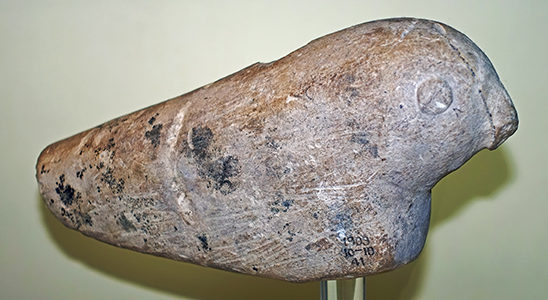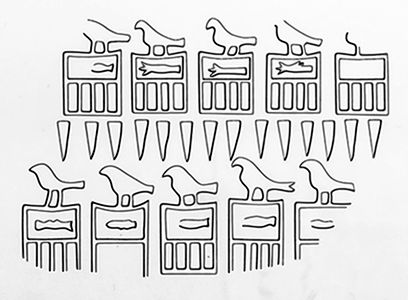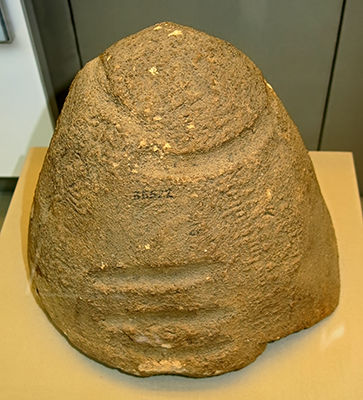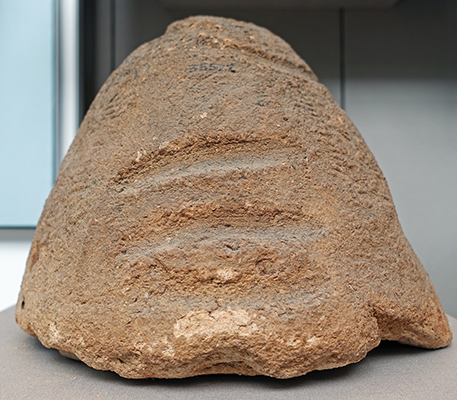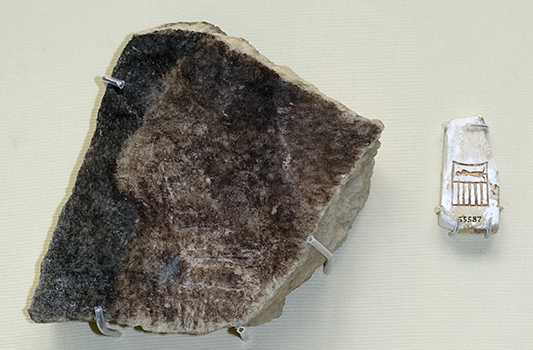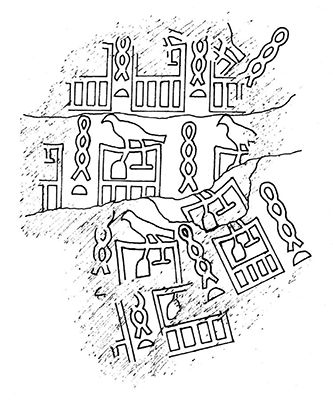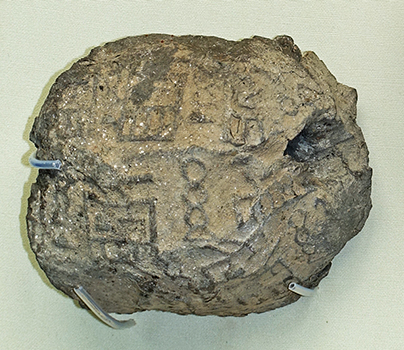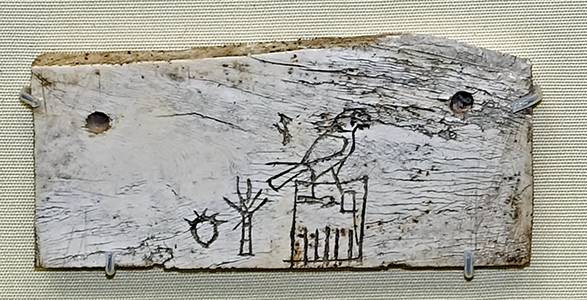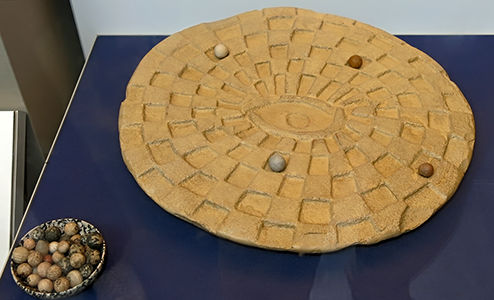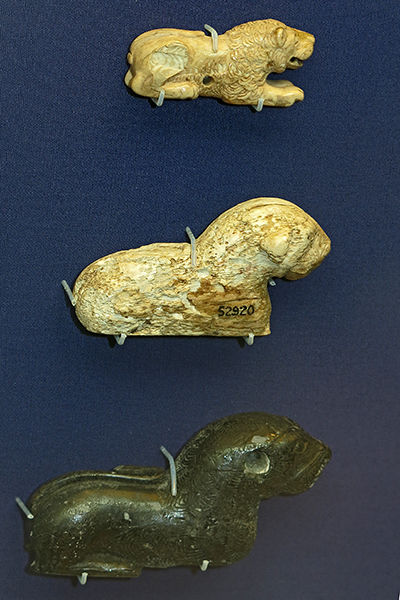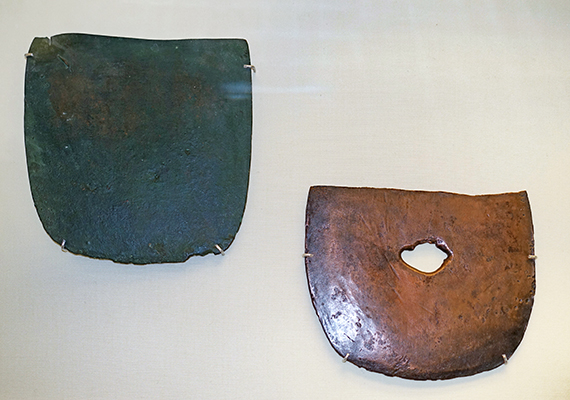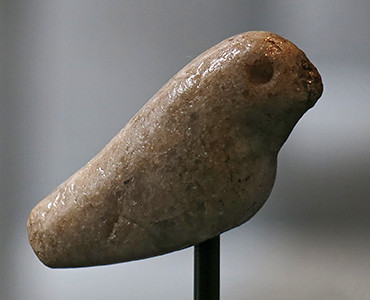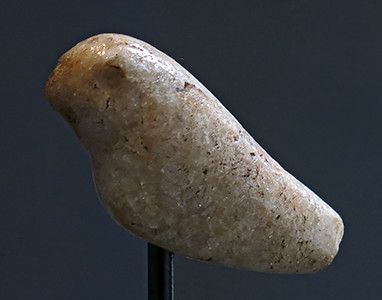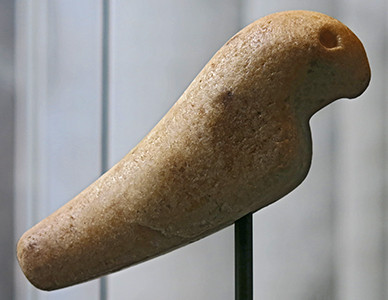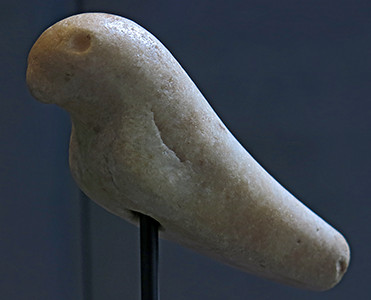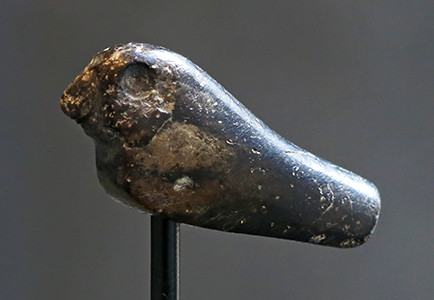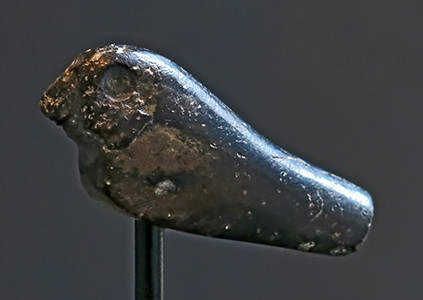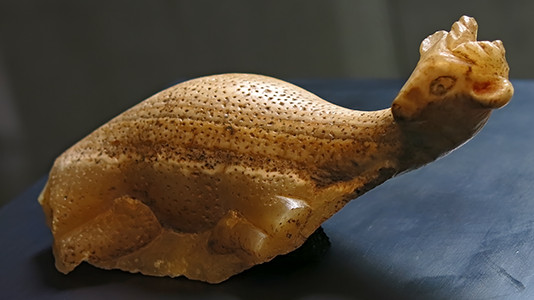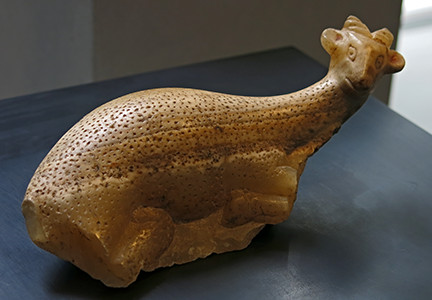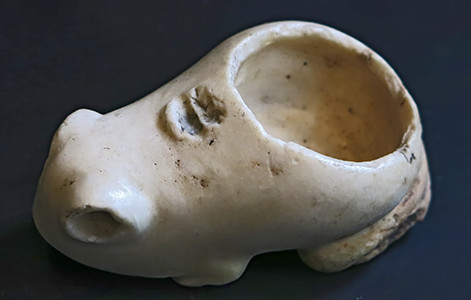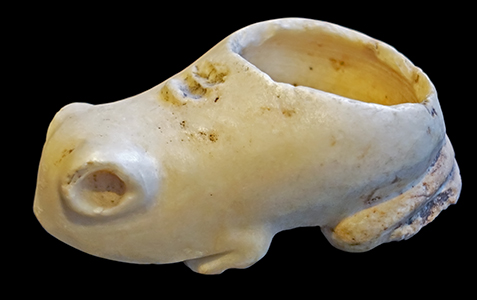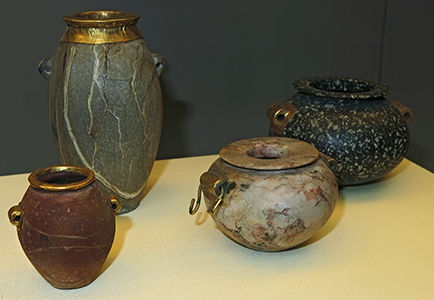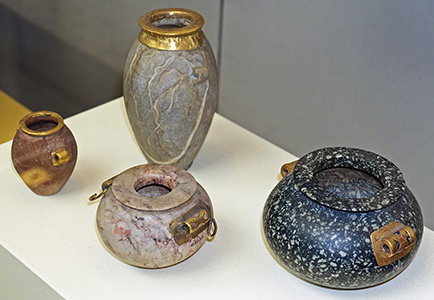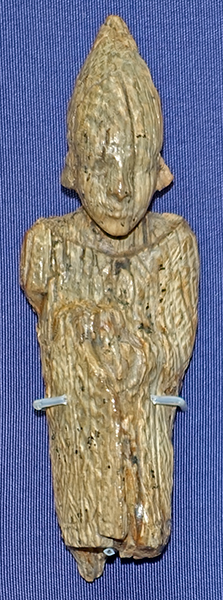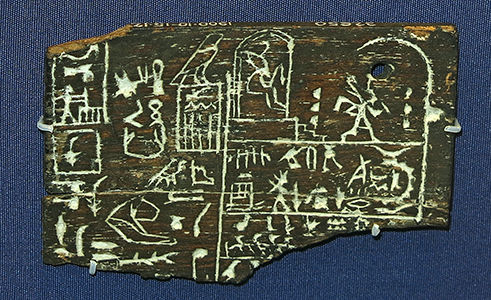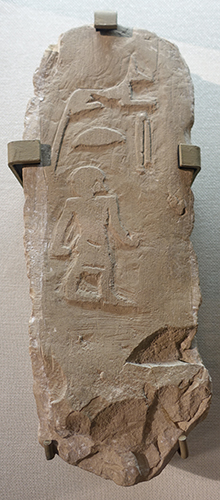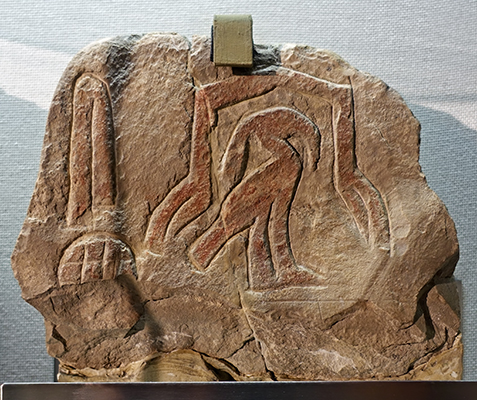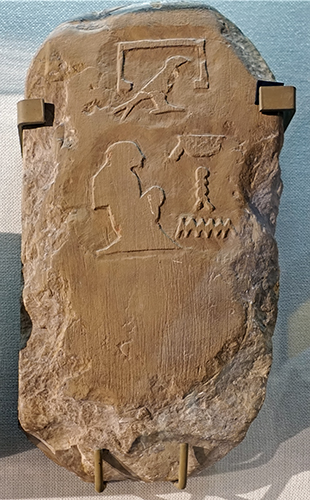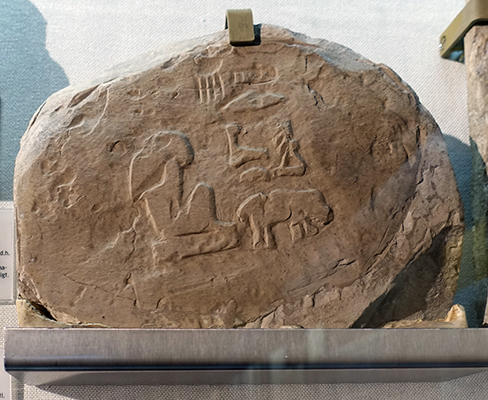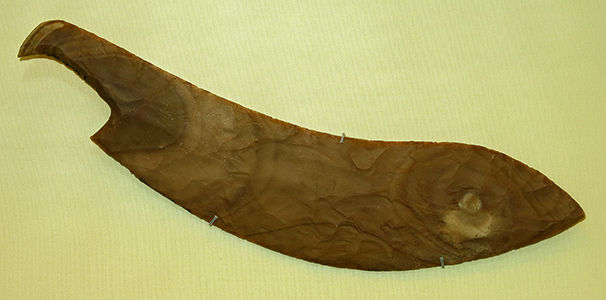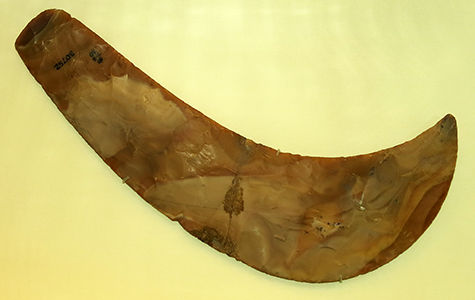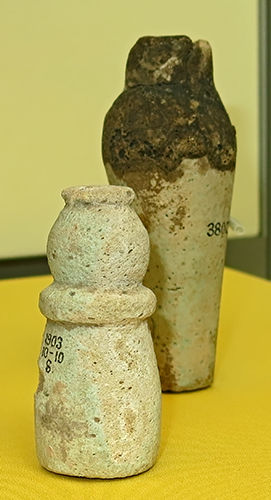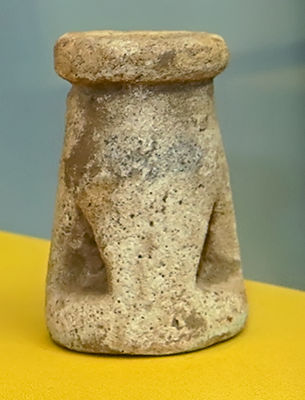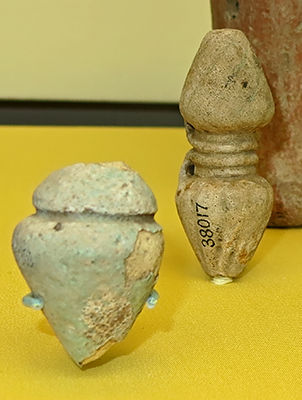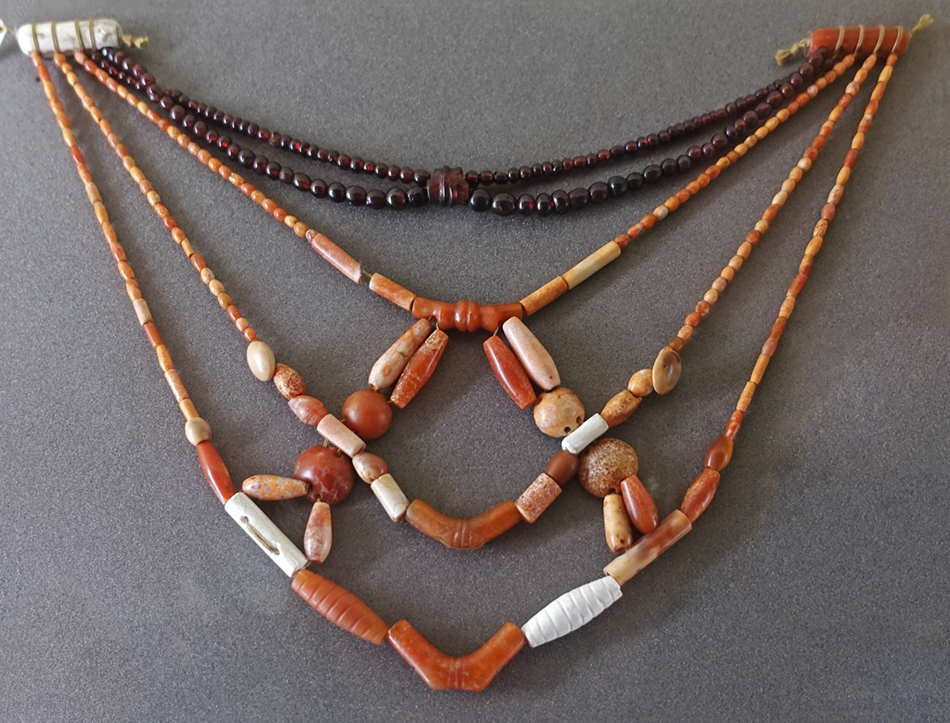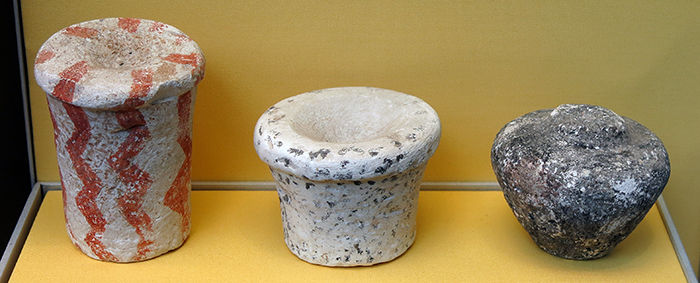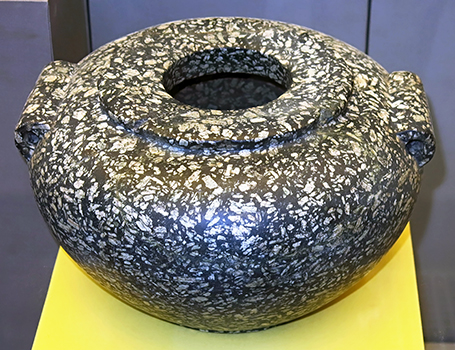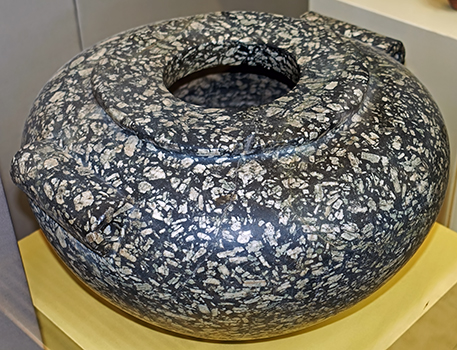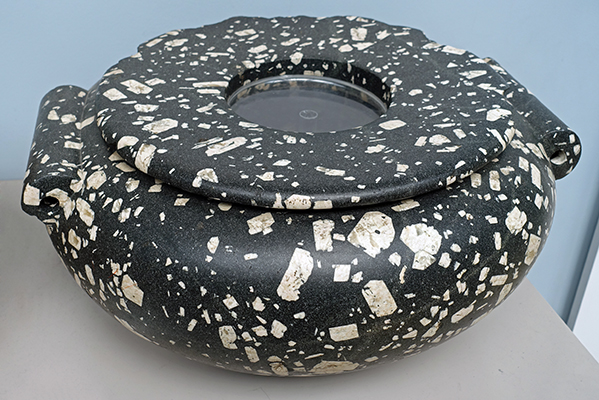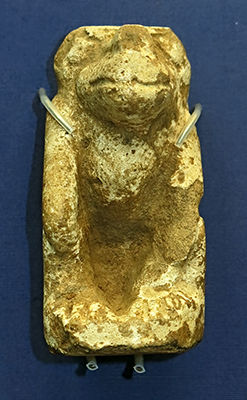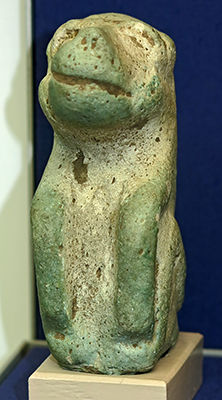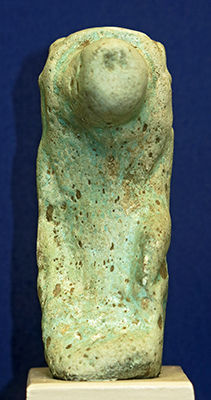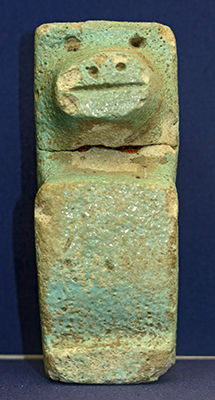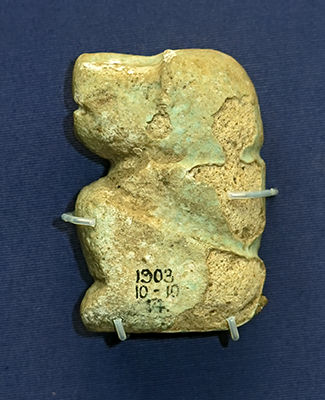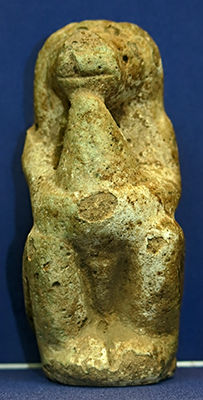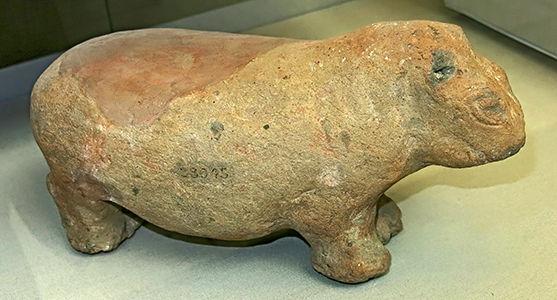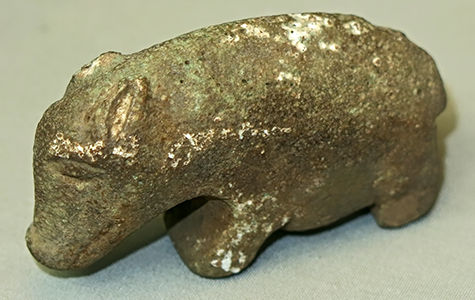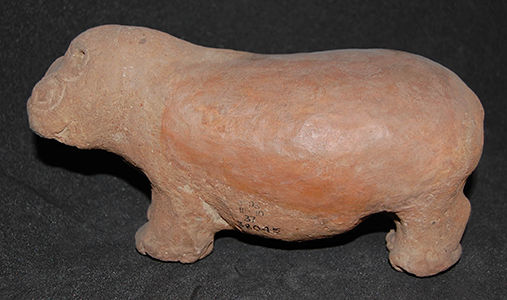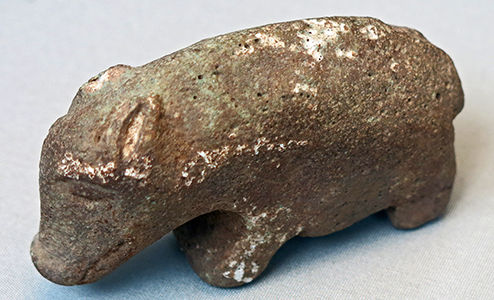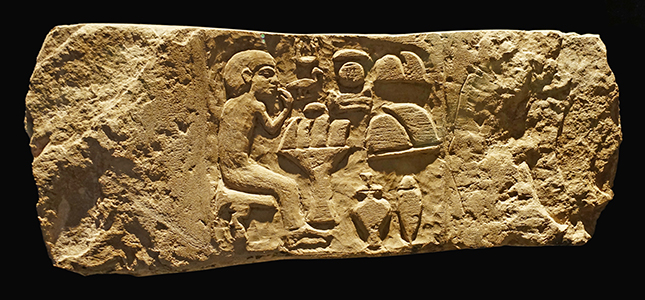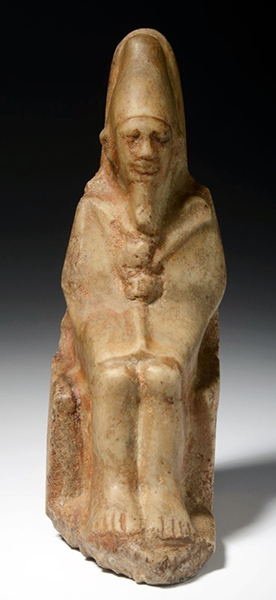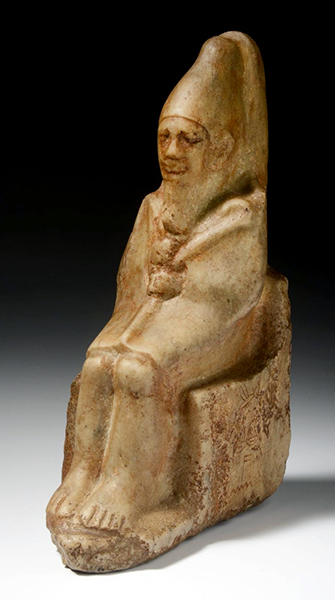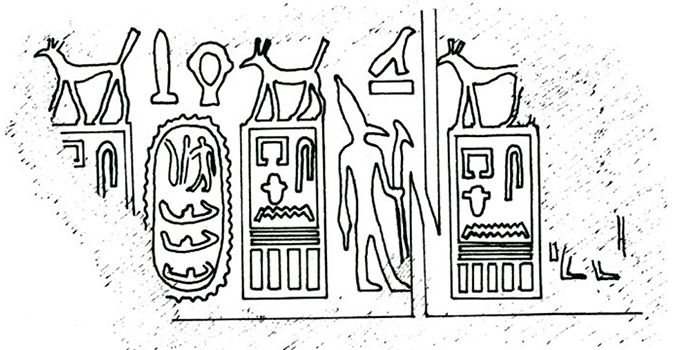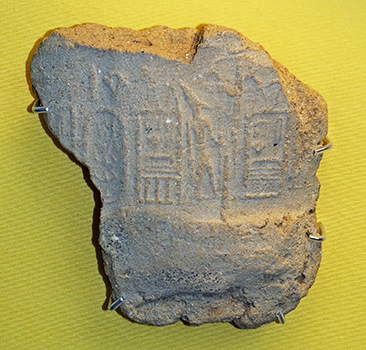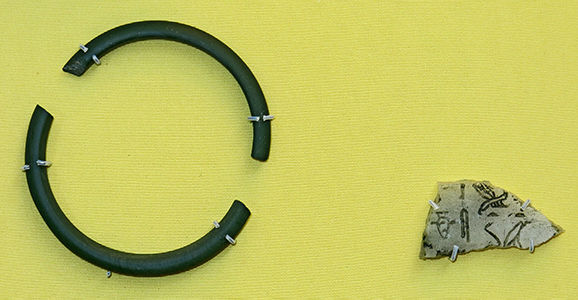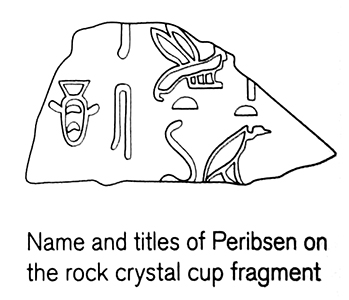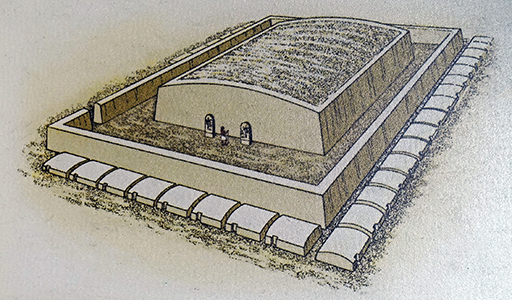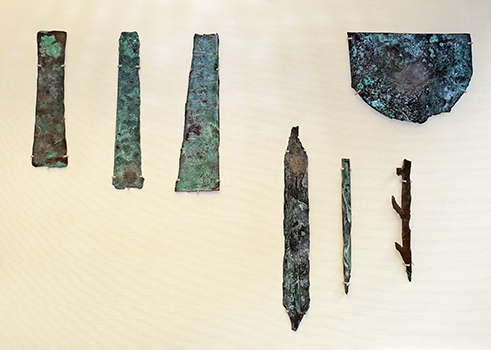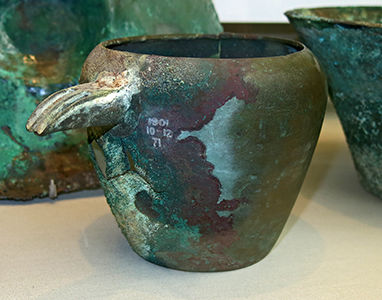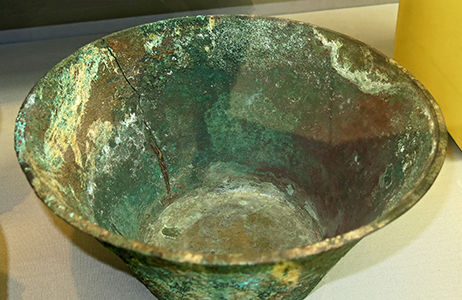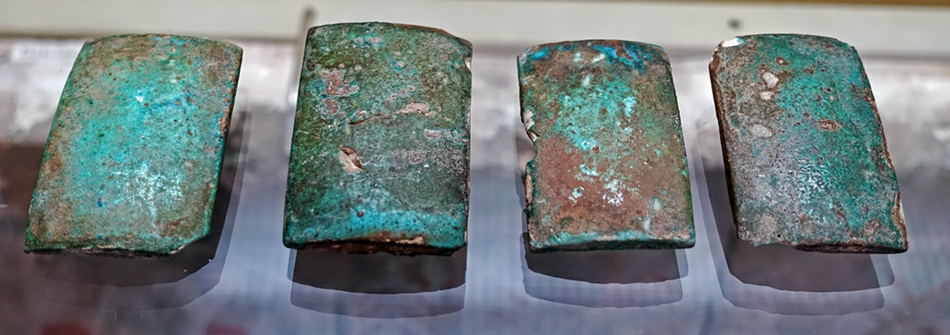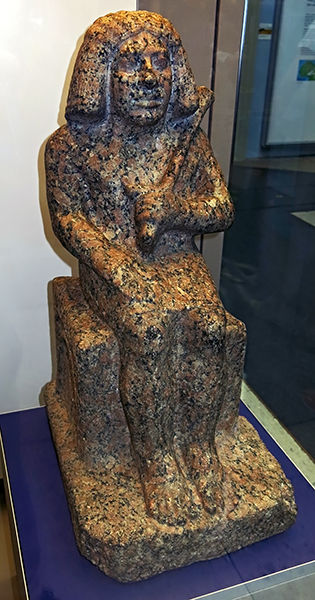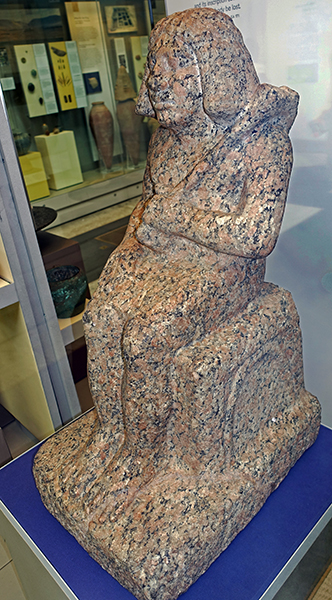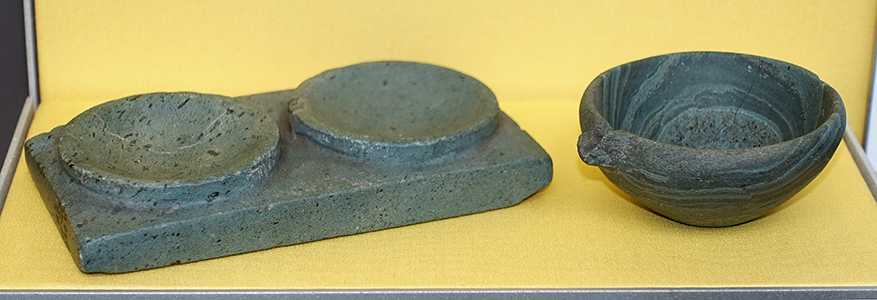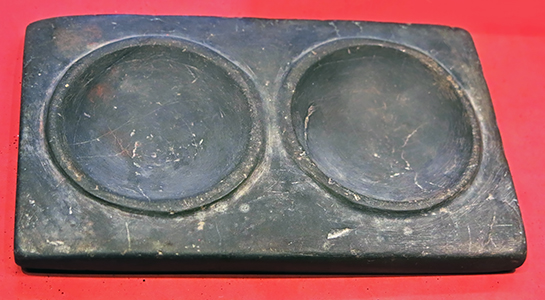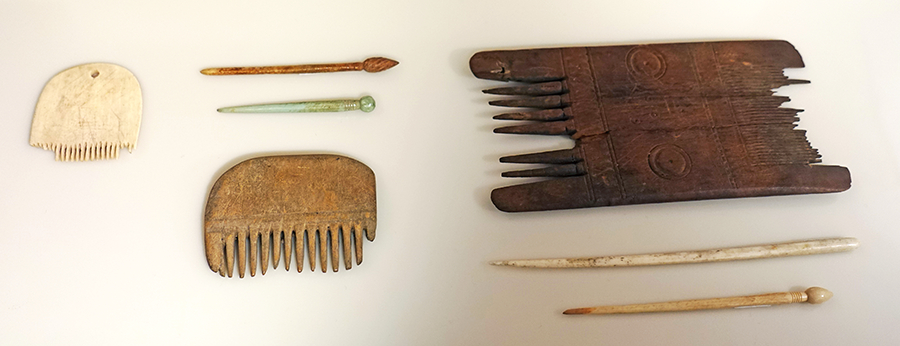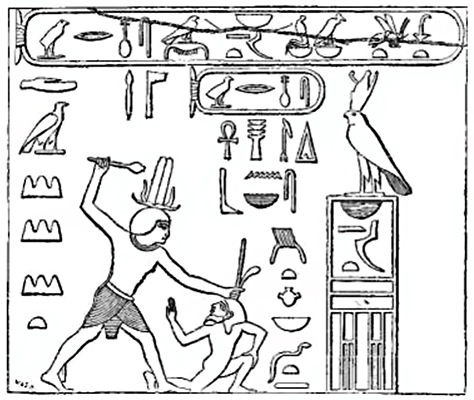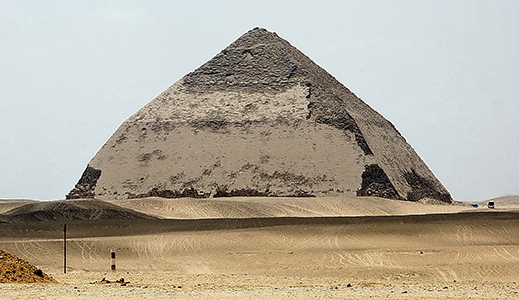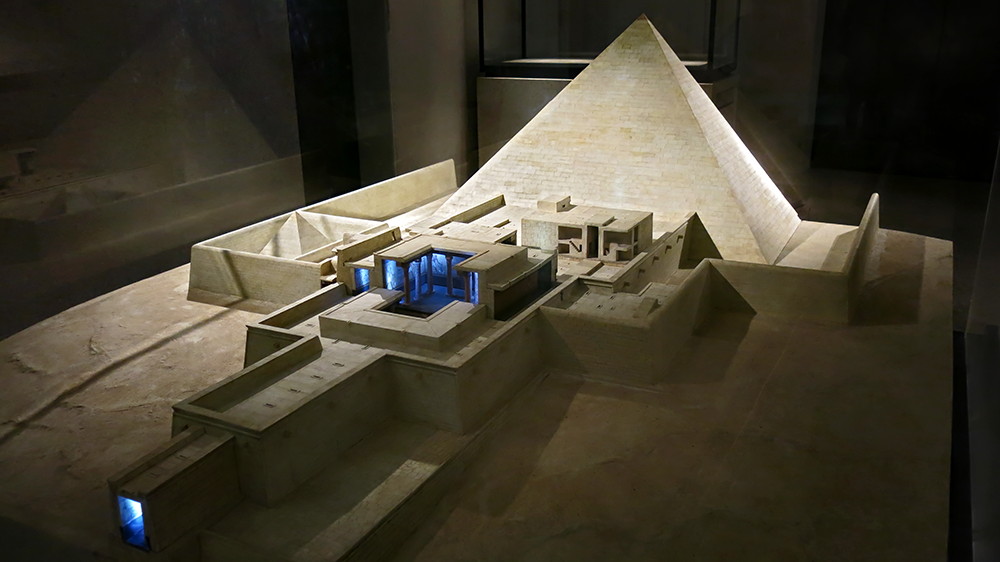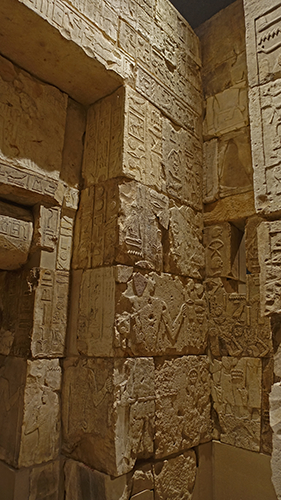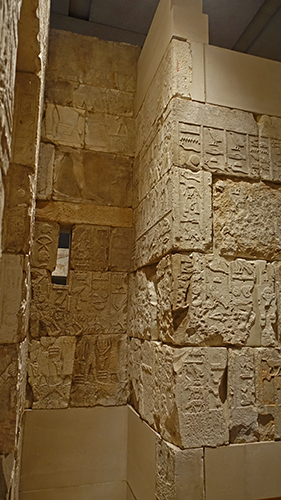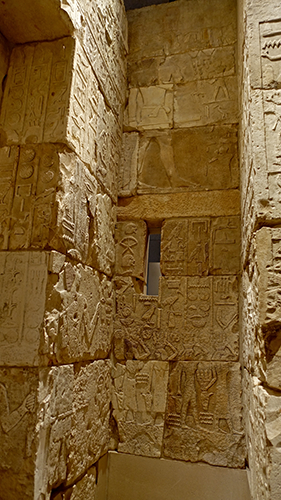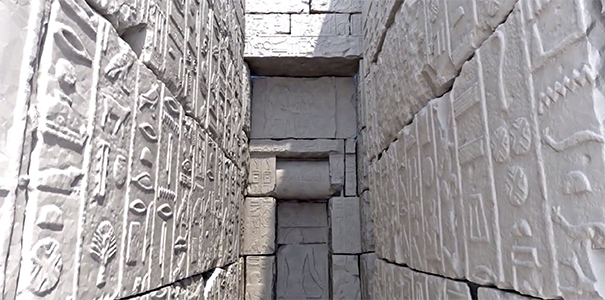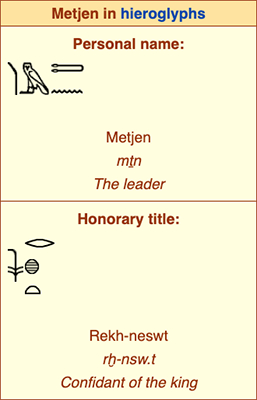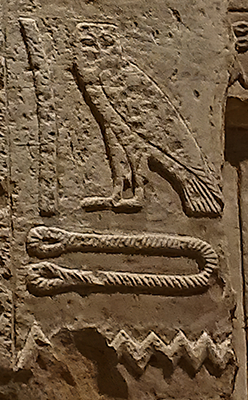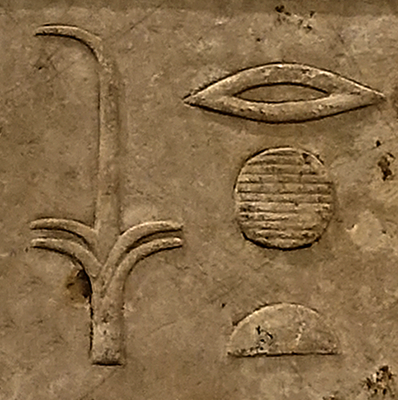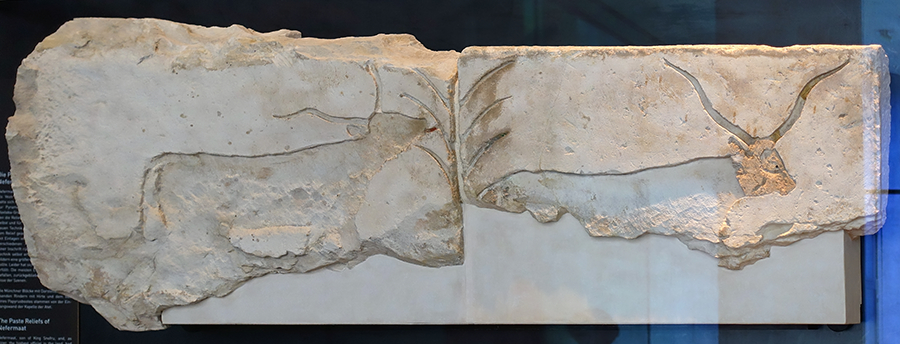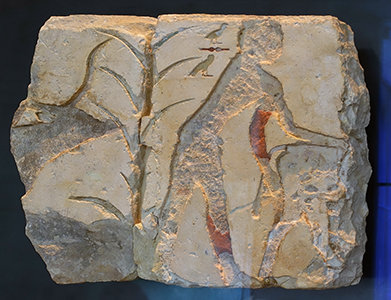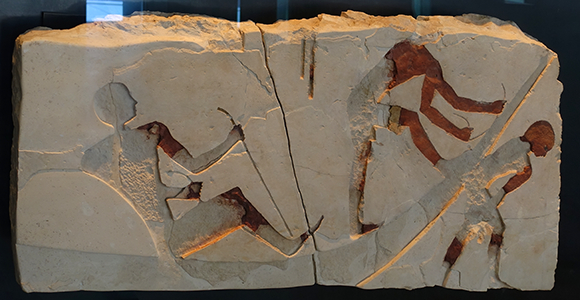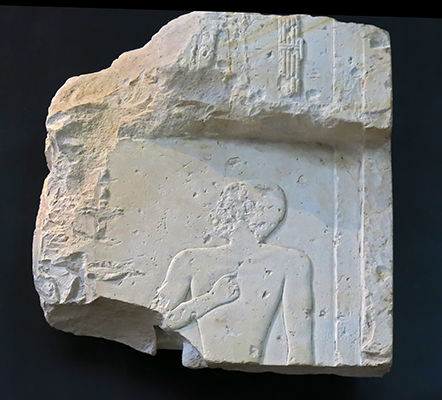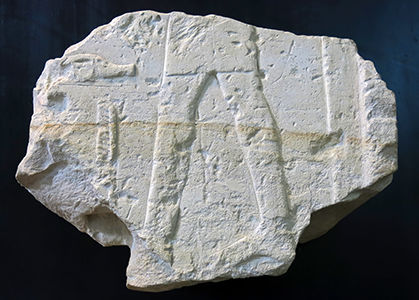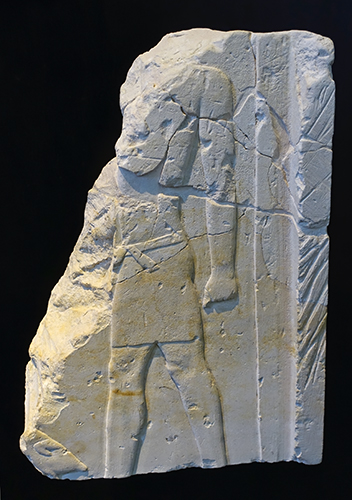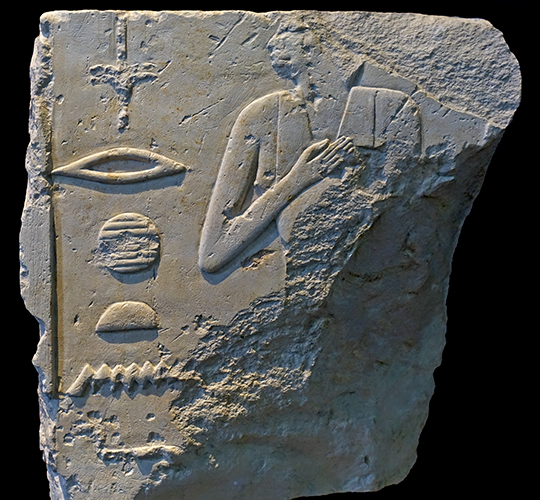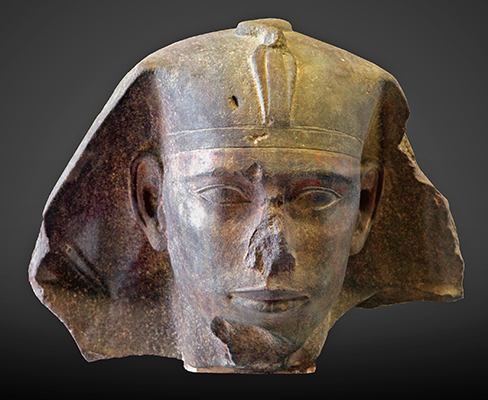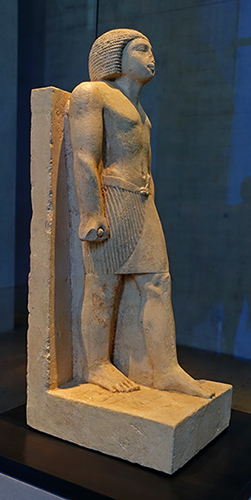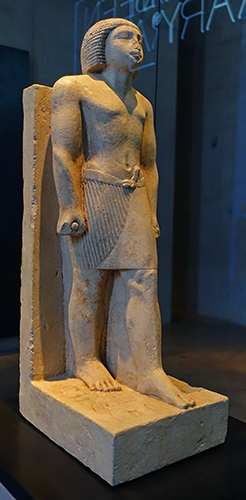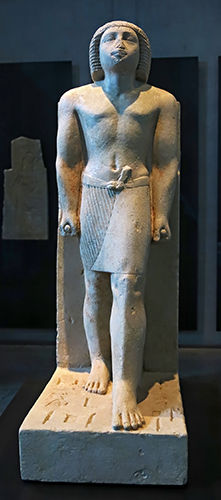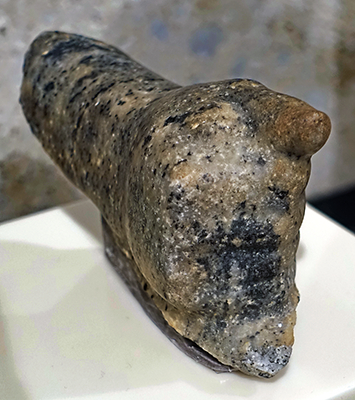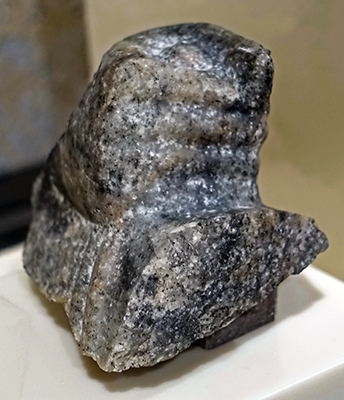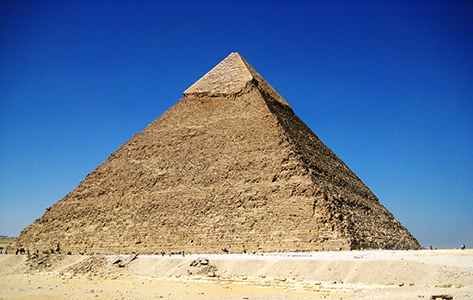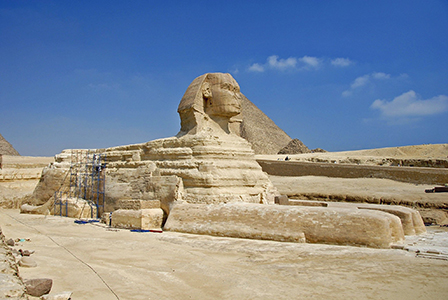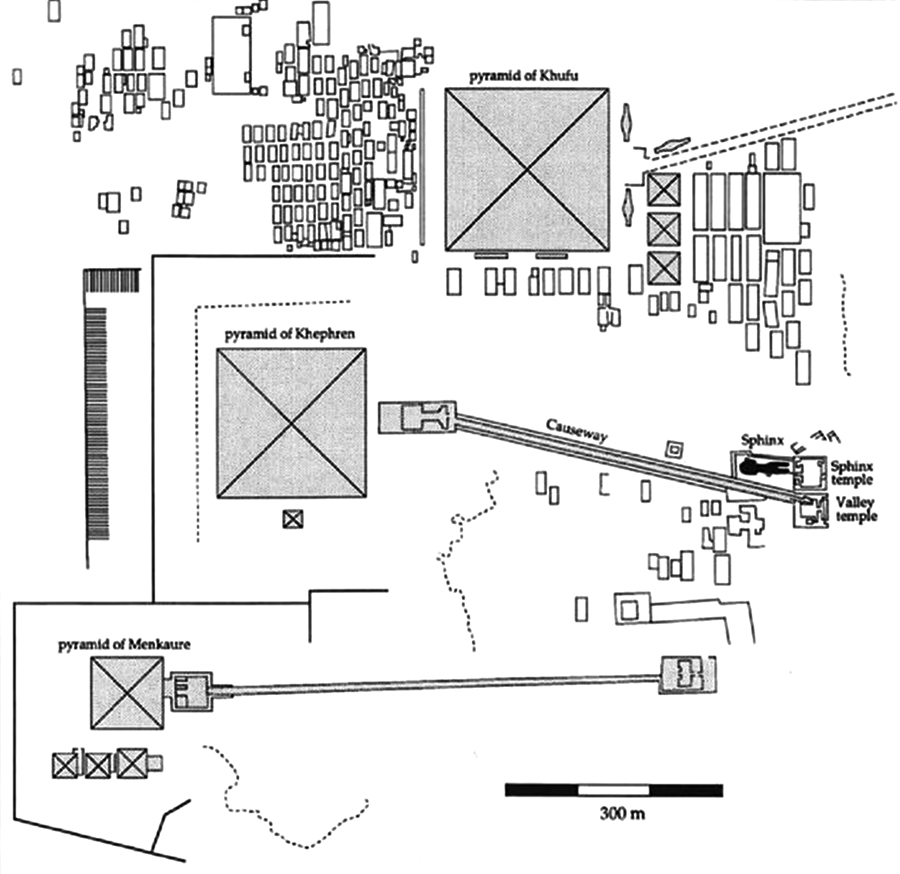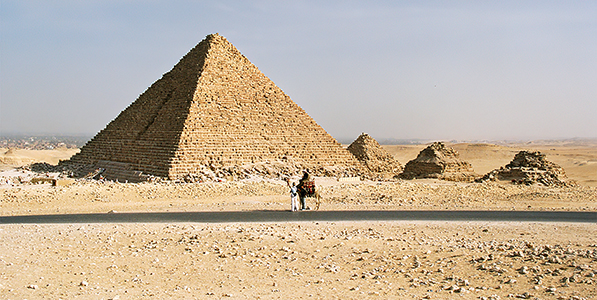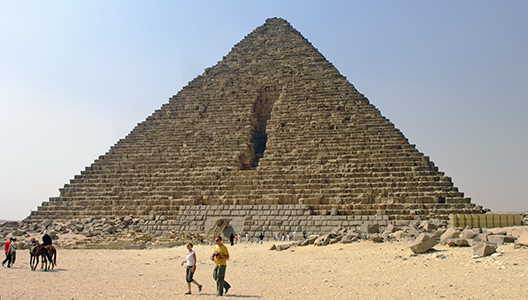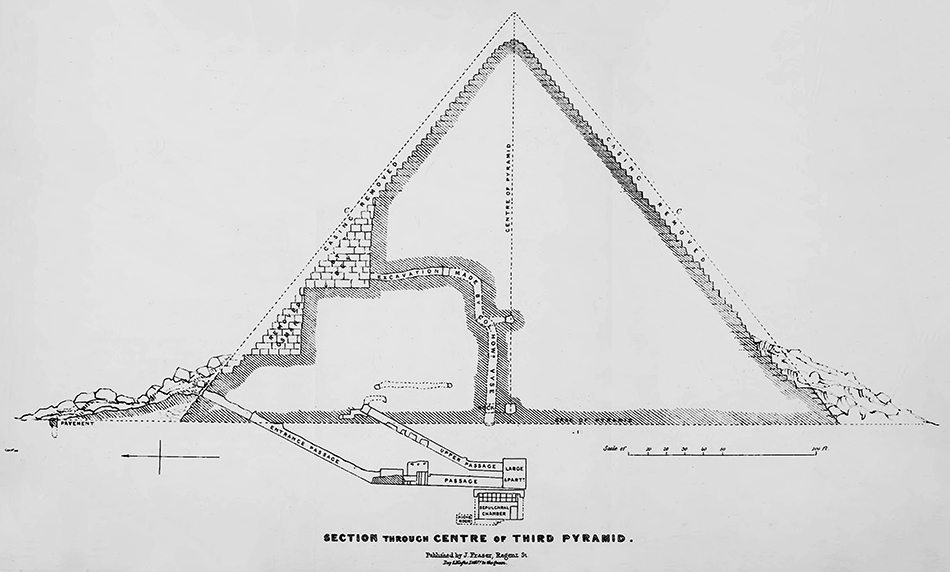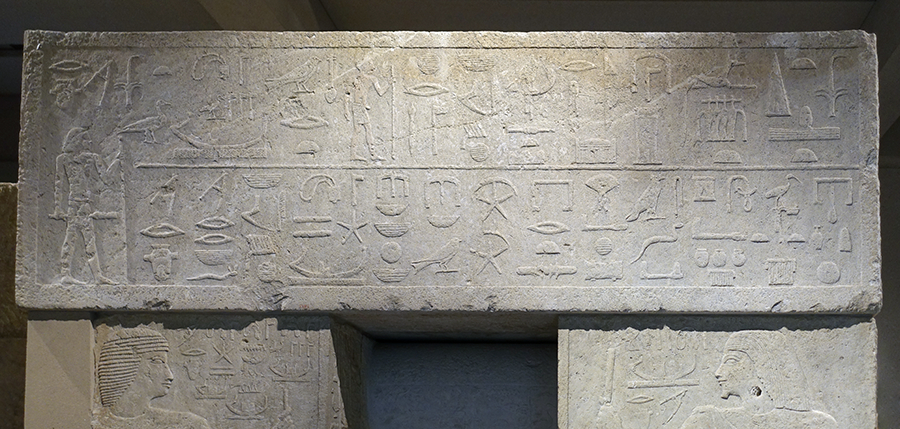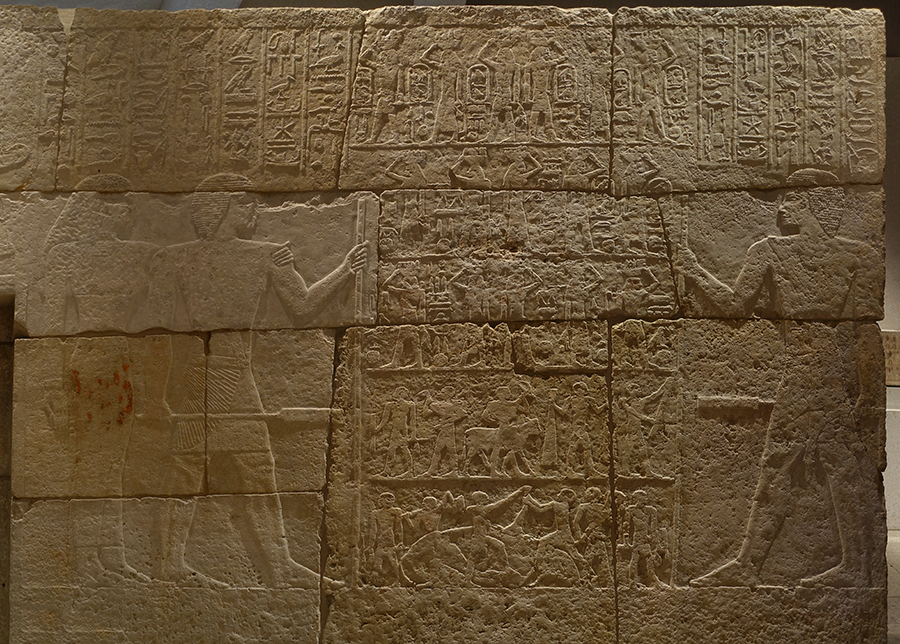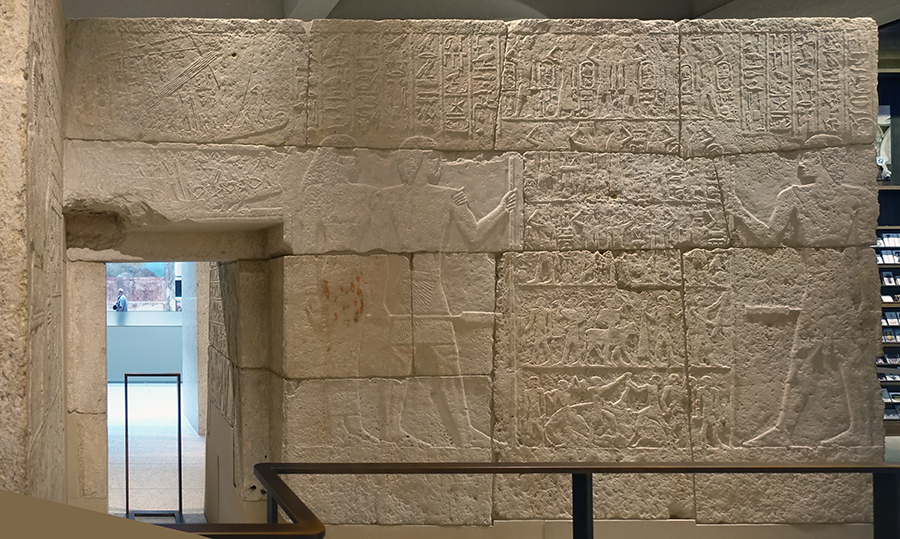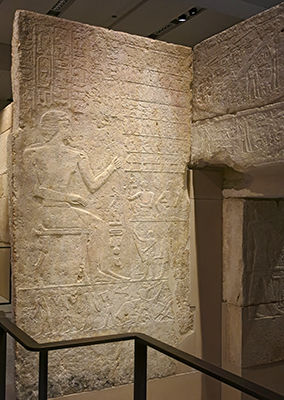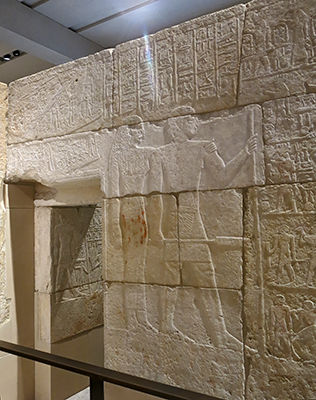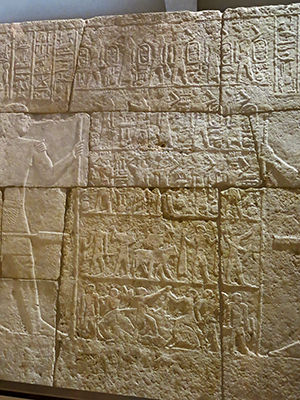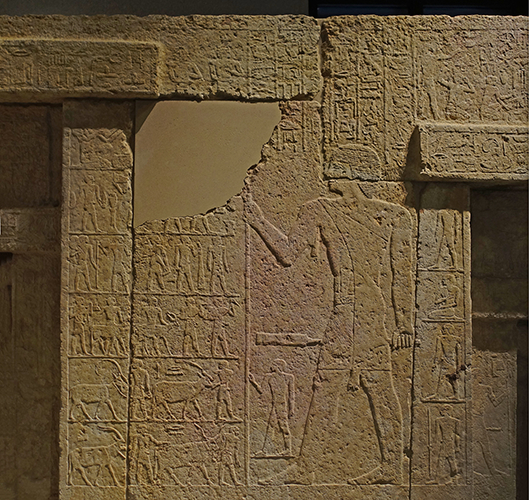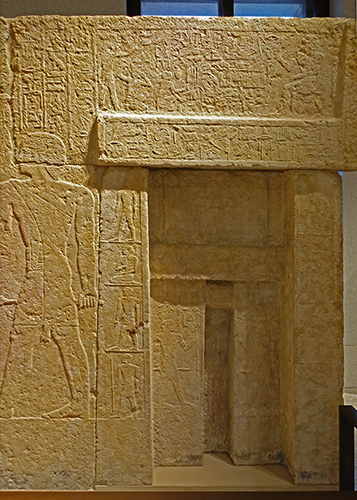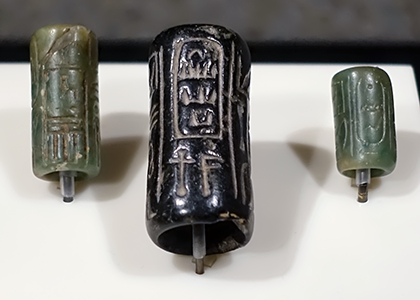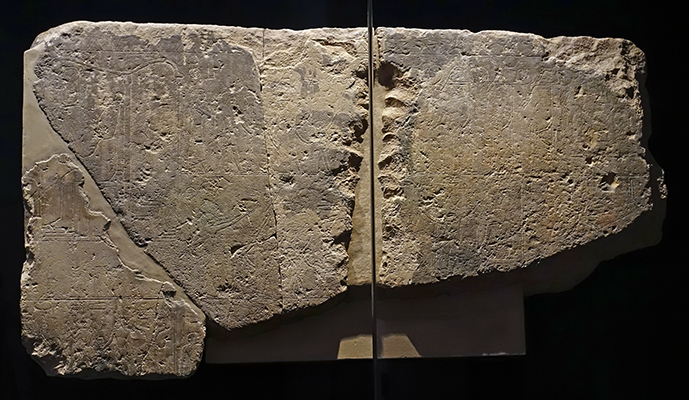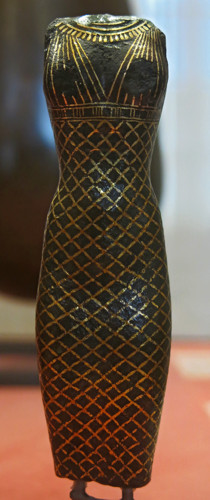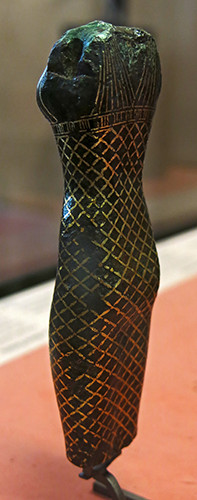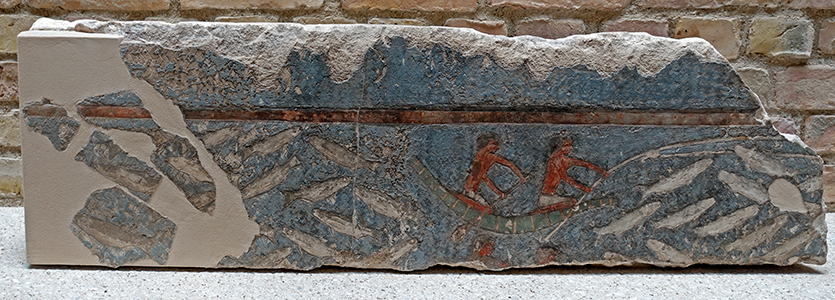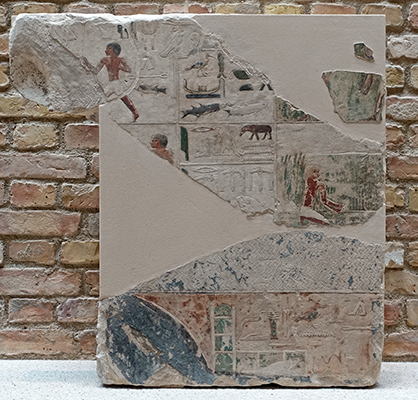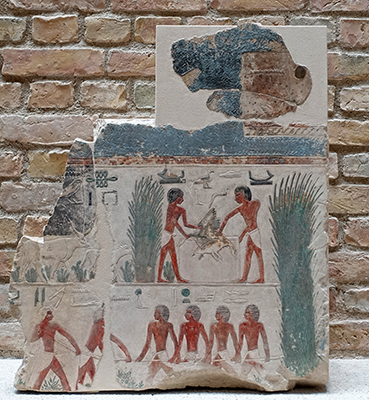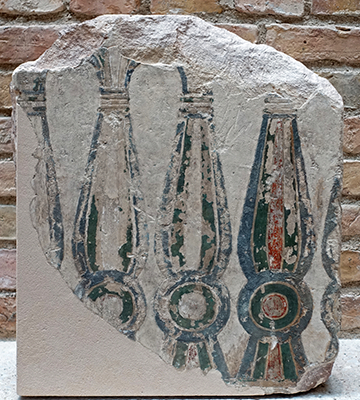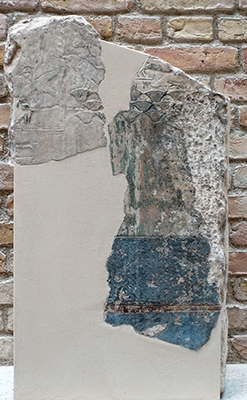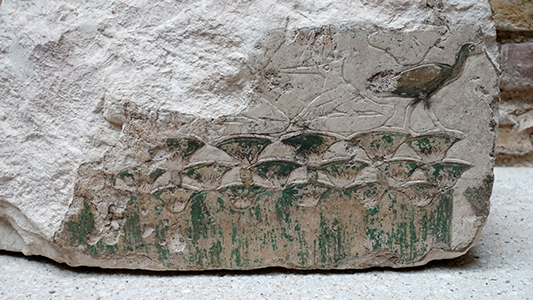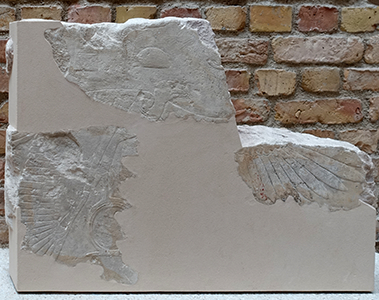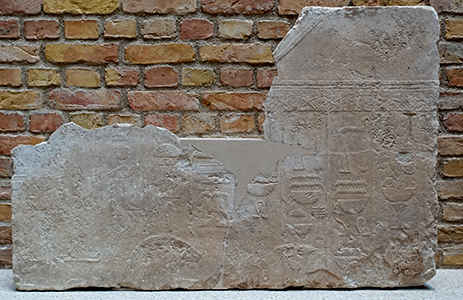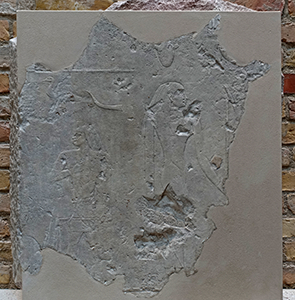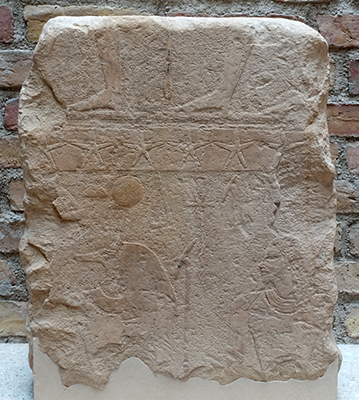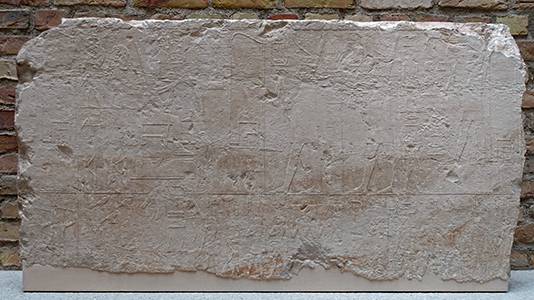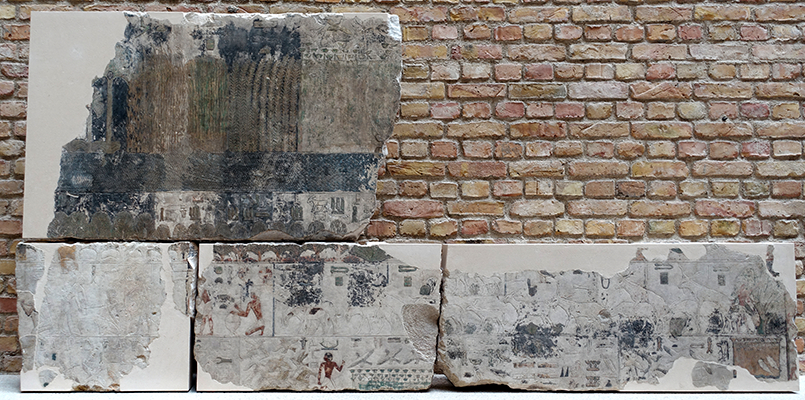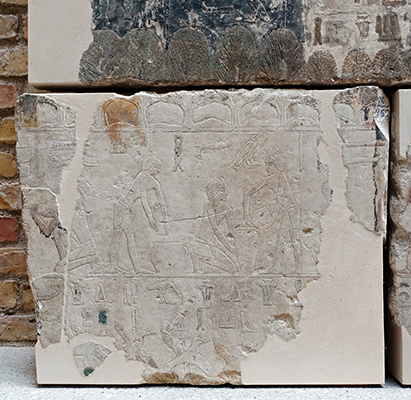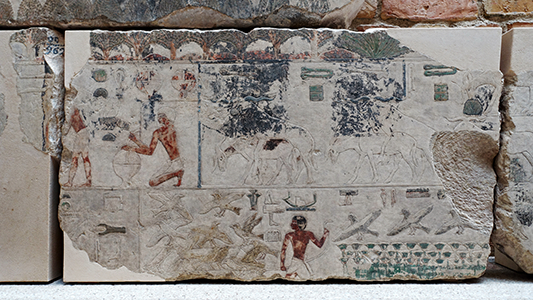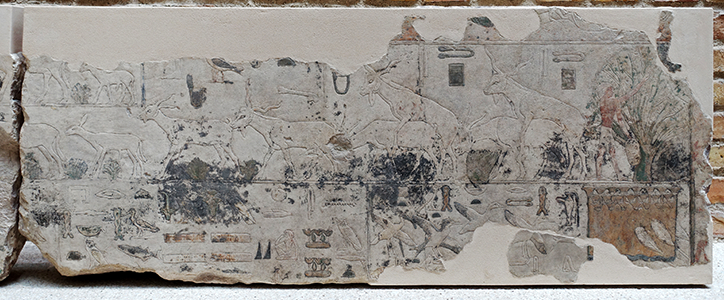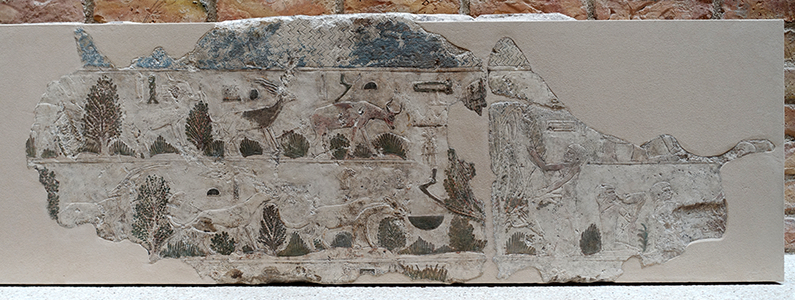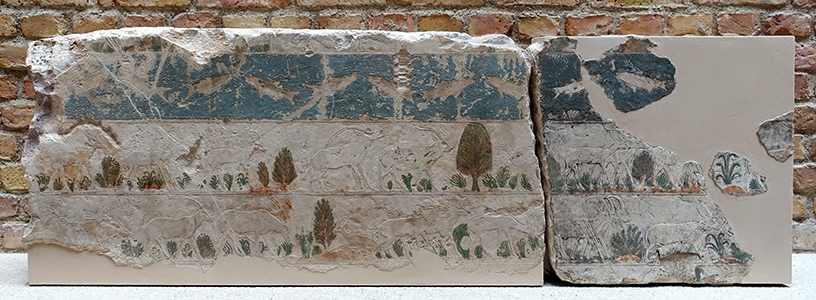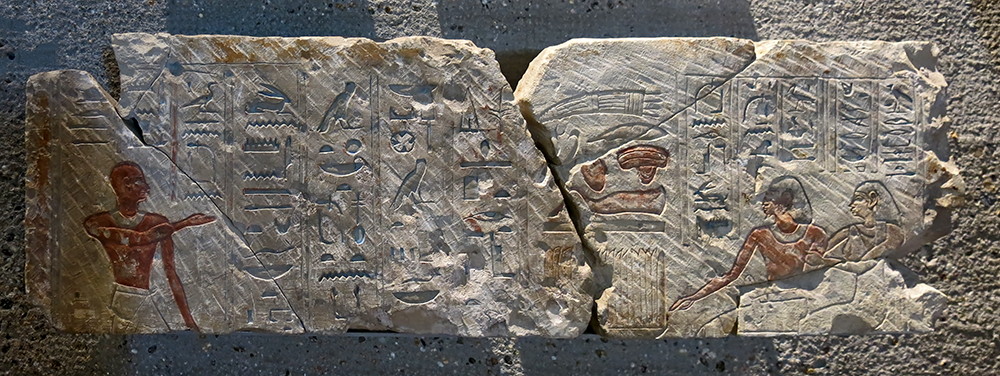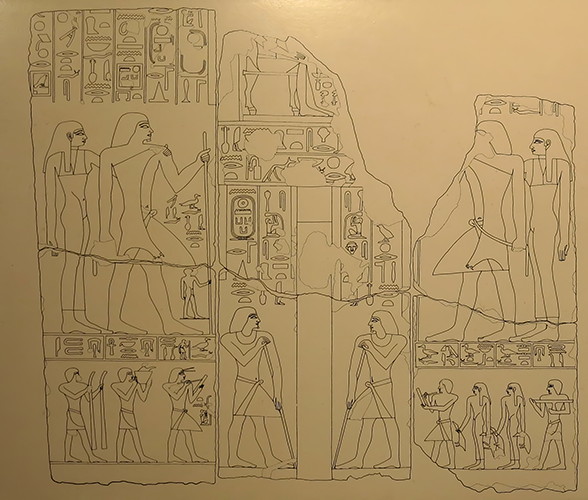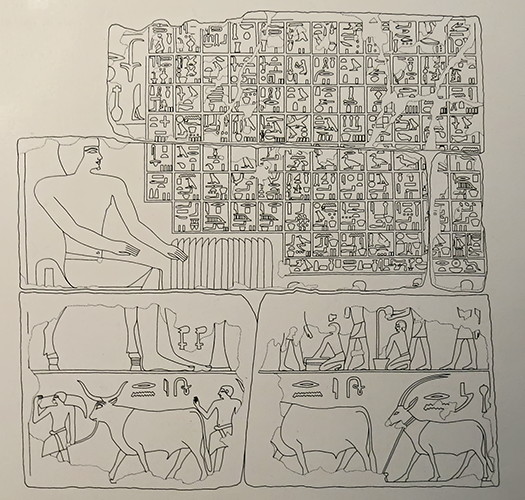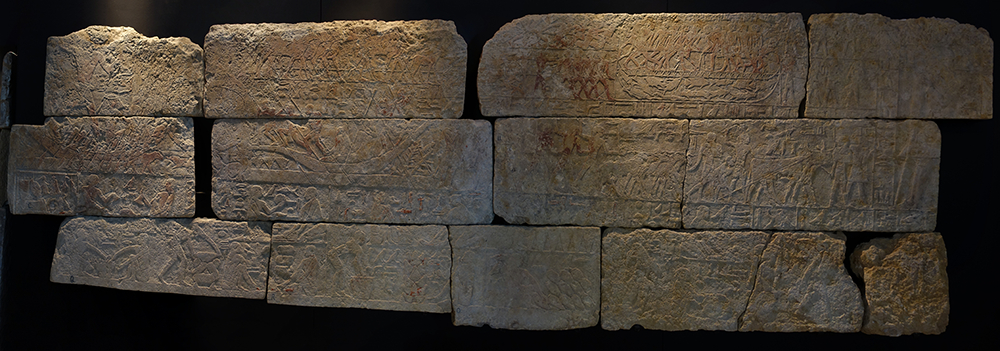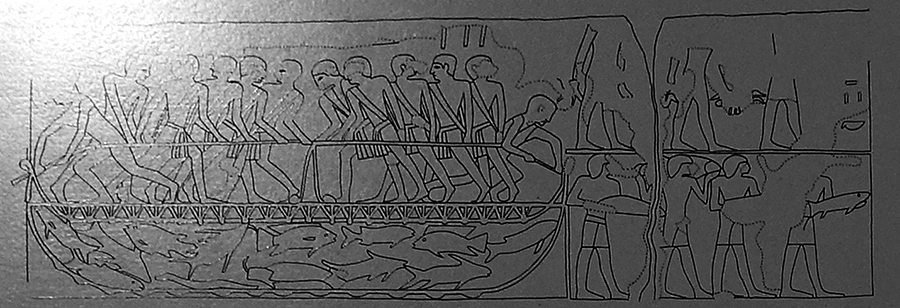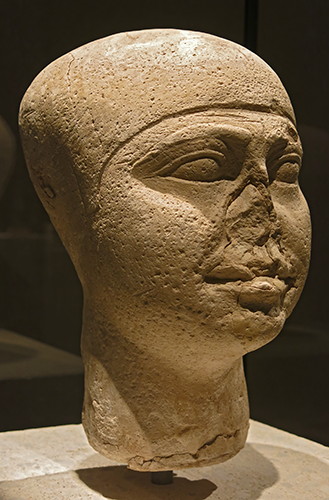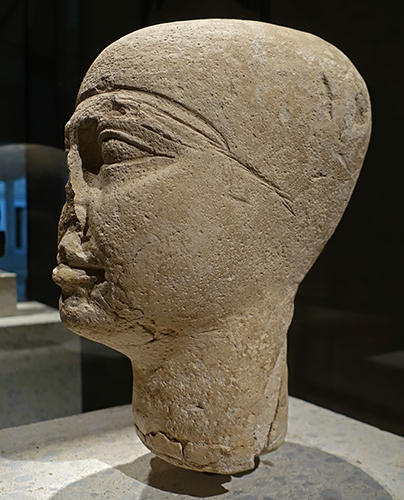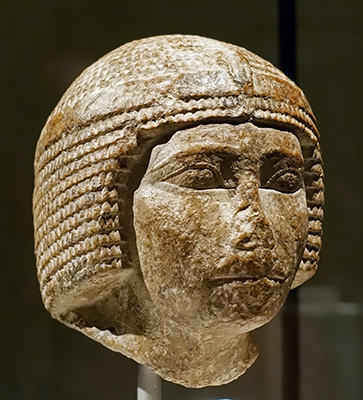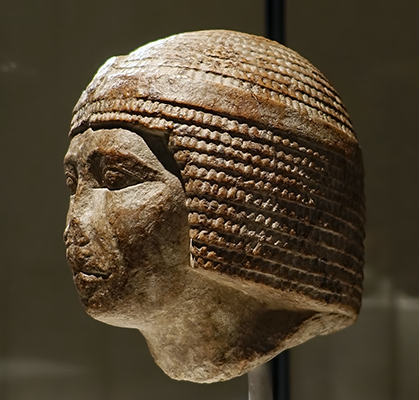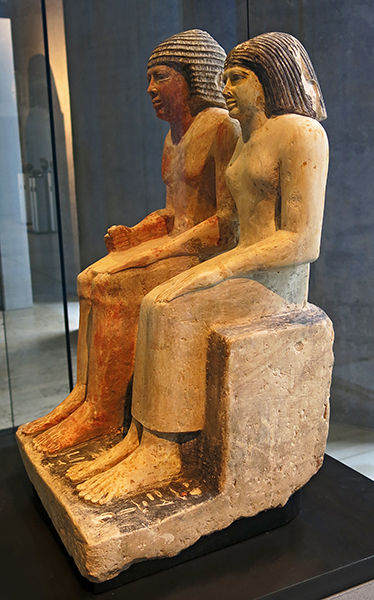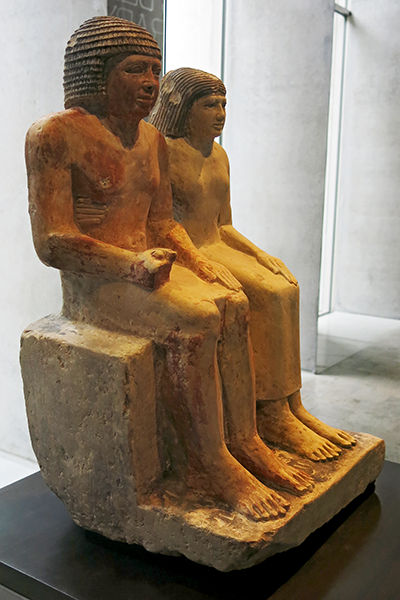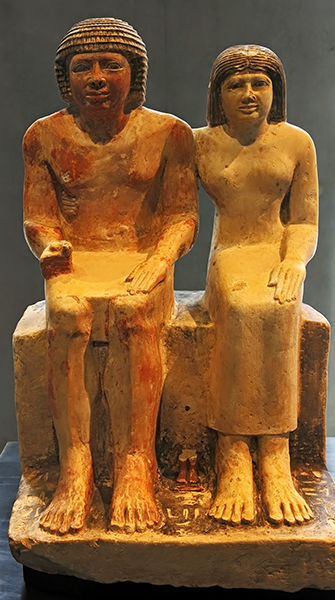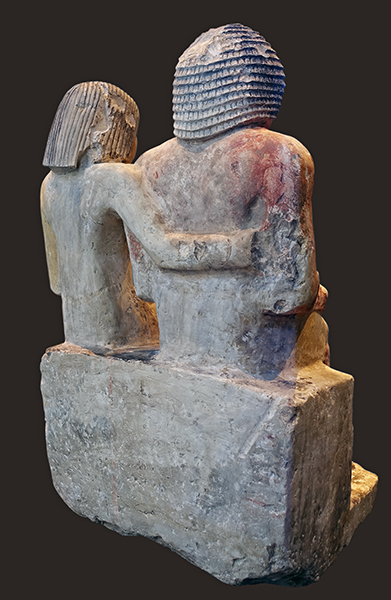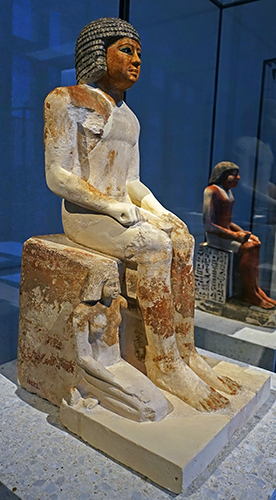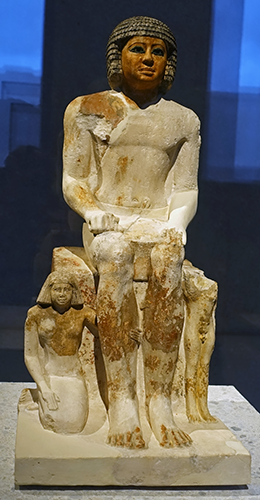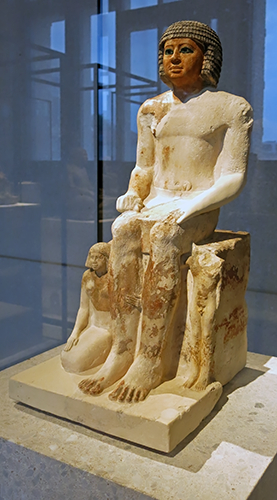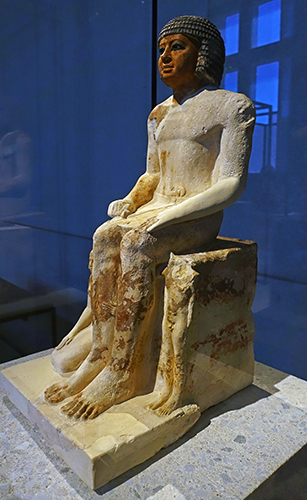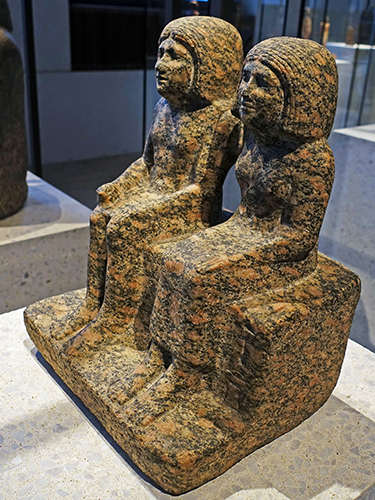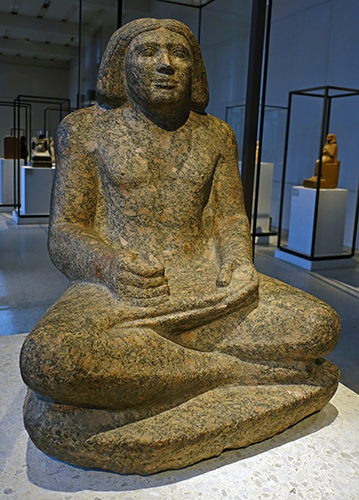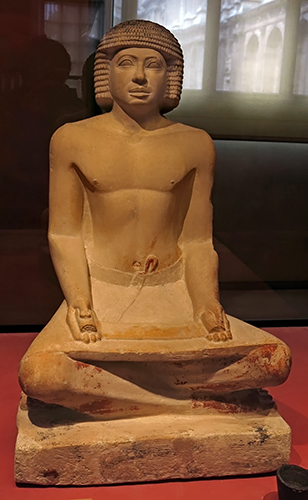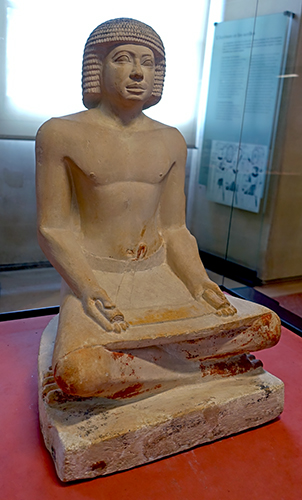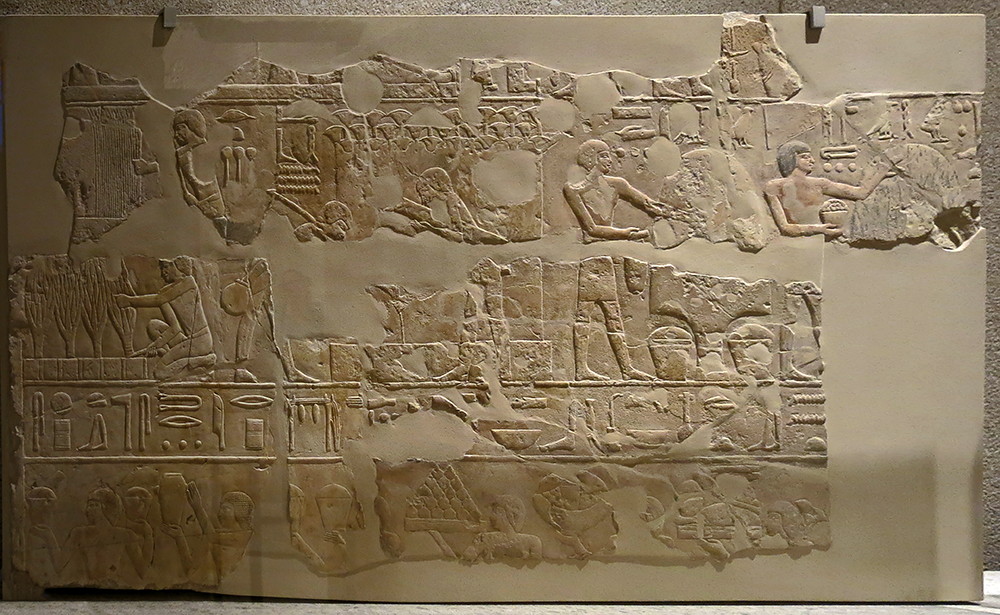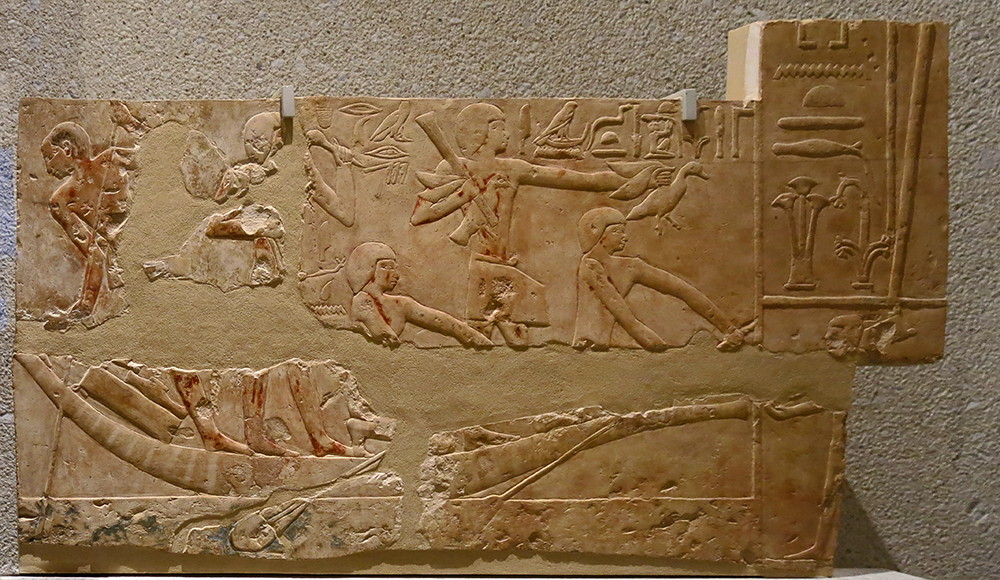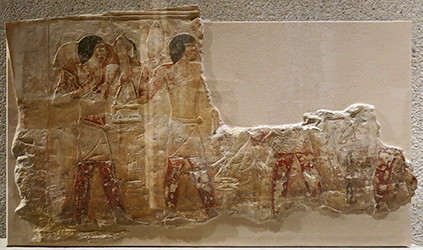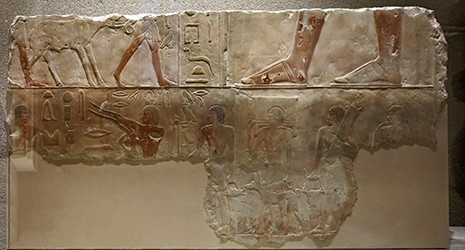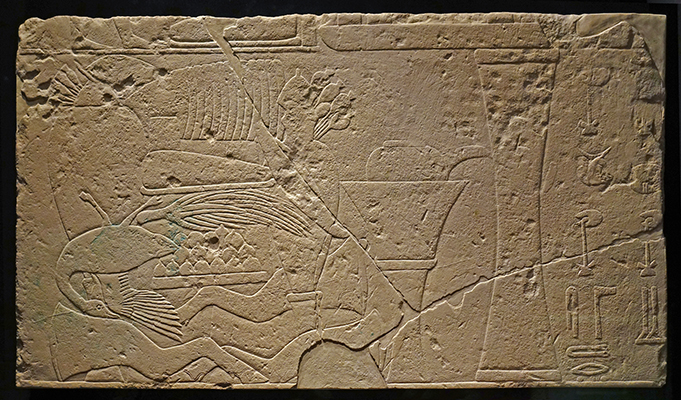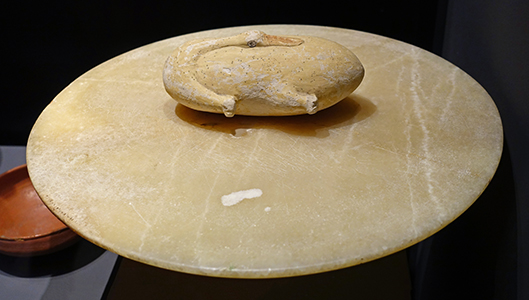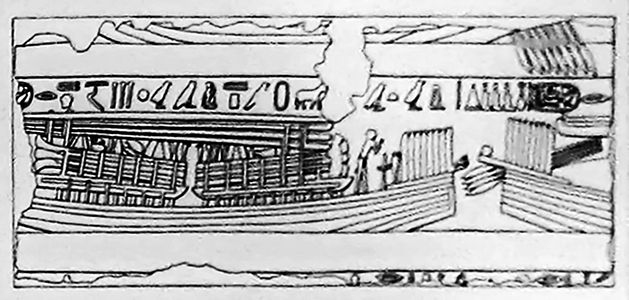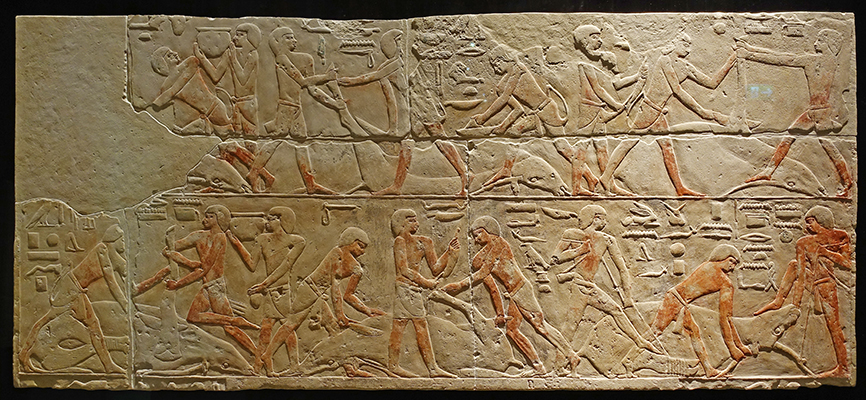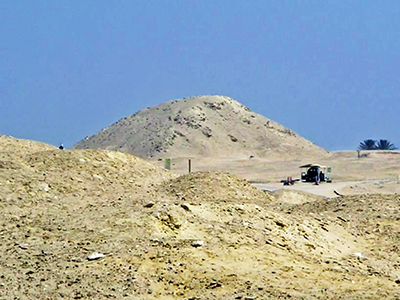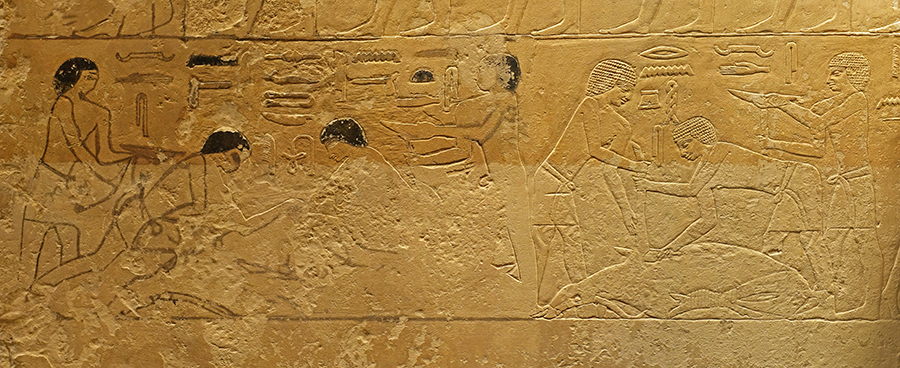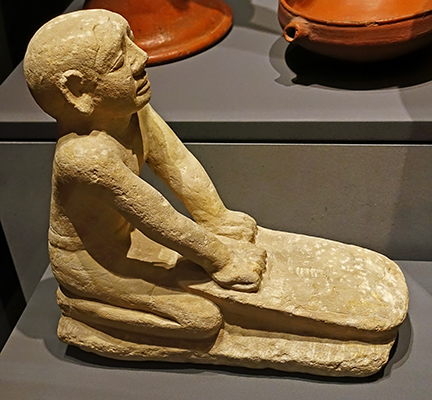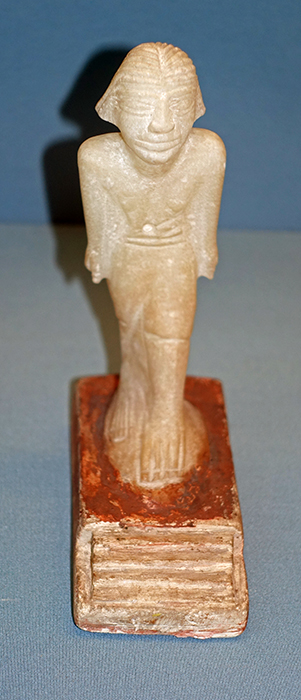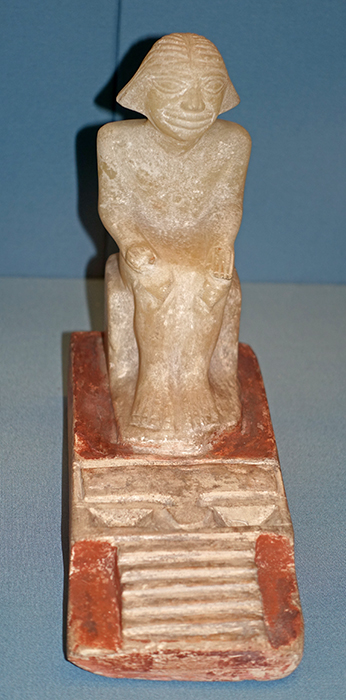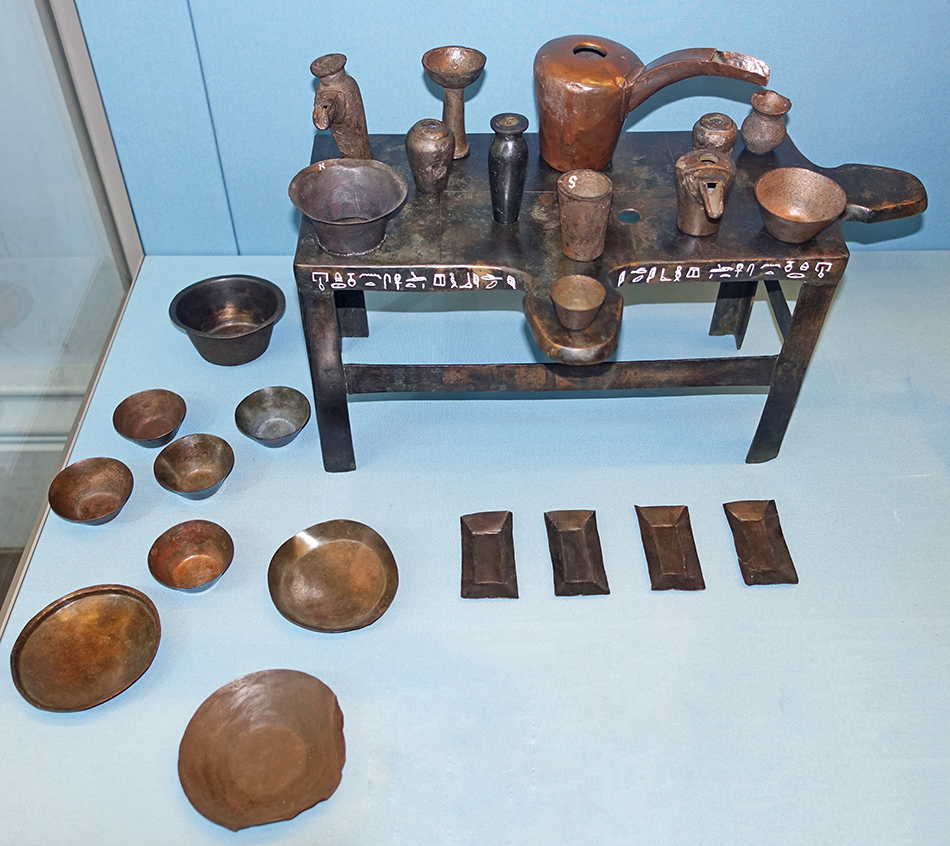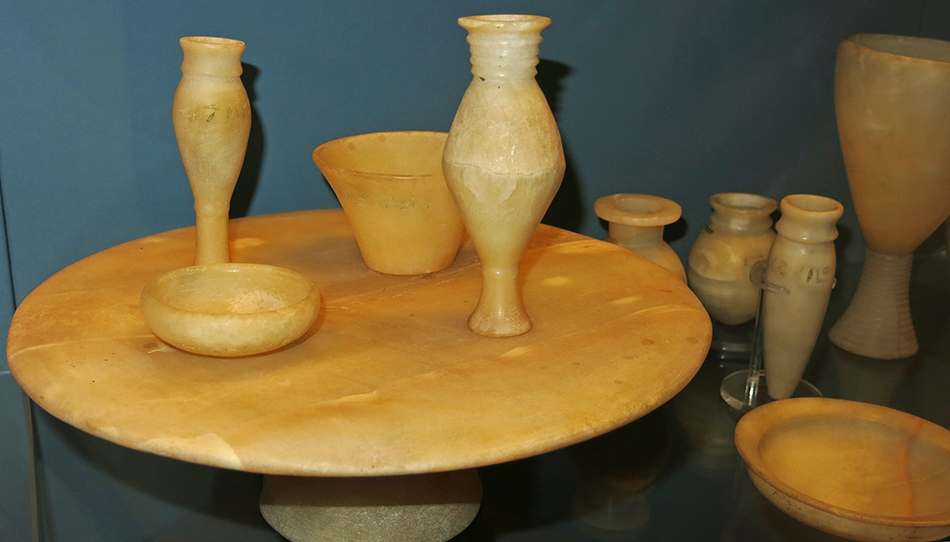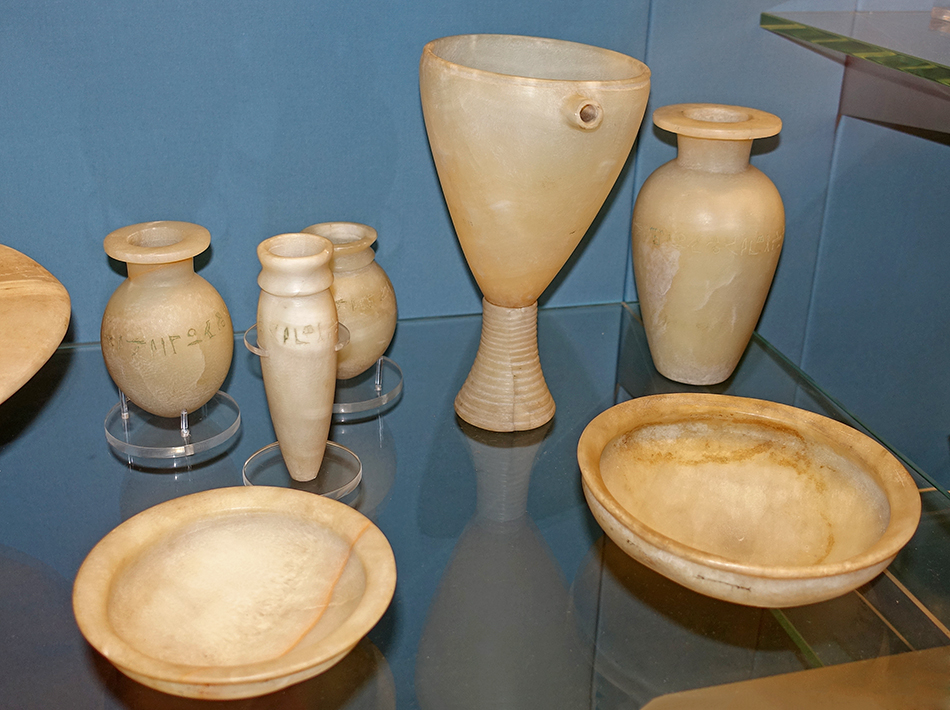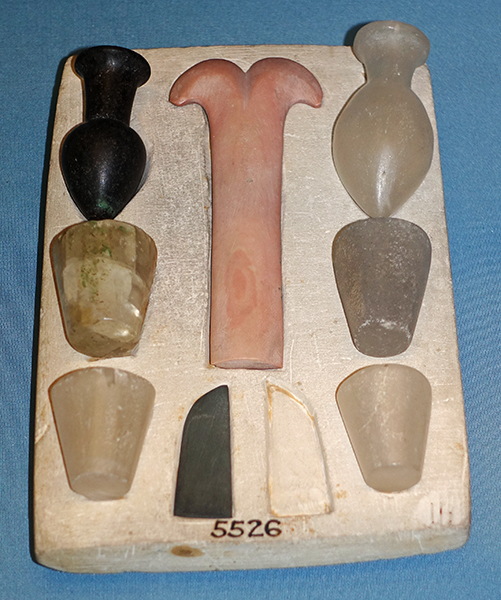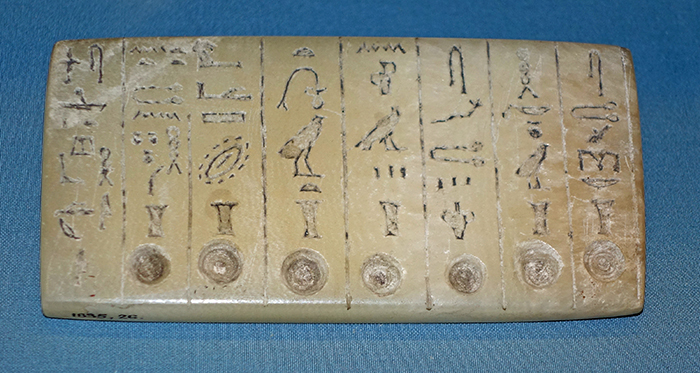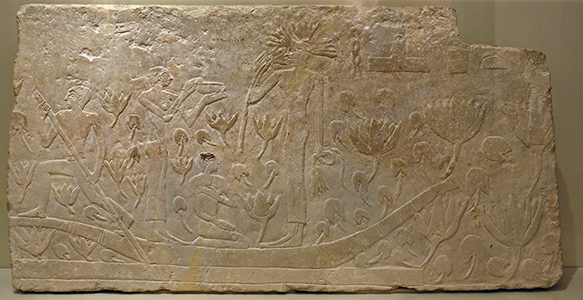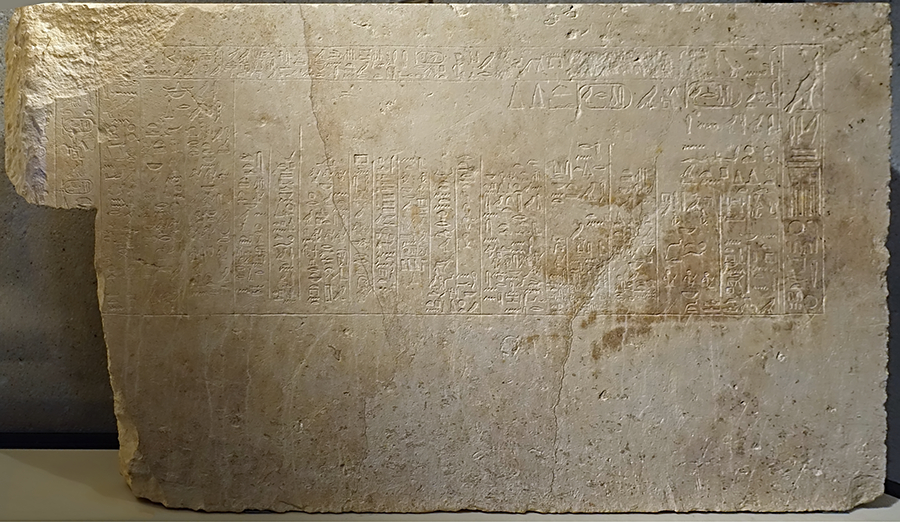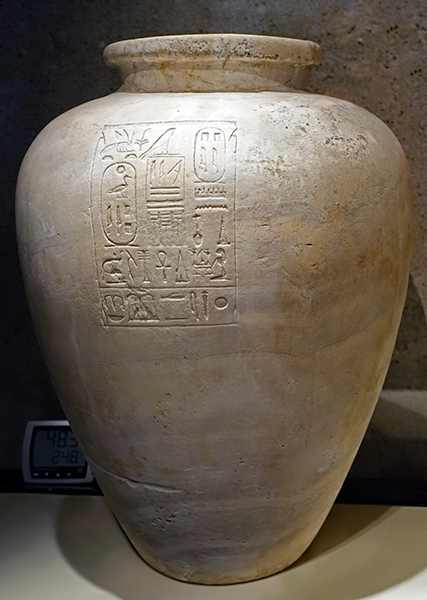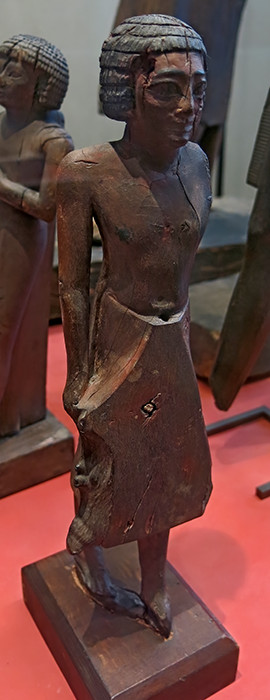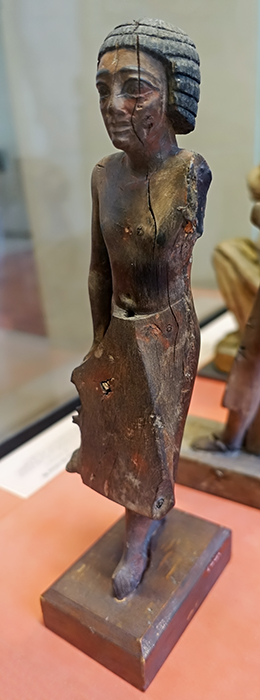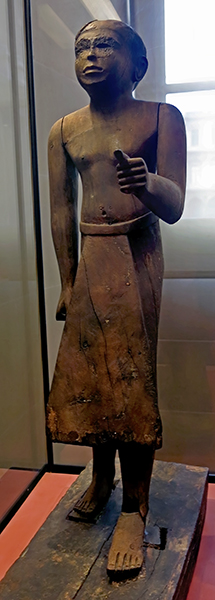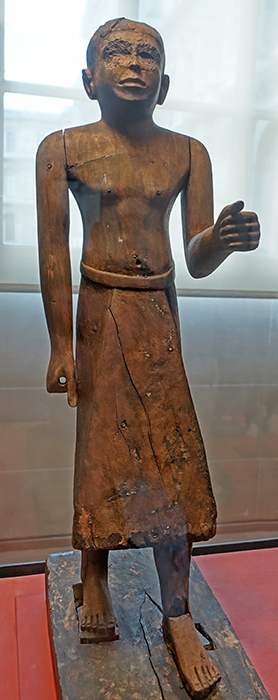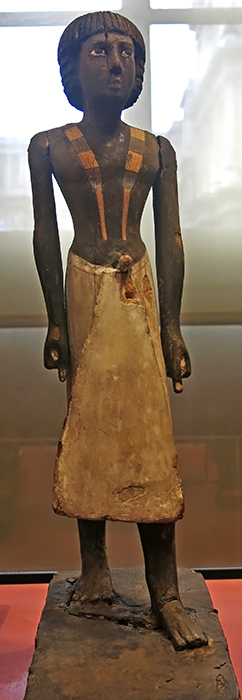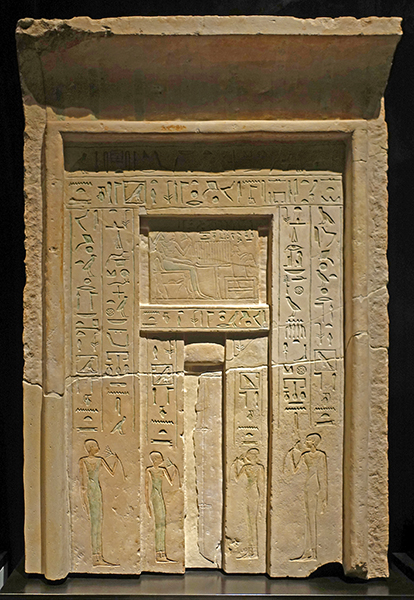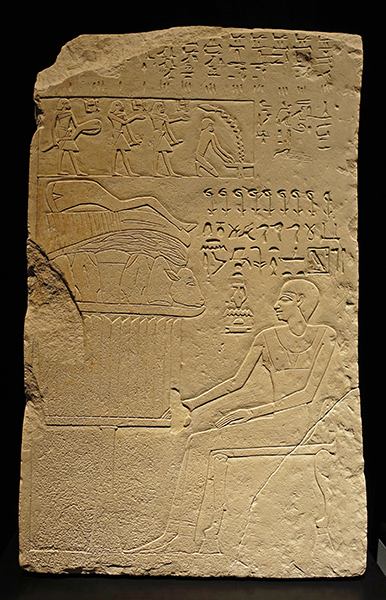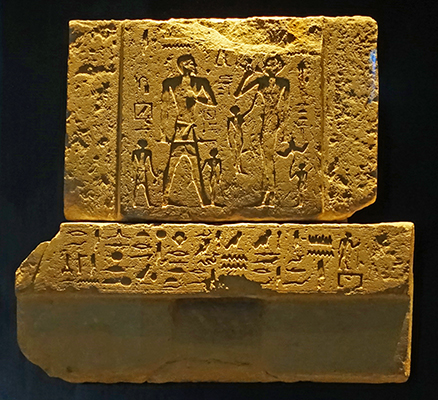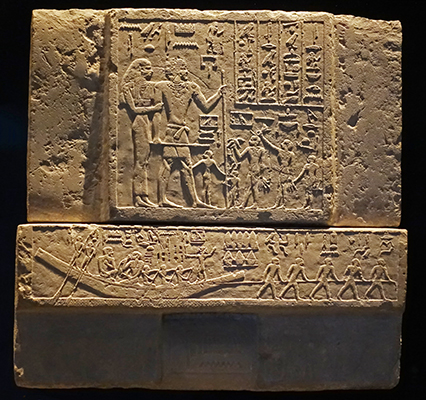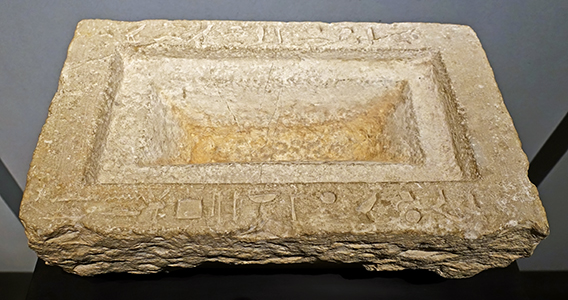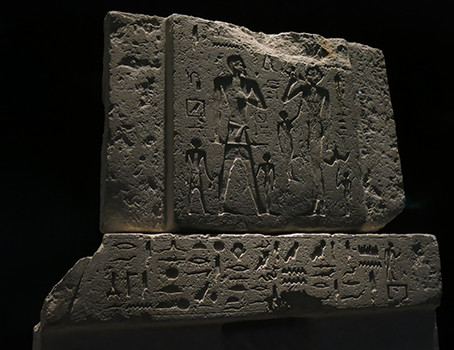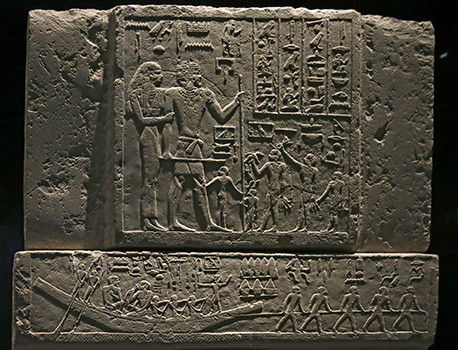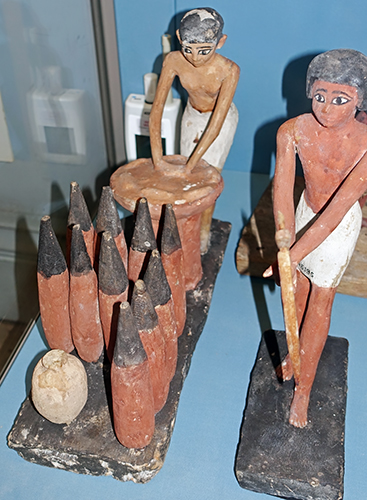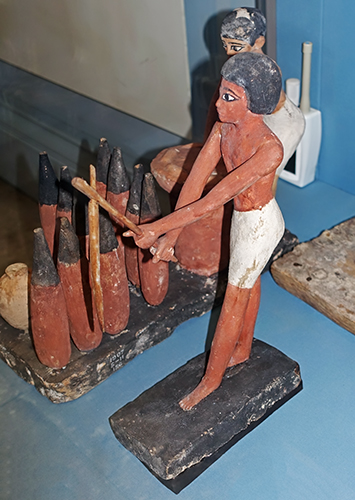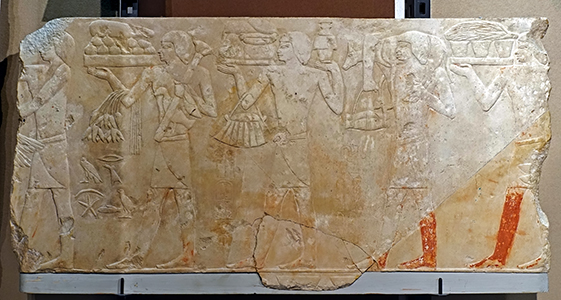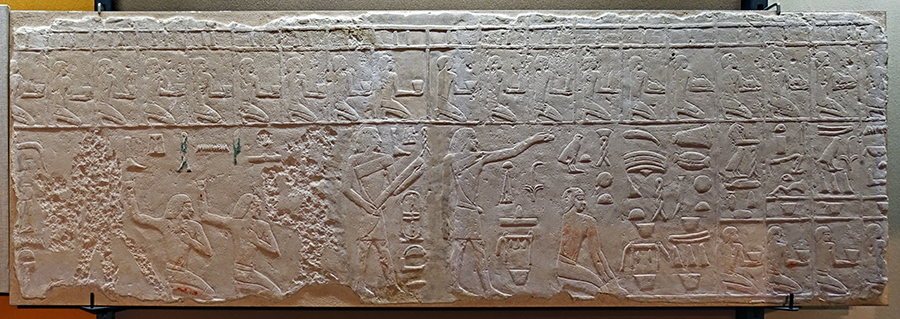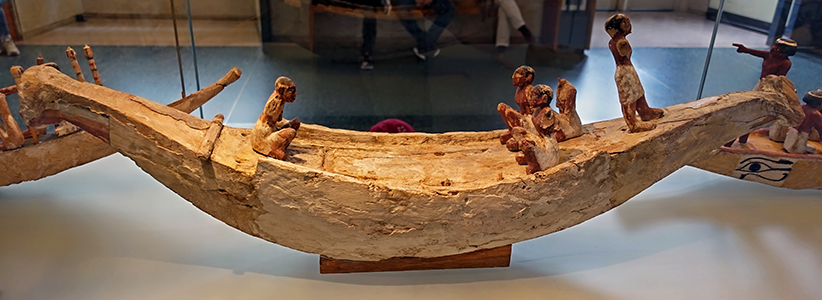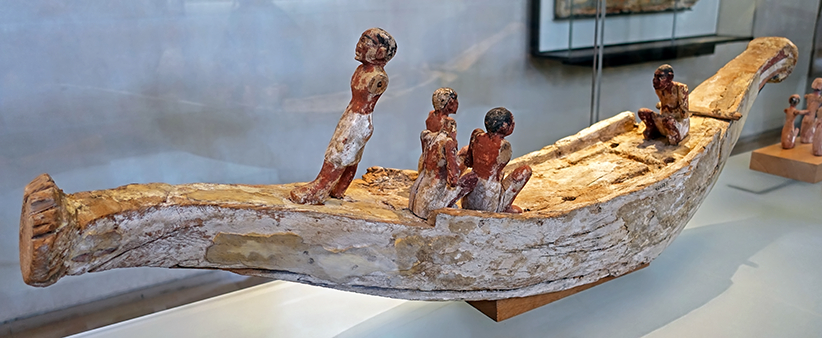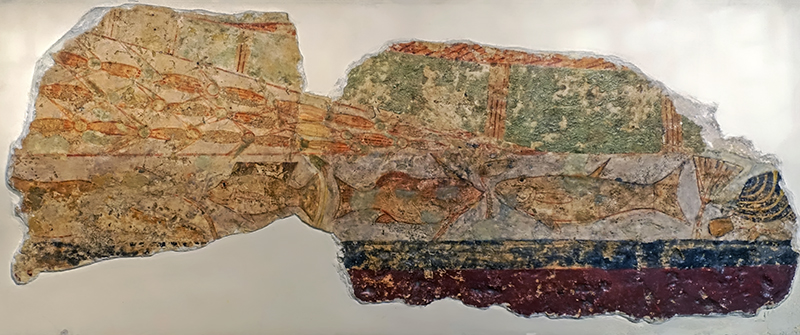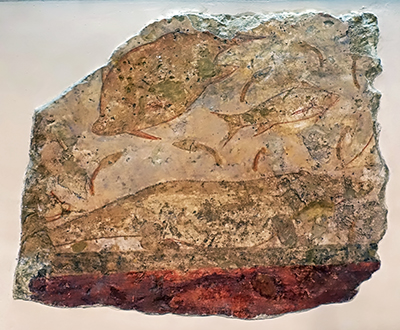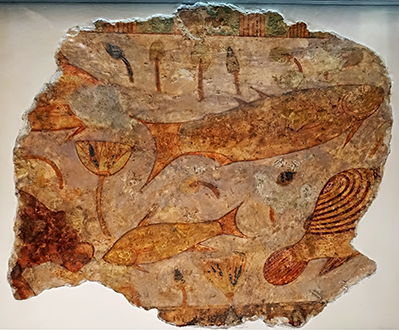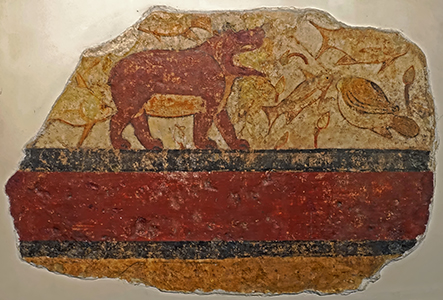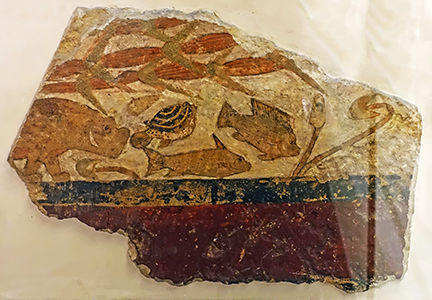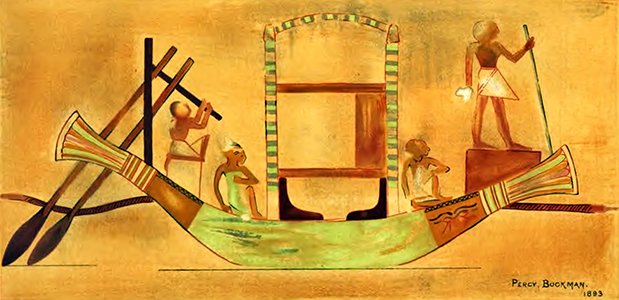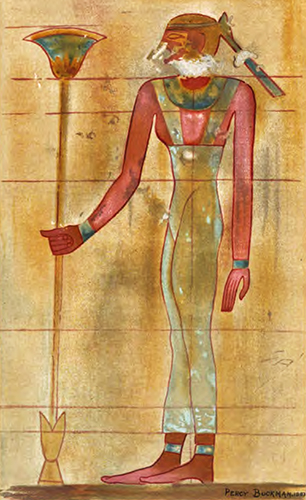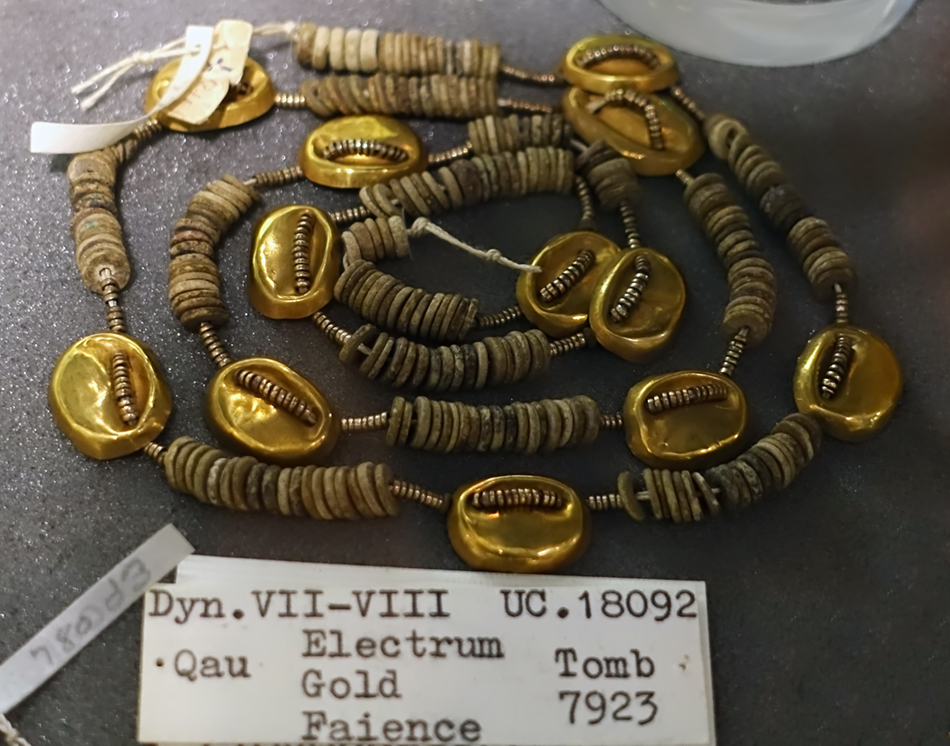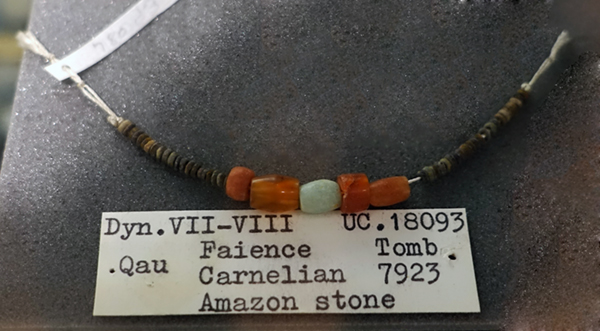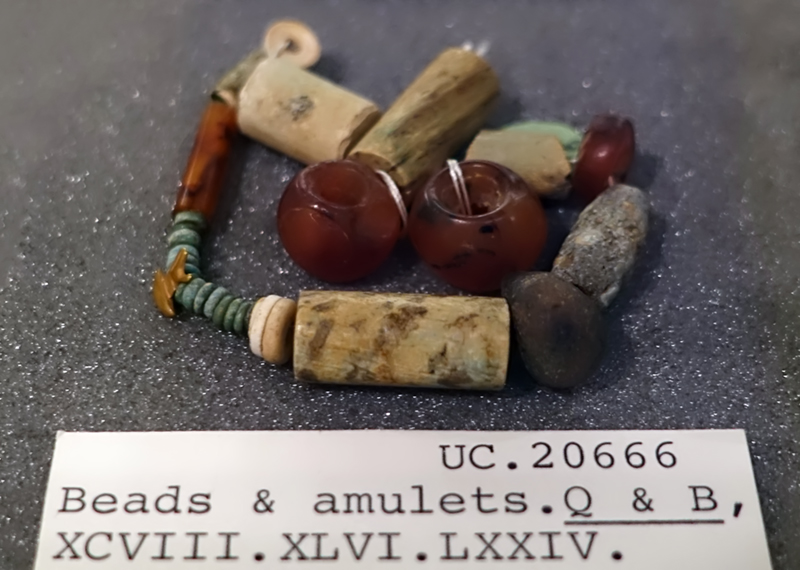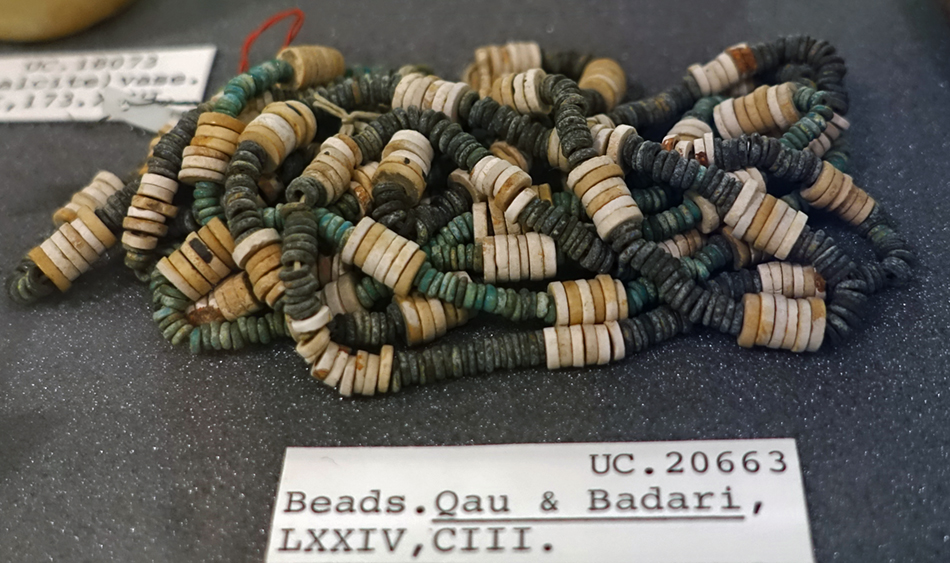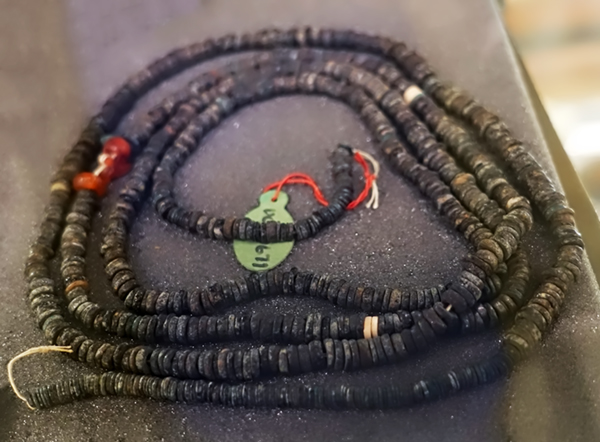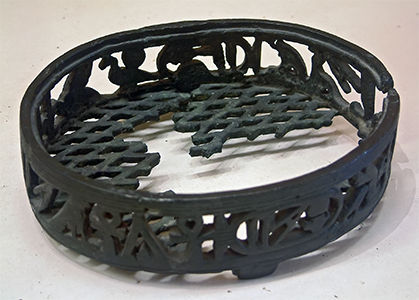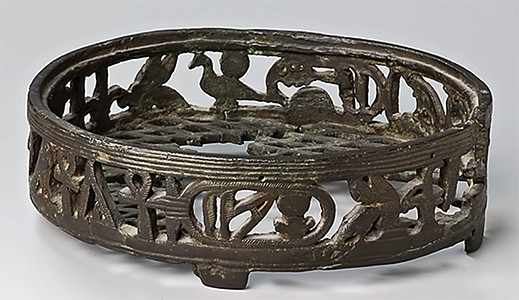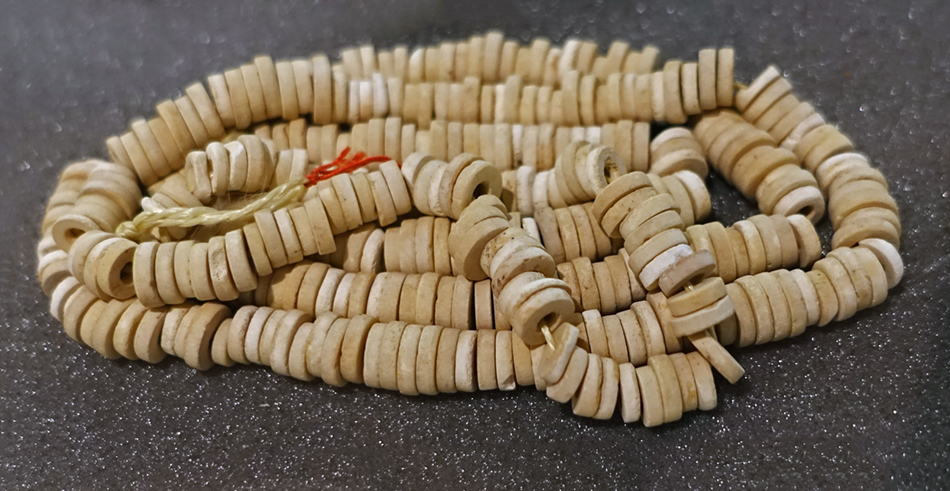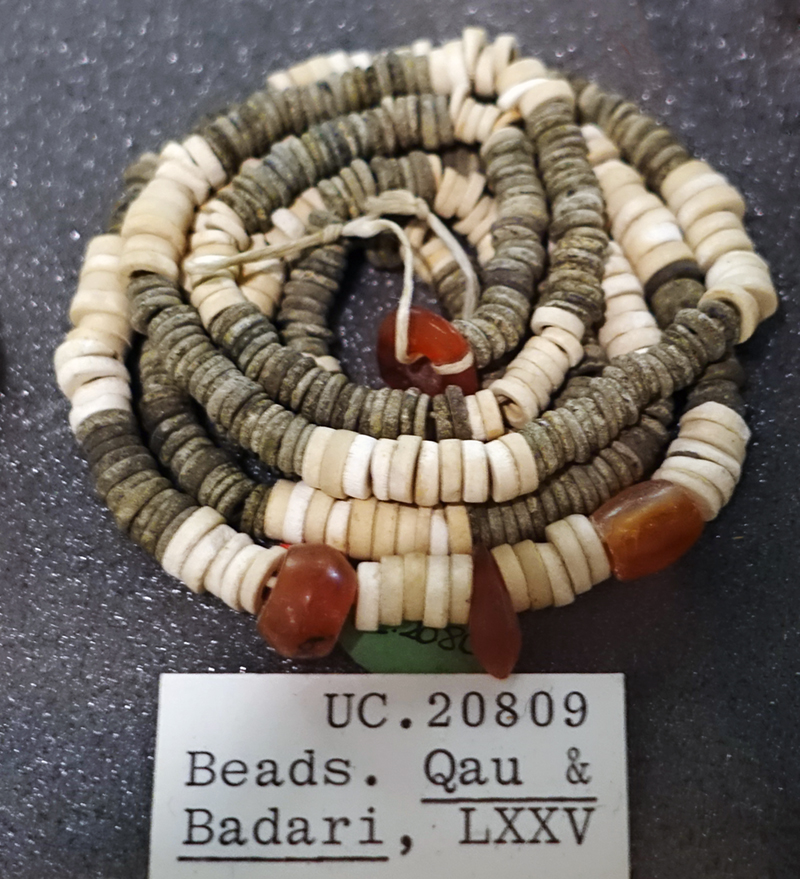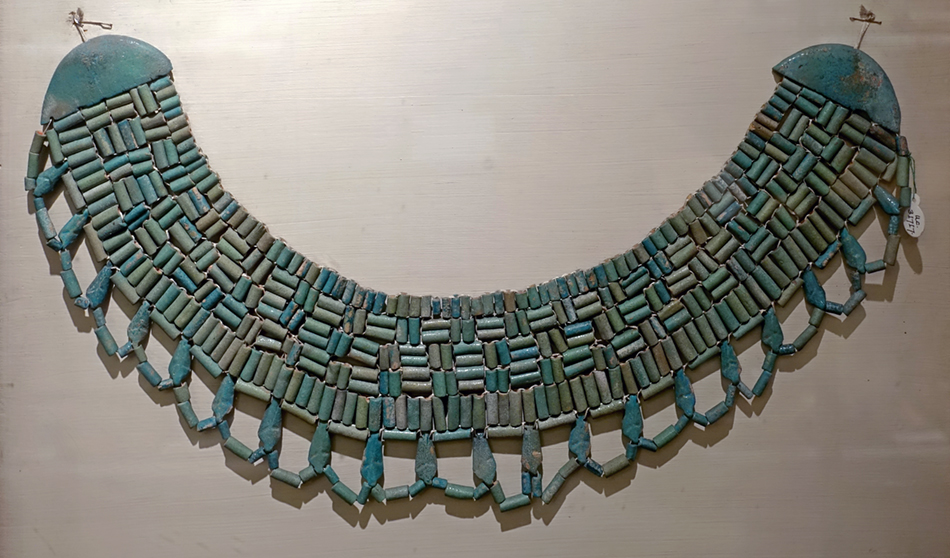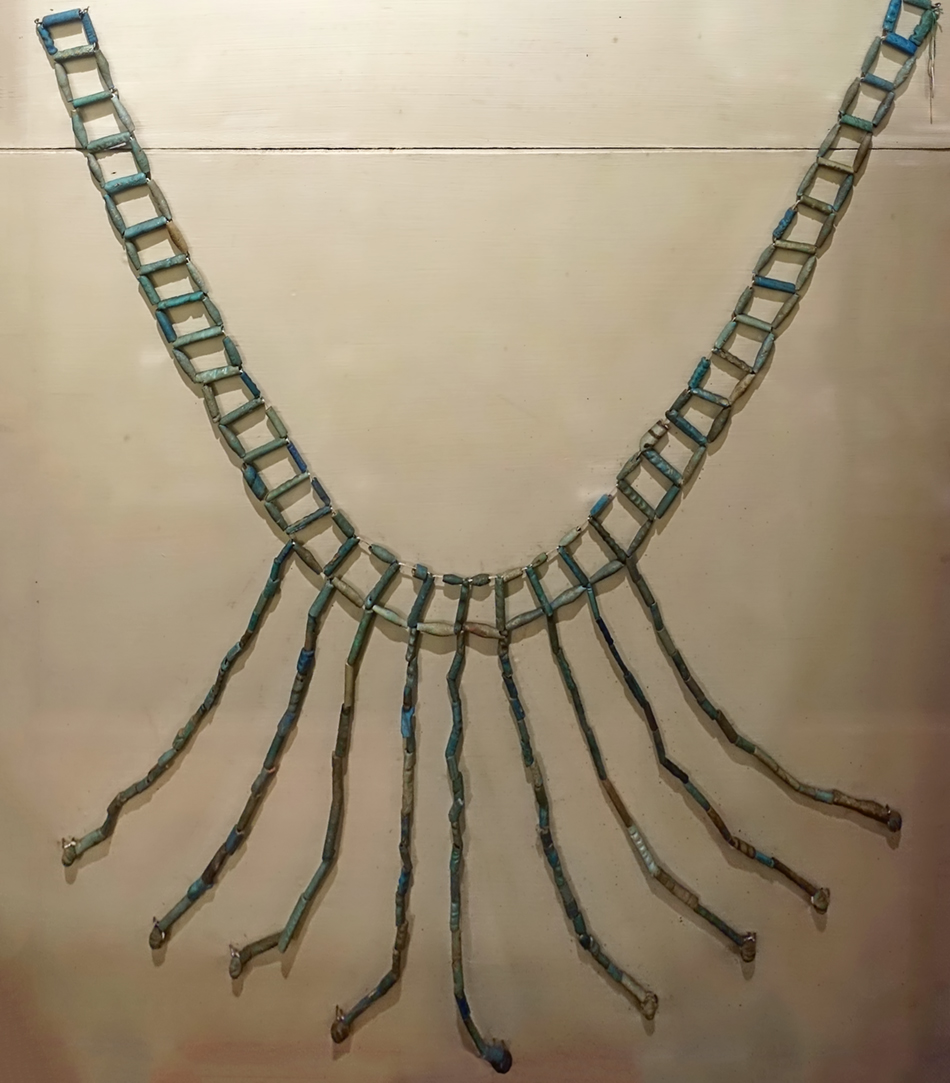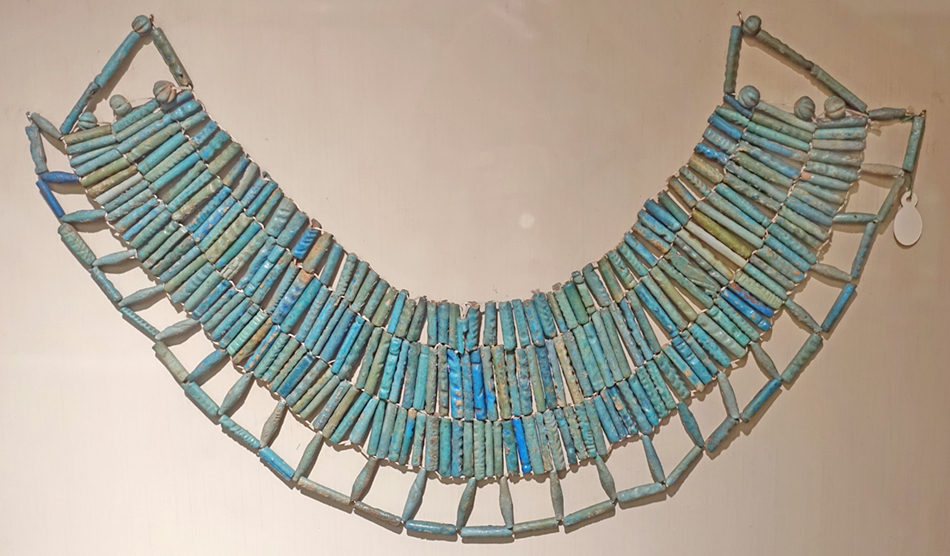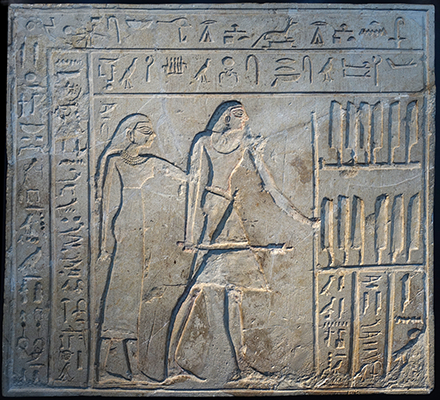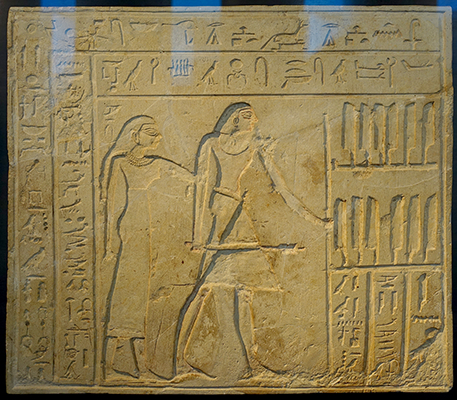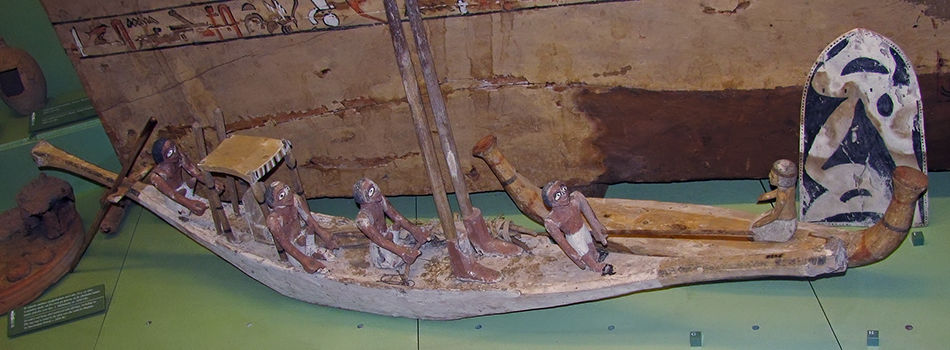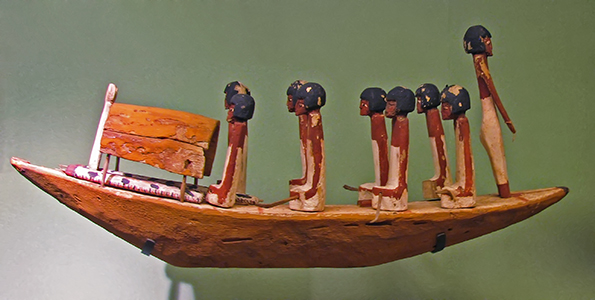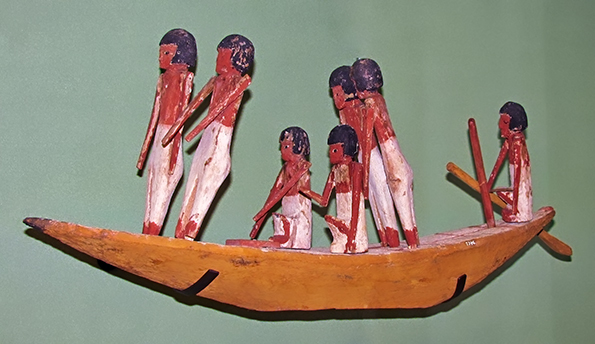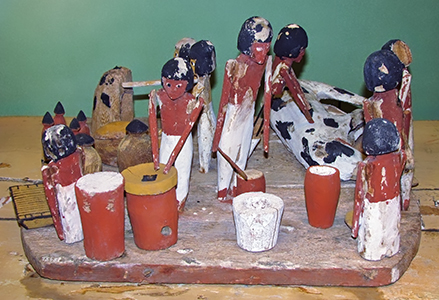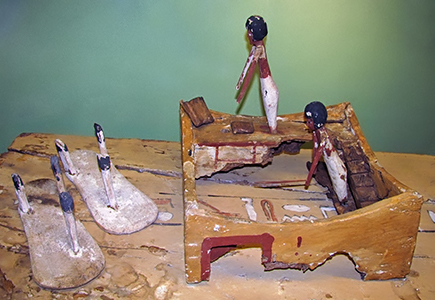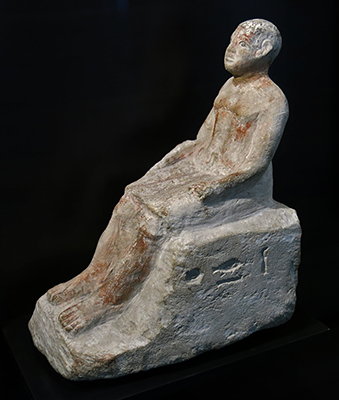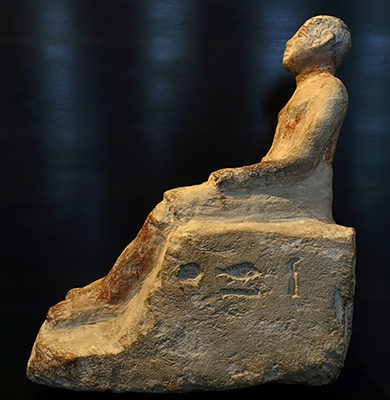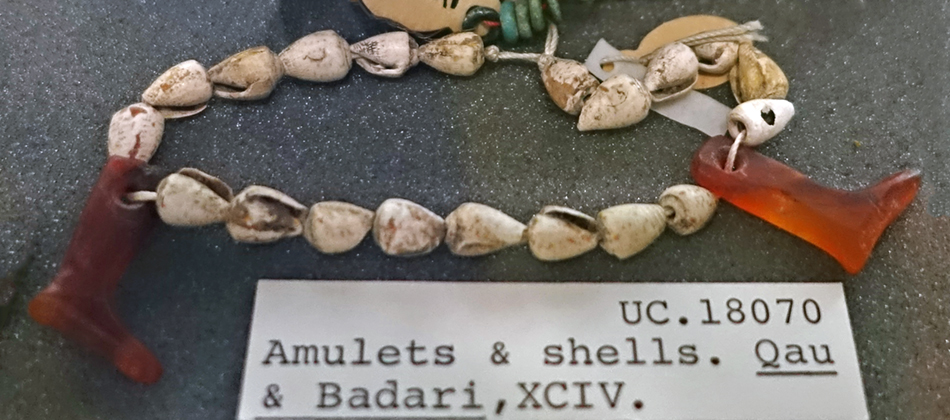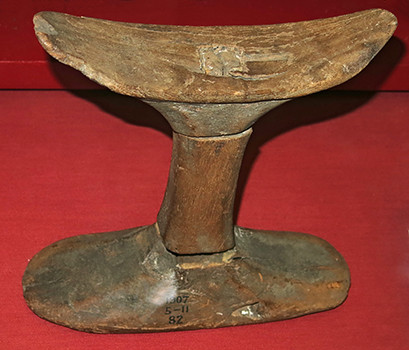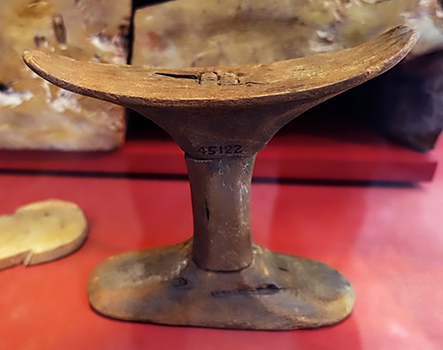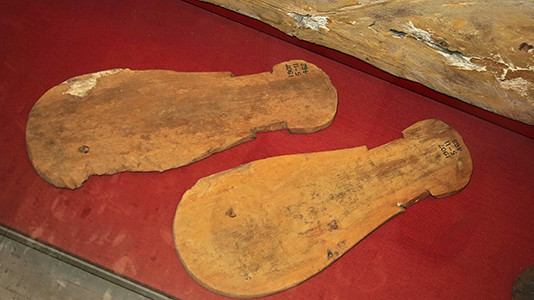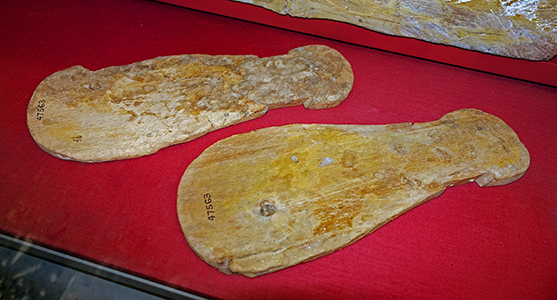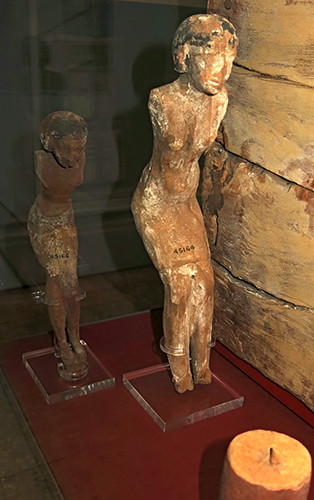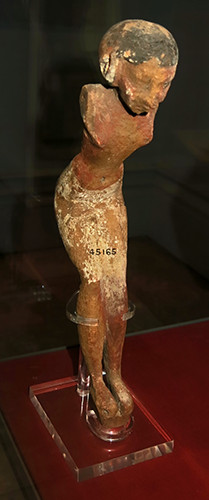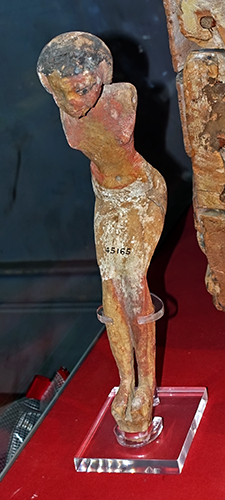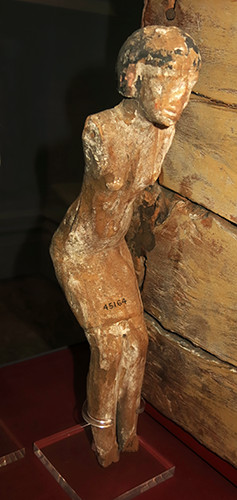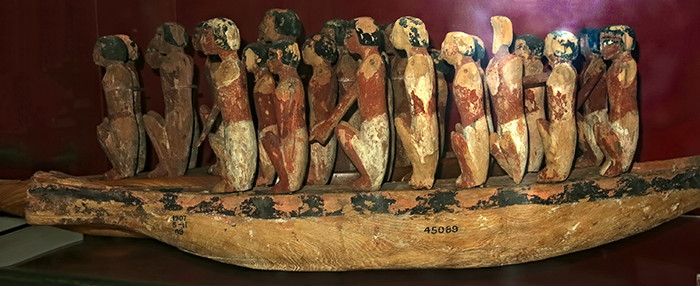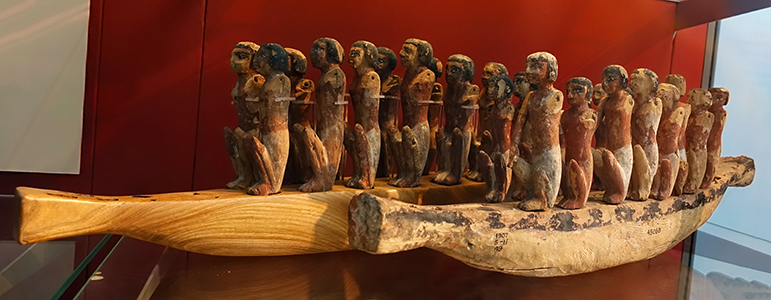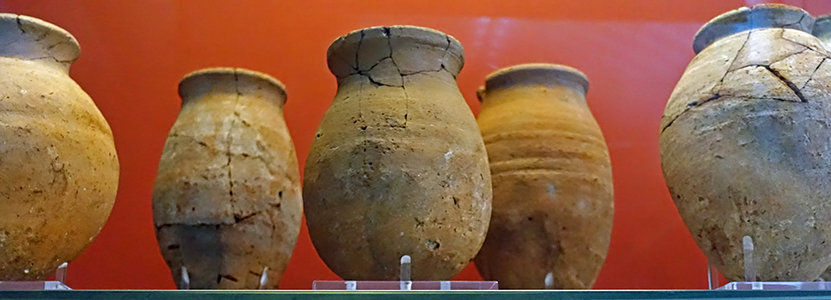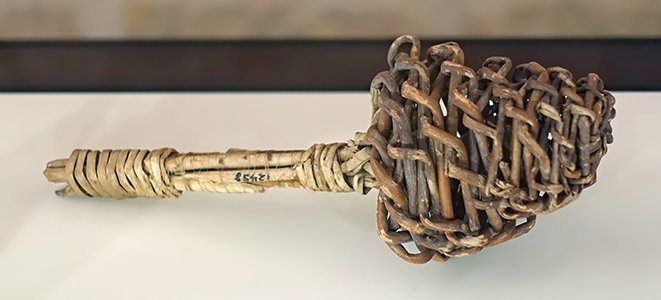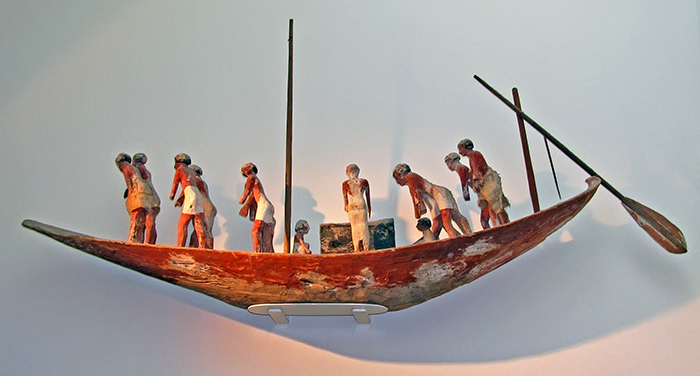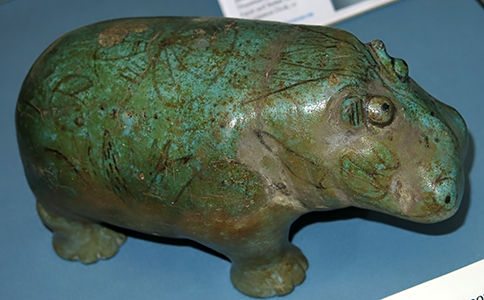Back to Don's Maps
 Back to Archaeological Sites
Back to Archaeological Sites
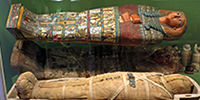 Back to Egypt Index Page
Back to Egypt Index Page
Ancient Egyptian culture from the 1st Dynasty to the end of the 10th Dynasty
Egyptian Chronology
| Egyptian Chronology | ||
|---|---|---|
| Date | Culture | Duration |
| 11 000 BC | Jebel Sahaba | |
| Before 8 000 BC - Palaeolithic in Europe and Northern Asia | ||
| 8 000 BC - Nominal end of the Ice Age | ||
| 8 600 - 4 400 BC | Nabta Playa Neolithic | 4 200 years |
| 6 100 - 5 180 BC | Qarunian (formerly known as Fayum B) | 920 years |
| 5 200 - 4 200 BC | Fayum A | 1 000 years |
| 4 800 - 4 200 BC | Merimde | 600 years |
| 4 600 - 4 400 BC | El Omari | 200 years |
| 4 400 - 4 000 BC | Badarian | 400 years |
| 4 000 - 3 300 BC | Maadi | 700 years |
| 3 900 - 3 650 BC | Naqada I | 250 years |
| 3 650 - 3 300 BC | Naqada II | 350 years |
| 3 300 - 2 900 BC | Naqada III | 400 years |
| 3 100 - 2 670 BC | Early Dynastic | 430 years |
| 2 670 - 2 181 BC | Old Kingdom | 489 years |
| 2 181 - 2 025 BC | First Intermediate Period | 156 years |
| 2 025 - 1 700 BC | Middle Kingdom | 325 years |
| 1 700 - 1 550 BC | Second Intermediate Period | 150 years |
| 1 550 - 1 077 BC | New Kingdom | 473 years |
| 1 077 - 664 BC | Third Intermediate Period | 413 years |
| 664 - 332 BC | Late Period | 332 years |
| 525 - 404 BC | First Persian Period | 121 years |
| 404 - 343 BC | Late Dynastic Period | 61 years |
| 343 - 332 BC | Second Persian Period | 11 years |
| 332 - 305 BC | Macedonian Period | 27 years |
| 305 - 30 BC | Ptolemaic Period | 275 years |
| 30 BC - 395 AD | Roman Period | 425 years |
| 395 AD - 640 AD | Byzantine Period | 245 years |
| 640 AD - 1517 AD | Islamic Period | 877 years |
| 1517 AD - 1867 AD | Ottoman Period (French Occupation 1798-1801) |
350 years |
| 1867 AD - 1914 AD | Khedival Period | 47 years |
| 1914 AD - 1922 AD | Sultanate under Hussein Kamel, as a British Protectorate |
8 years |
| 1922 AD - 1953 AD | Monarchy | 31 years |
| 1953 AD - Present Day | Republic | |
| First to Twentieth Dynasties | |||
|---|---|---|---|
| Date | Dynasty | Period | Duration (years) |
| 3 100 - 2 890 BC | First Dynasty | Archaic/Early Dynastic Period | 214 |
| 2 890 - 2 670 BC | Second Dynasty | Archaic/Early Dynastic Period | 220 |
| 2 670 - 2 613 BC | Third Dynasty | Old Kingdom | 57 |
| 2 613 - 2 494 BC | Fourth Dynasty | Old Kingdom - Golden Age | 119 |
| 2 494 - 2 345 BC | Fifth Dynasty | Old Kingdom | 149 |
| 2 345 - 2 181 BC | Sixth Dynasty | Old Kingdom | 164 |
| 2 181 - 2 160 BC | Seventh and Eighth Dynasties | First Intermediate Period | 21 |
| 2 160 - 2 134 BC | Ninth and Tenth Dynasties | First Intermediate Period | 26 |
| 2 134 - 1 991 BC | Eleventh Dynasty | Middle Kingdom | 43 |
| 1 991 - 1 802 BC | Twelfth Dynasty | Middle Kingdom | 189 |
| 1 802 - 1 649 BC | Thirteenth Dynasty From Memphis, over Middle and Upper Egypt |
Middle Kingdom | 153 |
| 1 805 - 1 650 BC | Fourteenth Dynasty From Avaris, Nile Delta, over Lower Egypt |
Second Intermediate Period | 155 |
| 1 650 - 1 550 BC | Fifteenth Dynasty First Hyksos dynasty, ruled from Avaris, without control of the entire land |
Second Intermediate Period | 100 |
| 1 649 - 1 582 BC | Sixteenth Dynasty Ruled the Theban region in Upper Egypt The Hyksos ruled the delta The Kingdom of Kush ruled Upper Egypt |
Second Intermediate Period | 67 |
| 1 580 - 1 550 BC | Seventeenth Dynasty Ruled Thebes, Hyksos ruled the delta |
Second Intermediate Period / New Kingdom | 30 |
| 1 543 - 1 292 BC | Eighteenth Dynasty Egypt reaches the peak of its power |
New Kingdom | 251 |
| 1 292 - 1 187 BC | Nineteenth Dynasty Conquests in Canaan |
New Kingdom | 105 |
| 1 187 - 1 077 BC | Twentieth Dynasty | End of the New Kingdom | 110 |

Timeline for early Egypt, from 11 000 BC to 2 500 BC.
Photo: Poster, British Museum © Trustees of the British Museum, CC BY-NC-SA 4.0
Rephotography: Don Hitchcock 2015
The First Dynasty
The First Dynasty of ancient Egypt covers the first series of Egyptian kings to rule over a unified Egypt. It immediately follows the unification of Upper and Lower Egypt, possibly by Narmer, also known as Menes, and marks the beginning of the Early Dynastic Period, a time at which power was centred at Thinis.
The date of this period falls within the early Bronze Age. In a 2013 study based on radiocarbon dates, the beginning of the First Dynasty - the accession of Hor-Aha - was placed close to 3 100 BC.
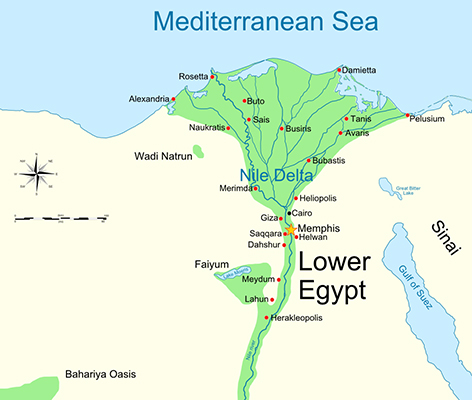
Lower Egypt is usually defined as the Nile delta, plus the depression/oasis of Faiyum. In Dynastic times, Faiyum was first recorded as a lake around 3 000 BC, but at that time it would only be filled when the nile flood was particularly high.
In 2 300 BC, the waterway from the Nile to the natural lake was widened and deepened to make a canal which is now known as the Bahr Yussef. This canal fed into the lake. This was meant to serve three purposes: control the flooding of the Nile, regulate the water level of the Nile during dry seasons, and serve the surrounding area with irrigation. There is evidence of ancient Egyptian pharaohs of the twelfth dynasty using the natural lake of Faiyum as a reservoir to store surpluses of water for use during dry periods.
Upper Egypt consists of the arable lands beside the Nile upstream of the Faiyum hollow, as far as the island of Elephantine, at the First Cataract.
Photo: Ancient_Egypt_map-en.svg: Jeff Dahl. Derivative work: MinisterForBadTimes (talk)
Permission: Creative Commons Attribution-Share Alike 3.0 Unported, 2.5 Generic, 2.0 Generic and 1.0 Generic license.
Text: Adapted from Wikipedia
| First Dynasty | ||
|---|---|---|
| Name | Years | Date (uncertain, gaps exist, some overlap) |
| Narmer/Menes | Unknown, but long. His name is recorded 98 times at 26 sites in Egypt, southern Canaan and Sinai | Circa 3150 BC |
| Hor-Aha | Unknown, but long. | Circa 3 125 BC |
| Djer | 40 - 54 | Circa mid thirty first century BC |
| Djet | 10 | Circa 2 980 BC |
| Den | 42 | 2 970 BC – 2 928 BC |
| Anedjib / Adjib / Merybiap | 10 | Circa 2 930 BC |
| Semerkhet | 8½ | Circa 2 920 BC |
| Qa'a (Kaa) | 34 | Circa 2 910 BC |
| Sneferka | Short | Circa 2 900 BC |
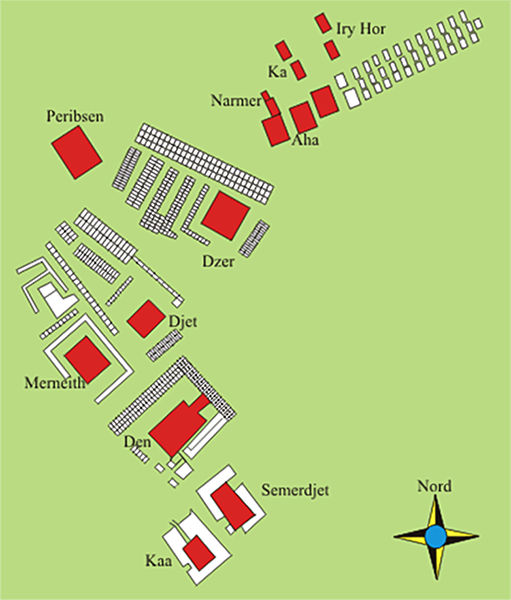
Cemetery B, Umm el-Qa'ab. Tombs of the pharaohs of the first and second dynasty of Egypt.
Photo: http://www.wikiwand.com/hr/Merneit
Text: http://www.wikiwand.com/en/Merneith
Early Dynastic temples
First - Second Dynasty
3 100 - 2 670 BC
Temples in the Early Dynastic period seem to have been small places, accessible to all. There, people asked the gods for help, worshipped, and made gifts. Items they left ranged from interesting natural pebbles, to ornate palettes provided by kings. Because the offerings were carefully buried during rebuilding, deposits have been found at many sites. The objects on display are mainly from Abydos, and show the range of items used and donated in temples at this time.
Text above: Poster at the British Museum, © Trustees of the British Museum, CC BY-NC-SA 4.0
Burial in the First Dynasty
3 100 - 2 890 BC
First Dynasty kings were buried in large cedar shrines. Those of their subjects with sufficient means had small boxes made of native wood with just enough room to fit their contracted bodies. Most boxes were plain, like the one displayed here, but some were decorated to emulate shrines and became the prototypes for later coffins.
Grave goods now expressed status by their quantity, rather than their quality. In rich tombs numerous storage chambers were added both above and below ground to hold them all, The objects shown here are typical of the burial of a relatively wealthy person in the First Dynasty.
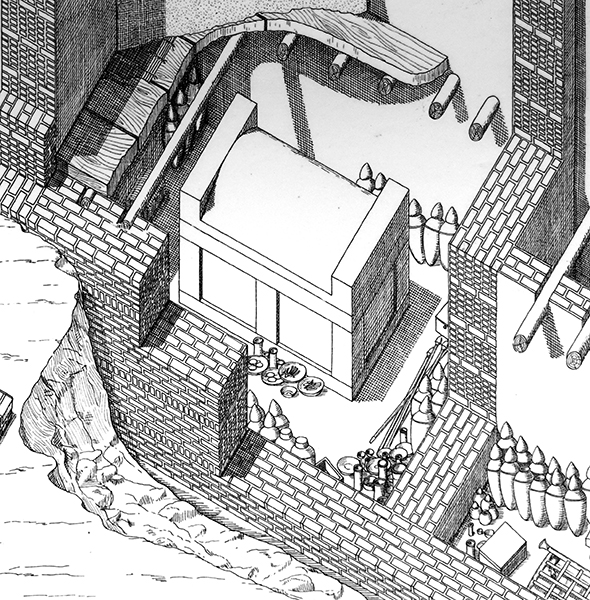
This is Walter Emery's reconstruction of the burial chamber of Saqqara 3503, a First Dynasty tomb of the highest elite. It may very well be a royal tomb belonging to Mer-Neith, who may have been the consort of Djer and could have even ruled Egypt for a short time. In this tomb, the substructure pit measures 1425 cm by 450 cm and was divided into five chambers. Again, the central one was the burial chamber, which measured 480 cm by 350 cm in size. When discovered, it contained fragments of a wooden sarcophagus and on its base was found a few human bones. Old (gold?) foil remains were found scattered about the chamber. The burial chamber also held the remains of a funerary meal, pottery vessels near the walls, traces of wooden and basketwork chests, and the fragments of wooden canopy poles.
The superstructure of this tomb contained nine niches on the longer side and three on the short ones, some of them still retaining traces of paint. Inside there were 21 magazines that were well preserved but plundered, though some were collapsed or had been set on fire soon after being plundered. Many of the stone vessels found in the tomb have been dated to the reign of Djer, and at least two seal impressions were found that alternated the serekh of Djer and a serekh-like device containing the name of Mer-Neith. This device was surmounted by a Neith standard rather than that of Horus.
This tomb was surrounded by an enclosure wall, and twenty to twenty-two subsidiary burials. Within the subsidiary burials, some boat models were found, and on the occupant of one was a copper blade that had apparently been strapped to the individual's ankle. Another subsidiary burial contained a wooden box that may have contained some sort of copper tool, perhaps for surgery. On the north side, a brickwork casing for a funerary boat was discovered beyond the subsidiary burials. Note that the boat containment was entirely above ground, rather than dug into a pit. The earliest burials of nobles can be traced back to the First Dynasty, at the north side of the Saqqara plateau. During this time, the royal burial ground was at Abydos. The first royal burials at Saqqara, comprising underground galleries, date to the Second Dynasty.
Photo: Poster, British Museum © Trustees of the British Museum, CC BY-NC-SA 4.0, Courtesy of the Egypt Exploration Society, London
Rephotography: Don Hitchcock 2018
Text: poster at the Museum © Trustees of the British Museum, CC BY-NC-SA 4.0
Additional text: http://www.touregypt.net/featurestories/firstdynastysaqqara.htm
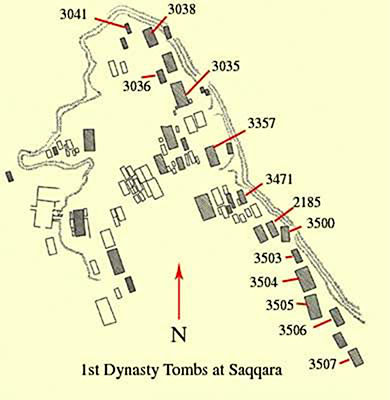
First Dynasty tombs at Saqqara
Photo: http://www.touregypt.net/featurestories/firstdynastysaqqara.htm
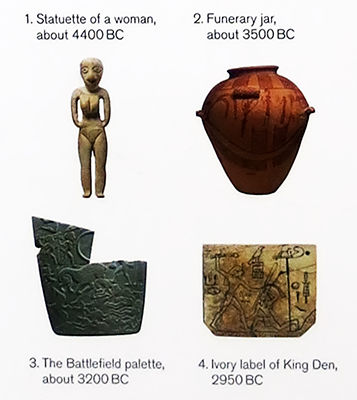
The Raymond and Beverly Sackler Gallery in Room 64 of the British Museum illustrates the beginnings of ancient Egyptian civilisation among nomads in the Sahara desert and the distinctive agricultural communities along the Nile.
By 3100 BC these cultures merged, forming the basis for the world's earliest unified state. Unification brought rapid social and technological advances, leading to the creation of the monumental pyramid tombs in the Old Kingdom, 500 years later.
Photo: Poster, British Museum © Trustees of the British Museum, CC BY-NC-SA 4.0
Rephotography: Don Hitchcock 2015
Text: poster at the Museum © Trustees of the British Museum, CC BY-NC-SA 4.0
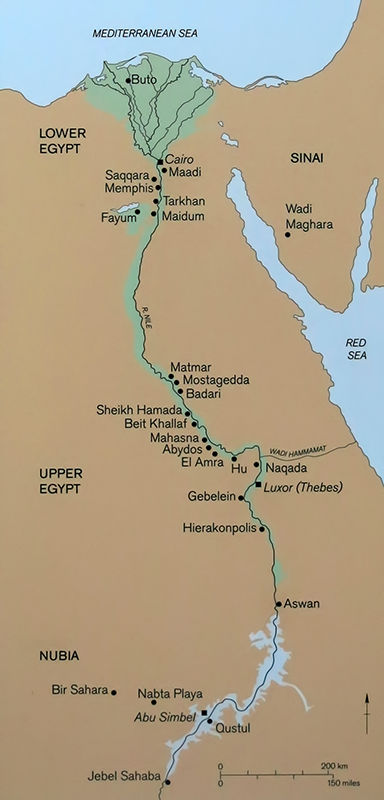
Map of the major sites and places in Early Egypt.
Photo: Poster, British Museum © Trustees of the British Museum, CC BY-NC-SA 4.0
Rephotography: Don Hitchcock 2015
Text: poster at the Museum © Trustees of the British Museum, CC BY-NC-SA 4.0
The First Dynasty
3 100 - 2 890 BC
For the ancient Egyptians, human history began with the First Dynasty. This series of eight kings from Abydos ruled over a unified country. Much of what we know about them comes from their tombs at Abydos. These were situated in the desert near a wadi (valley) believed to give direct access to the afterlife.
Large mud brick enclosures at the desert's edge, about a mile away, served as funerary temples where rituals were enacted. These early kings ruled an increasingly urban society that was socially divided and spread over a large geographical area. Using a mixture of traditional and new ideology, effective management and brute force, they forged the world's first nation state. Their achievements in art, architecture, administration and religious doctrine formed the foundation for the future development of Egyptian civilisation.
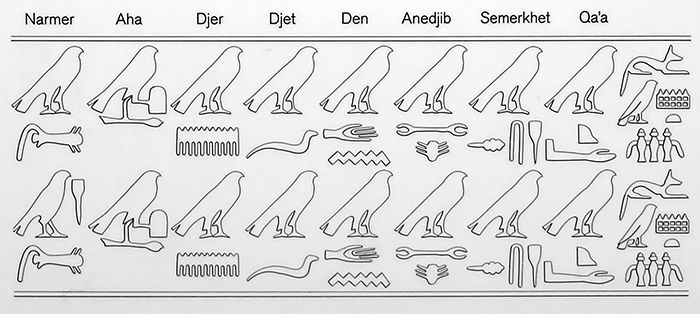
First Dynasty: 3 100 - 2 890 BC
The Kings of the First Dynasty
Seal of the Abydos royal necropolis listing the kings of the First Dynasty, courtesy of the German Archaeological Institute Cairo.
Photo: from the card at the British Museum, © Trustees of the British Museum, CC BY-NC-SA 4.0
Text: Card at the British Museum, www.britishmuseum.org/, © Trustees of the British Museum, CC BY-NC-SA 4.0
Narmer: Egypt's first king
First Dynasty
3100 BC
Narmer inaugurated Egypt's First Dynasty by winning a battle in the western Delta and fully unifying the country.
Recording this victory on his magnificent palette, shown below, Naimer declared his control over all of Egypt by wearing the crowns of both Upper and Lower Egypt.
Then, turning his attention to Canaan, he made further conquests. Narmer's achievement in unifying the two lands brought prosperity to his subjects, and promoted the first great flowering of Egyptian civilisation.
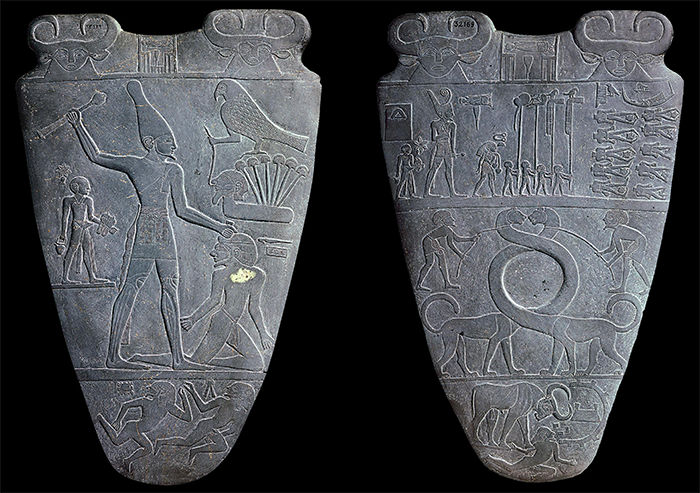
First Dynasty: 3 100 - 2 890 BC
The Narmer Palette
Cast of the palette of Narmer
Wearing Upper Egypt's White Crown, Narmer smites a ruler from the west Delta, sealing the final victory that unified Egypt.
Narmer's patron god, Horus, presents him with a personification of the Delta lands, affirming his rule over the entire country.
This is a cast of the original which is now in the Egyptian Museum, Cairo.
It is a plaster cast in two halves of a ceremonial palette. The original, executed in grey mudstone, was discovered by Quibell in 1894 in Kom el-Ahmar (Hierokonpolis). The decoration shows mythological and real animals.
Catalog: First Dynasty, EA35715
Photo: Public Domain ![]()
Permission: This is a faithful photographic reproduction of a two-dimensional, public domain work of art. The work of art itself is in the public domain for the following reason: This work is in the public domain in its country of origin and other countries and areas where the copyright term is the author's life plus 100 years or less. This file has been identified as being free of known restrictions under copyright law, including all related and neighbouring rights.
Text: Card at the British Museum, http://www.britishmuseum.org/, © Trustees of the British Museum, CC BY-NC-SA 4.0
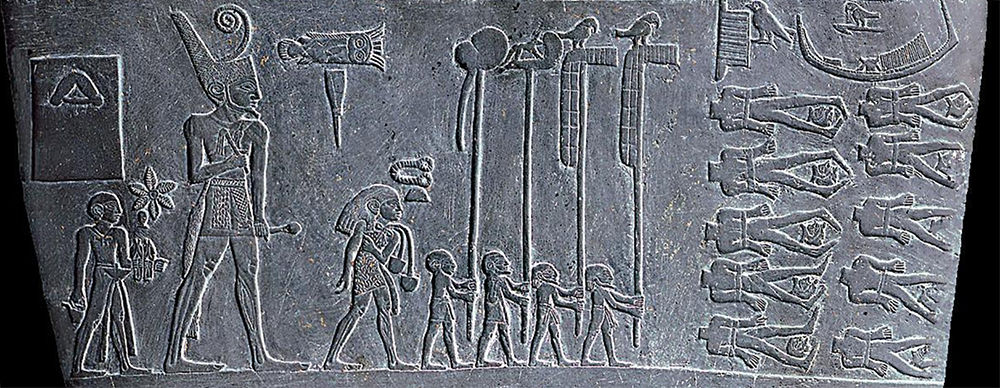
Above, a detail from the palette's flip side, shown in full above, shows Narmer wearing Lower Egypt's Red Crown in a procession to view decapitated prisoners at Buto, in the western Delta.
Note the name of Narmer is shown as a catfish, his icon, along with the chisel, his other icon.
Photo: Public Domain
Text: Card at the British Museum, http://www.britishmuseum.org/, © Trustees of the British Museum, CC BY-NC-SA 4.0
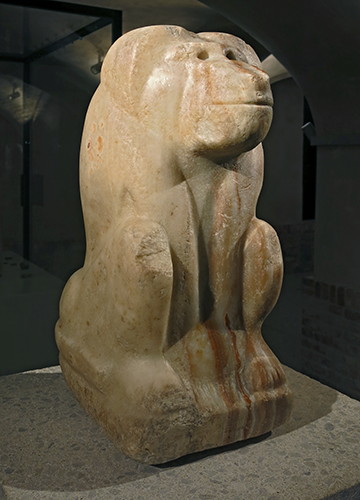
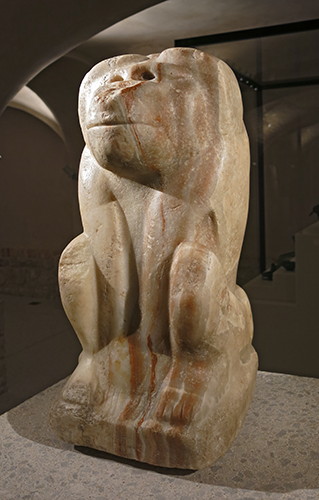
First Dynasty: 3 100 - 2 890 BC
Narmer Baboon
Seated figure of a baboon with the cartouche of king Narmer.
According to Günter Dreyer 2013,this statue probably shows Narmer after his death as an ancestral god, 'the great white one', and may have originated in his as-yet-unidentified funerary enclosure at Abydos. According to Aston, Harrell and Shaw 2000, the material is more accurately described as travertine.
Catalog: Calcite-Alabaster, ÄM 22607
Photo: Don Hitchcock 2015
Source: Original, Staatliche Museen zu Berlin, Neues Museum, Germany
Text: © Card at the Staatliche Museen zu Berlin (CC BY-NC-SA 3.0 DE)
Additional text: https://www.narmer.org/inscription/0125 (full bibliography not given)
First Dynasty: 3 100 - 2 890 BC
Falcon statuette
This limestone statuette of the falcon god Horus is pierced at the base for mounting on a pole. Images of the gods were taken to the hunt or into battle as emblems and protection.
The figure has been carved in summary fashion, the only details shown in relief being the eyes and beak.
Diameter 19 mm (hole), height 85 mm, length 161 mm, width 54 mm, depth 32 mm.
Catalog: Abydos, Osiris Temple, First Dynasty, EA38049
Photo: Don Hitchcock 2018
Source: Original, British Museum
Text: Card at the British Museum, http://www.britishmuseum.org/, © Trustees of the British Museum, CC BY-NC-SA 4.0
First Dynasty: 3 100 - 2 890 BC
Jar sealing of Narmer
The name of Narmer, written as a catfish within a serekh (royal name box), has been impressed with a large cylinder seal several times onto this conical jar lid.
The chisel, the second element of Narmer's name and perhaps originally a title, appears as a decorative band between the two rows. The jar probably held wine, and three deep horizontal marks on one side of the lid may be an indication of its quality.
A conical jar-seal of brown clay with a red pottery lid adhering to the underside. The seal bears four impressed inscriptions, one of which is not very visible.
Four impressions, three of which show the repeated name of Narmer, whilst the fourth depicts a lion crouching before a shrine. The latter impression is very worn and only small parts can be distinguished. The lion motif is common on the Early Dynastic mud seal impressions.
Height 185 mm, width 230 mm.
Catalog: First Dynasty, Umm el-Qaab (Abydos), cemetery B, EA35522
Photo (right): Don Hitchcock 2015, 2018
Photo (left): Card at the British Museum, © Trustees of the British Museum, CC BY-NC-SA 4.0
Source: Original, British Museum
Text: Card at the British Museum, http://www.britishmuseum.org/, © Trustees of the British Museum, CC BY-NC-SA 4.0
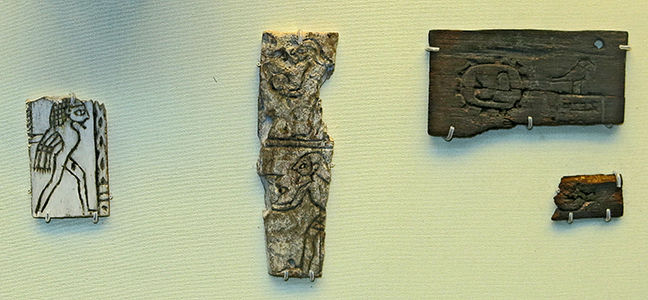
First Dynasty: 3 100 - 2 890 BC
Narmer's ivory inlays and ebony label
Narmer was proud of his accomplishments and recorded them on many objects. Ivory inlays for a box depict bound prisoners and foreigners bearing tribute jars from Canaan. The same oil jar appears on the fragmentary ebony label. Above it is a representation of a walled town, which some believe housed Canaanite prisoners captured during Narmer's military campaigns.
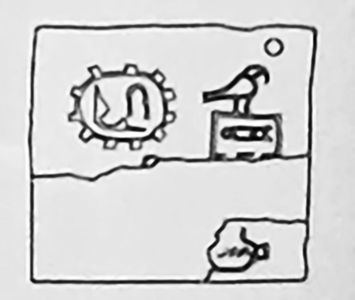
Catalog: First Dynasty, Abydos, Tomb of Narmer, EA35514, EA35515, EA35519
Photo (above): Don Hitchcock 2015
Photo (left): Card showing a line drawing of the ebony label, at the British Museum, © Trustees of the British Museum, CC BY-NC-SA 4.0
Source: Original, British Museum
Text: Card at the British Museum, http://www.britishmuseum.org/, © Trustees of the British Museum, CC BY-NC-SA 4.0
First Dynasty: 3 100 - 2 890 BC
Narmer's stone jar fragment and ivory piece
Under Narmer the writing of the king's name became an art form. Depending on the available space, Narmer's name could be written with the catfish alone, as on the ivory carving, or in more detail with a catfish and a chisel, as on the jar fragment and his palette.
EA55587: Fragment of an ivory plaque with the name of Nar(mer) incised on one side. The inscription is well preserved, although the sides and back of the fragment are broken.
Length: 35 mm, width 18 mm.
EA32640: Part of a thick-walled cylinder jar of calcite. Bears the serekh of Narmer in low relief on the exterior surface. The bottom of the inscription is missing and the stone has been darkened by burning.
Length 90 mm, width 95 mm.
Catalog: Naqada, Tomb of Neith-hotep, First Dynasty. EA55587
Abydos, Tomb of Djet, First Dynasty, EA32640
Photo: Don Hitchcock 2015
Source: Original, British Museum
Text: Card at the British Museum, http://www.britishmuseum.org/, © Trustees of the British Museum, CC BY-NC-SA 4.0
First Dynasty: 3 100 - 2 890 BC
Narmer's stone jar fragment and ivory piece
Part of a jar-seal of dark grey clay, bearing the repeated impression of the name of Aḥa, together with two signs. The clay is slightly cracked but the inscribed surface is well-preserved.
Length 85 mm, width 70 mm.
Catalog: First Dynasty, Abydos, tomb B19, EA35520
Photo (left): © Trustees of the British Museum, CC BY-NC-SA 4.0
Photo (right): Don Hitchcock 2018
Source: Original, British Museum
Text: Card at the British Museum, http://www.britishmuseum.org/, © Trustees of the British Museum, CC BY-NC-SA 4.0
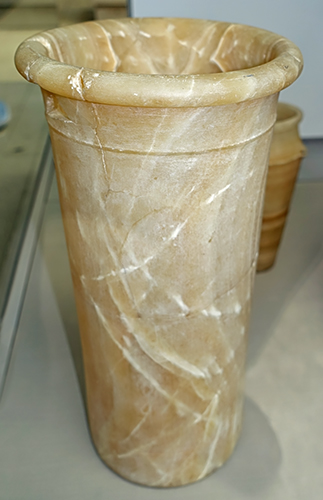
First Dynasty: 3 100 - 2 890 BC
Calcite Jar
Cylindrical jar of calcite with slightly concave sides and a rounded rim, below which there is a raised ridge of decoration. Interior completely hollowed. Restored from fragments.
Diameter 139 mm (base), 164 mm (rim), height 342 mm, weight 4250 gm.
Stone vessels became an important part of burial furnishing during the First Dynasty. The strength and durability of stone containers lent permanence to the provisions provided for the tomb owner's afterlife. Bowls and jars carved from easily worked travertine and greywacke were widely available. Exotic varieties were reserved for royalty and the high elite.
Catalog: First Dynasty, Akhmim, EA20934
Photo: Don Hitchcock 2018
Source: Original, British Museum
Text: Card at the British Museum, http://www.britishmuseum.org/, © Trustees of the British Museum, CC BY-NC-SA 4.0
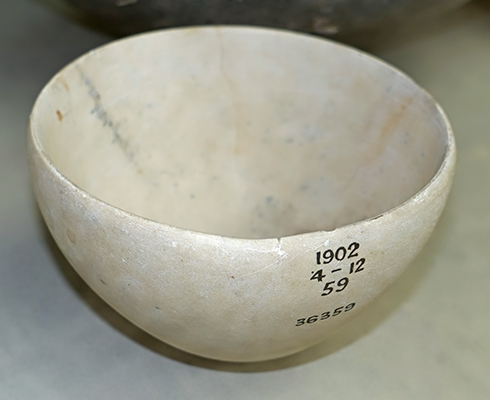
First Dynasty: 3 100 - 2 890 BC
Bowl
Bowl of white limestone with darker veining, with a flat base and convex sides. The rim is plain and the interior of the base is smoothly rounded.
Diameter 40 mm (base), 129 mm (rim), height 88 mm.
Catalog: First Dynasty, EA36359
Photo: Don Hitchcock 2018
Source: Original, British Museum
Text: Card at the British Museum, http://www.britishmuseum.org/, © Trustees of the British Museum, CC BY-NC-SA 4.0
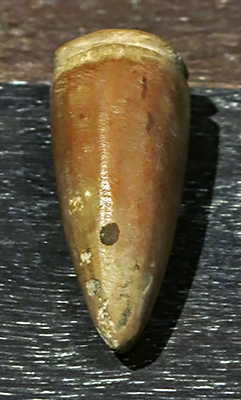
First Dynasty: 3 100 - 2 890 BC
Plumb bob
Weight for a plumb line, circa 3 000 BC.
Catalog: Limestone, ÄS 1623
Photo: Don Hitchcock 2015
Source: Original, Ägyptischen Museum München
Text: Museum card, © Ägyptischen Museum München
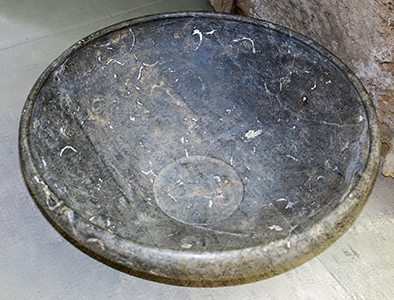
First Dynasty: 3 100 - 2 890 BC
Bowl
Large bowl of grey schist with a flat base and incurving rim. The base is countersunk on the interior. The side of the bowl bears two small areas which have been greatly scratched, no doubt deliberately, perhaps in order to remove an incised inscription. Restored from fragments.
( this bowl appears to me to be made, not of schist, but of fossiliferous limestone, with the characteristic curved cross sections of shells - Don )
Diameter 98 mm (base), 350 mm (rim), height 135 mm, weight 2990 gm.
Catalog: First Dynasty, EA35308
Photo: Don Hitchcock 2018
Source: Original, British Museum
Text: Card at the British Museum, http://www.britishmuseum.org/, © Trustees of the British Museum, CC BY-NC-SA 4.0
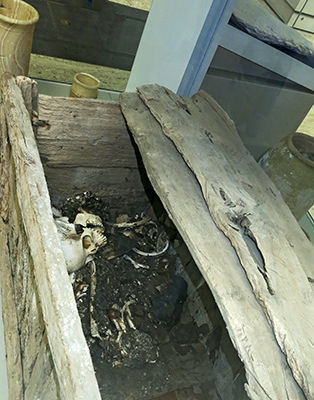
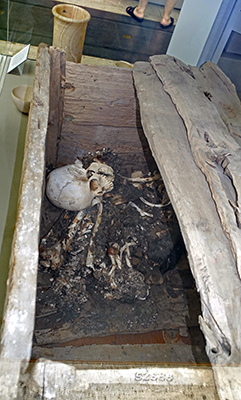
First Dynasty: 3 100 - 2 890 BC
Wooden coffin of a commoner
This coffin contains the skeleton of a young woman, originally in a tightly flexed position. Traces of linen are probably remnants of a shroud and not wrappings. In the First Dynasty, the practice of wrapping the body in linen strips was reserved for kings and the highest elite.
It is from Tarkhan, an Ancient Egyptian necropolis, located around 50 km south of Cairo on the west bank of the Nile.
Catalog: First Dynasty, Tarkhan 1955, EA52888
Photo: Don Hitchcock 2015, 2018
Source: Original, British Museum
Text: Card at the British Museum, http://www.britishmuseum.org/, © Trustees of the British Museum, CC BY-NC-SA 4.0
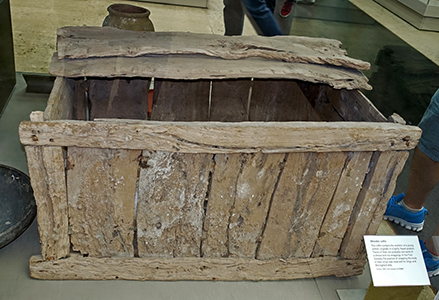
First Dynasty: 3 100 - 2 890 BC
Wooden coffin of a commoner
Skull - Some of the lower front teeth show evidence of attrition. The cranium in its dimensions appears to be within normal limits.
Thorax, abdomen, arms, and legs: - the body is reduced to a mass of disjointed bones, now held together by paraffin wax. Remains of charred linen bandages are visible.
A rectangular coffin for a contracted (flexed position) burial: made of rough planks fastened together by dowels. Some of the boards, particularly those of the lid, were not cut with parallel edges but were trimmed to fit irregular spaces. The coffin was constructed by making a frame of narrow bars of wood, forming the edges of the coffin and the corner posts, and then filling in the spaces with thin planks, set vertically along the sides and horizontally at the ends. The cover was made of rough planks laid lengthwise. Some parts of the lid are missing, but the surviving woodwork is in good condition.
Coffin dimensions: height: 485 mm (coffin without lid), length 912 mm, width 562 mm.
Catalog: First Dynasty, Tarkhan 1955, EA52888
Photo: Don Hitchcock 2018
Source: Original, British Museum
Text: Card at the British Museum, http://www.britishmuseum.org/, © Trustees of the British Museum, CC BY-NC-SA 4.0
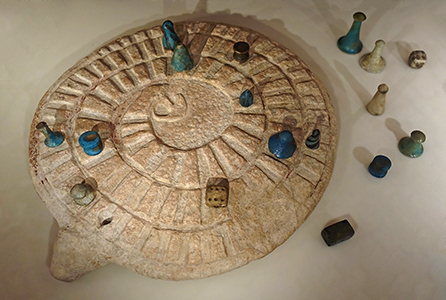
First Dynasty: 3 100 BC - 2 890 BC
Game of the Snake
The popular Egyptian board game known as the 'Game of the Snake', with game pieces and dice. The game was called Mehen, after a snake-god.
Circa 3 000 BC.
The rules for the game have never been discovered.
Catalog: Abydos, Limestone and Faience, ÄM 4845 (die), ÄM 10759, ÄM 10761, ÄM 10765, ÄM 12810, ÄM 13868
Photo: Don Hitchcock 2018
Source: Display, Staatliche Museen zu Berlin, Neues Museum, Germany
Text: © Card at the Staatliche Museen zu Berlin (CC BY-NC-SA 3.0 DE)
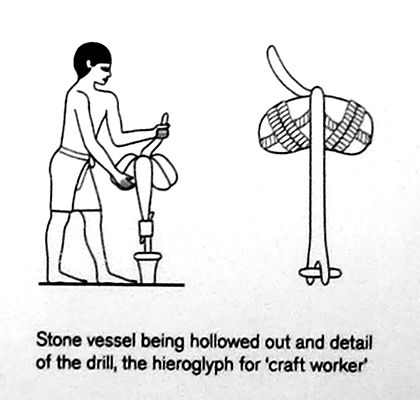
Naqada III - First Dynasty (onwards): 3 200 BC and later
Stone vessels manufacture
Armies of workers must have been needed to extract and transport the amount of stone used during the first two dynasties. Harder still was turning the stone block into a highly polished jar or bowl fit for a king. This job required special tools and training.
In recognition of this skill, the drill for stone vessels became the hieroglyph for the word 'craft worker'. This was composed of a stout wooden shaft, weighed down by stones held in nets. At the top was a crank for turning, at the bottom a fork for attaching specific drill bits for different tasks.
Photo: © Trustees of the British Museum, CC BY-NC-SA 4.0
Source: Card, British Museum
Text: Card at the British Museum, http://www.britishmuseum.org/, © Trustees of the British Museum, CC BY-NC-SA 4.0
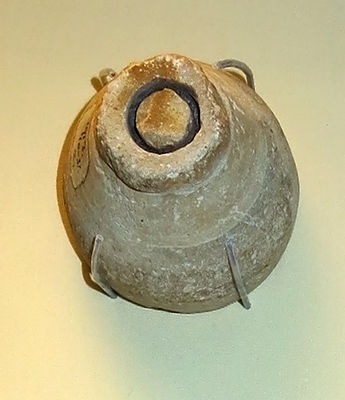
First Dynasty (?): 3 100 - 2 890 BC
Drilled Jar
Small pear-shaped limestone jar with flat base and narrow mouth, the drilling of the interior has only just begun.
In order to create a stone vessel, a stone block was first hammered and chiselled into a vessel shape. The interior was then bored out. For this a hollow copper tube was attached to the drill.
Using the crank to move the copper bit back and forth, a circular cutting was made in the centre with the aid of abrasive sand.
Height 56 mm, diameter 60 mm (max), 30 mm (min).
Catalog: First Dynasty (?), EA68940
Photo: Don Hitchcock 2015
Source: Original, British Museum
Text: Card at the British Museum, http://www.britishmuseum.org/, © Trustees of the British Museum, CC BY-NC-SA 4.0
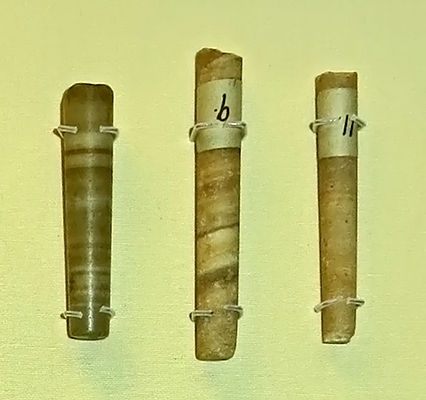
First Dynasty (?): 3 100 - 2 890 BC
Drill cores
EA37258: Calcite drill-core, tapering.
Height 53 mm, diameter 10 mm.
EA68943: Section of a calcite drill-core, tapering towards one end.
Height 66 mm, diameter 10 mm.<
EA68944: Section of a calcite drill-core, tapering towards one end.
Height 59 mm, diameter 9 mm.
Catalog: First Dynasty (?), EA37258, EA68943, EA68944
Photo: Don Hitchcock 2015
Source: Original, British Museum
Text: Card at the British Museum, http://www.britishmuseum.org/, © Trustees of the British Museum, CC BY-NC-SA 4.0
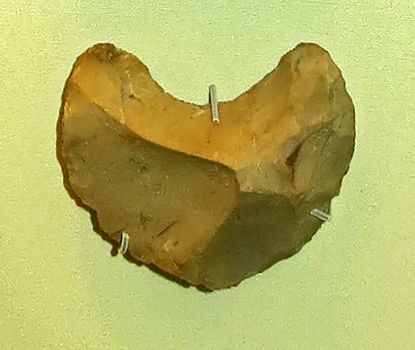
Predynastic (before 3 100 BC, probably Naqada III, 3 200 - 3 100 BC)
Flint scraper
Crescent-shaped chert tool, used for the boring out of stone vessels.
Length 55 mm, width 44 mm, thickness 22 mm.
( note that although this is labelled as Predynastic by the BM catalog, it was probably Late Predynastic, since the skills and the required organisation of labour in Northern Egypt to make stone jars were not fully developed until the Naqada Period, although there are even a few examples from the Badarian Period - Don )
Catalog: Predynastic, Abydos, EA37266
Photo: Don Hitchcock 2015
Source: Original, British Museum
Text: Card at the British Museum, http://www.britishmuseum.org/, © Trustees of the British Museum, CC BY-NC-SA 4.0
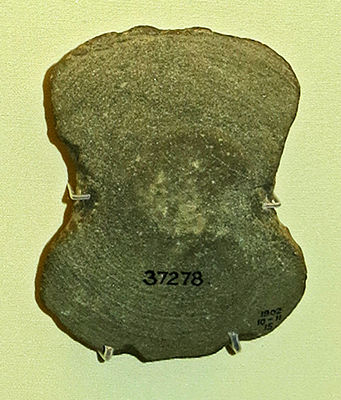
First Dynasty: 3 100 - 2 890 BC
Figure-of-eight drill bit
Figure-of-eight drill bits of quartzite were needed for drilling harder stone and hollowing out the inside of stone vessels. Drilling with these bits left tell-tale grooves on the vessel walls and on the drill itself. Inhaling the fine dust produced during this process must have shortened many lives.
Drill-bit of hard crystalline sandstone with concave depressions on the sides for attachment to the shaft of the drill. Bears concentric circular marks from use, on both top and bottom, showing that the bit was used both ways up.
Length 80 mm, thickness 24 mm.
Catalog: First Dynasty, Abydos, Temple of Osiris, EA37278
Photo: Don Hitchcock 2015
Source: Original, British Museum
Text: Card at the British Museum, http://www.britishmuseum.org/, © Trustees of the British Museum, CC BY-NC-SA 4.0
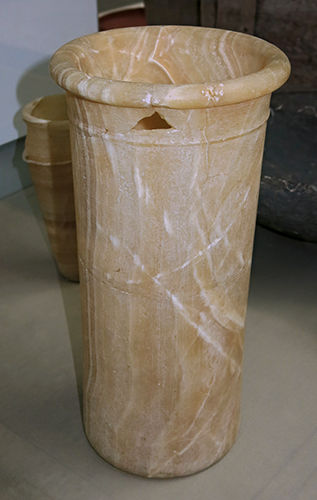
First Dynasty: 3 100 - 2 890 BC
First Dynasty stone vessels
Stone Jar
Stone vessels became an important part of burial furnishing during the First Dynasty The strength and durability of stone containers lent permanence to the provisions provided for the tomb owner's afterlife. Bowls and jars carved from easily worked travertine and greywacke were widely available. Exotic varieties were reserved for royalty and the high elite.
Cylinder jar of calcite (travertine) with slightly concave sides and a rounded rim, below which there is a raised ridge of decoration. Interior completely hollowed. Restored from fragments.
Height 342 mm, diameter 164 mm (rim), 139 mm (base), weight 4250 grams.
Catalog: First Dynasty, Akhmim, EA20934
Photo: Don Hitchcock 2015
Source: Original, British Museum
Text: Card at the British Museum, http://www.britishmuseum.org/, © Trustees of the British Museum, CC BY-NC-SA 4.0
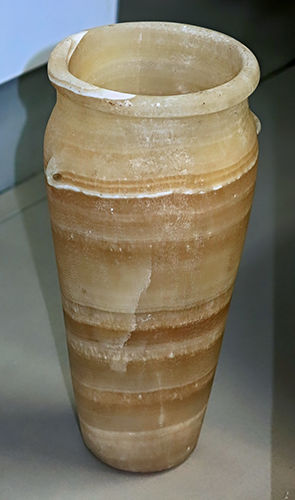
First Dynasty: 3 100 - 2 890 BC
Stone Jar
Tubular vase of calcite with thin lug-handles on the sides. The lip is rounded, below which the sides are concave down to the level of the handles, then they taper straight down to the flat base.
Height 210 mm, diameter 94 mm (rim), 55 mm (base).
Catalog: First Dynasty, EA32159
Photo: Don Hitchcock 2015
Source: Original, British Museum
Text: Card at the British Museum, http://www.britishmuseum.org/, © Trustees of the British Museum, CC BY-NC-SA 4.0
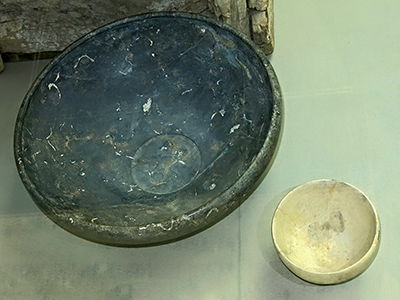
First Dynasty: 3 100 - 2 890 BC
Stone Jar
EA35308: Large bowl of grey schist with a flat base and incurving rim. The base is countersunk on the interior. The side of the bowl bears two small areas which have been greatly scratched, no doubt deliberately, perhaps in order to remove an incised inscription. Restored from fragments.
( note that the stone used for this bowl looks very much more like fossiliferous limestone than schist. See the white cross sections of what are likely to be brachiopods in a dark limestone matrix - Don )
Height 135 mm, diameter 350 mm (rim), 98 mm (base), weight 2990 grams.
EA36359: Bowl of white limestone with darker veining, with a flat base and convex sides. The rim is plain and the interior of the base is smoothly rounded.
Height 88 mm, diameter 129 mm (rim), 40 mm (base)
Height 210 mm, diameter 94 mm (rim), 55 mm (base).
Catalog: First Dynasty, EA35308, EA36359
Photo: Don Hitchcock 2015
Source: Original, British Museum
Text: Card at the British Museum, http://www.britishmuseum.org/, © Trustees of the British Museum, CC BY-NC-SA 4.0
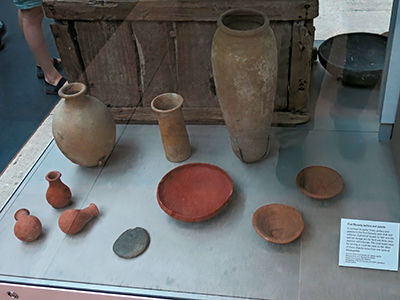
First Dynasty: 3 100 - 2 890 BC
Pottery and palette
In contrast to earlier times, pottery and palettes in the First Dynasty were drab and utilitarian.
Cylindrical vessels for fats and oils and tall storage jars for food and drink were common within burials.
The small bowls were for serving or could be used as lids. Most of these objects come from one tomb at Mostagedda.
Catalog:
Hu H101, B407, First Dynasty, EA30904, EA30879
Mahasna H121, First Dynasty, EA49050
Abydos, First Dynasty, EA49300-1
Mostagedda 1726, First Dynasty, EA56571, 56588-9,
62433, 62402
Photo: Don Hitchcock 2015
Source: Original, British Museum
Text: Card at the British Museum, http://www.britishmuseum.org/, © Trustees of the British Museum, CC BY-NC-SA 4.0
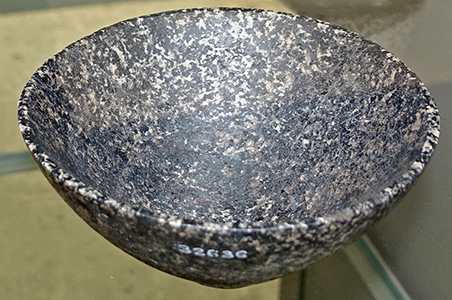
First Dynasty: 3 100 - 2 890 BC
Diorite/gabbro bowl
Open bowl of black diorite/gabbro, with convex sides turning slightly concave near the base and convex near the top. The interior of the base is rounded, not countersunk.
Diameter 35 mm (base), 133 mm (rim), height 63 mm.
Placed in the pegmatitic diorite class, several varieties of this attractive mottled stone are known, all coming from the Eastern desert. The remote location of the quarries probably made mining and transport to the Nile very difficult, so it fell out of favour in the early Old Kingdom. It was not used again until Roman times.
Catalog: EA32636
Photo: Don Hitchcock 2018
Text: Card at the British Museum, http://www.britishmuseum.org/, © Trustees of the British Museum, CC BY-NC-SA 4.0
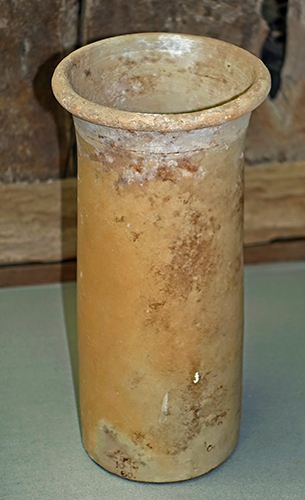
First Dynasty: 3 100 - 2 890 BC
Pottery Jar
Cylindrical jar of marl pottery, exterior coated with a smoothed slip, which varies in colour from cream to pale brown. The jar narrows slightly from the base to the neck and has an external rolled rim. The neck bears an incised line of decoration below the rim.
( note that the calcareous clay for marl pottery was not from the readily available clays of the nile banks, but had to be specially dug from further out in the desert or from the hills. Nile clay was principally used for household crockery and containers, as well as ceramics for ritual use. Marl clay was principally used for storage and prestige objects like figural vessels - Don )
Catalog: Late Predynastic (Naqada IIIB) to First Dynasty.
Cemetery H at Hu / Hiw First Dynasty, EA30904
Photo: Don Hitchcock 2018
Source: Original, British Museum
Text: Card at the British Museum, http://www.britishmuseum.org/, © Trustees of the British Museum, CC BY-NC-SA 4.0
Additional text: Wikipedia
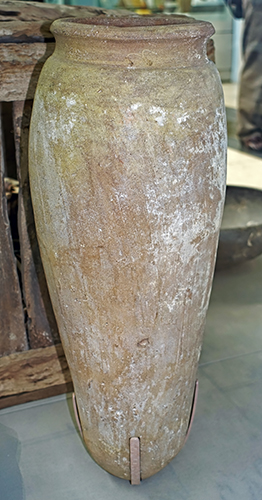
First Dynasty: 3 100 - 2 890 BC
Pottery Jar
Large marl pottery storage jar with rounded base, conical body becoming convex at the shoulder, with inset low neck and everted rim.
Diameter 180 mm, height 495 mm.
Catalog: Late Predynastic (Naqada IIIA) / Early First Dynasty Hu / Hiw, Abadiya, EA30879
Photo: Don Hitchcock 2018
Source: Original, British Museum
Text: Card at the British Museum, http://www.britishmuseum.org/, © Trustees of the British Museum, CC BY-NC-SA 4.0
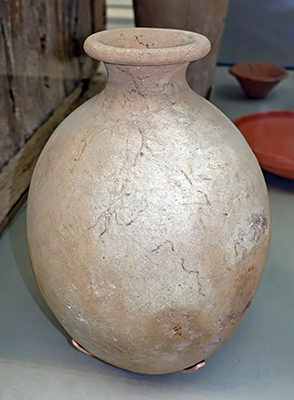
First Dynasty: 3 100 - 2 890 BC
Pottery Jar
Vase of pink marl pottery with a grey slip, rounded base, ovoid body and a narrow neck with an external roll-over rim.
Diameter 8.80 mm, height 293 mm.
Catalog: Late Predynastic (Naqada IIIA1) / Early First Dynasty, el-Mahasna, EA49050
Photo: Don Hitchcock 2018
Source: Original, British Museum
Text: Card at the British Museum, http://www.britishmuseum.org/, © Trustees of the British Museum, CC BY-NC-SA 4.0
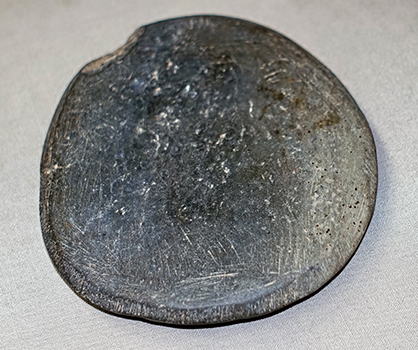
First Dynasty: 3 100 - 2 890 BC
Mudstone Palette
A mudstone palette of oval shape, with the edges roughly rounded. The surfaces are considerably scratched and the edge is slightly broken at one point.
Length 112 mm, width 97 mm.
Catalog: Early First Dynasty, Mostagedda, EA49050
Photo: Don Hitchcock 2018
Source: Original, British Museum
Text: Card at the British Museum, http://www.britishmuseum.org/, © Trustees of the British Museum, CC BY-NC-SA 4.0
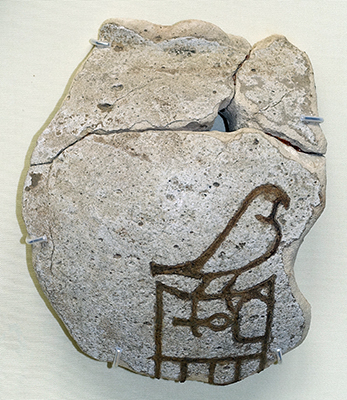
First Dynasty: 3 100 - 2 890 BC
Aha's faience jar fragment
Narmer's successor was Aha, the 'Fighter', written with a mace and shield. Peace and prosperity followed Narmer's unification of the country, allowing Aha to develop the political capital at Memphis, near modern
day Cairo. From here the two lands of Egypt were more efficiently administered, while the religious capital remained at Abydos.
The image shows part of the side of a large globular vase of glazed composition, consisting of three joined fragments. A small portion of the neck of the vessel is preserved at the top edge. On the exterior is the serekh of Aḥa, inlaid in a darker glaze than that of the rest of the surface. The present colour of the inscription is a dull brownish yellow, and the background glaze is white, but the original colours were probably dark brown or black for the inscription and green for the rest of the vase. The edges of the fragment are very worn and the surface is rather friable.
In order to keep the gods happy and ensure the state of 'maat' (roughly speaking, universal order), Egypt's ancient kings gave gifts to deities at their temples or shrines. On the walls of every temple are depictions of pharaohs before the gods offering wine, cloth, or small statues. The vase's find spot in a deposit of votive offerings indicates that its original purpose was as a gift to the temple at Abydos.
From the shape of the fragment we can tell that it was originally part of a large globular vase with a neck. Unfortunately no portion of its rim survived. At this early date virtually all objects made from glazed composition were small - such as beads, tiles, and statuettes - so that a glazed composition piece of this scale is unexpected and must have been rare. It is thus not surprising to find that the jar bears a king's name, making it a royal donation, probably to Khentiamentiu, the local deity.
Length 140 mm, width 114 mm.
Catalog: First Dynasty, Abydos, Osiris Temple, close to Chamber M69, EA38010
Photo: Don Hitchcock 2018
Source: Original, British Museum
Text: Card at the British Museum, http://www.britishmuseum.org/, © Trustees of the British Museum, CC BY-NC-SA 4.0
First Dynasty: 3 100 - 2 890 BC
Aha's ivory box fragment
Aha built a large tomb complex for himself and his wives at Abydos. The name of one wife, Bener-ib meaning
'sweet heart', appears beside that of the king on this ivory box fragment.
His tomb complex also included graves for retainers (all young men) and one for seven lions possibly kept as pets.
A fragment of hippopotamus ivory, probably part of a box, bearing an incised inscription on one side giving the serekh of Aḥa and the name Ima-ib or Bener-ib. There are two holes through the fragment for fixing, as well as two holes in the bottom edge and one in each side, probably for dowels. The surface of the ivory is slightly cracked and the top right-hand corner is chipped.
Length 66 mm, width 31 mm, thickness 7 mm.
Catalog: First Dynasty, Abydos, cemetery B, Tomb of Aha, EA35513
Photo: Don Hitchcock 2018
Source: Original, British Museum
Text: Card at the British Museum, http://www.britishmuseum.org/, © Trustees of the British Museum, CC BY-NC-SA 4.0
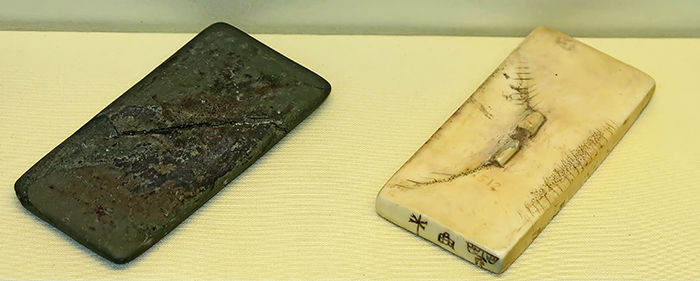
First Dynasty: 3 100 - 2 890 BC
Palette with ivory cover
This cosmetic palette set originally belonged to Aha's mother, Narmer's wife, Neith-hotep. Her name is etched on the cover's edge with her chief title as queen 'She who unites the two lords'.
Probably a royal gift, it was found with a female retainer buried within the tomb complex of King Djer, Neith-hotep's grandson.
EA35511: Rectangular mudstone palette: restored from two fragments, with a small amount lost from the edges of the break. One side is stained a dark violet colour from use. The surfaces have been carefully smoothed and the edges are rounded.
Length 89 mm, width 43 mm, thickness 8 mm.
This object bears an excavator's mark which was originally written as O .2 but altered to O .3. The same confusion applies to the ivory cover found with this palette, numbered 1901,1012.12. This type of well-finished rectangular palette is typical of the First Dynasty.
Catalog: Umm el-Qaab (Abydos), Tomb of Djer, tomb O .2 or O .3 subsidiary burial, EA35511
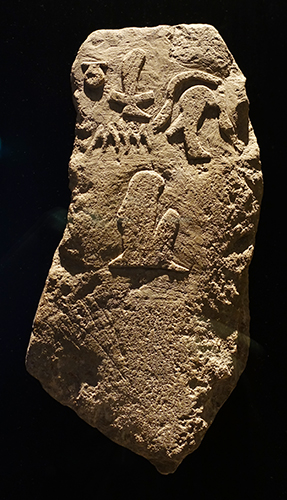
First Dynasty: 3 100 - 2 890 BC
Priestess Senut
Tomb stela of the priestess Senut, circa 2 900 BC.
Catalog: Limestone, Abydos (?), Royal Cemetery, Gl. 39
Photo: Don Hitchcock 2018
Source: Original, Ägyptischen Museum München
Text: © Ägyptischen Museum München
Rectangular cover for a mudstone palette, recessed on the underside. The top is very slightly convex and has a handle, now broken, in the approximate centre. On one end of the cover there is an incised inscription of Neitḥotep. Good condition.
Length 86 mm, width 40 mm, thickness 8 mm.
( note that I would have expected these dimensions to be reversed, that is that the cover would be longer and wider than the palette, particularly since the cover is recessed to accept the palette - Don )
Catalog: Umm el-Qaab (Abydos), Tomb of Djer, tomb O. 2 or O .3 subsidiary burial, EA35512
Photo: Don Hitchcock 2015
Source: Original, British Museum
Text: Card at the British Museum, http://www.britishmuseum.org/, © Trustees of the British Museum, CC BY-NC-SA 4.0
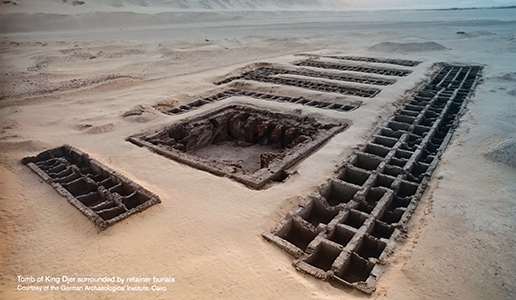
First Dynasty: 3 100 - 2 890 BC
Tomb of King Djer surrounded by retainer burials.
Photo: Courtesy of the German Archaeological Institute, Cairo, © Trustees of the British Museum, CC BY-NC-SA 4.0
Rephotography: Don Hitchcock 2018
Source: Poster, British Museum
Text: Card at the British Museum, http://www.britishmuseum.org/, © Trustees of the British Museum, CC BY-NC-SA 4.0
The King's retainers
First Dynasty: 3 100 - 2 890 BC
When a First Dynasty king died he took with him not only all the luxuries needed for a palace in the afterlife, but also the people to run it. Wives, officials, bodyguards and servants were interred around his tomb and funerary temple in long rows of connecting compartments, many sharing a common roof. This architecture, and the fact that most were adolescents or young adults, shows their deaths were not natural. Their sacrifice guaranteed the retainers their privileged positions in the afterlife, reaffirming the king's power for eternity.
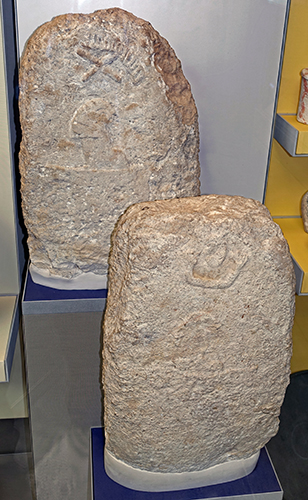
First Dynasty: 3 100 - 2 890 BC
Tombstones of retainers
Selected individuals were honoured with tombstones, or stelae, to mark their burial place. The stelae here were made for lai Neith and Sesher-ka, female members of the court of King Djer. More than 300 retainers surrounded Djer's tomb. Only 73 had tombstones, and 60 of these bear feminine names. This indicates the importance of women at court. Whether they were wives, priestesses or servants remains uncertain.
EA35612 (at back): Limestone stela, rough with a rounded top, chipped at the edges and extensively pitted by weathering. The stela bears an inscription in low relief giving a name which may be intended to read Iaineit, followed by a figure of a seated woman.
Height 355 mm, width 260 mm.
EA35613 (at front): Limestone stela, roughly-shaped stela of poor-quality limestone, rounded at the top and extensively pitted by weathering. The stela bears an inscription in low relief giving the name Sesherka below which is a figure of a seated woman.
Height 385 mm, width 250 mm.
Catalog: First Dynasty, Abydos, around Tomb of Djer, EA35612, EA35613
Photo: Don Hitchcock 2018
Source: Original, British Museum
Text: Card at the British Museum, http://www.britishmuseum.org/, © Trustees of the British Museum, CC BY-NC-SA 4.0
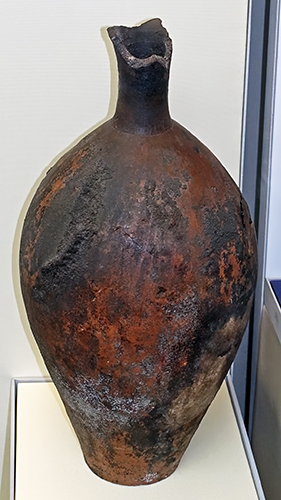
First Dynasty: 3 100 - 2 890 BC
Oil bottle
Geological examination of the bottle shows that it was made in the area of Mount Hermon in modern day southern Lebanon. Further analysis suggest that jars like it once contained vegetable oils, mixed with pine or cedar resin, to create a scented mixture that was highly valued by the Egyptian king and his court.
This is a vase of red pottery, originally polished on the exterior, but largely blackened by burning. The vase has a flat base, from which the sides expand to form a wide body, then converge again to a narrow neck. The rim is slightly broken. Within the vase are remains of the original contents. Cracked in places.
Dimensions: diameter 68 mm (base), 162 mm (max), height 320 mm.
Catalog: Umm el-Qaab (Abydos), Tomb of Djer, EA35548
Photo: Don Hitchcock 2018
Source: Original, British Museum
Text: Card at the British Museum, http://www.britishmuseum.org/, © Trustees of the British Museum, CC BY-NC-SA 4.0
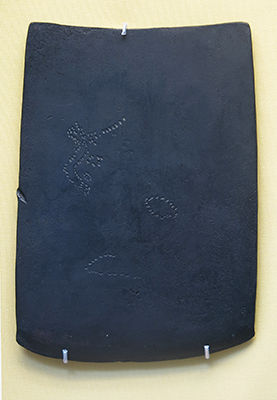
First Dynasty: 3 100 - 2 890 BC
Copper Axe
Axes of copper were status symbols in the First Dynasty. Several were found with retainers buried around the king's funerary temples, who may have served as special guards. On this axe an inscription includes a drawing of an elephant, probably giving the name of the owner, but the reading is uncertain.
Broad rectangular axe-head with concave butt and gently convex sides, which turn out slightly at the corners of the cutting edge. As one of the sides is more convex and shorter than the other, the cutting end, which is moderately convex, is a little lop-sided. The blade has been cleaned since its acquisition; previously it was thickly corroded on one face, where the surface is now pitted. The same face has a number of fine cracks, which are probably the result of the process of manufacture. Except for small surface imperfections and a gash on one side, the other face is in excellent condition.
Marks of the original hammering are plainly visible on the cutting edge, which is quite sharp and shows distinct signs of wear. The better-preserved face of the axe bears a motif or inscription in hieroglyphs, executed in a punched pointille technique, consisting of three separate elements.
Length 153 mm, width 108 mm, thickness 11 mm, weight 1243 grams.
Catalog: Abydos, First Dynasty, EA30065
Photo: Don Hitchcock 2015
Source: Original, British Museum
Text: Card at the British Museum, http://www.britishmuseum.org/, © Trustees of the British Museum, CC BY-NC-SA 4.0
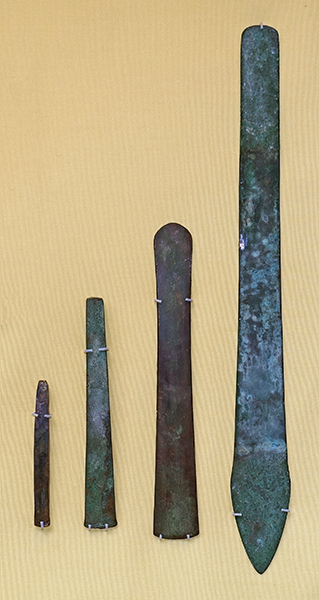
First Dynasty: 3 100 - 2 890 BC
Copper tools buried with a retainer of Djer
Skilled retainers accompanied the king in the afterlife to provide all the services required. One of Djer's retainers was probably a craftsman, since he was buried with a set of copper tools. These include two chisels and an adze, used in carpentry, and a long pointed tool possible for cutting leather. One chisel bears the owner's name, 'Hem', meaning 'servant'.
Catalog: Abydos, Tomb of Djer, retainer burial O 31, First Dynasty, EA67564 - EA67567
Photo: Don Hitchcock 2018
Source: Original, British Museum
Text: Card at the British Museum, http://www.britishmuseum.org/, © Trustees of the British Museum, CC BY-NC-SA 4.0
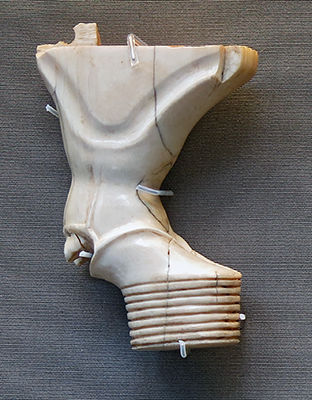
First Dynasty: 3 100 - 2 890 BC
Furniture leg from King Djer's tomb
Beds, stools and boxes with legs in the shape of bulls' feet were home furnishings for the king and the elite. The power of the bull conferred protection on the user. High quality carving marks this ivory leg as a product of the royal workshops. It was probably attached to a chest or coffer. Such fragments are all that remain of once rich funerary equipment in the royal tombs.
A hippopotamus ivory leg in the form of a bull's foot, standing on a cylindrical, grooved pedestal. The detail of the carving is very good, the veins being depicted and the surface carefully modelled. At the back of the upper surface are the remains of a small tenon, pierced by a single hole for attachment. The top of this tenon is broken but the remainder of the object is in a good state of preservation.
Height 76 mm, width 52 mm (top).
Catalog: Abydos, First Dynasty, Tomb of Djer, EA35530
Photo: Don Hitchcock 2015
Source: Original, British Museum
Text: Card at the British Museum, http://www.britishmuseum.org/, © Trustees of the British Museum, CC BY-NC-SA 4.0
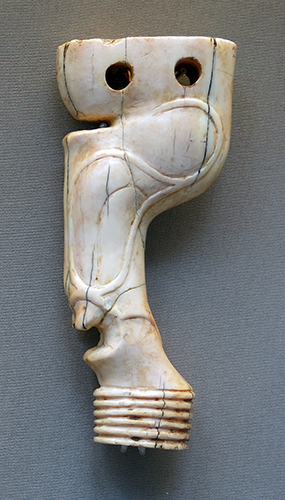
First Dynasty (?): 3 100 - 2 890 BC
Furniture leg
An ivory leg from a stool, carved in the form of a bull's foot.
Stools were the most common pieces of furniture used in ancient Egypt. This ivory leg was probably attached to the frame by means of a leather thong lashed through the holes. From its slender shape, it was most likely to have been the front leg of a low stool.
The top is marked with scratches where the ivory has been sawn and there is a hole in the middle of the top surface for attachment. Two more holes, each 7 mm in diameter, are pierced horizontally through the upper part of the leg, from one side to the other.
The surface of the piece has been carved with care, details of the veins being shown on one side, and it has been polished. At the base, the hoof rests on a low pedestal with decoration in the form of narrow horizontal grooves. There is a shallow depression cut into the underside of this pedestal.
Dimensions: height 115 mm, width 50 mm (top), depth 27 mm, weight 125 grams.
Catalog: EA29433
Photo: Don Hitchcock 2015
Source: Original, British Museum
Text: Card at the British Museum, http://www.britishmuseum.org/, © Trustees of the British Museum, CC BY-NC-SA 4.0
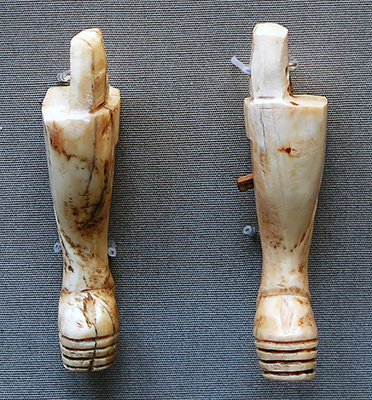
First Dynasty (?): 3 100 - 2 890 BC
Game board legs
(left) EA30466: A small ivory leg in the form of a bull's leg, possibly from a game-board, with a tenon projecting 14 mm from the top. This tenon is in the front left-hand corner of the upper surface, and is pierced by a single hole for fixing. In the left side of the leg is a small hole for a dowel. This leg belonged to the same object as 1899,0314.17, but was intended to be fixed on the opposite side, so that the positions of the tenon and dowel are reversed.
Dimensions: height 65 mm, width 29 mm, depth 14 mm, weight 18 grams.
(right) EA30465: A small ivory leg in the form of a bull's foot, possibly from a game-board. At the top of the leg is a tenon, 13 mm high, pierced horizontally by two small holes for fixing. This tenon is situated in the front right-hand corner of the upper surface, and is marked with saw cuts at its base. Small traces of wood adhere to the tenon. The leg is well carved but not completely polished, and the marks made by the tools are still evident. In the right side there is a small wooden dowel, projecting from a hole in the ivory.
Dimensions: height 64 mm, width 27 mm, depth 16 mm, weight 19 grams
Catalog: EA30466, EA30465
Photo: Don Hitchcock 2015
Source: Original, British Museum
Text: Card at the British Museum, http://www.britishmuseum.org/, © Trustees of the British Museum, CC BY-NC-SA 4.0
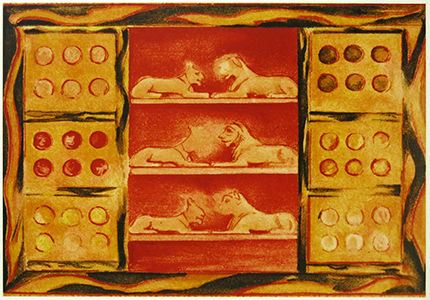
First Dynasty: 3 100 - 2 890 BC
Board for the snake game.
Above left, the board for the snake game, and some of the pieces used.
The painting at left is of the playing pieces for the snake game depicted in the tomb of Hesy-ra, Saqqara, Third Dynasty.
Games were popular with the king and his court. This limestone board, carved in the shape of a coiled serpent, was for playing mehen, the snake game.
Two teams, with up to six players, raced marbles around the snake from tail to head and back again. From the tomb painting shown at the left, we know the game also involved ivory figurines of lions.
Above right, these are probably some of the lion shaped pieces used in the game.
Many were found with retainers buried near the king, and might mark their owners as favoured gaming partners.
Playing mehen was not merely entertainment: victory at the game symbolised success in the afterlife.
Catalog: Possibly Abydos, Early Dynastic, EA66216
First Dynasty, EA65834, EA65835, EA66851, EA66852, EA30798, EA64093
Abydos, Merneith Enclosure, retainer burial S548, First Dynasty, EA52920
Abydos, Tomb of Djer, retainer burial O 29, First Dynasty, EA35529
Photo: Don Hitchcock 2015
Source: Original, British Museum
Text: Card at the British Museum, http://www.britishmuseum.org/, © Trustees of the British Museum, CC BY-NC-SA 4.0
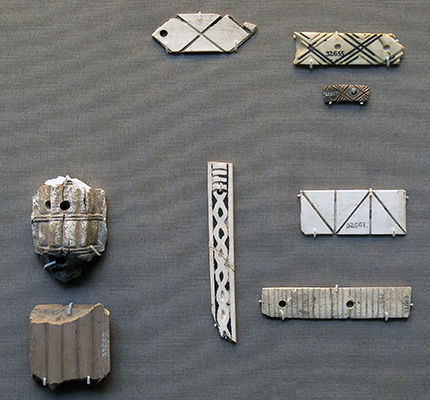
First Dynasty: 3 100 - 2 890 BC
Furniture inlays from the royal tombs.
Inlays of ivory were originally attached to wooden chests or other objects of furniture with resin or small gold or copper nails. Incised geometric patterns, filled with black paste, imitate basketry.
Pieces shaped like bundled reeds adorned the edges of boxes or stools.
EA32652: A piece of ivory inlay decorated on the face with vertical ribbing, broken off at the base. The back is cut into a dovetail tenon for secure fixing. One edge is rebated so that the decorated face extends beyond the rear of the tile, and the opposite edge is cut in the reverse manner, with the carved face inset, probably to allow a series of such pieces to be fitted together with overlapped joints. Length 45 mm, width 42 mm, thickness 10 mm.
First Dynasty, Tomb of Den.
EA32654: A small piece of ivory inlay: decorated with deeply incised grooves running diagonally across the face to form a diamond pattern. Traces of dark pigment remain in the grooves. At one end there is a circular hole, bored through the strip. The reverse side is flat and smooth. Good condition, broken off at each end. Length 57 mm, width 20 mm, diameter of hole 3 mm.
First Dynasty, Tomb of Den
EA32655: Rectangular fragment of ivory inlay, broken at each end, decorated with a pattern of incised diagonal lines. The pattern forms a series of diamond-shaped lozenges along the length of the piece, each bounded by three parallel lines and having a circular depression in the centre. Many of the grooves are filled with dark pigment. Length 59 mm, width 17 mm.
First Dynasty, Tomb of Den
EA32657: Rectangular piece of ivory inlay, unbroken, decorated with incised lines in a diamond pattern. The piece is slightly curved and is pierced by a single hole, in the middle of the width. The edges and back are flat and smooth. Good condition. Length 24 mm, width 9 mm, diameter of hole 2 mm.
First Dynasty, Tomb of Den
EA32661: Rectangular fragment of ivory inlay decorated with deeply incised lines running vertically and diagonally across the face. One end is broken away but the other end is preserved and is bevelled for inlaying. The grooves on the face still contain a small amount of dark pigment.
First Dynasty, Tomb of Anedjib, length 56 mm, width 23 mm.
EA32663: Rectangular strip of ivory inlay, broken off at one end, decorated with vertical incised lines. The strip is pierced by two holes, 3 mm in diameter, at an interval of 35 mm. The reverse side is flat and smooth. Length 80 mm, width 16 mm.
First Dynasty, Tomb of Anedjib
Note that some of these numbers do not appear in the catalog:
Catalog: Abydos, Tomb of Den, First Dynasty, EA32552, EA32654, EA32655, EA32657
Abydos, Tomb of Anedjh, First Dynasty, EA32561, EA32562, EA32563
Abydos, Tomb of Queen Merneith, First Dynasty, EA32549
Photo: Don Hitchcock 2015
Source: Original, British Museum
Text: Card at the British Museum, http://www.britishmuseum.org/, © Trustees of the British Museum, CC BY-NC-SA 4.0
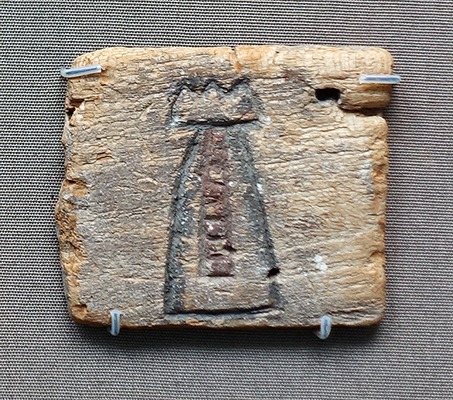
First Dynasty: 3 100 - 2 890 BC
Label for gaming pieces.
Gaming pieces in the shape of towers provide important information about architecture at this time. This ebony label was probably attached to a box containing such tower shaped playing pieces, possibly for use in the board game, Senet.
Rectangular ebony label, pierced in the top right-hand corner. The front surface is incised with a design showing a tower with a crenellated top, almost certainly a representation of a game-piece, with faint traces of black paint in the outlines and red paint in the carving of the internal details. The top right-hand corner of the label has been broken and repaired.
Length 41 mm, width 48 mm.
Catalog: First Dynasty, Abydos, Tomb of Djer, EA35525
Photo: Don Hitchcock 2018
Source: Original, British Museum
Text: Card at the British Museum, http://www.britishmuseum.org/, © Trustees of the British Museum, CC BY-NC-SA 4.0
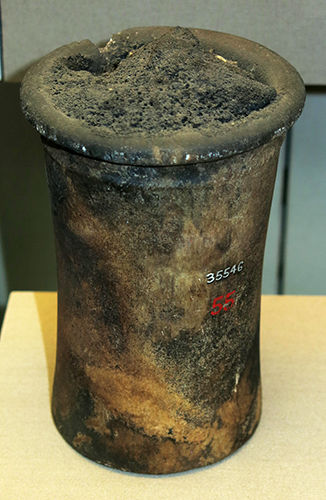
First Dynasty: 3 100 - 2 890 BC
Cylinder
Almost all of the furnishings from the royal tombs were broken and burnt by robbers. This cylindrical jar is one of the few stone vessels to survive in one piece. Although burnt, the contents are still intact. It was found beneath a stairway in the tomb of Djer. Nearby, the wrapped arm with bracelets, illustrated elsewhere, was also discovered.
Cylinder, calcite jar, with concave sides and a rounded rim, below which there is a band of cord decoration. The entire jar has been blackened by fire and it is filled to the top with the charred remains of the original contents.
Height 140 mm, diameter 84 mm (base), 93 mm (rim)
Catalog: Abydos, Tomb of Djer, First Dynasty, EA35546
Photo: Don Hitchcock 2015
Source: Original, British Museum
Text: Card at the British Museum, http://www.britishmuseum.org/, © Trustees of the British Museum, CC BY-NC-SA 4.0
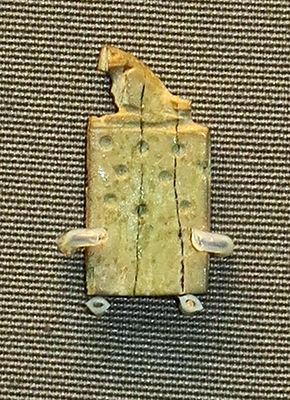
First Dynasty: 3 100 - 2 890 BC
Ivory bead from a bracelet
Shaped like a falcon-topped serekh, the box for the king's name, this bead came from the tomb of King Djer. In the same tomb, a bracelet with identical beads made of turquoise and gold was found still in place on a linen wrapped arm, shown below. Whether it was the arm of the king or one of his queens is uncertain.
An ivory or bone bead in the form of a serekh, with the Horus falcon on the top, probably intended for use in a bracelet. The panels of the façade and the dots above are carved in sunken relief. The bead is pierced horizontally by two holes. The ivory is well preserved, although the object has been restored from three fragments, and the face of the hawk is missing.
A serekh was normally used as a royal crest, accentuating and honouring the name of the pharaoh. Its use can be dated back as early as the Gerzeh culture, circa 3 400 BC. The hieroglyphs forming the king's name were placed inside a rectangular extension atop the serekh, which represented the royal courtyard. Additionally, the falcon of the god Horus, or in a few cases the Set animal, topped the serekh, showing the celestial patron of the named king.
Height 16 mm, width 8 mm.
Catalog: Abydos, Tomb of Djer, First Dynasty, EA35528
Photo: Don Hitchcock 2015
Source: Original, British Museum
Text: Card at the British Museum, http://www.britishmuseum.org/, © Trustees of the British Museum, CC BY-NC-SA 4.0
Additional text: Wikipedia
(left) First Dynasty: 3 100 - 2 890 BC
Axe blade
(right) Second Dynasty: 2 890 BC - 2 670 BC
Axe blade
Advances in metal technology were largely responsible for the intensive production of fine objects during the first two dynasties. Few copper tools survive from the Predynastic period, but later large quantities were buried with early kings and courtiers. Continual attempts to improve quality included the addition of arsenic to copper, making the metal harder and easier to cast. Bronze (copper with tin) was produced in the Second Dynasty, but it did not become commonplace until the Middle Kingdom, i.e. the Eleventh, Twelfth, and Thirteenth Dynasties.
Early metal axes copied the form of flint ones, but gradually became broader and rounder. Lighter, metal axe heads could now be put on longer handles, but had to be securely attached. The solution was to cast them with a hole for tying on. This was an innovation of the late Second Dynasty.
(left) Heavy copper square axe-blade with a convex cutting edge and slightly concave butt. The sides are nearly straight, being only slightly curved outwards, and the corners of the edge are rounded. The edge has been worked from both faces of the blade, and is rather chipped, possibly as a result of use. One corner of the butt has been bent and gashed. The surface of the metal is well preserved, only one side of the blade being pitted by corrosion.
Length 138 mm (at butt), width 136 mm, thickness 9 mm, weight 936 gm.
This axe is known to have come from Petrie's excavations in the early Osiris temple, but was for some reason omitted from his report.
(right) Rounded arsenical copper axe-blade with a single perforation. The butt is slightly concave but also rather irregular, as is the shape of the perforation. The cutting edge has been prepared by hammering from both faces of the blade, one of which has been pitted by corrosion. One section of the cutting edge retains traces of the original grinding.
Height 148 mm, width 148 mm, depth 4 mm, weight 585 gm.
Catalog: (left) Copper, First Dynasty, Temple of Osiris (Abydos) EA67583
Catalog: (right) Arsenical copper, Second Dynasty, Early Dynastic royal tombs at Abydos, EA30076
Photo: Don Hitchcock 2018
Source: Original, British Museum
Text: Card at the British Museum, http://www.britishmuseum.org/, © Trustees of the British Museum, CC BY-NC-SA 4.0
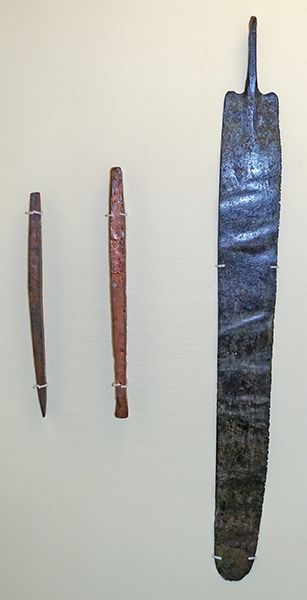
Left and middle:
First Dynasty: 3 100 - 2 890 BC
Chisel
Right:
Second Dynasty: 2 890 BC - 2 670 BC
Knife
Left: A copper chisel of approximately square section, slightly bent in the middle. The cutting edge is convex and has been hammered and ground from both sides.
Length 141 mm, width 6 mm, thickness 7 mm, weight 44.2 gm.
Middle: A copper chisel of rectangular section, slightly pitted by corrosion although the metal surfaces have now been cleaned. The cutting edge has been hammered from both sides of the tool, but has never been finally sharpened by grinding.
Length 150 mm, width 10 mm, thickness 9 mm, weight 89 gm.
Perhaps the reason why this chisel was not sharpened is that it was made specifically for grave goods and therefore did not need to be functional.
Chisels came in a variety of sizes to suit different tasks. The tip was hammered to shape and then sharpened by grinding. They were fitted with a wooden handle to prevent damage to wooden mallets when etching wood, ivory or stone. Some became bent, like the one on the left.
Right: A well preserved serrated edged knife of copper, tapering to a rounded tip. The tang at the butt is of square section, measuring 43 mm in length. The teeth have all been cut out from the same side of the blade; consequently they are not 'set' as in a modern saw, and they are extensively worn. A thin layer of corrosion covers parts of the blade. Close to the butt on one side is an incised inscription of three hieroglyphs, partly hidden by the corrosion products.
Length 355 mm, width 37 mm, thickness 0.5mm, weight 76.4 gm.
The form of this knife is undoubtedly Early Dynastic, particularly the style of the butt, which curves back on each side of the tang.
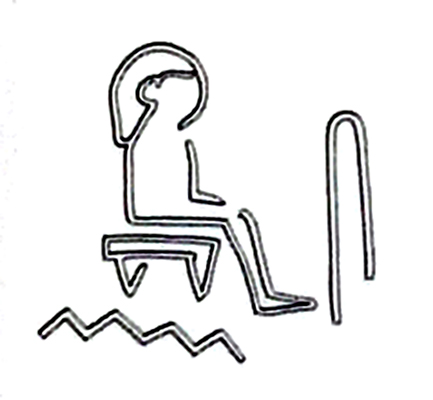
Saws like this were used in carpentry, but could also be used to cut soft limestone. A percentage of tin in the fabric of this saw made its cutting edge harder and therefore sharper.
Etched near the tang for the handle are three hieroglyphs, as shown at left. The inscription probably contains a personal name, which may be read Ny-špss or perhaps simply Snỉ, with the seated figure as a determinative.
These probably spell out the owner's name.
Catalog left: Early Dynastic, Temple of Osiris (Abydos), EA67585
Catalog middle: First Dynasty, Saqqara (Memphis), EA68152
Catalog right: 2nd Dynasty, Thebes, EA66064
Photo: Don Hitchcock 2018
Source: Original, British Museum
Text: Card at the British Museum, http://www.britishmuseum.org/, © Trustees of the British Museum, CC BY-NC-SA 4.0
Rephotography of the hieroglyphs: Don Hitchcock, but the image is © Trustees of the British Museum, CC BY-NC-SA 4.0
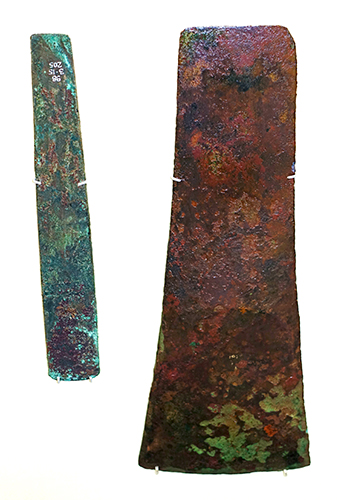
First Dynasty: 3 100 - 2 890 BC
Adzes
Left: A strong copper adze blade with a flat butt and straight sides. The width is greatest at the cutting edge, from which it decreases steadily to the butt. The edge is slightly convex and has been hammered and ground from only one face of the blade. Small traces of linen adhere to the corroded surface of the tool.
Length 181 mm, width 25 mm, thickness 5 mm, weight 137 gm.
This object may have come from the Early Dynastic royal tombs at Abydos.
Right: A large copper adze blade with slightly concave sides expanding from the top to the edge. The front of the blade has a curved ridge for added strength, just below the middle. The butt is square, with one corner bent over, and the cutting edge is slightly convex. The surfaces of the metal are partially covered by stable corrosion products.
Length 250 mm, width 95 mm, thickness 7 mm, weight 439.4 gm
The form of this blade, with the strengthening ridge, is paralleled by a number of adzes of First Dynasty date.
Adzes were important tools for dressing wood and stone. The smaller form was used in the Late Predynastic period, while the larger splayed shape developed in the First Dynasty. A curved ridge down the front of the latter gave it added strength.
Catalog (left): Copper, 1st Dynasty, Abydos, EA30079
Catalog (right): Copper, 1st Dynasty, EA59223
Photo: Don Hitchcock 2018
Source: Original, British Museum
Text: Card at the British Museum, http://www.britishmuseum.org/, © Trustees of the British Museum, CC BY-NC-SA 4.0
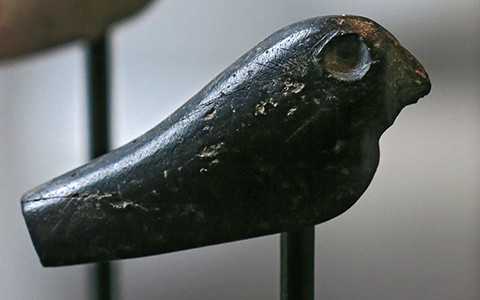
First Dynasty: 3 100 - 2 890 BC
Falcon figures as staff heads
Circa 3 100 - 3 000 BC.
Catalog: Alabaster, Serpentinite, ÄS 7174, ÄS 7175, ÄS 7184
Photo: Don Hitchcock 2015
Source: Original, Ägyptischen Museum München
Text: © Ägyptischen Museum München
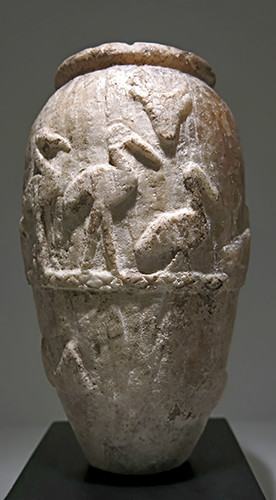
First Dynasty: 3 100 - 2 890 BC
Vessel with a frieze of birds, as well as depictions of bulls' heads and ships, symbolising the whole of the world.
Circa 3 000 BC.
Catalog: Alabaster, ÄS 7162
Photo: Don Hitchcock 2015
Source: Original, Ägyptischen Museum München
Text: © Ägyptischen Museum München
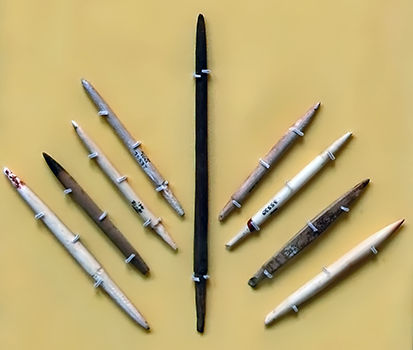
First Dynasty: 3 100 - 2 890 BC
Ivory and ebony arrowheads
As supreme hunter and warrior, the king maintained cosmic order. Befitting this role his arrows were made of precious ivory and exotic ebony. Fitted into reed shafts, these aerodynamic arrows did not need feathers to stabilise them. Red ochre applied to the tips of some may represent poison or the blood of the victim, magically guaranteeing victory.
Catalog:
Abydos, Tomb of Djer, First Dynasty, EA35535 - EA35542
Photo: Don Hitchcock 2015
Source: Original, British Museum
Text: Card at the British Museum, http://www.britishmuseum.org/, © Trustees of the British Museum, CC BY-NC-SA 4.0
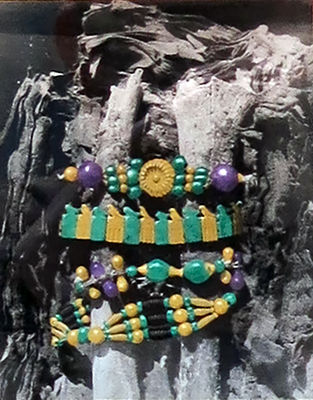
First Dynasty: 3 100 - 2 890 BC
Arm with jewellery
Colourised black and white photograph of an arm from Djer's tomb, courtesy of the Egypt Exploration Society, London, from a poster at the British Museum, © Trustees of the British Museum, CC BY-NC-SA 4.0.
There is an intriguing story to this photograph, which is all that now remains of the arm wrapped in linen, although the beads are preserved in the Cairo Museum.
The following is an extract from Cowie and Johnson (2001):
One early idea to preserve and mummify the body of the deceased was to wrap the body in cloth to protect it from the atmosphere and to coat the cloth with resin, which had two functions: as it dried it stiffened around the body, preserving its shape, and it also became airtight, like a shell.
One of the earliest attempts at mummification discovered to date was a First Dynasty King, discovered by Flinders Petrie at Abydos, some 150 km north of Thebes. Abydos was a sacred city, especially dedicated to the cult of Osiris. Petrie, with an assistant Mace, re-excavated the poorly performed first excavation of the site, at the tomb of King Zer (Djer), beginning in 1899.
Four workmen found a wrapped arm inside a small hole in the wall of the tomb, upon which they could see a gold bead, and it was brought to Mace and Petrie. When it was unwrapped, they found four bracelets of gold and faience.
Petrie records that when the arm, the oldest mummified piece known, and its marvellously fine tissue of linen, were delivered to what is now the Cairo Museum, the assistant curator, Brugsch, a German born Egyptologist, only cared for display, so from one bracelet he cut away the half that was of plaited gold wire, and threw away the arm and the linen.
Petrie commented 'A museum is a dangerous place.'

The bracelets as they appear now, in the Cairo Museum.
Photo: http://www.touregypt.net/museum/braceletpage2.htm
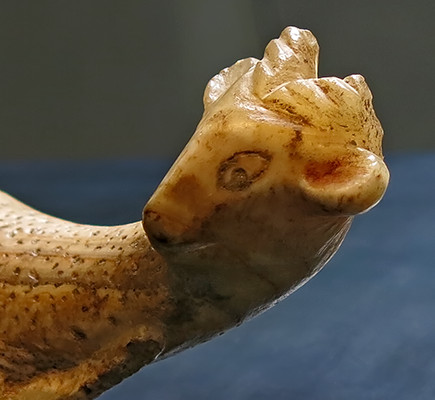
First Dynasty: 3 100 - 2 890 BC
Handle of a vessel in the shape of a reclining gazelle
Circa 2 950 BC.
Catalog: Alabaster, Eastern Delta, ÄS 4200
Photo: Don Hitchcock 2015
Source: Original, Ägyptischen Museum München
Text: © Ägyptischen Museum München, Wikipedia
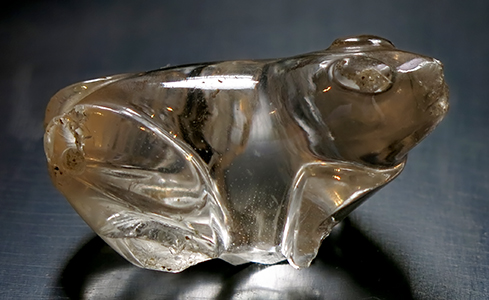
First Dynasty: 3 100 - 2 890 BC
Frog in Rock Crystal
Circa 2 950 BC.
Catalog: Rock Crystal, ÄS 5567
Photo: Don Hitchcock 2015
Source: Original, Ägyptischen Museum München
Text: © Ägyptischen Museum München
First Dynasty: 3 100 - 2 890 BC
Small pot in the form of a frog.
Circa 2 950 BC.
Catalog: Either alabaster or feldspar, ÄS 1588 or ÄS 1588
Photo: Don Hitchcock 2015
Source: Original, Ägyptischen Museum München
Text: © Ägyptischen Museum München
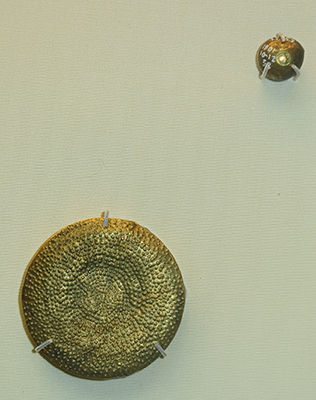
First Dynasty: 3 100 - 2 890 BC
Gold button and gold jar lid
The king had the monopoly on gold for his personal use and as gifts and payment. Gold was generally hammered into shape from sheets, as shown by this jar lid. The decoration was then punched into the soft metal. Once plentiful in the royal tombs, little gold survived the plundering. The small rounded knob of thin gold may have been used to decorate clothing or a shroud.
EA35553: A small rounded knob of thin gold, with a tubular stem of the same material projecting 2 mm from the back. This stem is pierced on each side to allow for attachment. Length 9 mm, diameter 12 mm.
EA32152b: Gold lid, diameter 45 mm. This lid of sheet gold, decorated with punch marks, was acquired with the limestone vessel below. However it is not known whether the lid and vase originally belonged together, especially as the lid is a poor fit.
Catalog: Gold button, Abydos, Tomb of Den, First Dynasty, EA35553
Gold lid, First - Second Dynasty, EA32152b
Photo: Don Hitchcock 2015
Source: Original, British Museum
Text: Card at the British Museum, http://www.britishmuseum.org/, © Trustees of the British Museum, CC BY-NC-SA 4.0
First - Second Dynasty: 3 100 - 2 670 BC
Stone Jars decorated with gold
Gold was applied to the rims and handles to heighten the beauty of stone vessels from Predynastic times into the Second Dynasty. Such jars were probably common in the royal tombs. The handles of the squat jars shown here have sheets of gold with cut out designs. Gilded copper wire, in the handle of one vase, was used to hang or carry it.
(left, back): Barrel-shaped vase of grey and white striped limestone, with a flat base and two small tubular handles. The angular rim has been plated with gold, one strip of the metal being folded over the lip and another wrapped around the neck. A lid of sheet gold, decorated with punch marks, shown above, was acquired with the vessel, but it is not known whether the lid and vase originally belonged together, especially as the lid is a poor fit.
Height 103 mm, diameter 59 mm (max), diameter 45 mm (max, lid), diameter 38 mm (rim), diameter 30 mm (base).
Catalog: EA32152a (or EA32152)
(second from right): Spheroidal vase of variegated limestone with pink, white and black veining. The rim is flat-topped with a sharp outer edge and the interior is fairly well hollowed. On the shoulder of the vase are two tubular handles, both covered by rectangular gold plates with an openwork cross cut in the middle. The handles still contain loops of copper wire, covered with gold foil. The base was drilled right through for ease of hollowing, and would have been plugged by a separate piece of stone, now missing.
Dimensions: diameter 26 mm (base), 46 mm (rim), height 45 mm.
The gold detail, and the colour and size of the vessel, suggest that it may well be identical with the vase described in the 'Macgregor Sale Catalogue' (1922), 145, no. 1094, second example. If this identification is correct then the provenance of the vase is known to be Abydos.
Catalog: Abydos, EA64653
(left, front): Well proportioned barrel shaped vessel in what appears to be red veined limestone, a smaller but similar version of EA32152a. It has gold sheet on its rim and two small tubular handles.
I can find no description of this online or on the museum card.
Catalog: EA20270 (?)
(right, back): See below.
Photo: Don Hitchcock 2015, 2018
Source: Original, British Museum
Text: Card at the British Museum, http://www.britishmuseum.org/, © Trustees of the British Museum, CC BY-NC-SA 4.0
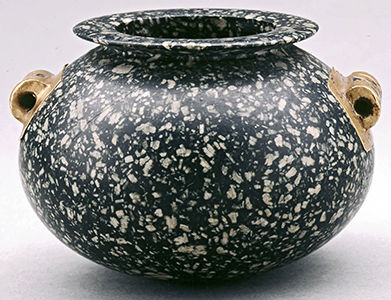 Spheroidal vase of black and white andesite porphyry, with a rounded base and two tubular handles. The rim is thin, flat-topped and sharp on the outer edge. Both handles are covered with rectangular plates of thin gold, cut out into an openwork cross. The interior is well-hollowed.
Spheroidal vase of black and white andesite porphyry, with a rounded base and two tubular handles. The rim is thin, flat-topped and sharp on the outer edge. Both handles are covered with rectangular plates of thin gold, cut out into an openwork cross. The interior is well-hollowed.
Height 59 mm, diameter 60 mm (rim), diameter 86 mm (max).
Catalog: First - Second Dynasty, EA56843
Photo: © Trustees of the British Museum, CC BY-NC-SA 4.0
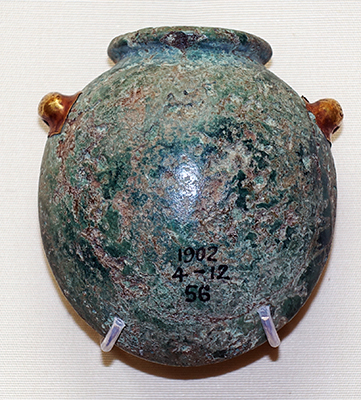
First Dynasty: 3 100 - 2 890 BC
Malachite jar with gold handles
This jar was precious not only because of the gold on its handles, but also because of the material it is made of: malachite. Only one other example is known. It came from the tomb of Djer, making it likely that this example also comes from a royal tomb.
Vase of green malachite with a rounded, lenticular body and two small handles, both pierced vertically and covered with a rectangular plate of gold. The narrow mouth is surrounded by a rounded rim. The interior is moderately well hollowed. Rim chipped in places.
Height 56 mm, width 50 mm, thickness 36 mm, diameter 28 mm (rim)
Catalog: Probably Abydos, First Dynasty, EA36356
Photo: Don Hitchcock 2018
Source: Original, British Museum
Text: Card at the British Museum, http://www.britishmuseum.org/, © Trustees of the British Museum, CC BY-NC-SA 4.0
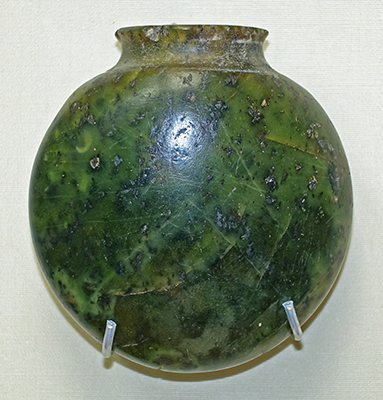
First Dynasty: 3 100 - 2 890 BC
Amazonite jar
Deep green ammonite was one of the ancient Egyptians' six most precious stones, on a par with turquoise and lapis lazuli. Enhancing its value, this jar originally had a gilded rim. The roughened area on the neck shows where a gold covering was once present.
Vase of green feldspar with a rounded, flattened body and a narrow neck. The rim was originally covered with gold, a band of unpolished stone shows the original position of the metal. Interior only partially hollowed, showing clear drill-marks.
Height 73 mm, width 70 mm, diameter 32 mm (rim)
Catalog: Abydos, Early First Dynasty, EA4711
Photo: Don Hitchcock 2018
Source: Original, British Museum
Text: Card at the British Museum, http://www.britishmuseum.org/, © Trustees of the British Museum, CC BY-NC-SA 4.0
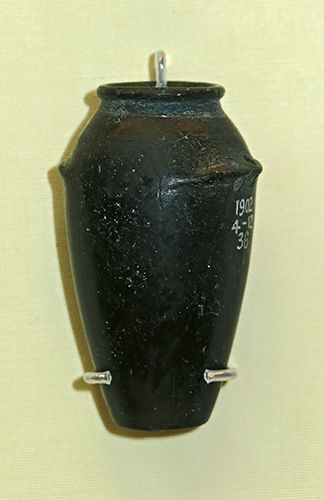
First Dynasty: 3 100 - 2 890 BC
Miniature basalt jar
An unpolished area just below the rim of this jar shows where gold leaf was once applied. Originally, gold also adorned the handles and was fastened to them with fine wire laced through small holes. Such a tiny jar may have had a ritual function or held valuable oil.
( The roughness was only partly because it was going to be covered by gold, would not therefore be seen, and a little time was saved by not polishing it. A more important reason was that the roughness allowed the resin or glue used under the gold sheet to have good adhesion to the article - Don )
Miniature basalt vase with a small flat base and rounded rim, with wavy ledge-handles on sides, each pierced vertically by two holes. The area just below the rim exhibits a band of unpolished stone where a strip of gold-plating has been removed.
Height 56 mm, width 33 mm, depth 29 mm.
Catalog: Abydos, Royal Tomb (?), Early First Dynasty, EA36336
Photo: Don Hitchcock 2015
Source: Original, British Museum
Text: Card at the British Museum, http://www.britishmuseum.org/, © Trustees of the British Museum, CC BY-NC-SA 4.0
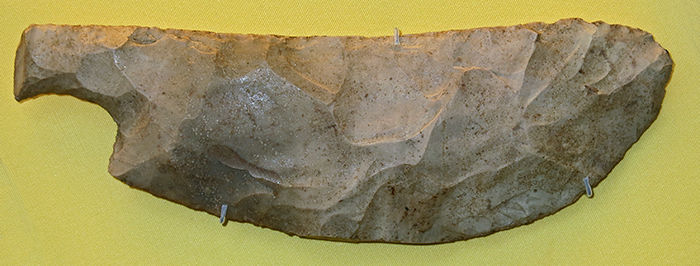
First Dynasty: 3 100 - 2 890 BC
Flint knife
As chief priest to all of the gods, in theory the king prepared their daily offerings. Animal sacrifices were traditionally made with flint knives. The quality of the workmanship here shows the importance of this object to its royal owner.
( note that the British Museum Catalog is not nearly so sanguine about the quality of the knife as the card on the display was - Don )
Complete bifacial knife of brown flint, roughly flaked but not finally sharpened. The blade has a convex cutting edge and a slightly concave back, and is equipped with the usual style of hook-shaped handle. Very thick and clumsy compared with the best First Dynasty work.
Width 52 mm, length 164 mm, thickness 14 mm.
Catalog: Abydos, Tomb of Semerkhet, First Dynasty, EA68718
Photo: Don Hitchcock 2015
Source: Original, British Museum
Text: Card at the British Museum, http://www.britishmuseum.org/, © Trustees of the British Museum, CC BY-NC-SA 4.0
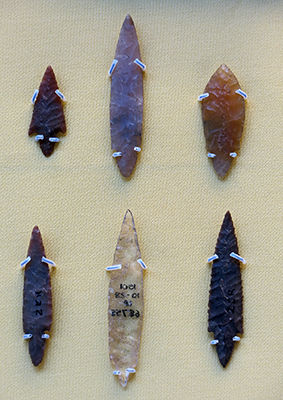
First Dynasty: 3 100 - 2 890 BC
Arrowheads of flint and rock crystal
Finely crafted stone arrowheads were mass produced in the First Dynasty royal workshops. Some were made from special stones like rock crystal. After more than 3 000 years of use, the skill needed to make these carefully flaked stone arrowheads was beginning to die out.
Kings showed respect for the ancestors by preserving this ancient tradition.
Catalog: Abydos, Tomb of Narmer, First Dynasty, EA68750, EA68751, EA68752.
Abydos, Tomb of Djer, First Dynasty, EA68755, EA68757, EA68758.
Photo: Don Hitchcock 2015
Source: Original, British Museum
Text: Card at the British Museum, http://www.britishmuseum.org/, © Trustees of the British Museum, CC BY-NC-SA 4.0
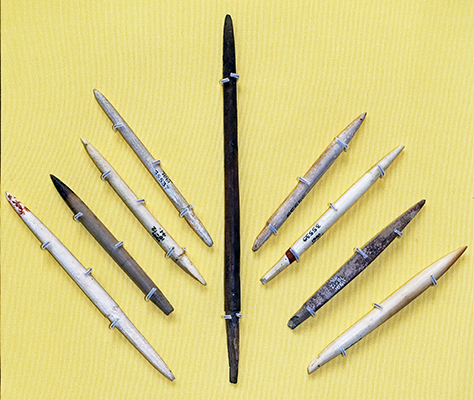
First Dynasty: 3 100 - 2 890 BC
Ivory and ebony arrowheads
As the supreme hunter and warrior, the king maintained cosmic order. Befitting this role, his arrows were made of precious ivory and exotic ebony. Fitted into reed shafts, these aerodynamic arrows did not need feathers to stabilise them. Red ochre applied to the tips of some may represent poison or the blood of the victim, magically guaranteeing victory.
Catalog: Abydos, Tomb of Djer, First Dynasty, EA35535 - EA35542.
Photo: Don Hitchcock 2018
Source: Original, British Museum
Text: Card at the British Museum, http://www.britishmuseum.org/, © Trustees of the British Museum, CC BY-NC-SA 4.0
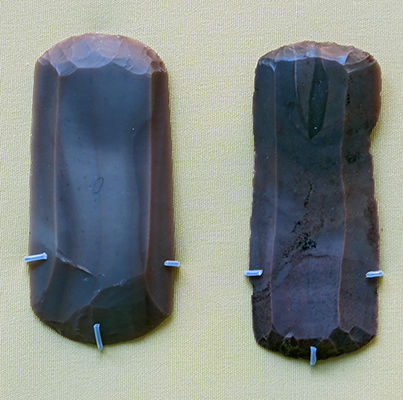
First Dynasty: 3 100 - 2 890 BC
Double ended scrapers
It is unlikely that the king did menial tasks using flint tools in real life, but all eventualities were covered for the afterlife. These broad rectangular blades were once called razors, due to their similarity to later metal tools. Now they are considered to be all-purpose implements for slicing and scraping, and have been described as the 'Swiss Army knives' of their time.
Catalog: Abydos, Tomb of Djer, First Dynasty, EA68760
Abydos, Tomb of Den, First Dynasty, EA68703
Photo: Don Hitchcock 2015
Source: Original, British Museum
Text: Card at the British Museum, http://www.britishmuseum.org/, © Trustees of the British Museum, CC BY-NC-SA 4.0
Sed festival: ruling forever
First - Second Dynasty
3 100 - 2 670 BC
During the First Dynasty, the ideology and duties of kingship were gradually defined in royal titles, regalia and rituals. These established the way kings presented themselves for the next 3000 years. After the coronation, the most important ceremony was the Sed festival, when the king renewed his relationship with the gods. He did this by proving his physical and spiritual ability to rule. Initially a Sed festival was held when rejuvenation was needed, even in the afterlife. Later it was celebrated 30 years into the reign, like a modern jubilee.
First Dynasty: 3 100 - 2 890 BC
Statuette of a king and a label of Den
This ivory statuette shows a king in a short, patterned robe, the special garment worn during the Sed festival. At the top of the ebony label, King Den wears this same robe, as he undertakes one of the festival's most important activities: demonstrating his vitality by running around markers representing Egypt's borders. He was then re-crowned in a special pavilion, his rule and claim to the land reaffirmed.
On the upper middle left we can see the outline of a flying bee at an angle, which signifies the King of the North of Egypt, a symbol first used in this context by Den. Later versions of the bee symbol were more detailed, and horizontally oriented.
Abydos, Osiris Temple, Late Predynastic (Naqada III - First Dynasty, EA37996
Abydos, Tomb of Den, First Dynasty, EA32650
Catalog: Umm el-Qaab (Abydos), Tomb of Djer, tomb O. 2 or O .3 subsidiary burial, EA35512
Photo: Don Hitchcock 2015
Source: Original, British Museum
Text: Card at the British Museum, http://www.britishmuseum.org/, © Trustees of the British Museum, CC BY-NC-SA 4.0
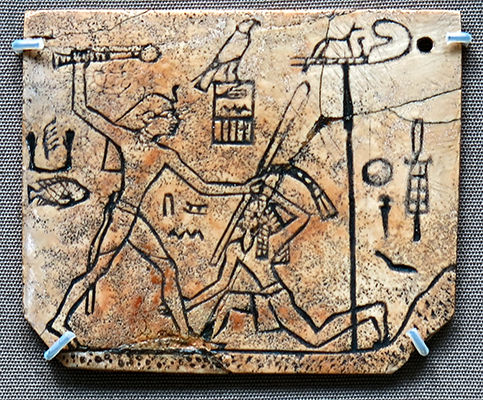
First Dynasty: 3 100 - 2 890 BC
Label of Den
One of the king's principal duties was to defend and expand the borders of Egypt.
This ivory label, once tied to a pair of sandals, depicts King Den smiting a foreigner from the east. Rock carvings of Den near the turquoise mines in Sinai show the same scene, proving this label celebrates an actual military and mining expedition.
Demonstrations of strength were required before a Sed festival.
Photo: Don Hitchcock 2015
Source: Original, British Museum
Text: Card at the British Museum, http://www.britishmuseum.org/, © Trustees of the British Museum, CC BY-NC-SA 4.0
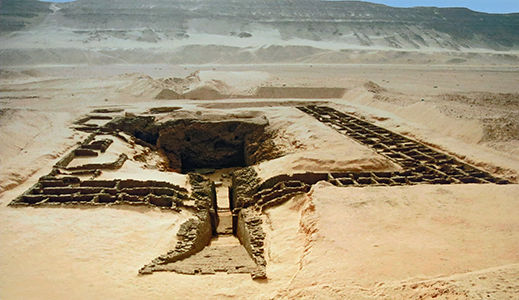
First Dynasty: 3 100 - 2 890 BC
Tomb of King Den
Courtesy of the German Archaeological Institute, Cairo.
Photo: Poster at the British Museum, © Trustees of the British Museum, CC BY-NC-SA 4.0
Text: Card at the British Museum, http://www.britishmuseum.org/, © Trustees of the British Museum, CC BY-NC-SA 4.0
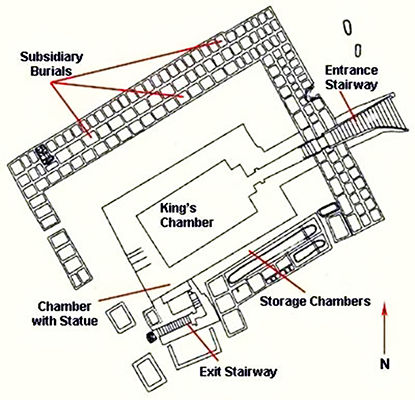
First Dynasty: 3 100 - 2 890 BC
Floor plan of the tomb of King Den at Abydos.
Photo and text: http://www.touregypt.net/featurestories/dentomb.htm
First Dynasty: 3 100 - 2 890 BC
Early evidence of hieroglyphic writing.
Around 3 000 BC, the country on the Nile between the Mediterranean Sea and the 1st Cataract (near Aswan) had for the first time constituted itself into a state structure under the government of a single ruler, a political act that the Egyptians have since called the 'Union of the Two Lands (Upper and Lower Egypt)'.
The first all-Egyptian kings were buried in the desert near the Upper Egyptian town of Abydos in large underground tombs.
Around these tombs, small chamber tombs for servants were built.
These are known to us from the stone steles (gravestones) erected on these secondary graves with their court functions and/or proper names.
These stelae are among the oldest written records from Egypt. The four pieces shown here are from a group of 84 stelae found at the end of the 19th century in the context of the 136 secondary burials of the tomb of Pharaoh Dewen (Den, Udimu), 5th king of the 1st Dynasty. A total of 258 such stelae are known from Abydos. There were two more in the inventory of the Kestner Museum, but one of them was destroyed in the Second World War.
Early period, 1st dynasty, circa 2 950 BC, from Abydos.
The stele at top left belongs to a male dwarf named Ser-Inpu, i.e. '(The god of the dead) Anubis is a/the ruler'. Dwarves were employed at court as valets.
Inv. no. 1935.200.33
The stele at top right belongs to a male priest of the dead (literally 'soul-seeker') without proper name.
Inv. no. 1935.200.37
The tall stele at bottom left belongs to a lady of the harem (literally 'Great of the House') named Kehen, i.e. 'The Praised One'.
Inv. no. 1935.200.32
The name of the female owner of the other stela at the lower right contains the word 'hippopotamus', but is otherwise unintelligible.
Inv. no. 1935.200.36
Catalog: Limestone, Inv. no. 1935.200.33, 1935.200.37, 1935.200.32 and 1935.200.36
Photo: Don Hitchcock 2018
Source and text: Original, Museum August Kestner, Hannover
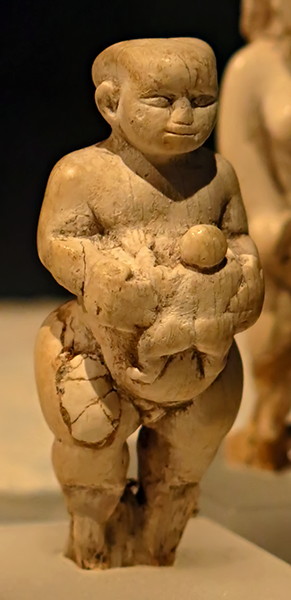
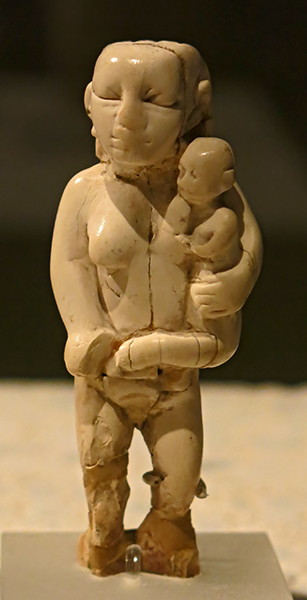
First Dynasty: 3 100 - 2 890 BC
Two figures of a woman with her child.
Circa 3 000 BC.
Elephant Ivory
Catalog: ÄM 14441, ÄM 17600
Photo: Don Hitchcock 2015
Source: Original, Staatliche Museen zu Berlin, Neues Museum, Germany
Text: © Card at the Staatliche Museen zu Berlin, (CC BY-NC-SA 3.0 DE)
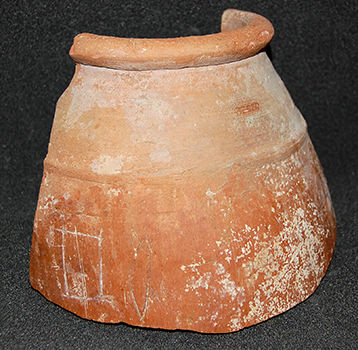
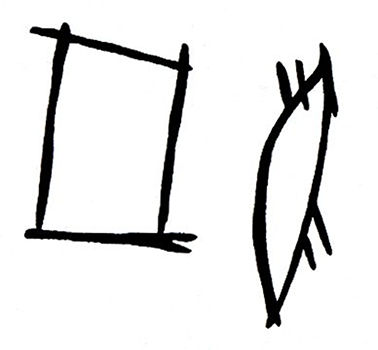
First Dynasty: 3 100 - 2 890 BC
Signs on Jar
Older ways of communicating continued to be used even after the invention of the hieroglyphic script since few people
could read it.
The marks on the left side of this fragment of a First Dynasty jar are part of a separate system that involved about 100 basic signs written in specific combinations. Archaeologists are still trying to decipher their exact meaning.
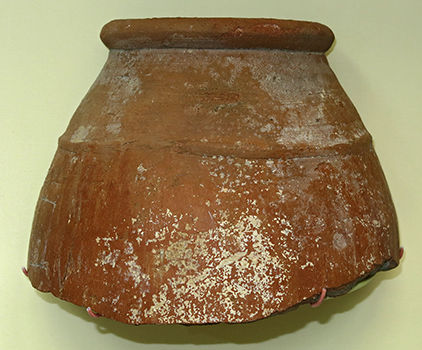
Part of the shoulder and rim of a tall jar of light brown pottery, with a red slip on the exterior and black in the centre of the section. The outer surface bears an incised inscription of two signs.
( note that there are very similar signs on the large intact wine jar with mud stopper in the image below - Don )
Length: 145 mm, width 200 mm
Catalog: Abydos, Tomb of Den, First Dynasty, EA32687
Photo (top left and right): © Trustees of the British Museum, CC BY-NC-SA 4.0
Photo (bottom left): Don Hitchcock 2015
Source: Original, British Museum
Text: Card at the British Museum, http://www.britishmuseum.org/, © Trustees of the British Museum, CC BY-NC-SA 4.0
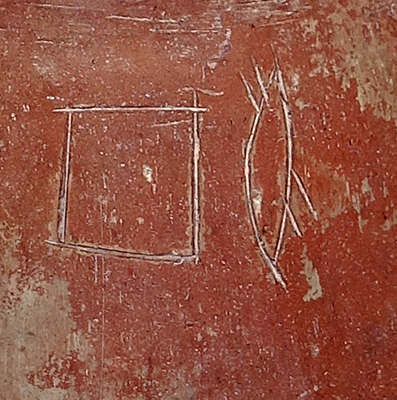
First Dynasty: 3 100 - 2 890 BC
Signs on Jar
Signs on the large intact wine jar with mud stopper in the image below.
( note that there are only one hundred or so signs of this nature. My guess is that they are an indication of the type of wine (or other filling) in the jar - Don )
Catalog: Abydos, Tomb of Den, EA27737
Photo: Don Hitchcock 2018
Source: Original, British Museum
Text: Card at the British Museum, http://www.britishmuseum.org/, © Trustees of the British Museum, CC BY-NC-SA 4.0
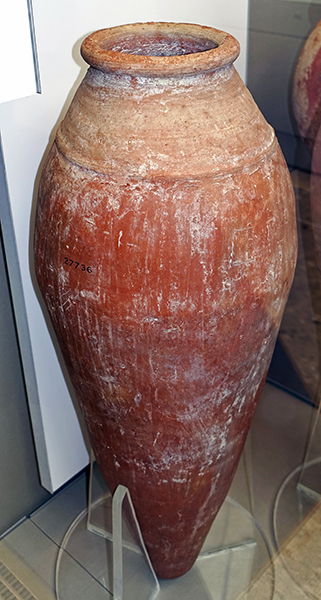
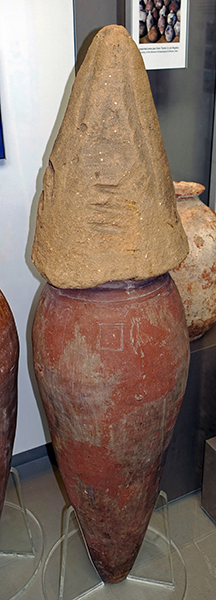
First Dynasty: 3 100 - 2 890 BC
Wine jars of Den
Wine from the royal vineyards was bottled for distribution and storage in large tapered pottery vessels. Like modern wine labels, the conical mud stoppers used to close them were covered with the impressions from cylinder seals, naming the place of manufacture and the person responsible.
(left) A tall jar of red pottery with an external roll-rim. The sides expand from the rim to the shoulder, then converge to a narrow, rounded base. Between the rim and the shoulder there is a raised ridge. The side of the jar bears an incised inscription, consisting of two signs.
Dimensions: diameter 252 mm (max), 134 mm (rim), height: 690 mm.
Catalog: Pottery, Tomb of Den (?), EA27736
(right) Tall jar of dull red pottery from the Tomb of Den with traces of a pale brown wash. The sides expand from the mouth to the shoulder, then converge to a narrow rounded base. Below the rim there is a raised ridge, close to which there are two incised marks.
The jar is sealed with a conical clay stopper, which bears the remains of four impressed inscriptions. Only one impression is now reasonably clear, the other three having disappeared except for slight traces.
Height 1000 mm, diameter 254 mm (max), height 310 mm (seal alone) diameter 240 mm (base of seal)
Catalog: Abydos, Tomb of Den, EA27737 (jar), EA27741 (large jar sealing cap)
Photo: Don Hitchcock 2018
Source: Original, British Museum
Text: Card at the British Museum, http://www.britishmuseum.org/, © Trustees of the British Museum, CC BY-NC-SA 4.0
Tomb of King Den
Jars with distinctive red painted decoration were imported from the northern Levant and may have been made specifically for export to Egypt. They probably contained oils that were coveted by the Egyptian elite.
Such pottery is often called Abydos ware because it was found in the First Dynasty royal tombs before its original source was determined.
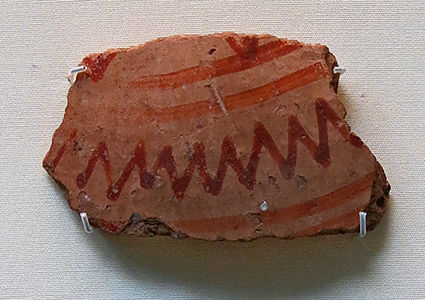
First Dynasty: 3 100 - 2 890 BC
Zigzag pattern fragment.
Fragment of a vase of pale brown pottery with decoration on the exterior in red paint, partly faded to orange. The paint has been applied over a smooth brown slip. Good condition.
Length 74 mm, width 41 mm.
Although registered as coming from the tomb of Semerkhet, this sherd bears the excavation mark T, probably indicating their true provenance as the tomb of Den.
Catalog: First Dynasty, Tomb of Den, EA68686
Photo: Don Hitchcock 2015
Source: Original, British Museum
Text: Card at the British Museum, http://www.britishmuseum.org/, © Trustees of the British Museum, CC BY-NC-SA 4.0
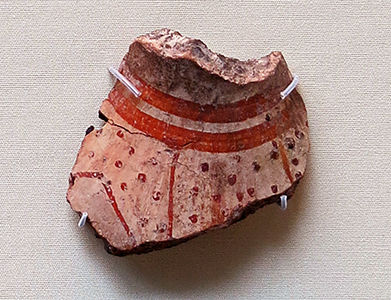
First Dynasty: 3 100 - 2 890 BC
Bands and dots pattern fragment.
Fragment of a vase of lightly-baked clay: the section is mostly black in colour. The exterior surface is decorated with purple and red painted designs over a pale grey slip. Slightly cracked.
Length 54 mm, width 50 mm.
Although registered as coming from the tomb of Semerkhet, this sherd bears the excavation mark T, probably indicating its true provenance as the tomb of Den.
Catalog: First Dynasty, Tomb of Den, EA68683
Photo: Don Hitchcock 2015
Source: Original, British Museum
Text: Card at the British Museum, http://www.britishmuseum.org/, © Trustees of the British Museum, CC BY-NC-SA 4.0
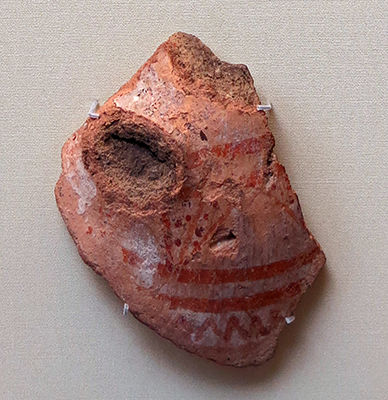
First Dynasty: 3 100 - 2 890 BC
Triangles, lines and points pattern fragment.
Fragment of a vase of pink pottery with painted decoration on the exterior in red. The designs include triangles, lines and points. There is a mark on the surface where a handle has been broken away. Good condition, decoration faded in places.
Length 87 mm, width 73 mm.
Although registered as coming from the tomb of Semerkhet, this sherd bears the excavation mark T, probably indicating their true provenance as the tomb of Den.
Catalog: First Dynasty, Tomb of Den, EA68684
Photo: Don Hitchcock 2015
Source: Original, British Museum
Text: Card at the British Museum, http://www.britishmuseum.org/, © Trustees of the British Museum, CC BY-NC-SA 4.0
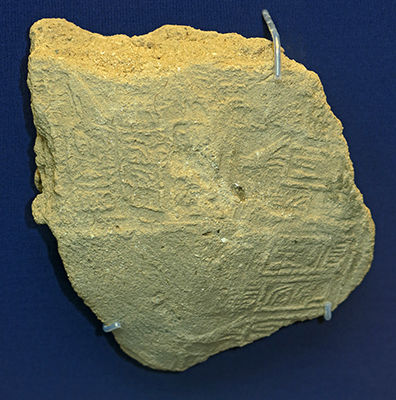
First Dynasty: 3 100 - 2 890 BC
Wine jar seal
By Predynastic times the elite had already developed a taste for wine. As grapes were not native to Egypt, wine had to be imported from the Levant, making it rare and costly. To secure a supply, kings of the First Dynasty introduced the vines, and made their own wine on royal estates. Wine drinking soon spread, and by the end of the Old Kingdom the ideal funerary offerings included five different types.
The fragment names King Semerkhet's vineyard, written as a sloping trellis with wine jars below. Thousands of such jars were found in the royal tombs at Abydos. In Den's tomb alone there were more than 1 000 examples, containing nearly 250 000 litres of wine.
Part of a jar-seal, of pale brown clay, with an impressed inscription giving the name of Semerkhet and the name of a building, possibly a wine-cellar. Good condition.
Length 110 mm, width 110 mm.
Catalog: Abydos, Tomb of Semerkhet, First Dynasty, EA32670
Photo: Don Hitchcock 2015
Source: Original, British Museum
Text: Card at the British Museum, http://www.britishmuseum.org/, © Trustees of the British Museum, CC BY-NC-SA 4.0
First Dynasty, 3 100 BC - 2 890 BC
Ritual knife
It became traditional to use flint knives to sacrifice animals, even after copper became widely available. Functional knives with built-in handles were part of temple equipment. Other blades too large or delicate ever to have been used were dedicated probably by elite patrons.
(left, EA74721) Bifacial knife of brown flint, with a short, integral handle. The broad blade is curved, with a convex cutting edge and concave back, and a pointed tip. The back of the handle ends in a sharp point.
Length 245 mm, width 56 mm.
Height 45 mm, length 76 mm, width 22 mm.
EA30752, right, is not listed in the catalog of the British Museum.
Photo: Don Hitchcock 2015
Catalog: EA74721, EA30752
Source: Original, British Museum
Text: Card at the British Museum, http://www.britishmuseum.org/, © Trustees of the British Museum, CC BY-NC-SA 4.0
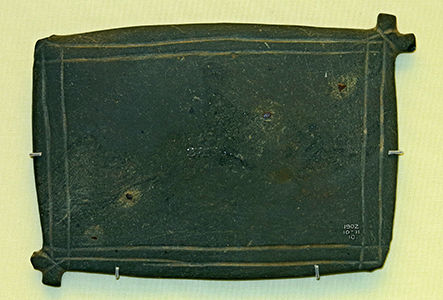
First Dynasty, 3 100 BC - 2 890 BC
Greywacke cosmetic palette
While rulers and kings donated large decorated palettes to the temples, smaller ones were rare, since they fell out of private use during the First Dynasty.
Typically rectangular in shape at this time, carved decorations at the corners were unusual. This palette might have been a treasured possession when offered, or even an heirloom.
Rectangular mudstone ( ? ) palette with projections at the corners, broken away in two instances. The sides are slightly convex and they are bordered by two parallel incised lines on the upper surface.
Length 128 mm, width 90 mm.
Incised border lines are common on palettes at the very end of the Predynastic period. Compare W. M. F. Petrie, 'Tarkhan I and Memphis V' (London, 1913), pl.XXIX; W. M. F. Petrie, 'Tarkhan' II (London, 1914), pl.XXIV.
( note that this palette is reminiscent in shape and decoration of an object made of wood or other organic material, but copied here in stone - Don )
Photo: Don Hitchcock 2015
Catalog: Abydos, Osiris Temple, First Dynasty EA37273
Source: Original, British Museum
Text: Card at the British Museum, http://www.britishmuseum.org/, © Trustees of the British Museum, CC BY-NC-SA 4.0
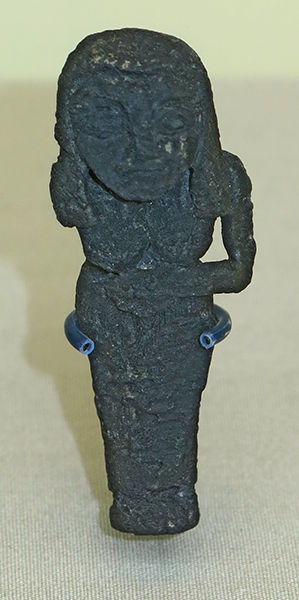
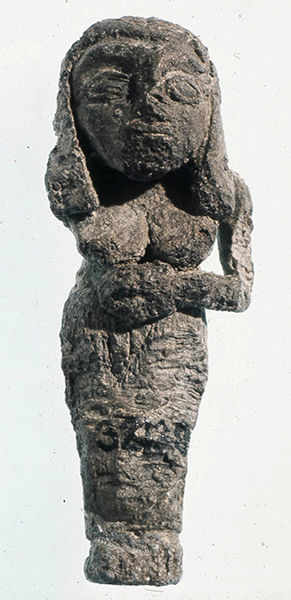
First Dynasty: 3 100 - 2 890 BC
Lead figurine of a woman
Lead was a rare material, and this figurine was probably dedicated at a temple by an elite woman. It portrays a woman in the pose of supplication wearing the long skirt typical in the Early Dynastic period. Details of a fringed apron and zigzags accentuating her long wavy hair have been etched into the soft lead.
Lead female figure, left arm across breast, right arm lost.
Reportedly from Abydos, First Dynasty, EA32138
Height 59 mm, width 24 mm, thickness 15 mm, weight 75 grams.
Catalog: Abydos, First Dynasty, EA32138
Photo (left): Don Hitchcock 2015
Photo (right): © Trustees of the British Museum, CC BY-NC-SA 4.0
Source: Original, British Museum
Text: Card at the British Museum, http://www.britishmuseum.org/, © Trustees of the British Museum, CC BY-NC-SA 4.0
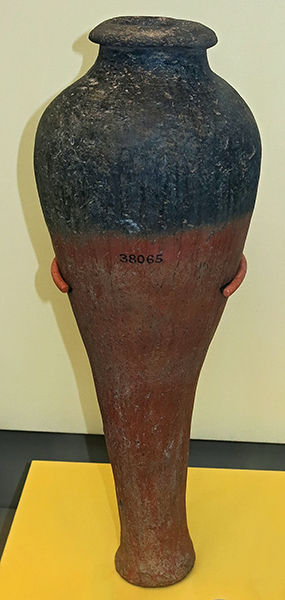
First Dynasty: 3 100 - 2 890 BC
Hes jar
Jars of this shape were used for pouring libations in purification rites, essential before approaching the gods' shrines.
The upper body was blackened in conscious imitation of pottery styles popular hundreds of years earlier. This showed respect for tradition and reverence of the ancestors.
Called hes by the ancient Egyptians, the jar's image also stood for the word 'honour' or 'praise' in the hieroglyphic script.
Tall pear-shaped red burnished necked vase with black top, flat base, and turned rim (chipped), exterior surface worn, slightly warped.
Height 359 mm, width 126 mm.
Catalog: Abydos, Osiris Temple, Chamber M69, First Dynasty, EA38065
Photo: Don Hitchcock 2015
Source: Original, British Museum
Text: Card at the British Museum, http://www.britishmuseum.org/, © Trustees of the British Museum, CC BY-NC-SA 4.0
First Dynasty: 3 100 - 2 890 BC
Faience models
Models of the actual pottery used during rituals were probably donated when a temple was founded or refurbished.
They include model hes jars, which copy the blackened top of the original, and conical jar stands used to hold pots and trays during the daily feeding of the gods. Others depict sealed jars filled with provisions or objects in ritual use, like the model with two jars joined at the mouth.
Catalog: Abydos, Osiris Temple, Chamber M69, First Dynasty, EA38013 - EA38017
Photo: Don Hitchcock 2015
Source: Original, British Museum
Text: Card at the British Museum, http://www.britishmuseum.org/, © Trustees of the British Museum, CC BY-NC-SA 4.0
First Dynasty: 3 100 - 2 890 BC
Necklace
Necklace of different types of beads and pendants from a royal tomb.
1 large 'T' shaped spacer in garnet; 12 barrel beads in garnet; 32 garnet spherical beads; 69 small spherical garnet beads; 2 long cylindrical spacers in powdery? limestone(?), white faience(?), or gypsum(?); 1 cylindrical spacer in carnelian; 118 small coral(?)/carnelian(?) barrel beads; 7 small coral(?)/carnelian(?) tubular beads; 10 large barrel beads in carnelian; 8 short carnelian barrel beads; 4 largish tubular beads in carnelian; 2 domed (button shaped) circular beads in carnelian; 4 largish dome (button shaped) circular beads (with 4 perforations) in carnelian; 2 bifurcated long beads in carnelian; 1 large tubular bead, slight bifurcating; 2 rectangular cylinder spacers (each with flat and 2 convex sides), 1 in carnelian, 1 in white faience(?), limestone(?) or gypsum(?); 2 large cylindrical/tubular beads in carnelian (some of the beads have fallen out).
From Abydos, Tomb of Mena (?) recorded on Shiah card as Tomb of Mena(?)
Material: garnet, carnelian, coral.
Garnet strings length: 100 mm.
Garnet strings length: 107 mm.
Garnet strings length: 110 mm.
Garnet strings length: 120 mm.
Carnelian or coral strings length: 173 mm
Carnelian or coral strings length: 271 mm.
Carnelian or coral strings length: 374 mm.
Carnelian or coral strings length: 105 mm.
Accession Number LDUCE-UC51360A.
Photo: Don Hitchcock 2018
Source: Original, Petrie Museum, London, England
Text: Card / online catalogue, the Petrie Museum, © 2015 UCL. CC BY-NC-SA license.
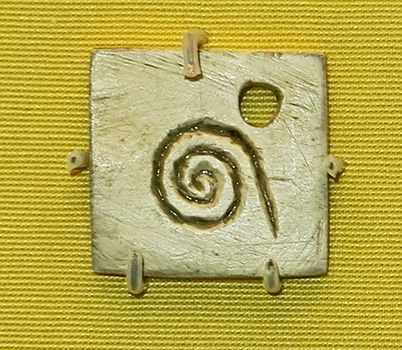
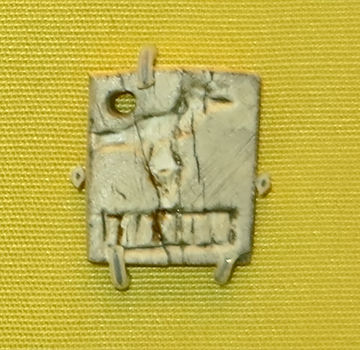
Naqada III - Early First Dynasty: 3 200 - 2 890 BC
Labels with numeral and place name
Attached to commodities deposited in the kings tombs, these tiny ivory labels indicate quantity or place of origin. The spiral is the hieroglyph for the numeral 100, and may denote the length of a bolt of cloth. The falcon atop a rectangle refers to the place of manufacture or the institution providing the item. These labels may come from Abydos Tomb U-j, where identical labels were found.
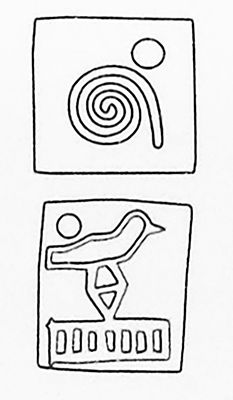
EA35516: A small square label of pale ivory: pierced in one corner for attachment to some object. One side bears an incised spiral, the hieroglyph for the numeral 100, referring to the quantity of some item of burial equipment. Such labels are known to have been used to refer to quantities of oil or the number of beads on a necklace. Height 17 mm, width 17 mm
EA35517: A small ivory label with a hole in the top left-hand corner for attachment. The front surface bears an incised inscription. Good condition, repaired from two fragments. 1st Dynasty, Abydos, cemetery B. Length: 15 mm, width 13 mm. Incised. Consists of a figure of a bird above the hieroglyph for a canal.
Catalog: Naqada III - early First Dynasty, Abydos, B Cemetery, EA35516, EA35517
Photo: Don Hitchcock 2015
Source: Original, British Museum
Text: Card at the British Museum, http://www.britishmuseum.org/, © Trustees of the British Museum, CC BY-NC-SA 4.0
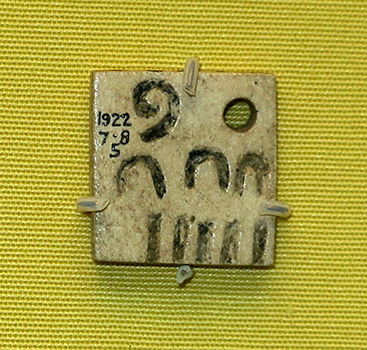
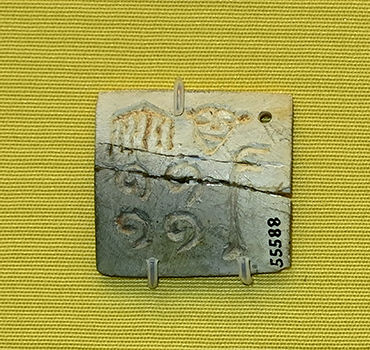
First Dynasty: 3 100 - 2 890 BC
Labels of Queen Neith-hotep
These labels were attached to jewellery belonging to Neith-hotep, King Narmer's queen. The label on the left bears her name on one side and the numeral '135' on the other. This probably records the number of beads in a necklace. The label to the right includes a depiction of the beaded apron to which it was originally attached. According to the inscription, 1400 beads were used to make it.
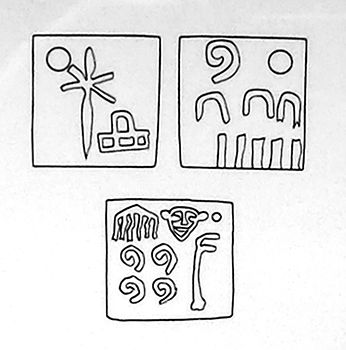
Drawing of the symbols on the tags, including the reverse of the first tag with the queen's name on it.
Catalog: Naqada, Tomb of Neath-hotep. First Dynasty, EA55588, EA55589
Photo (upper left and right): Don Hitchcock 2015
Photo (lower left): From the card at the museum, © Trustees of the British Museum, CC BY-NC-SA 4.0
Source: Original, British Museum
Text: Card at the British Museum, http://www.britishmuseum.org/, © Trustees of the British Museum, CC BY-NC-SA 4.0
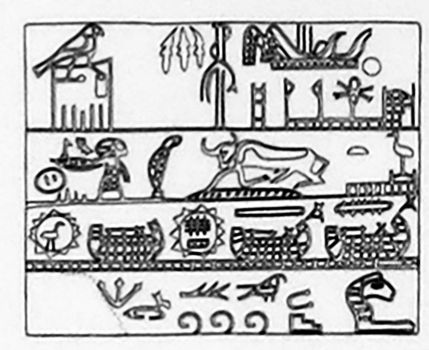
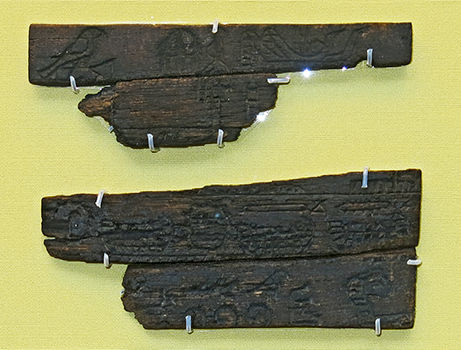
First Dynasty: 3 100 - 2 890 BC
Ebony label of King Aha
Gradually more information was placed on labels. This one was attached to a shipment of high quality oil, and records the year in the king's reign that it was received. The year was identified by major events: in this instance, the founding of a temple for Neith by King Aha, the Anis bull festival and a boat journey. Duplicate labels allow us to restore the missing pieces.
Four fragments of an ebony label joining to form two larger pieces. One side of the label is inscribed, and there was a perforation at the top right-hand corner for attachment. The upper part bears the remains of the incised serekh of Aḥa, opposite a scene showing boats and a religious sanctuary, perhaps the Temple of Neith at Sais. On the lower fragments are traces of another religious building, a row of boats and place names and the name of the type of oil to which the label referred, together with its quantity.
Catalog: Abydos, Tomb of Aha, First Dynasty, EA35518
Photo (left): From the card at the museum, © Trustees of the British Museum, CC BY-NC-SA 4.0
Photo (right): Don Hitchcock 2015
Source: Original, British Museum
Text: Card at the British Museum, http://www.britishmuseum.org/, © Trustees of the British Museum, CC BY-NC-SA 4.0
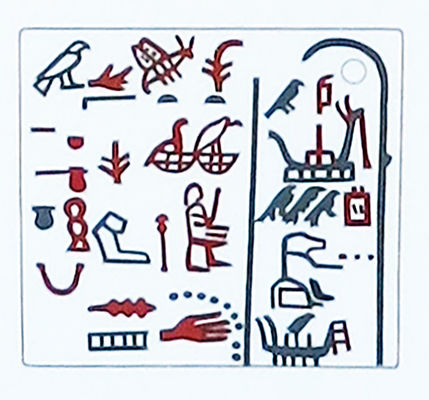
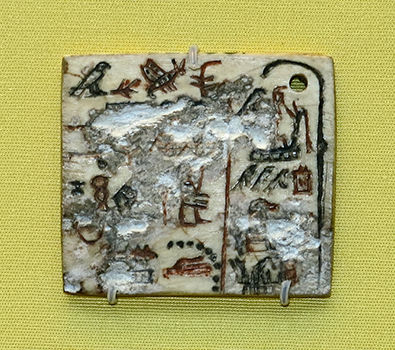
First Dynasty: 3 100 - 2 890 BC
Label of King Semerkhet
By the middle of the First Dynasty labels were standardised, maximising the information they contained. Along the right side is an arching palm stick, the hieroglyph for 'year'. The palm frames the year's main events: a boat trip to collect taxes and the festival of a baboon god.
The central column contains the king's names, and to the left are the name and titles of the high official responsible for the oil that the label accompanied.
Catalog: Abydos, Tomb of Sametkhet, First Dynasty, EA32668
Photo (left): From the card at the museum, © Trustees of the British Museum, CC BY-NC-SA 4.0
Photo (right): Don Hitchcock 2015
Source: Original, British Museum
Text: Card at the British Museum, http://www.britishmuseum.org/, © Trustees of the British Museum, CC BY-NC-SA 4.0
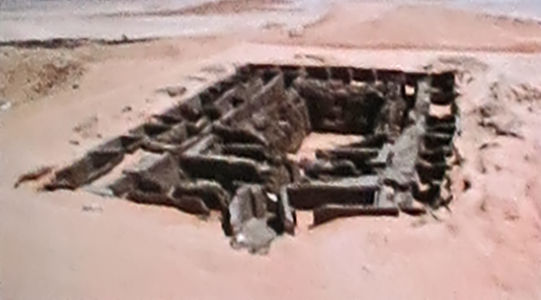
First Dynasty: 3 100 - 2 890 BC
Tomb of King Qa'a
View of the tomb of King Qa'a at Abydos.
Courtesy of the German Archaeological Institute, Cairo.
Photo: Poster, British Museum, © Trustees of the British Museum, CC BY-NC-SA 4.0
Text: Card at the British Museum, http://www.britishmuseum.org/, © Trustees of the British Museum, CC BY-NC-SA 4.0
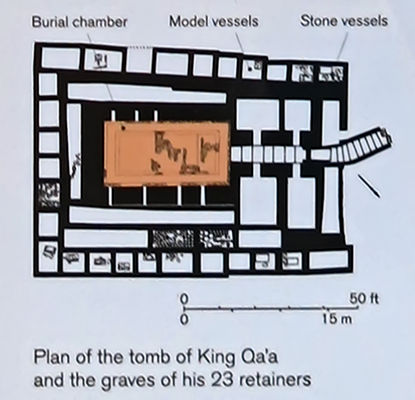
First Dynasty: 3 100 - 2 890 BC
Tomb of King Qa'a
Plan of the tomb of King Qa'a and the graves of his 23 retainers at Abydos.
Areas indicated include the main burial chamber, the area where model vessels were placed, and the area which held stone vessels.
Photo: Poster, British Museum, © Trustees of the British Museum, CC BY-NC-SA 4.0
Text: Poster at the British Museum, © Trustees of the British Museum, CC BY-NC-SA 4.0
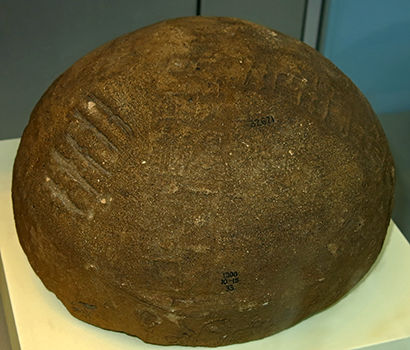
First Dynasty: 3 100 - 2 890 BC
Jar sealing of King Qa'a
Large jars were secured with clay stoppers often impressed with cylinder seals. This prevented theft or tampering since the marked clay would be broken if the jars were opened. This stopper bears two seal impressions. One shows that the jar came from an agricultural estate established to fund the king's funerary cult. The other seal records the high official responsible for the quality and security of the jar's contents.
Height 163 mm, diameter at base 265 mm.
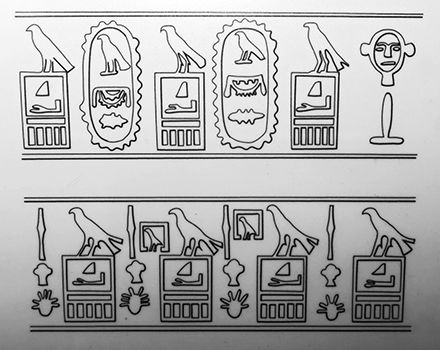
Reconstruction of the seal of King Qa'a on the top register, reconstruction of the seal of the high official responsible for the quality and security of the jar's contents on the lower register.
Catalog: Abydos, Tomb of Qa'a, First Dynasty, EA32671
Photo (upper): Don Hitchcock 2015
Photo (lower): card, British Museum, © Trustees of the British Museum, CC BY-NC-SA 4.0
Source: Original, British Museum
Text: Card at the British Museum, http://www.britishmuseum.org/, © Trustees of the British Museum, CC BY-NC-SA 4.0
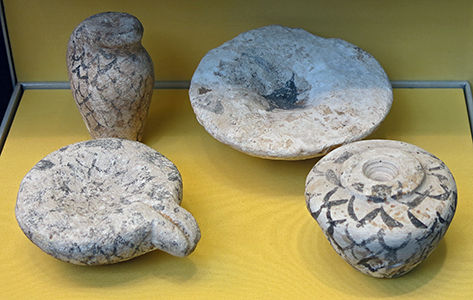
First Dynasty: 3 100 - 2 890 BC
Model vessels with retainer of Qa'a.
Qa'a was the last king to have retainers buried around him. One was interred with a wooden box containing these seven model vessels. All are solid, and the soft limestone has been painted to imitate harder stone. Reflecting the various types of vessels in use at the time, these small substitutes were believed to become full sized and useful in the afterlife.
Catalog: Abydos, Tomb of Qa'a, retainer burial Q20, First Dynasty, EA32677 - EA32683
Photo: Don Hitchcock 2015
Source: Original, British Museum
Text: Card at the British Museum, http://www.britishmuseum.org/, © Trustees of the British Museum, CC BY-NC-SA 4.0
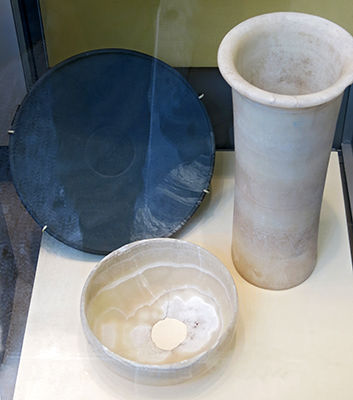
First Dynasty: 3 100 - 2 890 BC
Stone vessels with retainer of Qa'a
The stone vessels below were found with a retainer buried around the tomb of Qa'a. the last king of the First Dynasty. Probably produced in the royal workshops, the vessels have an outward appearance of high quality. However, the hole in the base of the travertine bowl is a manufacturing fault caused by over-drilling. Originally, this was probably patched with plaster.
EA32674: Cylinder jar of calcite with concave sides and a rounded rim, below which there is a band of cord decoration. Interior completely hollowed.
Height 329 mm, diameter 147 mm (rim)
Catalog: First Dynasty, Abydos, Tomb of Qa'a, tomb Q.21 subsidiary burial, EA32674
EA32675: Veined calcite bowl with convex sides rising vertically to a plain rim. The base, although rather flattened, is still convex with ill-defined edges, and it is pierced by a hole caused by excessive hollowing in manufacture.
Height 74 mm, diameter 176 mm (rim)
Catalog: First Dynasty, Abydos, Tomb of Qa'a, tomb Q.21 subsidiary burial, EA32675
EA32676: Grey schist shallow bowl with flat base and incurving rim. The interior of the base is slightly countersunk.
Height 51 mm, diameter 258 mm (rim), 76 mm (base).
Catalog: First Dynasty, Abydos, Tomb of Qa'a, tomb Q.21 subsidiary burial, EA32676
Catalog: Abydos, Tomb of Qa'a, retainer burial Q 21, First Dynasty, EA32674, EA32675, EA32676.
Photo: Don Hitchcock 2015
Source: Original, British Museum
Text: Card at the British Museum, http://www.britishmuseum.org/, © Trustees of the British Museum, CC BY-NC-SA 4.0
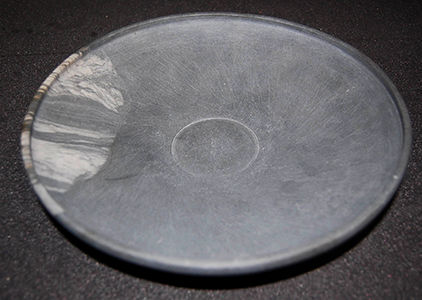
First Dynasty: 3 100 - 2 890 BC
Grey schist shallow bowl with flat base and incurving rim.
( note the markings on the bowl at the left of this image. Albeit accidental, and part of the original stone, it changes an object which is rather ordinary, though well made, into a work of art - Don )
Catalog: First Dynasty, Abydos, Tomb of Qa'a, tomb Q.21 subsidiary burial, EA32676
Photo: © Trustees of the British Museum, CC BY-NC-SA 4.0
Source: Original, British Museum
Text: Card at the British Museum, http://www.britishmuseum.org/, © Trustees of the British Museum, CC BY-NC-SA 4.0
First Dynasty: 3 100 - 2 890 BC
Stone jar
Enormous varieties of stone vessels filled the tombs of the First Dynasty kings, carved from the greatest variety of stone types ever used in Egypt. In the royal workshop, an army of skilled workers must have laboured for thousands of hours to create them. This andesite porphyry jar is lightly incised with the name of King Qa'a.
Spheroidal vase of porphyritic diorite with a flat base and two tubular handles. The vase has a high shoulder and a broad flat-topped rim, the latter being chipped around the outer edge. The upper surface of the rim slopes slightly towards the mouth. Interior completely hollowed. On the polished exterior of the vessel is the very lightly incised serekh of Qa'a, only visible under close examination.
Height 184 mm, diameter 310 mm.
Catalog: Possibly Abydos, First Dynasty, EA22556
Photo: Don Hitchcock 2015, 2018
Source: Original, British Museum
Text: Card at the British Museum, http://www.britishmuseum.org/, © Trustees of the British Museum, CC BY-NC-SA 4.0
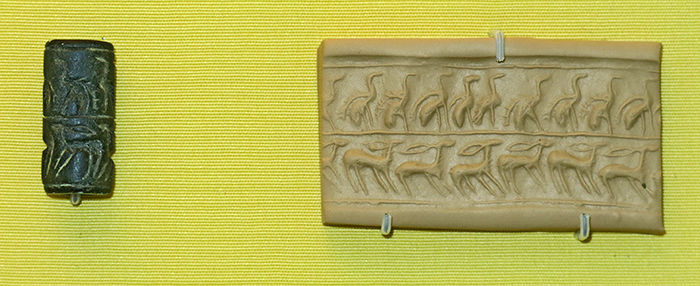
Naqada III - First Dynasty: 3 200 - 2 890 BC
Cylinder seal with animals
Invented in Mesopotamia, cylinder seals were quickly adopted by the Egyptians. Rolled over lumps of clay stuck to doors or containers, they marked ownership or responsibility, and prevented theft. Early cylinder seals were carved with symbols or animals, with meanings that are now difficult to understand. The ostriches and antelopes here might refer to a person or place.
Cylinder seal of black steatite. Perforated through the centre, bearing an incised design in two registers. The upper register contains six figures of birds and the lower register four figures of animals. The exact identity of the types of birds and animals represented is uncertain. Good condition.
Length 21 mm, diameter 10 mm.
Catalog: Naqada III - First Dynasty, EA65891
Photo: Don Hitchcock 2015
Source: Original, British Museum
Text: Card at the British Museum, http://www.britishmuseum.org/, © Trustees of the British Museum, CC BY-NC-SA 4.0
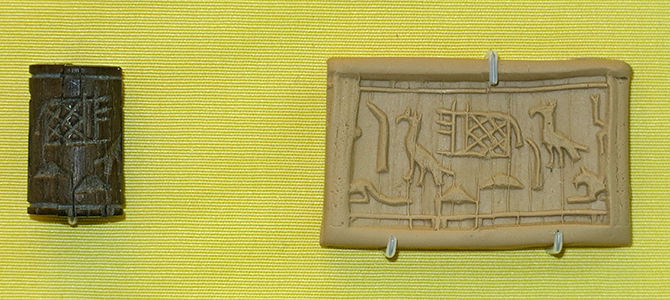
First Dynasty: 3 100 - 2 890 BC
Cylinder seal with shrine
The image of the wooden shrine guarded by a lion represents a temple, and this seal marked temple property. Hieroglyphs might spell the name of the person responsible for sealing the goods and protecting and accounting for them. He was called Nehty.
Wooden cylinder seal. Perforated through the centre, bearing an incised inscription which shows a figure of a lion and a primitive shrine. The wood has slightly split and a small piece has broken from the inscribed surface.
Length 21 mm, diameter 13 mm.
Catalog: Possibly from Abydos. First Dynasty, EA49018
Photo: Don Hitchcock 2015
Source: Original, British Museum
Text: Card at the British Museum, http://www.britishmuseum.org/, © Trustees of the British Museum, CC BY-NC-SA 4.0
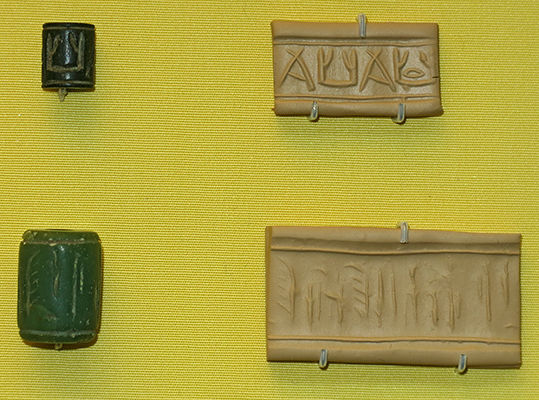
First - Second Dynasty: 3 100 - 2 670 BC
Cylinder seals with personal names
Seals with the names of individuals labelled personal property in life, but after death they were used as protective amulets. Writing the name was believed to keep the identity of the person alive The top seal of black steatite spells out the name Meri-ka, meaning 'The beloved of my spirit', while the lower seal of green feldspar belonged to Senet-Neith, meaning 'Neith is my sister'.
EA58436: A small cylinder seal of black steatite: perforated through the centre and bearing an incised inscription. Good condition.
Height 11 mm, diameter 9 mm
EA65880: A perforated cylinder seal of green feldspar bearing an incised inscription. Good condition.
Height 19 mm, diameter 14 mm
Catalog: First - Second Dynasty, EA58436, EA65880
Photo: Don Hitchcock 2015
Source: Original, British Museum
Text: Card at the British Museum, http://www.britishmuseum.org/, © Trustees of the British Museum, CC BY-NC-SA 4.0
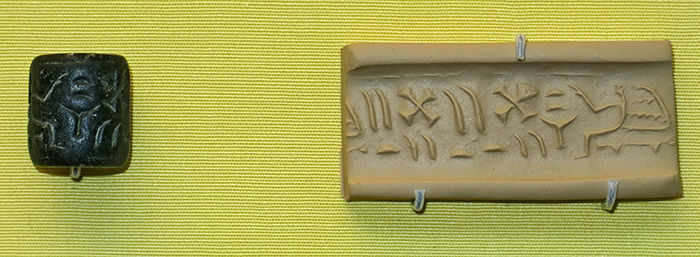
First - Second Dynasty: 3 100 - 2 670 BC
Cylinder seal of person before a table
This seal shows a person wearing a heavy wig sitting in front of a table laden with food offerings. Hieroglyphs spell out the name Itet-Neith, meaning 'Neith is my ruler'. Such seals were buried with the deceased, magically renewing the offerings made in their name.
Cylinder seal of black steatite: perforated through the centre, bearing an incised inscription containing a personal name. Good condition. Length 15 mm, diameter 13 mm.
Catalog: First - Second Dynasty, EA65872
Photo: Don Hitchcock 2015
Source: Original, British Museum
Text: Card at the British Museum, http://www.britishmuseum.org/, © Trustees of the British Museum, CC BY-NC-SA 4.0
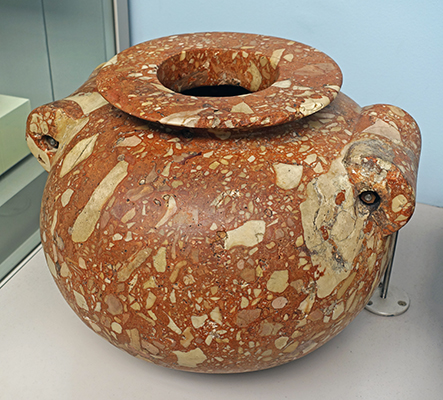
First - Second Dynasty: 3 100 - 2 670 BC
Stone jars of limestone breccia and andesite porphyry
Producing stone vessels was a huge investment in manpower and resources. The tools and skills needed to produce them were perfected in the Late Predynastic period, and contributed to the growth of other technologies. From extraction and transport to carving the logistics of their production influenced Egyptian art and architecture. Large stone jars, like the examples shown here, are some of the most impressive creations of Early Egypt. Such jars were restricted to temples and royalty.
(upper) EA35698: Very large spheroidal vase of porphyritic diorite: with a rounded base and two tubular handles. The vessel has a distinct shoulder, on which the handles are set, and a broad rim around the contracted mouth. The outer edge of the rim is rounded, although partly broken, and the flat top slopes towards the mouth. Only a narrow groove separates the rim from the shoulder of the vessel. The outer surfaces are extremely well finished and the interior has been fairly completely hollowed.
Height 299 mm, diameter 466 mm (rim)
(lower) EA35699: Red breccia spheroidal jar, high in form with a rounded base and two tubular handles. The handles are concave on their outer surfaces. The raised rim has a flat top and a sharp edge, slightly chipped in parts. Interior fairly well hollowed.
Height 332 mm, diameter 267 mm (rim)
Catalog: First - Second Dynasty, EA35698, EA35699
Photo: Don Hitchcock 2015
Source: Original, British Museum
Text: Card at the British Museum, http://www.britishmuseum.org/, © Trustees of the British Museum, CC BY-NC-SA 4.0
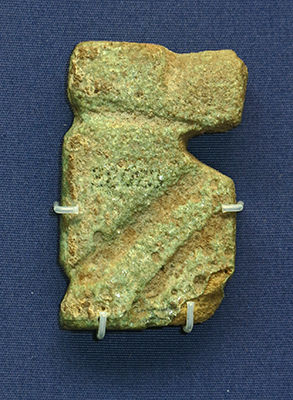
First - Second Dynasty, 3 100 BC - 2 670 BC
Baboon figurine
Small figurines made of Egyptian faience (a blue- green glass paste) are common at all early temple sites. Baboons appear most frequently, especially at Abydos, where more than a hundred were found. They are believed to represent deceased ancestors who could intercede with the gods on behalf of their relatives. Quality and details vary: one holds a jar on his knees as if making an offering himself.
A figure of a squatting baboon cut out of a thin sheet of glazed composition. The legs and neck are indicated by incised lines and the snout has been rounded at the top. The green glaze has partly decayed to brown, and has been chipped at the feet.
Length 46 mm.
Photo: Don Hitchcock 2015
Catalog: Temple of Osiris, Abydos, EA38023
Source: Original, British Museum
Text: Card at the British Museum, http://www.britishmuseum.org/, © Trustees of the British Museum, CC BY-NC-SA 4.0
First - Second Dynasty, 3 100 BC - 2 670 BC
Baboon figurine
(left) A glazed composition figure of a squatting baboon, with the details of the eyes, brows and nostrils indicated in the face. The legs are delineated, the hind legs being drawn up with the forepaws resting on the knees. The glaze has decayed to white with brown patches.
Height 70 mm.
Catalog: Temple of Osiris Abydos, Chamber M69 Subsidiary Chamber Deposit, EA38021
(centre) A glazed composition figure of a squatting baboon with a fairly large well-formed face, including details of the eyes and brow-ridges. The mouth is indicated by an incised line. All the legs are delineated, the forepaws resting on the lower part of the bent hind legs. The figure is covered with a pale green glaze, some areas of which have turned white.
Height 86 mm.
Catalog: Temple of Osiris Abydos, EA37280
(right) A squatting figure of a baboon, not very well made. The facial detail is not clear and the mouth is not indicated. The hind legs are visible, but of the forelegs only that on the left of the figure is clearly shown. Good condition, with well-preserved pale green glaze.
Height 77 mm.
Catalog: Temple of Osiris Abydos, EA37281
Photo: Don Hitchcock 2015
Source: Original, British Museum
Text: Card at the British Museum, http://www.britishmuseum.org/, © Trustees of the British Museum, CC BY-NC-SA 4.0
First - Second Dynasty, 3 100 BC - 2 670 BC
Baboon figurine
(left) A green glazed composition figure of a squatting baboon, crudely made. The front of the body and top of the head are flat with almost angular edges, and the details of the face are summarily depicted by impressed points and incised lines. There has been little attempt to produce a lifelike form and only the hind legs are shown. Well-preserved pale green glaze.
Height 95 mm.
Catalog: Temple of Osiris Abydos, EA38019
(centre) A green glazed composition figure of a squatting baboon, from side on. The head is quite well done, but the rest of the figure is barely sketched in. The glaze has flaked off in parts. A small glazed composition figure of a squatting baboon without detailed modelling. The legs are not clearly shown, nor are the eyes, but the mouth and brows are indicated. Some of the pale green glaze has flaked off at the back of the figure.
Catalog: Temple of Osiris Abydos, EA38022
(right) A composition figure of a squatting baboon. It was originally glazed green, although this glaze has now decayed to white or brown. The figure is well modelled with the details of the legs and face clearly shown. The forelegs are extended to hold an object of uncertain nature on the knees, the top of the object reaching up to join the chin. Its conical shape suggests that it may represent a pot closed with a mud seal. Good condition, glaze slightly flaked in parts.
Height 102 mm.
Catalog: Temple of Osiris Abydos, EA38020
Photo: Don Hitchcock 2015
Source: Original, British Museum
Text: Card at the British Museum, http://www.britishmuseum.org/, © Trustees of the British Museum, CC BY-NC-SA 4.0
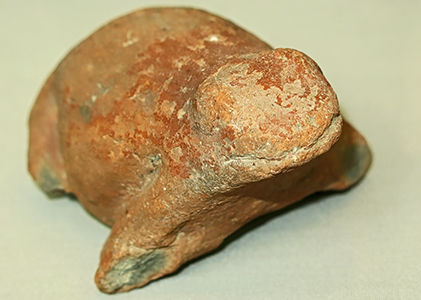
First - Second Dynasty, 3 100 BC - 2 670 BC
Frog figurine
Objects donated at temples often expressed concerns over fertility and health. The frog was the symbol of the goddess Heket, who looked after women during childbirth. Made of red polished clay, this is an unusual frog figurine, as most were made of green faience simulating the colour of the animal.
A figure of a squatting frog in pale red-brown pottery, with remains of a polished red slip. All four feet have been broken, revealing that the pottery is black in the core owing to incomplete firing. The mouth and eyes are the only details shown.
Height 58 mm, length 105 mm, width 63 mm.
Photo: Don Hitchcock 2015
Catalog: Temple of Osiris, Abydos, EA38044
Source: Original, British Museum
Text: Card at the British Museum, http://www.britishmuseum.org/, © Trustees of the British Museum, CC BY-NC-SA 4.0
First - Second Dynasty, 3 100 BC - 2 670 BC
Hippo and pig figurines
The pig and the hippopotamus were considered embodiments of evil. Such figurines might have accompanied requests to the gods for protection.
They could also be models of sacrificial animals. Bones from temple sites show that pigs and hippos were among the animals sacrificed in rites to maintain cosmic order.
EA38045: A dull brown pottery figure of a hippopotamus, repaired from two pieces with a large part of one side missing. The figure is crudely modelled with little detail, the eyes being shown by incised lines and the position of the ears being marked by two holes. Most of the mouth has been lost by the breaking away of the front of the face. The surviving parts of the figure are in good condition, and the missing portions have been restored in plaster.
Height 127 mm, length 245 mm, width 106 mm.
EA38018: A glazed composition figure of a pig, originally green, but now dull brown in colour because of the decay of the glaze. The modelling of the body and legs is rather summary, but a fair amount of detail is shown in the head, including the eyes, ears, mouth and nostrils.
Height 45 mm, length 76 mm, width 22 mm.
Photo (top left and right): Don Hitchcock 2015
Photo (bottom left) © Trustees of the British Museum, CC BY-NC-SA 4.0
Photo (bottom right): Don Hitchcock 2015
Catalog: Early Dynastic, Temple of Osiris, Abydos, ?M64/M65/M69/M89?, EA38045
Catalog: Early Dynastic, Temple of Osiris, Abydos, Chamber M69, EA38018
Source: Original, British Museum
Text: Card at the British Museum, http://www.britishmuseum.org/, © Trustees of the British Museum, CC BY-NC-SA 4.0
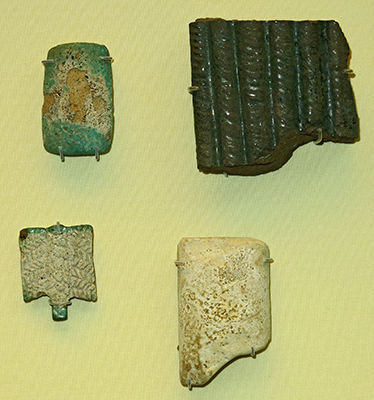
First - Second Dynasty, 3 100 BC - 2 670 BC
Faience Tiles
Blue-green glazed tiles may have decorated the temple's inner sanctum, where the god's statue resided. Piercings on the back allowed them to be wired together, imitating the reeds and matting used to build temples in the earlier, Predynastic, age. The palm-tree tile might have been a furniture inlay.
Photo: Don Hitchcock 2015
Catalog: Abydos, Osiris Temple, Early Dynastic. EA38025, EA37282, EA38011, EA38024
Source: Original, British Museum
Text: Card at the British Museum, http://www.britishmuseum.org/, © Trustees of the British Museum, CC BY-NC-SA 4.0
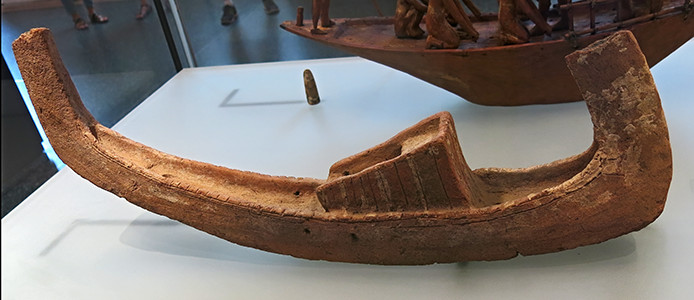
First - Second Dynasty: 3 100 - 2 670 BC
Model of a boat
Painted terracotta model boat.
This is a very rare example of a model boat from the time of the first Pharaohs.
Catalog: E 27136
Photo: Don Hitchcock 2015
Source: Original, Musée du Louvre
Text: © Musée du Louvre
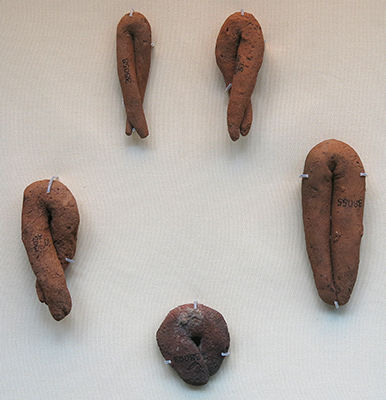
First - Second Dynasty, 3 100 BC - 2 670 BC
Twists of burnt clay
Hundreds of twisted strips of clay were recovered from a fire pit at the Abydos temple. They might be substitute food offerings thrown into the fire for cooking, or representations of enemies to be destroyed by burning. They are simple objects, but give insight into the types of rituals undertaken in early temples.
Photo: Don Hitchcock 2015
Catalog: Abydos, Osiris Temple, Early Dynastic. EA38055, EA38058, EA38059, EA38060, EA38063
Source: Original, British Museum
Text: Card at the British Museum, http://www.britishmuseum.org/, © Trustees of the British Museum, CC BY-NC-SA 4.0

First - Second Dynasty, 3 100 BC - 2 700 BC
Bracelets
13 to 17: Bracelets in shell.
18, 19: Bracelets in schist.
Catalog: Excavations at Maadi, E 13923 - E 13927, E 13921, E 13922
Photo: Don Hitchcock 2015
Source: Original, Musée du Louvre
The Second Dynasty
2 890 BC - 2 670 BC
The seat of government was centred at Thinis.
| Second Dynasty | |||
|---|---|---|---|
| Name | Years | Dates (very approximate) | Comments |
| Hotepsekhemwy | 29 (?) | 2 890 BC - 861 BC (?) | Hotepsekhemwy may have gained the throne after a period of political strife. |
| Raneb / Nebra | 10 (?) | 2 861 BC - 2 851 BC (?) | Reconstructions of the well known Palermo Stone, a black basalt table presenting the yearly events of the kings from the beginning of the 1st dynasty up to king Neferirkare in the shape of clearly divided charts, leads to the conclusion that Nebra and his predecessor, King Hotepsekhemwy, ruled altogether for 39 years. Since Nebra has fewer records of his rule than Hotepsekhemwy, Nebra is thought to have ruled for a shorter time. |
| Nynetjer / Ninetjer | 45 (?) | 2 851 BC - 2 806 BC (?) | Nynetjer is one of the best archaeologically attested kings of the 2nd dynasty. His name appears in inscriptions on stone vessels and clay sealings in large numbers from his tomb at Sakkara. A large number of artefacts bearing his name were also found in the tomb of King Peribsen at Abydos and in the galleries beneath the step pyramid of King Djoser. |
| Senedj | 70 (?) | 2 806 BC - 2 736 BC (?) | Some Egyptologists believe that King Nynetjer, the third ruler of 2nd dynasty, left a realm that was suffering from an overly complex state administration and that Nynetjer decided to split Egypt to leave it to his two sons (or, at least, two chosen successors) who would rule two separate kingdoms, in the hope that the two rulers could better administer the states |
| Peribsen / Seth-Peribsen | circa 50 (?) | 2 736 BC - 2 687 BC (?) | Seth-Peribsen's name is unusual, in that Set, not Horus, was his patron deity. This goes against the Egyptian tradition of a king choosing the falcon-shaped deity Horus as his royal patron. Peribsen's tomb was discovered in 1898 at Abydos. It was well preserved and showed traces of restoration undertaken during later dynastic periods. |
| Khasekhemwy | 17 | 2 687 BC - 2 670 BC | Rival kingdoms in the late Second Dynasty brought strife to Egypt's two lands. In the south, King Peribsen broke with tradition and adopted the god Seth as his patron, instead of Horus, the falcon god. Order and unity were finally restored by the dynasty's ultimate king, Khasekhemwy, who took both Horus and Seth as his patron deities. Leading the country to new cultural heights, Khasekhemwy consolidated his power with an intensive campaign of construction. Technological developments in his reign led to the first extensive use of dressed stone in Egyptian history, preparing the way for the Pyramid Age that followed. |
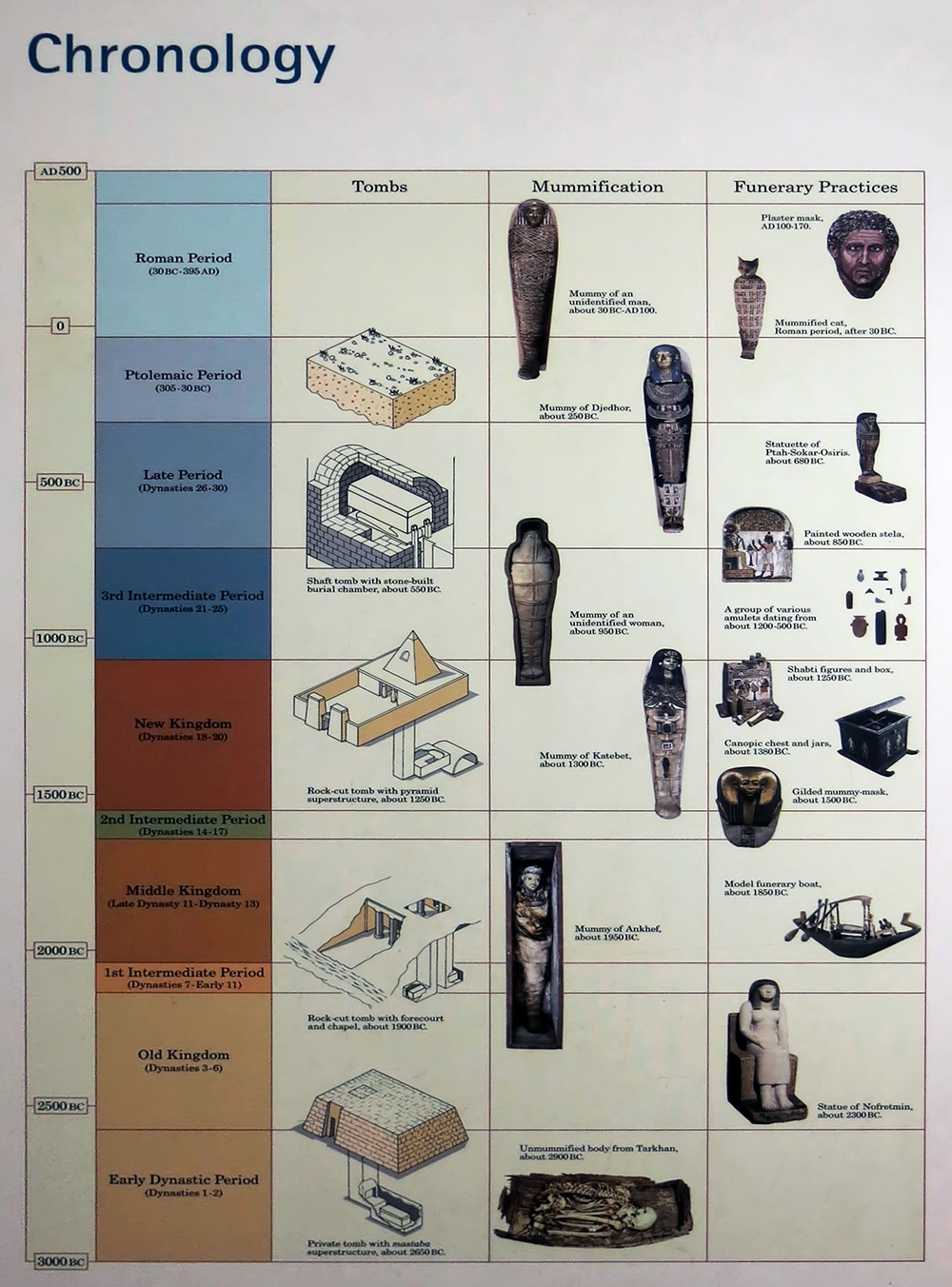
Timeline or chronology for various funerary practices
Rephotography: Don Hitchcock 2015
Source: Poster, British Museum, © Trustees of the British Museum, CC BY-NC-SA 4.0
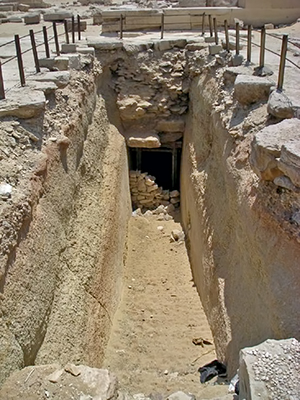
Second Dynasty: 2 890 BC - 2 670 BC
Hetepsekhemwy
The location of Hotepsekhemwy's tomb is unknown. However Egyptologists such as Flinders Petrie, Alessandro Barsanti and Toby Wilkinson believe it could be the giant underground Gallery Tomb A beneath the funeral passage of the Unas-necropolis at Saqqara, as shown here. Many seal impressions of King Hotepsekhemwy have been found in these galleries.
Photo: Neithsabes, 2005
Permission: Public Domain
Text: Adapted from Wikipedia
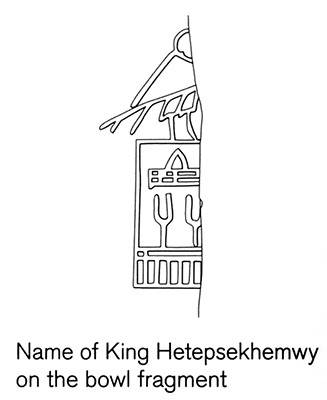
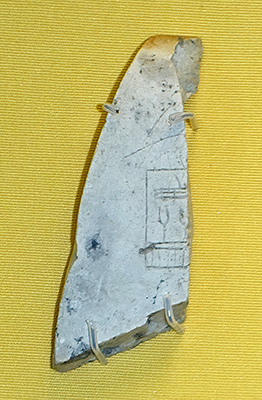
Second Dynasty: 2 890 BC - 2 670 BC
Bowl fragment of Hetepsekhemwy
A small piece of the rim of a dolomite bowl, with an incised serekh on the exterior surface. Good condition.
Hetepsekhemwy was the first king of the Second Dynasty. He was buried at Saqqara, near the capital Memphis, in a huge tomb imitating a royal palace.
Sprawling tunnels and chambers were cut out of the limestone. One room even resembles a latrine. The tomb was found practically empty, so little more is known about this king.
( the fact that the fragment with the serekh of Hetepsekhemwy was found at the Tomb of Khasekhemwy is evidence that stone vessels were valuable, and were reused by later kings - Don )
Catalog: Abydos, Tomb of Khasekhemwy, second dynasty, EA35559
Photo (left): © Trustees of the British Museum, CC BY-NC-SA 4.0
Photo (right): Don Hitchcock 2018
Source: Original, British Museum
Text: Card at the British Museum, http://www.britishmuseum.org/, © Trustees of the British Museum, CC BY-NC-SA 4.0
Second Dynasty: 2 890 BC - 2 670 BC
Relief
The deceased seated before an offering table, circa 2 700 BC.
Catalog: Limestone, Abydos (?), Gl. 106
Photo: Don Hitchcock 2018
Source: Original, Ägyptischen Museum München
Text: © Ägyptischen Museum München
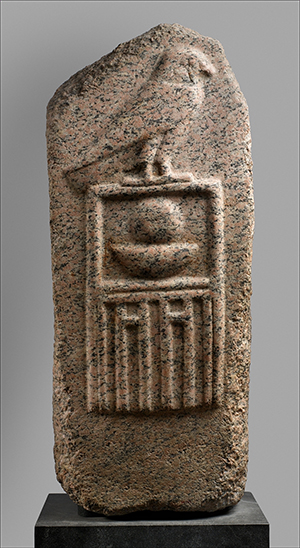
Second Dynasty: 2 890 BC - 2 670 BC
Raneb
Stela of Raneb.
This stela is inscribed with the Horus name of the second king of Dynasty 2, Raneb (or Nebra). A king's Horus name is written within a rectangular device called a serekh, which is the composite view of a building from the side and the top. The lower part depicts the niched facade associated with royal structures; the upper part represents the building's interior, or perhaps its courtyard in plan-view. The whole is surmounted by a falcon representing the god Horus and implying the king's identity with this important deity. Judging from preserved inscriptions, the Horus name is the most commonly used designation for the earliest Egyptian kings from Dynasty 0 into Dynasty 3.
Raneb’s stela is one of a series of royal name stelae dating to Dynasties 1 and 2. Most of these come from the royal cemeteries of Abydos in southern Egypt, and all but two are carved from relatively soft limestone. Raneb's granite stela is the earliest surviving example of relief-carving in this very hard stone. Raneb was also the first king to incorporate the name of the sun god Re into his titulary, marking this deity's increasing prominence.
Excavations at Abydos show that pairs of inscribed stelae were important elements of royal tombs. However, Raneb's stela is said to have been found in northern Egypt in the area of Memphis (Mit Rahina), the ancient Egyptian capital. This has led some scholars to suggest that Raneb's tomb was at the nearby necropolis of Saqqara, where jar sealings stamped with the king's name were found.
Height 100 cm, width 41 cm, thickness 27 cm.
Catalog: Granite, Saqqara, Tomb of Raneb, Accession Number 60.144
Photo, source, and text: The Metropolitan Museum of Art, NYC
Permission: Public Domain.
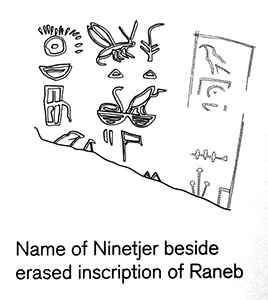
![]()
Second Dynasty: 2 890 BC - 2 670 BC
Bowl fragment naming Raneb and Ninetjer
Stone vessels were precious and often reused by later kings, shown by the two royal names incised on this fragment of a greywacke bowl. Raneb was the second king of the Second Dynasty. He was followed by Ninetjer. Both were buried at Saqqara. During the reign of Ninetjer Egypt became divided, with different kings ruling in the north and south.
( note the hieroglyph of a bee, which was used for both 'honey' and 'king of lower Egypt'. Beside it is a sedge symbol, which was the hieroglyph used for 'king of upper Egypt' - Don )
Catalog: Abydos, Tomb of Peribsen, Second Dynasty, EA35556
Photo (left): Poster, © Trustees of the British Museum, CC BY-NC-SA 4.0
Photo (right): Don Hitchcock 2018
Source: Original, British Museum
Text: Card at the British Museum, http://www.britishmuseum.org/, © Trustees of the British Museum, CC BY-NC-SA 4.0
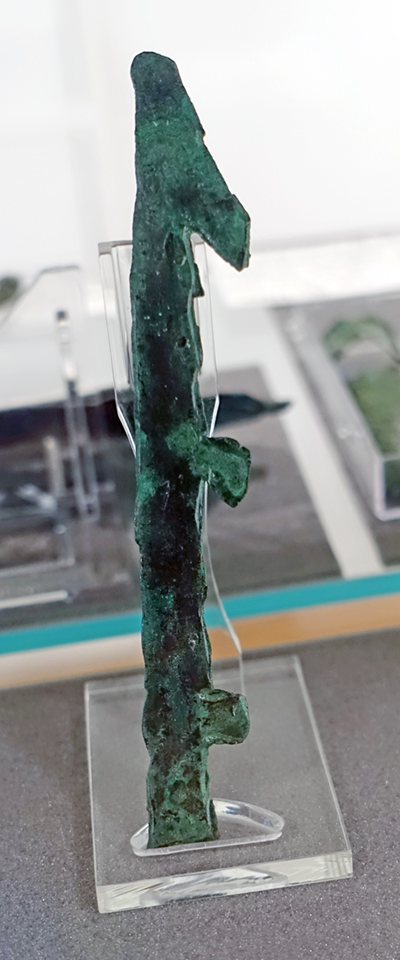
Second Dynasty: 2 890 BC - 2 670 BC
Copper Harpoon
Model copper harpoon cut from sheet metal with a hooked head and two barbs; conserved since publication. From the royal tomb of Khaskhemwy in the Umm el-Qa'ab at Abydos, tomb of Khasekhemwy, opposite chamber 21. RT II, IXA, 5; T & W, XLIV, 36.
Height 116 mm, length 16 mm, Accession Number LDUCE-UC36835.
Photo: Don Hitchcock 2018
Source: Original, Petrie Museum, London, England
Text: Card / online catalogue, the Petrie Museum, © 2015 UCL. CC BY-NC-SA license.
Second Dynasty: 2 890 BC - 2 670 BC
Nynetjer
Statue of Ninetjer
Pharaoh Ninetjer was the third king of the Second Dynasty. His name and titles are in hieroglyphics on the side of his throne. It reads: 'King of Upper and Lower Egypt, protected by the vulture and the cobra, Ninetjer'. The king is depicted in festive clothing, on the occasion of his thirtieth anniversary. In the 1950s, the statuette was part of a private collection in Cairo. In 1960 it was bought in London by a Dutch collector. The museum bought it in 2014 from his son.
Height 135 mm, width 48 mm, depth 85 mm.
Catalog: Quartzite, Accession Number F 2014/6.1
Photo, text and source: Rijksmuseum van Oudheden, Leiden
Permission: Creative Commons Attribution 3.0 Unported license
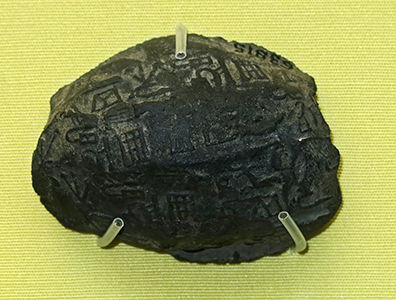
Second Dynasty: 2 890 BC - 2 670 BC
Sealing of two scribes
The hieroglyphic sign for 'scribe' depicts the equipment used for writing: a rectangular inkwell, a bag of pigments for making the ink and a cylindrical case for holding reed pens. Two scribes, Depeh and Herty-ha-f, are named on the original seal, which was repeatedly rolled over the clay. Impressions on the back show it was affixed to twine, which may have tied shut a box, a pot lid, or a document roll.
A seal of black clay from the cord binding of some object, with the seal-impression of two scribes. Good condition. Length 45 mm, width 33 mm, thickness 17 mm.
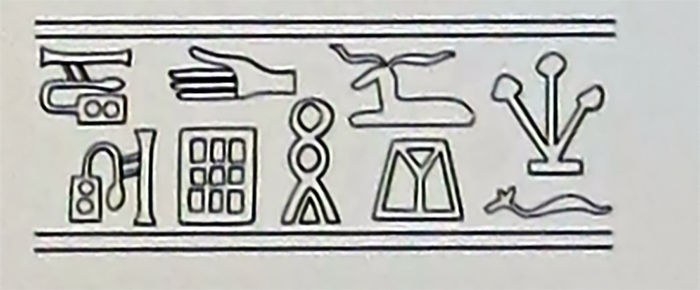
Catalog: Second Dynasty, EA63815
Photo (top): Don Hitchcock 2015
Photo (bottom): Card at the British Museum, © Trustees of the British Museum, CC BY-NC-SA 4.0
Source: Original, British Museum
Text: Card at the British Museum, http://www.britishmuseum.org/, © Trustees of the British Museum, CC BY-NC-SA 4.0
Second Dynasty: 2 890 BC - 2 670 BC
Jar sealing of Peribsen
After the country split, Peribsen ruled Upper Egypt, in the south. To stress his claim, he took as his divine patron Seth, the local god of Nubt, or 'Gold Town' (modern day Naqada). Represented by a mythological dog-like creature, Seth appears at the top of Peribsen's serekh, or name box.
On this seal, the standing figure of the god Ash, the protector of royal estates, is also depicted with the Seth animal's head.
Catalog: Abydos, Tomb of Peribsen, Second Dynasty, EA35595
Photo (left): © Trustees of the British Museum, CC BY-NC-SA 4.0
Photo (right): Don Hitchcock 2015, 2018
Source: Original, British Museum
Text: Card at the British Museum, http://www.britishmuseum.org/, © Trustees of the British Museum, CC BY-NC-SA 4.0
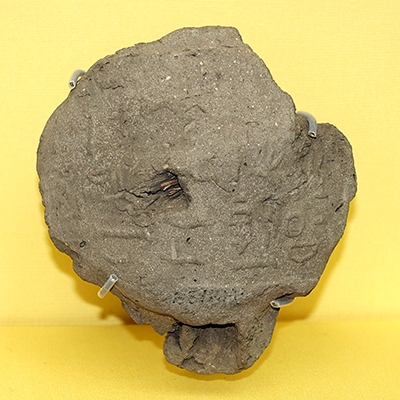
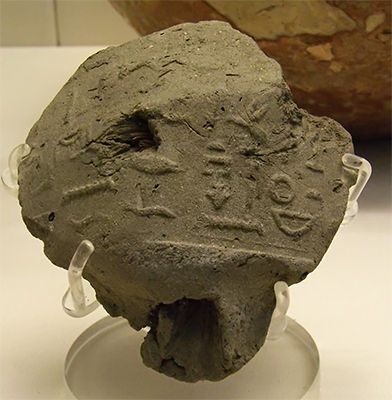
Second Dynasty: 2 890 BC - 2 670 BC
Jar sealing of King Peribsen
Writing was invented for administrative purposes and entries were short. Continuous speech was not recorded until the Second Dynasty. The hieroglyphs impressed into this mud jar stopper are from a cylinder seal carved with the first complete sentence known from early Egypt.
It reads:
'Seal of all gold things. The golden one (the god Seth) has joined the two lands for his son, the King of Upper and Lower Egypt, Peribsen.
Length 90 mm, width 80 mm.
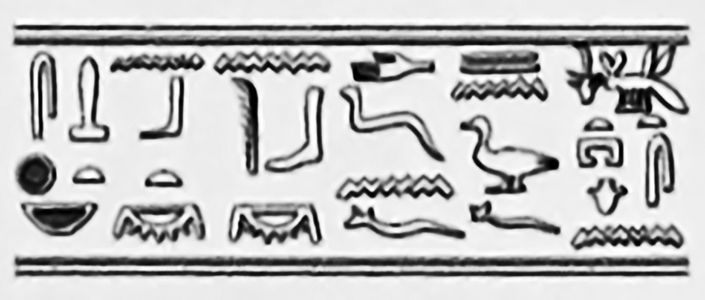
Reconstruction of Peribsen's seal.
Catalog: Abydos, Tomb of Peribsen, Second Dynasty, EA35594
Photo (upper left): Don Hitchcock 2015
Photo (upper right): Udimu, Permission: Creative Commons Attribution-Share Alike 3.0 Unported license.
Photo (lower left): card, British Museum, © Trustees of the British Museum, CC BY-NC-SA 4.0
Source: Original, British Museum
Text: Card at the British Museum, http://www.britishmuseum.org/, © Trustees of the British Museum, CC BY-NC-SA 4.0
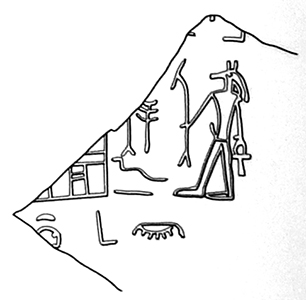
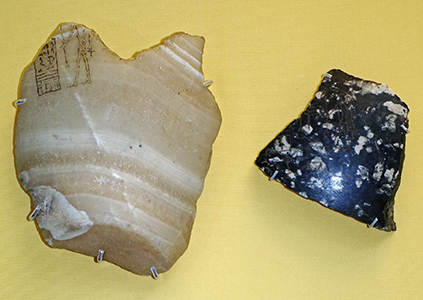
Second Dynasty: 2 890 BC - 2 670 BC
Jar fragments inscribed for Peribsen
On these stone jar fragments the god Seth is depicted with a human body and a dog-like face. He is offering strength and life to the king's name. Originally, Peribsen was called Sekhimib, a name which appears on the travertine fragment to the left. Why and when he changed his name is uncertain.
EA52862: A fragment of the side and part of the base of a travertine bowl, with the name Sekhemib-Perenmaat and a figure of a god incised on the exterior. The god holds a 'was' sceptre and an ankh. The upper part of the inscription is missing. Good condition.
Height 95 mm, width 94 mm.
Second Dynasty, probably from the Abydos Royal Tomb.
EA68689: Fragment of the body of a black-and-white mottled amphibolite bowl with an incised inscription on the exterior surface. On the right is a representation of a standing anthropomorphic deity, holding a 'was'-sceptre and ankh, probably Seth or Ash, with traces of other signs above.
To the left of the god is the lower portion of a serekh, accompanied by text. The word nbt, meaning Ombos, or, possibly, 'the Ombite' is possibly a name of Seth.
Height 79 mm.
Catalog: Second Dynasty, EA52862, EA68689
Photo : Don Hitchcock 2018
Rephotography of the line drawing of the engraving on the black fragment (from a poster in the British Museum): Don Hitchcock 2018
Source: Original, British Museum
Text: Card at the British Museum, http://www.britishmuseum.org/, © Trustees of the British Museum, CC BY-NC-SA 4.0
Second Dynasty: 2 890 BC - 2 670 BC
Bangles and jar fragment of Peribsen
Peribsen was laid to rest at Abydos in a traditional mud brick tomb. Like other royal tombs, it was originally stocked with commodities and precious objects, such as greywacke bangle bracelets and rock crystal vessels. These were later broken, dispersed, or stolen by robbers.
EA32647: A small piece of a rock crystal vessel with an incised inscription of Peribsen. The text is cut on what is most probably the inner surface of the vase. Good condition.
Length 42 mm, width 23 mm
EA68620: Part of a bracelet of grey metasediment amounting to just under half the original circumference. The outer edge is rounded and the inner surface is flat, producing a semicircular section.
Length 63 mm, width 7 mm, bears the excavator's mark, P.
EA68621: Part of a bracelet of grey metasediment amounting to just under half the original circumference. The outer edge is rounded and the inner surface is flat, producing a semicircular section.
Length 67 mm, width 8 mm
Catalog: Abydos, Tomb of Peribsen, Second Dynasty, EA68620, EA68621
Catalog: Abydos, Tomb of Merneith, Excavator's mark Y. 19, Second Dynasty, EA32647
( note that this allocation to the Tomb of Merneith on the BM site appears to be in error. Merneith was the mother of Den, in the First Dynasty. It is difficult to work out how a Second Dynasty artefact could turn up in a First Dynasty tomb - Don )
Drawing: Poster at the British Museum, © Trustees of the British Museum, CC BY-NC-SA 4.0
Photo: Don Hitchcock 2015
Source: Original, British Museum
Text: Card at the British Museum, http://www.britishmuseum.org/, © Trustees of the British Museum, CC BY-NC-SA 4.0
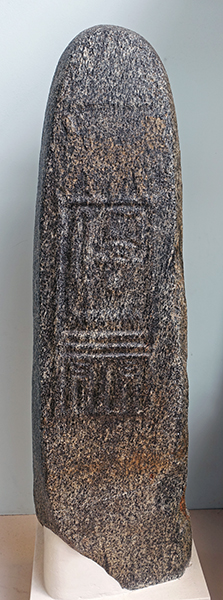
Second Dynasty: 2 890 BC - 2 670 BC
Granite stela of Peribsen
Granite stela of Peribsen, a tall, narrow stela of grey granite, tapering slightly from the base to a rounded top. The back of the stela is only roughly shaped and the base is broken.
All the surfaces have been worn smooth by the action of wind-blown sand, but only the front has been worked by hammering to a flat surface suitable for bearing the inscription. This consists of the serekh of Peribsen surmounted by the animal of Seth, the latter having been hammered out at a later date. The signs are executed in low relief without any sharp edges.
Dimensions: height 1135 mm, width 330 mm.
Catalog: Granite/gneiss, Umm el-Qaab, Abydos, Tomb of Peribsen, EA35597
Photo: Don Hitchcock 2018
Source: Original, British Museum
Text: Card at the British Museum, http://www.britishmuseum.org/, © Trustees of the British Museum, CC BY-NC-SA 4.0
Artist's reconstruction of an Abydos royal tomb with stelae set up above the entrance.
Two stone stelae bearing the owner's name were set up above the entrance of each royal tomb. The king's name was usually crowned with an image of the falcon god Horus.
Peribsen chose to depict the dog-like god Seth instead. This distinguished him from rival kings ruling in the north. Originally Seth was considered a partner of Horus in unifying Egypt's two lands. Later he was vilified and his image was erased from this stela.
Artist: Unrecorded
Rephotography: Don Hitchcock 2018
Source: Poster, British Museum
Text: Card at the British Museum, http://www.britishmuseum.org/, © Trustees of the British Museum, CC BY-NC-SA 4.0
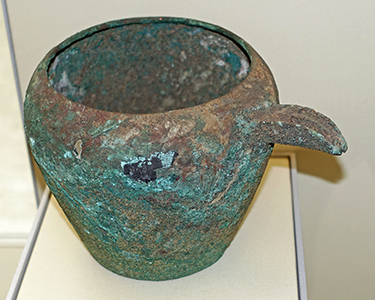
Second Dynasty: 2 890 BC - 2 670 BC
Copper Ewer
Metal vessels were cut from hammered sheets and then soldered together. The spout of this ewer was cast seperately, using the lost wax method. Such vessels were for pouring water when washing the hands.
A vase of thin copper with a flat base and convex sides, which turn inwards at the top. The spout consists of two narrow channels. It was cast separately from the vase by the lost wax process and attached by another casting. Remains of linen adhere to the corroded exterior surface of the vase.
Diameter 78 mm (base), 100 mm (rim), height 108 mm, length 37 mm (spout), width 19 mm (spout).
Catalog: Copper, 2nd Dynasty, probably from the Early Dynastic royal tombs at Abydos, EA29609
Photo: Don Hitchcock 2018
Source: Original, British Museum
Text: Card at the British Museum, http://www.britishmuseum.org/, © Trustees of the British Museum, CC BY-NC-SA 4.0
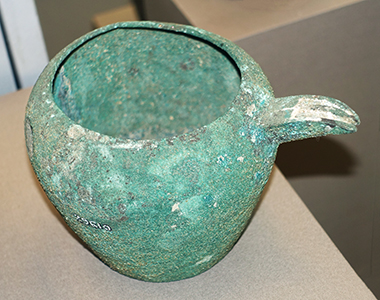
Second Dynasty: 2 890 BC - 2 670 BC
Copper Ewer
A vase of thin copper with a flat base and convex sides, which turn inwards at the top. The spout consists of two narrow channels. It was cast separately from the vase by the lost wax process and attached by another casting. Traces of linen adhere to the corroded exterior surface, together with a large amount of sand.
Diameter 91 - 110 mm (rim), height 108 mm, length 41 mm (spout), width 21 mm (spout)
Catalog: Copper, 2nd Dynasty, probably from the Early Dynastic royal tombs at Abydos, EA29610
Photo: Don Hitchcock 2018
Source: Original, British Museum
Text: Card at the British Museum, http://www.britishmuseum.org/, © Trustees of the British Museum, CC BY-NC-SA 4.0
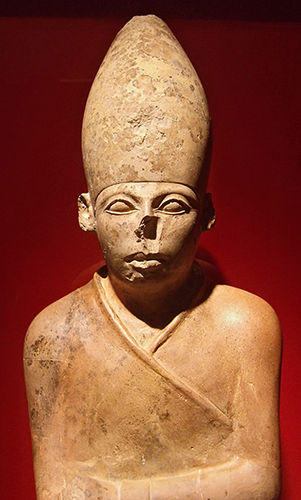
Second Dynasty: 2 890 BC - 2 670 BC
Egypt's first great builder
Statue of the Egyptian king Khasekhemwy.
Rival kingdoms in the late Second Dynasty brought strife to Egypt's two lands. In the south, King Peribsen broke with tradition and adopted the god Seth as his patron, instead of Horus, the falcon god. Order and unity were finally restored by the dynasty's ultimate king, Khasekhemwy, who took both Horus and Seth as his patron deities.
Leading the country to new cultural heights, Khasekhemwy consolidated his power with an intensive campaign of construction. Technological developments in his reign led to the first extensive use of dressed stone in Egyptian history, preparing the way for the Pyramid Age that followed.
Photo: Udimu
Permission: GNU Free Documentation License, Version 1.2
Original: Ashmolean Museum, Oxford
Text: Wikipedia
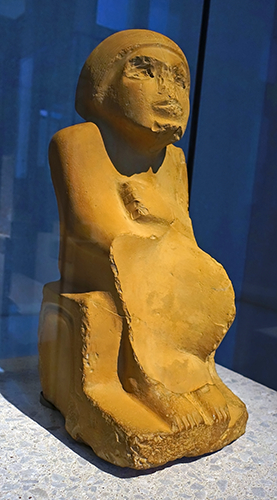
Second Dynasty: 2 890 BC - 2 670 BC
Man in a long coat
Statue of a seated man in a long coat ('Abusir man' / 'Yellow man').
Dimensions: 425 x 190 x 220 mm.
This stone sculpture from the early dynastic period is one of the oldest preserved Egyptian stone sculptures. The subject is sitting on a stool without a backrest, between the legs of which bow-shaped struts made of wood or pipe are clamped. He is wrapped in a long coat that leaves the right shoulder free and has an ornament that cannot be determined on the back. The big head rests almost neckless on the massive torso. A wig parted in the middle covers his head. The deep eye sockets originally had inserts made of different material. The fingers and toes are only indicated by narrow grooves. The forearm lying on his knees has broken away with the front part of the figure.
In Pharaonic times, the seated statue was second in popularity only to the striding statue. The 'Abusir Man' is perhaps the oldest preserved example in stone. Its assignment to the Early Dynastic Period is uncontested. but more precise dating is not possible. Like the majority of Early Dynastic stone sculptures, 'the Abusir Man' was not recovered in the course of excavations. The statue acquired its modem name because it was purchased, in 1909, at Abusir (i.e . the northern extension of the Saqqara necropolis, which served Memphis, the capital founded with unification) from locals who said they had discovered it in the vicinity. The approximately one-third lifesize figure sits on a stool, its bentwood construction detailed on the sides and back of the sculpture. This stool is depicted in a number of Early Dynastic seated statues. In canonical sculpture the seat is a simple, undetailed block. Chairs and stools would not regularly be depicted in statuary again until centuries later, in the New Kingdom.
The Abusir Man's disproportionately large head sits directly on his shoulders. This absence of a neck is characteristic of Early Dynastic sculpture. The missing right hand probably once lay flat on the lap, while the left arm is bent at the elbow with the hand resting on the chest, as in the composition of the Hierakonpolis Torso. When seen straight on, the figure seems to wear an enveloping cloak, from which only his fisted left hand and feet emerge. But the rear view makes it clear that the cloak does not cover the right shoulder, providing another parallel with the torso from Hierakonpolis. The incision on the back of the Abusir Man cannot be overlooked; possibly it was meant to depict a counterweight necessary to balance a broad and presumably heavy necklace. Counterweights are shown on the backs of some later statues, but here there is no necklace. Given that limestone sculpture was customarily painted, it is possible that a broad, collarlike necklace was once depicted in bright colours around the figure's neck and was lost without a trace owing to the weathering the statue was clearly subjected to over a long period, which discoloured the once white limestone to a golden yellow. An alternative proposes that the incisions are to be somehow understood as depicting the knot used to secure the cloak or perhaps a seal, an accessory that would attest to the status of the statue's owner as a member of the elite with a role in the administration. The sculptor of the Abusir Man utilized incision to render other details as well - fingers, toes, and the strands of hair falling from the centre of the heavy wig - but like later Egyptian sculptors, he concentrated his efforts on the subject's face.
The moustache in low relief recurs sporadically in sculpture of the Old Kingdom; sometimes it was added only in paint. The inlaid eyes were pried from their sockets by thieves in antiquity for their material. Eyes are the most arresting features of the human face. The practice of inlaying them in reliefs, documented by some cosmetic palettes and ivory figurines, was well established in the Predynastic Period, and continued into the Old Kingdom. The materials used and techniques involved in inlaying eyes have been studied, but scholars have not yet attempted to determine whether their use was influenced by context (whether for the temple or tomb) or are more prevalent in some statue types than others. The loss of inlaid eyes detracts considerably from the appreciation of a statue, just as their presence produces an uncannily lively effect, which - like well preserved painting - can prove deceptive when it comes to judging quality.
Catalog: Yellow limestone, Abusir, ÄM 21839
Photo: Don Hitchcock 2018
Source: Original, Staatliche Museen zu Berlin, Neues Museum, Germany
Text: © Card at the Staatliche Museen zu Berlin, http://www.smb-digital.de/ (CC BY-NC-SA 3.0 DE)
Additional text: Patch et al. (2011)
Monuments of King Khasekhemwy
Second Dynasty 2690 BCKing Khasekhemwy was Egypt's first great builder. From ancient records we know he was responsible for many structures in addition to his impressive tomb. Two of these still survive: his valley temple at Abydos where funerary rituals took place, and a ceremonial complex at Hierakonpolis. Today, these massive unroofed enclosures are the oldest full-standing mud brick buildings in the world. Lessons learned in the management of such projects, and experiments with stone construction, set the stage for the pyramid age that followed. Text above: Poster at the British Museum, © Trustees of the British Museum, CC BY-NC-SA 4.0
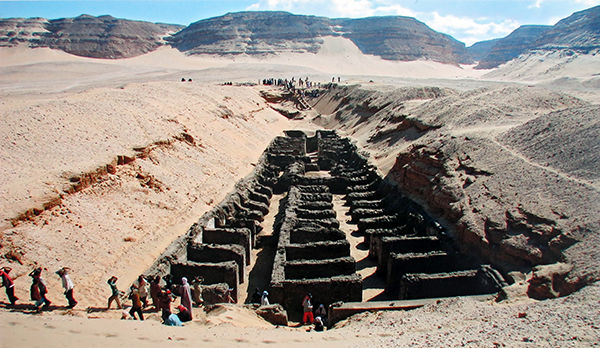
Khasekhemwy's enormous 59 room tomb at Abydos had a stone-lined burial chamber. Above it was once a solid rectangular structure called a mastaba, also faced with dressed stone.
Courtesy of the German Archaeological Institute, Cairo.
Photo: © Trustees of the British Museum, CC BY-NC-SA 4.0
Source: Poster, British Museum
Text: Poster at the British Museum, © Trustees of the British Museum, CC BY-NC-SA 4.0
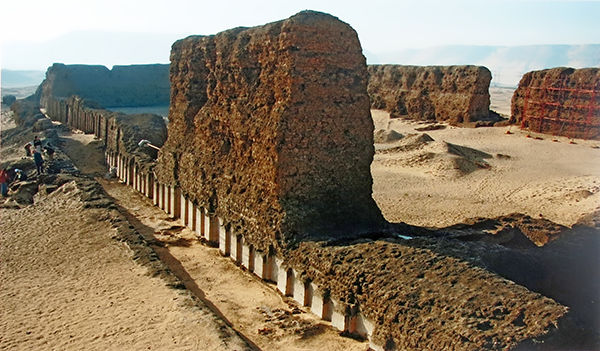
Khasekhemwy's massive valley temple at Abydos is nearly 134 metres long and 78 metres wide, covering the equivalent of one and a half football pitches. The niches on its walls copied palace architecture and symbolised royal power.
Photo: © Robert Fletcher for the Abydos Expedition of the Institute of Fine Arts, New York University
Source: Poster, British Museum
Text: Poster at the British Museum, Trustees of the British Museum, CC BY-NC-SA 4.0
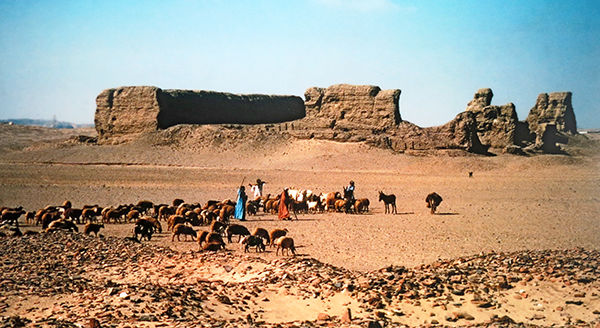
The ceremonial enclosure at Hierakonpolis has five-metre thick walls that are over nine metres high. Khasekhemwy may have staged ceremonies here celebrating the reunification of the country.
Courtesy of the Hierakonpolis Expedition.
Photo: © Trustees of the British Museum, CC BY-NC-SA 4.0
Source: Poster, British Museum
Text: Poster at the British Museum, © Trustees of the British Museum, CC BY-NC-SA 4.0
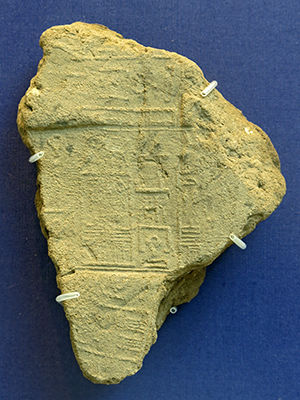
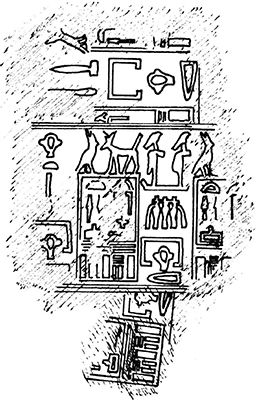
Second Dynasty: 2 890 BC - 2 670 BC
Jar sealing of Khasekhemwy
On this jar sealing, Khasekhemwy's name, meaning 'the two powers shine forth' is surmounted by both the falcon Horus and the god Seth, signifying a reunited Egypt. An additional epithet, reading 'the two lords are at peace with him' suggests that this union was achieved only through conflict.
Part of a jar-seal of grey clay, with an impressed inscription of the name of Khasekhem. This fragment is in good condition.
Length 100 mm, width 65 mm
Catalog: Abydos, Tomb of Khasekhemwy, Second Dynasty, EA35590
Photo (left): Don Hitchcock 2015
Photo (right): © Trustees of the British Museum, CC BY-NC-SA 4.0
Source: Original, British Museum
Text: Card at the British Museum, http://www.britishmuseum.org/, © Trustees of the British Museum, CC BY-NC-SA 4.0
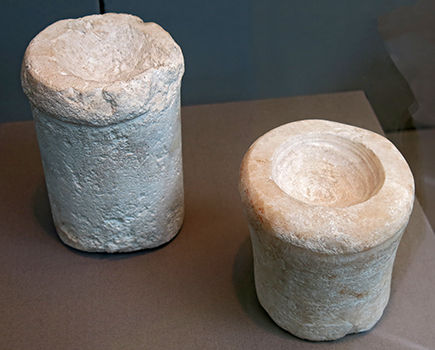
Second Dynasty: 2 890 BC - 2 670 BC
Model stone jars of Khasekhemwy
King Khasekhemwy was buried in an enormous tomb at Abydos. It had over 40 storage rooms filled with objects that were used in life and many that were only relevant after death, like these model stone jars. They were shaped and smoothed on the exterior, but only a shallow depression was hollowed out inside.
Abydos, Tomb of Khasekhemwy, Second Dynasty, EA35569, EA35570.
Photo: Don Hitchcock 2015
Source: Original, British Museum
Text: Card at the British Museum, http://www.britishmuseum.org/, © Trustees of the British Museum, CC BY-NC-SA 4.0
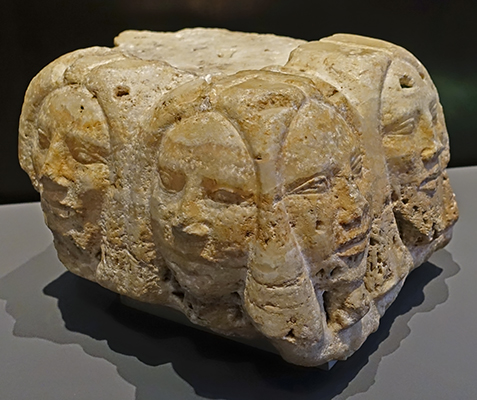
Second Dynasty: 2 890 BC - 2 670 BC
Heads of foreigners
Base of a royal statue with the heads of foreigners, circa 2 700 BC
( This may have symbolised the subjugation of foreigners by having the king standing on their heads - Don )
Catalog: Calcite, ÄS 6300
Photo: Don Hitchcock 2018
Source: Original, Ägyptischen Museum München
Text: Museum card, © Ägyptischen Museum München
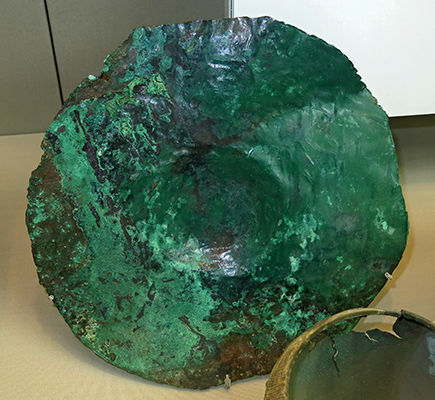
Second Dynasty: 2 890 BC - 2 670 BC
Model dish of copper
This dish was hammered from a thin sheet of copper. It is a model for use in the afterlife, but gives some idea of the type of luxurious metal vessels enjoyed by Khasekhemwy and his court. Metal working advanced considerably during this king's reign, and he is remembered for fashioning a copper statue of himself called 'High is Khasekhemwy'.
A model of a circular dish irregularly cut out from thin sheet copper, with a shallow depression in the middle. The shape of the vessel has been distorted by crushing and the metal is corroded.
Catalog: Abydos, Tomb of Khasekhemwy, Second Dynasty, EA35573
Photo: Don Hitchcock 2015
Source: Original, British Museum
Text: Card at the British Museum, http://www.britishmuseum.org/, © Trustees of the British Museum, CC BY-NC-SA 4.0
Second Dynasty: 2 890 BC - 2 670 BC
Model tools from Khasekhemwy's tomb
Model tools of thin copper were numerous in Khasekhemwy's tomb, perhaps reflecting his prolific building interests.
These examples came from a deposit of 194 models found below a collapsed wall. Tool types included axes, harpoons, chisels, adzes, needles and a knife. Most occur in multiples of eight, which may relate to the Egyptian working week of eight days.
Catalog: Abydos, Tomb of Khasekhemwy, Second Dynasty, EA35575 - EA35578, EA35580, EA35583, EA67571
Photo: Don Hitchcock 2018
Source: Original, British Museum
Text: Card at the British Museum, http://www.britishmuseum.org/, © Trustees of the British Museum, CC BY-NC-SA 4.0
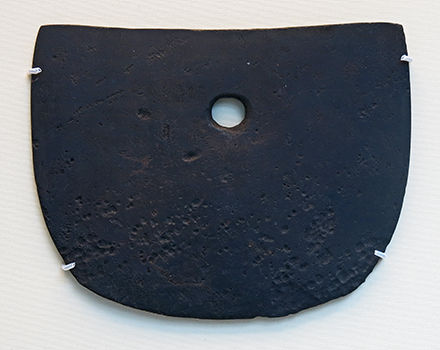
Second Dynasty: 2 890 BC - 2 670 BC
Arsenical Copper axe
Functional tools were also placed in Khasekhemwy's tomb. Among them were many axes with a hole near the centre. This innovation allowed the blade to be more securely tied onto the handle than previously possible. This system for attaching handles continued throughout the Old Kingdom. Axes were used in woodworking and were also the main hand weapons for soldiers.
Broad, squat axe-head with slightly concave butt and rounded sides converging to form a convex cutting end. In the centre near the butt is a large round hole, which was cast into the blade during the original manufacture. The cutting end, which was hammered to a sharp edge, is cracked on both faces and shows other signs of heavy wear. The axe was once covered by corrosion product but has now been completely cleaned. There is considerable surface pitting.
Length 102 mm, width 127 mm (butt), thickness 8 mm, weight 546 grams.
This axe-head belongs to a group of two full-size and 15 model axes discovered by Petrie in 1901 in the tomb of King Khasekhemwy at Abydos. The second functional specimen from the group is now in Chicago (0I, 6240) and the other models are widely distributed among various museums. A large quantity of the same type (18 full-size and at least 17 models) was previously (1896-7) found by Amelineau in the same tomb.
The earliest copper alloy of the Bronze Age is arsenical copper, a material relatively short-lived in the archaeological record when compared with the succeeding tin bronze, but of no little importance when tracing the stages and progress of prehistoric metal working. Like tin, arsenic functions as a mild deoxidant and confers the useful property of work-hardening upon the metal. Copper-arsenic alloys need to be strengthened by cold working, and it was probably this requirement as much as any other that would have led to their eventual disuse and replacement by cast tin bronzes. The normal source of arsenic for such alloys is generally agreed as a constituent of the copper ore actually smelted, usually the grey tetrahedrite tennantite mineral.
Catalog: Abydos, Tomb of Khasekhemwy, Second Dynasty, EA35574
Photo: Don Hitchcock 2015
Source: Original, British Museum
Text: Card at the British Museum, http://www.britishmuseum.org/, © Trustees of the British Museum, CC BY-NC-SA 4.0
Additional text: McKerrel and Tylecote (1972)
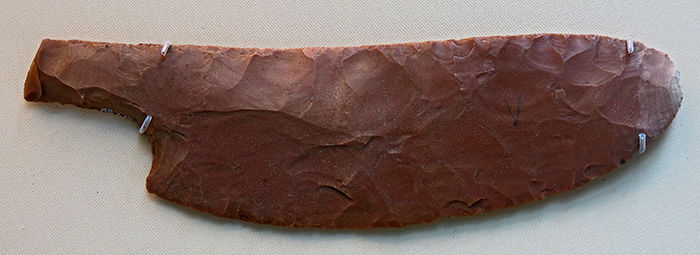
Second Dynasty: 2 890 BC - 2 670 BC
Flint knife
Tools of flint continued to be used for ritual and functional purposes, and many were found in Khasekhemwy's tomb. This knife was used for making ritual sacrifices. It was provided in the belief that the king would tend to the gods in the afterlife.
Complete bifacial knife of pale brown flint, with a rounded tip and projecting handle. The surfaces have been worked by pressure flaking and the edges have been sharpened. There is a small trace of white crust at the tip.
Catalog: Abydos, Tomb of Khasekhemwy, Second Dynasty, EA68775
Photo: Don Hitchcock 2015
Source: Original, British Museum
Text: Card at the British Museum, http://www.britishmuseum.org/, © Trustees of the British Museum, CC BY-NC-SA 4.0
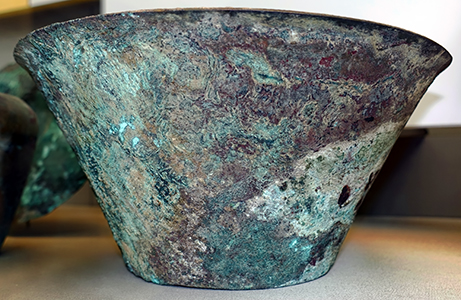
Second Dynasty: 2 890 BC - 2 670 BC
Bronze ewer and basin
This ewer and basin were used as a set in hand washing. Analysis shows they are made of bronze, an amalgam of tin and copper, and are the earliest examples of this alloy known from ancient Egypt.
Adding tin to copper made tools harder and kept them sharper, qualities that were important to Khasekhemwy during his building activities.
EA35571: A vase of copper and bronze with a flat base and convex sides, which turn inwards at the top. The spout is rounded and set at a lower angle into the body of the vessel. Traces of linen adhere to the corroded exterior surfaces. One side of the vase has been split by a combination of pressure and corrosion.
The analysis of the metal shows that the vase itself was made of a fine bronze alloy, certainly the earliest example of the use of bronze in Egypt known so far. The spout, however, consists of arsenical copper.
Height 114 mm, width 21 mm (spout), length 41 mm (spout), diameter 77 mm (base), diameter 102 mm (rim).
EA35572: A deep bowl with flaring sides and a flat base. The top of the rim has been hammered to a flat surface with a sharp outer edge. Remains of linen adhere to the corroded exterior and interior of the vessel. There is a vertical split in the metal running the full height of one side.
Height 116 mm, diameter 125 mm (base), 244 mm (rim).
Catalog: Abydos, Tomb of Khasekhemwy, Second Dynasty, EA35571, EA35572
Photo: Don Hitchcock 2015, 2018
Source: Original, British Museum
Text: Card at the British Museum, http://www.britishmuseum.org/, © Trustees of the British Museum, CC BY-NC-SA 4.0
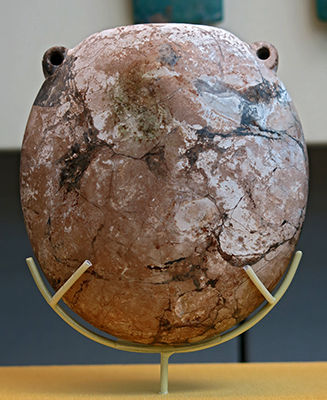
Second Dynasty: 2 890 BC - 2 670 BC
Ovoid stone jar
Ovoid vessels are rare and were difficult to make. The rim of this dolomite jar had been broken off before it was deposited in Khasekhemwy's tomb, showing it had value even in an imperfect state. It was found hidden beneath a fallen wall with the metal dishes above.
An oval flat-bodied vase with lug-handles set high on the shoulders. The rim has been broken away. Interior well hollowed.
Height 93 mm, width 84 mm.
Catalog: Abydos, Tomb of Khasekhemwy, Second Dynasty, EA35566
Photo: Don Hitchcock 2015
Source: Original, British Museum
Text: Card at the British Museum, http://www.britishmuseum.org/, © Trustees of the British Museum, CC BY-NC-SA 4.0
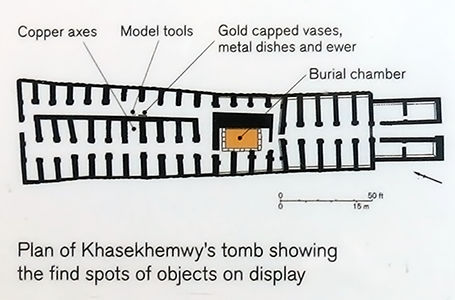
Plan of Khasekhemwy's tomb showing the find spots of objects on display.
Photo: © Trustees of the British Museum, CC BY-NC-SA 4.0
Source: Card, British Museum
Text: Card at the British Museum, http://www.britishmuseum.org/, © Trustees of the British Museum, CC BY-NC-SA 4.0
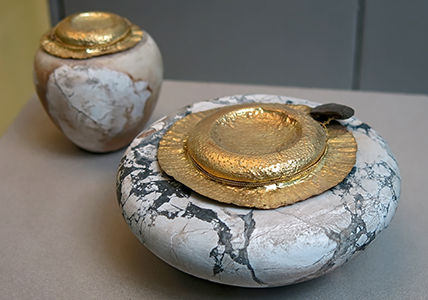
Second Dynasty: 2 890 BC - 2 670 BC
Stone vases with gold lids
These dolomite vases are two from a group of six that were found beneath a collapsed wall in Khasekhemwy's tomb. The same rubble concealed from robbers the model tools above and the metal dishes. All six of the dolomite vases had lids of sheet gold tied on with fine gold wire and secured with small clay seals. A punched design decorates the lids.
EA35567: Squat magnesite jar with flat base and raised external rim. The mouth is covered with a thin gold cap, secured by a fine gold wire. The wire encircles the rim twice and is fastened with a small clay seal. The gold cover is decorated with punch-marks, made from the underside, and with impressed radial lines around the edge.
Height 50 mm, diameter 47 mm (rim).
EA35568: Squat vase of the higher type, made of magnesite. The mouth is very narrow and it has a raised external rim. It is closed by a thin gold cover, secured by two turns of gold wire, twisted together at the ends. The cover is decorated with punch-marks, made from the underside. The base has been drilled right through to facilitate the hollowing of the interior, and would originally have been closed by a separate piece of stone, now missing.
Height 57 mm, diameter 22 mm (base), 31 mm (rim).
Catalog: Abydos, Tomb of Khasekhemwy, Second Dynaasty, EA35567, EA35568
Photo: Don Hitchcock 2015
Source: Original, British Museum
Text: Card at the British Museum, http://www.britishmuseum.org/, © Trustees of the British Museum, CC BY-NC-SA 4.0
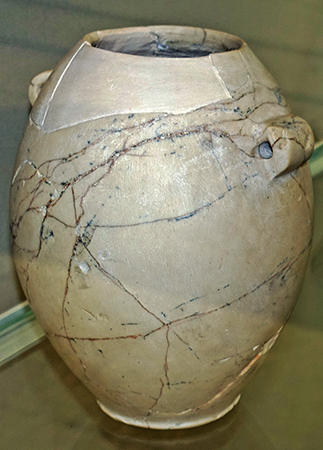
Second - Third Dynasty: 2 890 BC - 2 613 BC
Vase
Barrel-shaped white dolomite vase with fine veining in black and grey. The mouth has been finished so as to receive a separately made rim, which is not present. There are two horizontally pierced tubular handles on the sides. The interior is well hollowed and the outer surface is very smoothly finished.
Height 150 - 155 mm (slightly irregular), diameter 57 mm (base and rim.
This vessel was clearly produced with exceptional care, and possibly to a specific scale of proportions. The ratio of the rim and base diameter to the maximum diameter is 1:2 and it is worth noting that the dimensions convert well into Egyptian measurements.
We can note that one digit/finger/fingerbreadth of 1 ḏb measures 18.75 mm, often rounded to 19 mm.
The rim and base diameters give 3 ḏb‘ of 19 mm for the measured 57 mm, the maximum diameter (112 mm) gives 6 ḏb‘ of 18.66 mm, and the height is 8 ḏb‘ of around 19 mm. Had the rim been present, the total height may have been 9 ḏb‘ to make the proportions of rim diameter: maximum diameter: height = 1:2:3. Whether these figures are mere coincidence would be difficult to establish.
Egyptian dolomite is a fine grained white stone with thin dark veins. Dolomite was a popular material only during the first two dynasties. The location of the ancient quarry site in the Eastern Desert remains uncertain. The rim of the tall jar was added separately, a common practice at this time.
Catalog: EA36350
Photo: Don Hitchcock 2018
Source: Original, British Museum
Text: Card at the British Museum, http://www.britishmuseum.org/, © Trustees of the British Museum, CC BY-NC-SA 4.0
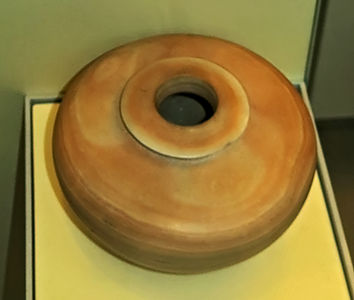
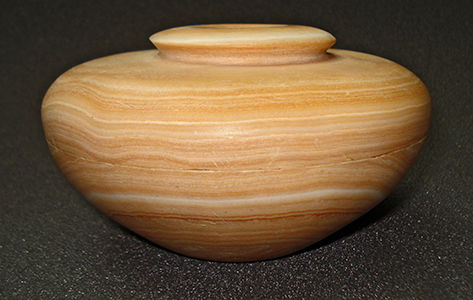
Second - Third Dynasty: 2 890 BC - 2 613 BC
Sawn Jars
To hollow out jars with small mouths and wide shoulders it was easier to make them in two parts. After initial shaping, the stone was sawn in half and then drilled. The two pieces were later glued together.
Squat calcite jar with a flat base and sharp-edged external rim. The vessel has been made in two sections, the division running horizontally just below the level of the shoulder.
Height 71 mm, diameter 60 mm (rim), 48 mm (base).
Catalog: Second - Third Dynasty, EA36353
Photo (left): Don Hitchcock 2015
Photo (right): © Trustees of the British Museum, CC BY-NC-SA 4.0
Source: Original, British Museum
Text: Card at the British Museum, http://www.britishmuseum.org/, © Trustees of the British Museum, CC BY-NC-SA 4.0
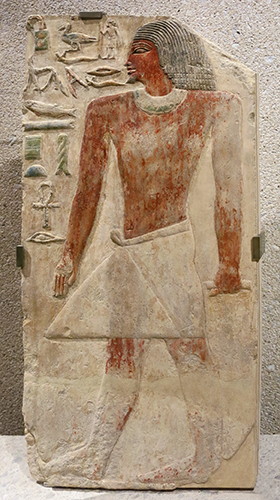
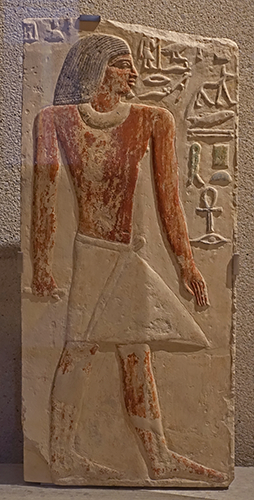
Old Kingdom, 2 700 - 2 170 BC
Ankhirptah
Tomb relief depicting the scribe and judge Ankhirptah.
Catalog: Painted limestone, ÄM 7336, ÄM 7337
Photo: Don Hitchcock 2015, 2018
Source: Original, Staatliche Museen zu Berlin, Neues Museum, Germany
Text: © Card at the Staatliche Museen zu Berlin, (CC BY-NC-SA 3.0 DE)
The Third Dynasty
2 670 BC - 2 613 BC
The Third Dynasty is the first dynasty of the Old Kingdom. The capital city during the period of the Old Kingdom was at Memphis.
| Third Dynasty | Name | Personal Name | Consort | Burial | Years | Dates | Comment |
|---|---|---|---|---|---|---|
| Netjerikhet | Djoser | Hetephernebti | Saqqara | 19 | 2 670 BC - 2 651 BC | Known for his step pyramid, the earliest collosal stone building in ancient Egypt. |
| Sekhemkhet | Djoserty | Djeseretnebti | Saqqara: Buried Pyramid | 6 | 2 651 BC - 2 645 BC | Erected a step pyramid at Saqqara and left behind a well known rock inscription at Wadi Maghareh (Sinai Peninsula). |
| Sanakht / Zanakht | Nebka | Abydos? | 9 | 2 645 BC - 2 636 BC | The presence of reliefs depicting Sanakht in the Sinai at Wadi Maghareh together with those of Djoser and Sekhemkhet suggest an important Egyptian presence there at the time of the Third Dynasty. Expeditions were launched to that location for the procurement of mineral resources, in particular turquoise. | |
| Khaba | Teti | Zawyet el'Aryan: Layer Pyramid | 6 | 2 636 BC - 2 630 BC | Khaba's name appears on nine polished stone bowls, variously made of magnesite, travertine, and diorite, which were found at the archaeological locales of Zawyet el'Aryan, Abusir, and Naga-ed-Deir. The bowls were found mostly intact; they show only the king's serekh name on their polished surfaces. | |
| Qahedjet? | Huni | Djefatnebti - Meresankh I | Meidum | 17 | 2 630 BC - 2 613 BC | The stela of king Qahedjet shows king Qahedjet embracing an anthropomorphic form of the god Horus. King Qahedjet wears the White crown of Upper Egypt and an artificial king's beard, and looks directly into Horus' eyes, both figures being the same height. His face looks remarkable with his crooked nose, the bulging lips and his square chin. The king wears a kilt with a dagger in a belt. In his left hand, he holds a mace while in his right hand he holds a staff with a wing-like mark at middle height. The hieroglyphic inscription describes the king's visit to the northern shrine of the god Ra at Heliopolis. |
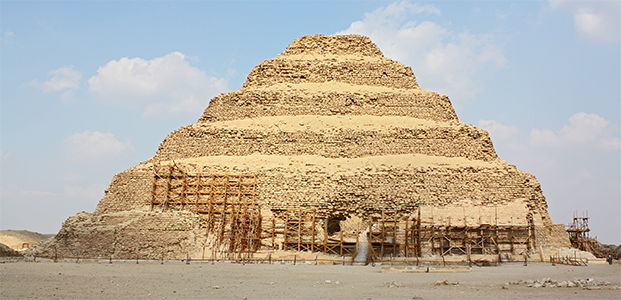
Third Dynasty: 2 670 BC - 2 613 BC
The Step Pyramid of Djoser in Saqqara, Egypt.
This first Egyptian pyramid consisted of six mastabas (of decreasing size) built one on top of the another with what were clearly revisions and developments of the original plan. The pyramid originally stood 62 metres (203 ft) tall, with a base of 109 m × 125 m (358 ft × 410 ft) and was clad in polished white limestone. This step pyramid (or proto-pyramid) is considered to be the earliest large-scale cut stone construction.
Photo: Wknight94
Permission: This file is licensed under the Creative Commons Attribution-Share Alike 3.0 Unported license.
Catalog: Abydos, Step Pyramid of Djoser, Third Dynasty, EA2440, EA66826-EA66832
Photo: Don Hitchcock 2015
Source: Original, British Museum
Text: Card at the British Museum, http://www.britishmuseum.org/, © Trustees of the British Museum, CC BY-NC-SA 4.0
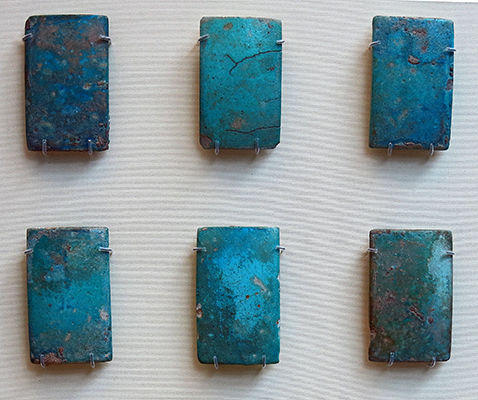
Third Dynasty: 2 670 BC - 2 613 BC
Faience tiles from the Step Pyramid
Khasekhemwy's successor, and probably step-son, was King Djoser, founder of the Third Dynasty. Benefiting from Khasekhemwy's advances in metallurgy and stone working, and the lessons learned in managing vast building projects, Djoser went on to build Egypt's first pyramid - the Step Pyramid at Saqqara. These tiles are from the underground corridors beneath that pyramid, where they were arranged on the walls to imitate matting.
Catalog: Abydos, Step Pyramid of Djoser, Third Dynasty, EA2440, EA66826-EA66832
Photo: Don Hitchcock 2015
Source: Original, British Museum
Text: Card at the British Museum, http://www.britishmuseum.org/, © Trustees of the British Museum, CC BY-NC-SA 4.0
Third Dynasty: 2 670 BC - 2 613 BC
Wall tiles
Four wall tiles of faience, from the step pyramid of Djoser complex, circa 2 500 BC
Inv. no. 1933.32a-d
Photo: Don Hitchcock 2018
Source and text: Original, Museum August Kestner, Hannover
Technology and innovationText above: Poster at the British Museum, © Trustees of the British Museum, CC BY-NC-SA 4.0
Predynastic - Third Dynasty
Technology played a key role in the development of Egyptian culture. From Early Predynastic times, artisans used hard stones to produce prestigious objects. Later advances in metallurgy turned stone vessel making into a major industry, supported by early kings. The techniques required were continually refined, and influenced the evolution of Egyptian architecture and statuary.
Third Dynasty: 2 670 BC - 2 613 BC
Statue of Ankhwa
The skills and status of early Egyptian artisan are epitomised in this statue of the shipwright and metal worker, Ankhwa. He proudly holds a copper adze, which was both a symbol and a product of his professions.
One of the earliest statues of a private person, this red granite sculpture is the result of progressive innovations in stone and metal working within the royal workshops. This gift from the king assured Ankhwa's immortality, since both the statue and its inscription could serve as homes for his spirit, should his body be lost.
A red granite statue of an official, shown seated upon a cubical stool with hollowed sides and back. He holds an adze in the left hand; the right hand rests, palm downwards, on the lap. The figure wears a short kilt and a full wig, upon which the details of the curls are indicated. The face is full and heavy, but skilfully carved.
The broad mouth, with its rounded corners, dominates the frontal view of the face. The crisp carving of the lips contrasts with the modelling of the eyes, which lack any indication of the lower lids. On the kilt above the left knee is a vertical line of inscription in low relief.
The striations of Ankhwa's flaring coiffure undulate near the crown of his head; two ridges at the lower ends suggest crimping. The boat-hieroglyph has an animal head at the prow, possibly that of a bull.
Height 655 mm, length 390 mm (base), width 295 mm (base), height 134 mm (Top of head to base of wig (front)), height 150 mm (top of head to base of wig (back))
Catalog: Probably Saqqara, Third Dynasty, EA171
Photo: Don Hitchcock 2015, 2018
Source: Original, British Museum
Text: Card at the British Museum, http://www.britishmuseum.org/, © Trustees of the British Museum, CC BY-NC-SA 4.0
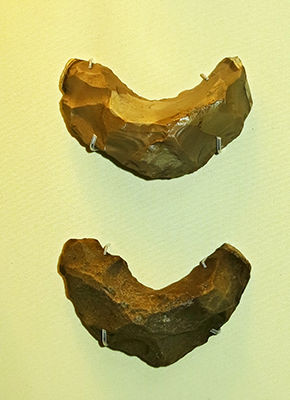
Third Dynasty: 2 670 BC - 2 613 BC
Flint scrapers
To widen the interior space when making stone vessels, stone drill bits were attached to the drill. Rotary action with crescent drills of flint was used to hollow out soft stones like travertine (calcite).
(above) EA67626: Flint scraper, hollow, crescent-shaped, worked both sides.
Width 90 mm, length 52 mm.
(below) EA67627: Flint scraper, hollow and crescent-shaped, worked both sides.
Width: 90 mm length 55 mm
Catalog: Third Dynasty, Beit Khallaf, Tomb of Netjerkhet, EA67626, EA67627
Photo: Don Hitchcock 2015
Source: Original, British Museum
Text: Card at the British Museum, http://www.britishmuseum.org/, © Trustees of the British Museum, CC BY-NC-SA 4.0
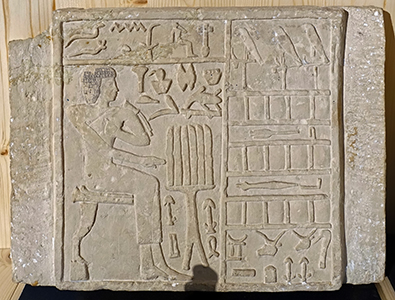
Third Dynasty: 2 670 BC - 2 613 BC
Sacrificial table
Fragment of a false door with the expedition commander Jefanesut at a sacrificial table (with offerings), circa 2550 BC.
Jefanesut sits behind a sacrificial table and reaches for the pieces of bread lying on it.
The inscription identifies him as being 'supplied with 1000 poultry and beef dishes, 1000 linen garments and 1000 alabaster vessels, as well as bread, cake, water and wine'.
Catalog: Limestone
Photo: Don Hitchcock 2018
Source and text: Original, Museum August Kestner, Hannover
Third Dynasty: 2 670 BC - 2 613 BC
Scribal equipment
This rectangular greywacke inkwell has the two depressions for holding the black and the red ink used in writing. It is pierced at one end for a strap, allowing it to be hung or carried.
The bowl held water for mixing with the ink pigments until the right consistency for writing with a reed pen was achieved.
Dimensions: Bowl: diameter 55 mm, height 25 mm.
Dimensions: Palette: height 17mm, length 106 mm, width 57 mm.
Catalog: Greywacke, EA32247a, EA32247b
Photo: Don Hitchcock 2018
Source: Original, British Museum
Text: Card at the British Museum, http://www.britishmuseum.org/, © Trustees of the British Museum, CC BY-NC-SA 4.0
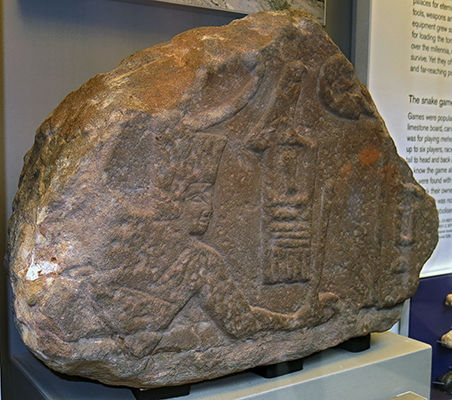
Third Dynasty: 2 670 BC - 2 613 BC
Rock inscription of King Sanakht
This relief was originally carved into the cliffs at Wadi Magyar in Sinai.
It commemorates an expedition to the turquoise mines there by King Zanakht of the Third Dynasty. Emulating his royal ancestor Den, Zanakht smites an eastern tribesman, preserved here only by the lock of hair in the kings hand. To the right, hieroglyphs spell out one of the earliest examples of the word for turquoise, mefkat.
Catalog: Sinai, Wadi Maghara, Third Dynasty, circa 2 650 BC, EA691
Photo: Don Hitchcock 2015
Source: Original, British Museum
Text: Card at the British Museum, http://www.britishmuseum.org/, © Trustees of the British Museum, CC BY-NC-SA 4.0
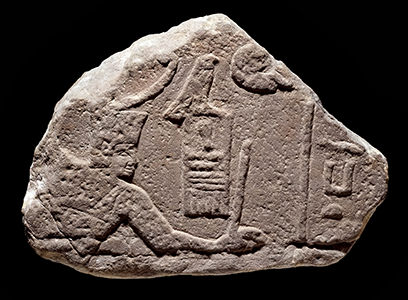
Third Dynasty: 2 670 - 2 613 BC
Rock inscription of King Sanakht
Pink sandstone stele of Zanakht. King Zanakht is smiting a foreigner (no longer visible) who personified the tribes of the Eastern Desert. The sovereign, whose name is inscribed in a serekh surmounted by the falcon god Horus, is wearing the red crown, symbol of his power over Lower Egypt. In front of him on a pole was the emblem of the god Wepwawet, now lost. The few hieroglyphs surviving in the right corner of the fragment signify 'turquoise', a highly prized stone, which the Egyptians went to the mountains of the Sinai peninsula to extract.
Length 350 mm, width 47 mm, depth 210 mm, weight 75 kg.
Cut in low relief. This relief, a large stele, was executed in the cliff itself under difficult conditions, and exposed to the elements for more than four millennia. It does not display the same sculptural qualities as reliefs almost as old from Saqqara or Heliopolis. It belongs to a series of inscriptions with the names of kings Djoser, Sekhemkhet, and Sanakht that commemorate the first expeditions launched by the pharaohs to the so-called turquoise terraces. Distinguished from non royal inscriptions by their bellicose iconography, they magically mark the limits of the pharaoh's domain and immortalise his appropriation of the world. A text from the time of Djedkare-Isesi, a Fifth Dynasty pharaoh, reveals that royal troops also came to Wadi Magyar to seek another very precious resource, copper.
Catalog: Sinai, Wadi Maghara, Third Dynasty, circa 2 650 BC, EA691
Photo: © Trustees of the British Museum, CC BY-NC-SA 4.0
Source: Original, British Museum
Text: Card at the British Museum, http://www.britishmuseum.org/, © Trustees of the British Museum, CC BY-NC-SA 4.0
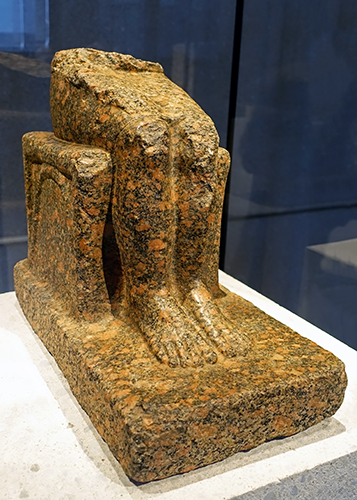
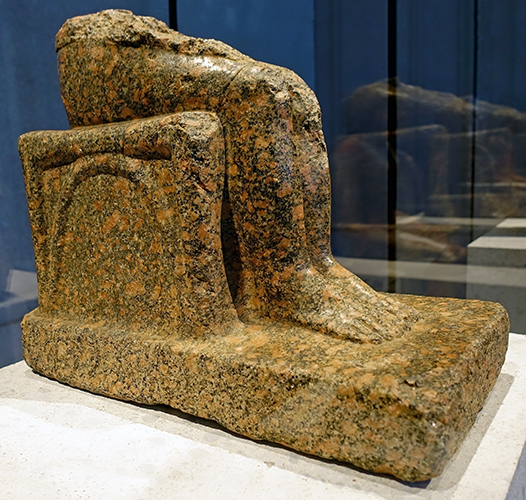
Third Dynasty: 2 670 - 2 613 BC
Aa-akhti / Akhetaa
Seated figure of the high-ranking official Aa-akhti, circa 2 600 BC.
Akhetaa (also written Achtiaa and Aa-Akhti) was an Ancient Egyptian high official during the mid to late 3rd dynasty (Old Kingdom period). He is mostly known for his tomb inscriptions, which refer to various seldom used titles as well as to the shadowy king Nebka, in whose cult Akhetaa served.
Akhetaa was married to the confidant of the king, Meretenes. This lady is possibly the first of the Old Kingdom who was honoured with the female version of the aristocratic title 'confidant of the king'.
Akhetaa's tomb inscription is of the highest interest to Egyptologists and historians alike. It provides unique titles such as 'Director of the twin basins of the royal house' and rare titles such as 'Promoter of Kenmut'. The first one is disputed, because scholars do not know if the designation 'twin basin' has to be taken verbatim or if it points to sacred lakes representing Lower and Upper Egypt. The other title, 'Promoter of Kenmut', points to a priestly role as the bearer of the king's sacred panther fur. In later times, from the 5th dynasty onward, a deity named Kenmut is known and can be found depicted in the solar sanctuary of pharaoh Pepi I. However it remains uncertain whether this god is identical to the 'Kenmut' mentioned in Akhetaa's tomb inscription.
Another subject of interest is Akhetaa's title 'God's servant in the temple of king Nebka'. Nebka's name appears in a royal cartouche, a practice that is otherwise only known from the reign of king Huni onwards. Thus, it is possible that Akhetaa worked under this king or slightly earlier. It is unclear whether Akhetaa served a priestly role in the cult of a living king or in a funerary cult, a precision that would determine Nebka's uncertain chronology as an early or late third Dynasty king. Unfortunately, Akhetaa's inscriptions mention no further kings. However, only a part of the whole tomb reliefs is preserved today, which leaves the possibility open that indeed other kings were once mentioned.
Possible contemporary office partners included Netjeraperef, Hesyre, Khabawsokar, Pehernefer and Metjen, who were also holding office under Huni and Sneferu. All their tomb inscriptions reveal that the time of both kings must have been a very prosperous one and the economy and office administration flourished.
The exact geographical location of Akhetaa's mastaba tomb is unknown. It is believed, however, that it was once located at Abusir, as some relief blocks were found re-used in the town. The current status of the tomb is labelled as 'missing'.
Catalog: Pink granite, Saqqara, ÄM 14277
Photo: Don Hitchcock 2018
Source: Original, Staatliche Museen zu Berlin, Neues Museum, Germany
Text: © Card at the Staatliche Museen zu Berlin (CC BY-NC-SA 3.0 DE)
Additional text: Wikipedia
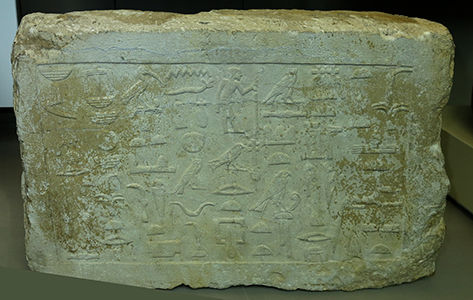
Third - Fourth Dynasty: 2 670 - 2 494 BC
Limestone panel of Hezi
The ancient Egyptians fully recognised the beauty of their writing system. On this panel from a tomb, each hieroglyph is a work of art in its own right. The signs are arranged in eight columns, giving a funerary offering formula for a man called Hezi. By writing his name, the ancient Egyptians believed Hezi's immortality was secured, while the offering formula insured his provisions for eternity.
This is a rectangular slab of limestone bearing a standard offering-text for Ḥezi, arranged in eight vertical columns. The signs are cut in low relief with a considerable amount of detail. No colour survives.
Length 445 mm, width 280 mm, thickness 75 mm.
Catalog: Probably Saqqara, Third - Fourth Dynasty, EA1212
Photo: Don Hitchcock 2015
Source: Original, British Museum
Text: Card at the British Museum, http://www.britishmuseum.org/, © Trustees of the British Museum, CC BY-NC-SA 4.0
Old Kingdom, Third - Sixth Dynasty: 2 670 - 2 181 BC
Double godet
Double godet to hold two colours of ink.
Length 151 mm, width 91 mm.
Perforated diagonally in the thickness of one of the two short sides.
Catalog: Greywacke, E 932, N 3037, AF 482
Location: Sully, Salle 335, Writing and the scribes, Vitrine 2
Photo: Don Hitchcock 2015
Source and text: Original, Louvre Museum, https://collections.louvre.fr/
Third - Thirteenth Dynasty: 2 670 - 1 639 BC
Combs and hairpins
Catalog: Ivory, wood, bone, Abydos, ÄM 18060, ÄM 26399, ÄM 27874, Z 4115, Z 4117, Z 4118, Z 4119
Photo: Don Hitchcock 2018
Source: Display, Staatliche Museen zu Berlin, Neues Museum, Germany
Text: © Card at the Staatliche Museen zu Berlin (CC BY-NC-SA 3.0 DE)
The Fourth Dynasty
2 613 BC - 2 494 BC
The Fourth Dynasty is the second dynasty of the Old Kingdom. The capital city during the period of the Old Kingdom was at Memphis.
The Fourth Dynasty heralded the height of the pyramid-building age. The relative peace of the Third Dynasty allowed the Fourth Dynasty rulers the leisure to explore more artistic and cultural pursuits. Sneferu's building experiments led to the evolution from the mastaba styled step pyramids to the smooth sided 'true' pyramids, such as those on the Giza plateau. No other period in Egypt’s history equaled the Fourth Dynasty's architectural accomplishments. Most of the rulers of this dynasty commissioned at least one pyramid to serve as a tomb or cenotaph.
The pharaohs of the Fourth Dynasty ruled for approximately 120 years, from 2 613 BC to 2 494 BC. The names in the table are taken from Dodson and Hilton (2004).
| Fourth Dynasty | ||||||
|---|---|---|---|---|---|---|
| Name | Personal Name | Consort | Pyramid | Years | Dates | Comment |
| Sneferu / Snofru | Hetepheres I | Red Pyramid | 24 | 2 613 BC - 2 589 BC | Sneferu built the Bent, Red and Meidum Pyramids and introduced major innovations in the design and construction of pyramids, which led to the building of the Khufu Great Pyramid, one of the seven wonders of the ancient world. | |
| Khufu (Cheops) | Medjedu | Meritites I, Henutsen | Great Pyramid of Giza | 23 | 2 589 BC - 2 566 BC | Khufu commissioned the Great Pyramid of Giza. Everything known about Khufu comes from inscriptions in his necropolis at Giza, and later documents. Son or stepson of Sneferu. |
| Djedefre | Kheper | Hetepheres II, Khenetka | Pyramid of Djedefre | 8 | 2 566 BC - 2 558 BC | Djedefre was the son and immediate throne successor of Khufu |
| Khafra / Khafre / Khephren | Userib | Meresankh III, Khamerernebty, Hekenuhedjet, Persenet |
Pyramid of Khafre | 26 | 2 558 BC - 2 532 BC | Khafre was the builder of the second largest pyramid of Giza, and the Great Sphinx was completed for him circa 2 500 BC, some years after his death. |
| Baka | 1 | 2 532 BC | Baka was a prince and son of pharaoh Djedefre. He lived during the 4th Dynasty. His family life is unknown, the names of his wives and children are lost. If he was Pharaoh, it was for a very short time indeed. | |||
| Menkaure | Kakhet | Khamerernebty II | Pyramid of Menkaure | 29 | 2 532 BC - 2 503 BC | Menkaure became famous for his tomb, the Pyramid of Menkaure, at Giza, and his statue triads, showing the king together with his wives Rekhetre and Khamerernebty and with various deities. |
| Shepseskaf | Shepseskhet | Bunefer | Mastabet el-Fara'un | 4 | 2 503 BC - 2 499 BC | The only activities firmly datable to Shepseskaf's reign are the completion of the temple complex of the Pyramid of Menkaure and the construction of his own mastaba tomb at South Saqqara, the Mastabat al-Fir’aun, 'stone bench of the pharaoh'. |
| Djedefptah / Thamphthis | 5 | 2 499 BC - 2 494 BC | Thamphthis is one of the shadowy rulers of the Old Kingdom, since he is completely unattested in contemporary sources. Thamphthis' name was however found in the historical works of Manetho, the 'Aegyptiacae', which is an important reference work for the rulers of Egypt. | |||
Fourth Dynasty: 2 613 BC - 2 494 BC
Sneferu
Sneferu, or Seneferu, was the first monarch of the fourth dynasty. Sneferu — called by Manetho, Soris — has left us a representation of himself, and an inscription. On the rocks of Wady Magharah, in the Sinaitic peninsula, may be seen an incised tablet representing the monarch in the act of smiting an enemy, whom he holds by the hair of his head, with a mace. The action is apparently emblematic, for at the side we see the words Ta satu, 'Smiter of the nations', and it is a fair explanation of the tablet, that its intention was to signify that the Pharaoh in question had reduced to subjection the tribes which in his time inhabited the Sinaitic regions.
The motive of the attack was not mere lust of conquest, but rather the desire of gain. The Wady Magharah contained mines of copper and of turquoise, which the Egyptians desired to work; and for this purpose it was necessary to hold the country by a set of military posts, in order that the miners might pursue their labours without molestation. Some ruins of the fortifications are still to be seen; and the mines themselves, now exhausted, pierce the sides of the rocks, and bear in many places traces of hieroglyphical inscriptions The remains of temples show that the expatriated colonists were not left without the consolations of religion, while a deep well indicates the care that was taken to supply their temporal needs. Thousands of stone arrow-heads give evidence of the presence of a strong garrison, and make us acquainted with the weapon which they found most effectual against their enemies.
Photo and text: Adapted from Rawlinson (1886)
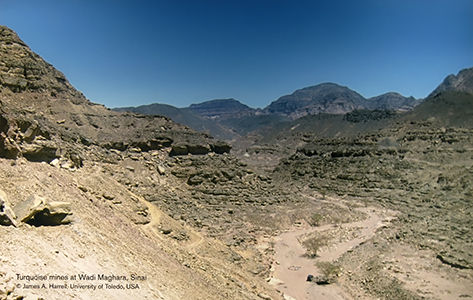
Turquoise mines at Wadi Maghara in Sinai.
Photo: © James A. Harrell, University of Toledo, USA
Source: Poster, British Museum
Text: Card at the British Museum, http://www.britishmuseum.org/, © Trustees of the British Museum, CC BY-NC-SA 4.0
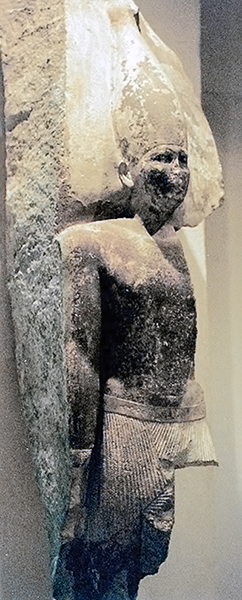
Fourth Dynasty: 2 613 BC - 2 494 BC
Sneferu
Statue of King Sneferu
King Sneferu wears the White Crown of Upper Egypt (Hedjet). He wears a short kilt, which is carved in detail and tied by a belt. The king’s cartouche can be seen at the centre of the belt, along with the title King of Upper and Lower Egypt. He is striding forwards, but his entire left side is missing.
Photo: Snofru
Permission: Creative Commons Attribution-Share Alike 3.0 Unported license.
Text: Adapted from Facebook.
Catalog: Limestone, Dahshur, Egyptian Museum, Cairo, JE 98943
This period was marked by profound economic and social transformations. This is shown by an inscription from the tomb of the great magnate Metjen. It contains information about Metjen's career as an official and his social standing, and also about his property holdings - fields, gardens, vineyards, and fig groves. He inherited part of his property from his father and purchased another part. Ultimately he owned some sixty hectares of land. At the beginning of the Egyptian state the pharaoh was still the sole legal owner of everything - land, stone quarries, water, livestock, and, when he needed it, human labour. The inscriptions from Metjen's tomb show that as early as the end of the Third Dynasty, even a man who was not descended from the royal family could own property, including agricultural land.Text above: Verner (2014)
Fourth Dynasty: 2 613 BC - 2 494 BC
Bent Pyramid
The Bent Pyramid is an ancient Egyptian pyramid located at the royal necropolis of Dahshur, approximately 40 kilometres south of Cairo, built under the Old Kingdom Pharaoh Sneferu. A unique example of early pyramid development in Egypt, this was the second pyramid built by Sneferu.
The Bent Pyramid rises from the desert at a 54-degree inclination, but the top section (above 47 metres) is built at the shallower angle of 43 degrees, lending the pyramid a visibly 'bent' appearance.
It has been suggested that due to the steepness of the original angle of inclination the structure may have begun to show signs of instability during construction, forcing the builders to adopt a shallower angle to avert the structure's collapse. This theory appears to be borne out by the fact that the adjacent Red Pyramid, built immediately afterwards by the same pharaoh, was constructed at an angle of 43 degrees from its base.
Photo: lienyuan lee
Permission: Creative Commons Attribution 3.0 Unported license
Text: Wikipedia
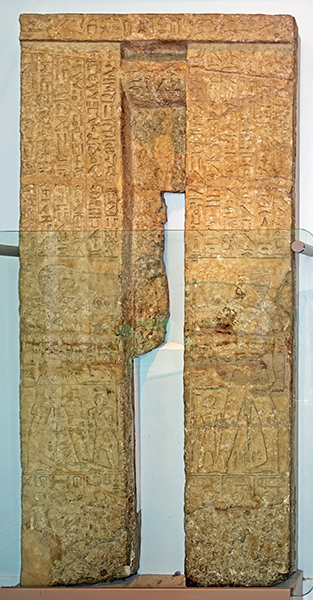
Fourth Dynasty: 2 613 BC - 2 494 BC
False Door of Kanever
This false door, reign of Sneferu, 2 613 - 2 589 BC, adorned the facade of Kanefer’s tomb, allowing his spirit free passage. He is portrayed on both jambs and identified as the eldest son of King Sneferu. Kanefer was a vizier, the king’s chief minister, and he oversaw the construction of his father’s final pyramid. As he was also high priest of the sun god Ra, he wears a priestly leopard skin.
Near the pyramid lies Kanefer’s mastaba tomb, with a bench shaped superstructure. As he died before its completion, the false door was supplied by his son Kawab, shown smaller on both jambs.
Kawab clasps his father’s staff to suggest that he too reached high office. He is probably the vizier Kawab of Sneferu’s successor King Khufu.
Stela of Kainefer - the figures and texts on the stela are finely carved, the figures being in low relief and the texts in sunk relief, apart from those accompanying the figures of Kaiwareb. The texts it bears commemorate the Prince, Kainefer, son of King Snofru, and they are mostly concerned with his titles and dignities. The lintel and drum carry short texts with brief titles, and the full list of Kainefer's honours is reserved for the upper parts of the two panels on either side of the false doorway; each panel has six lines of text.
The lower parts of these panels are divided into two registers. Contrary to the regular practice, there are no representations of Kainefer himself; on both sides there are large figures of his eldest son Kaiwareb, dressed in official uniform and carrying a sceptre and a staff. On the left Kaiwareb is shown accompanied by 'his son' (i.e. probably Kainefer's son), Kainefer; on the right he is accompanied by Ptḥ-špsi, who is not named as a son. The bottom register on each side is occupied by three figures of men, all possibly sons or other relatives of Kainefer, and all presumably bearing offerings (although this is now certain in only one case): on the left, Kaiwareb, 'Iṯỉ and lỉwỉ; on the right Dwʒ.t(w)-Snfrw, Ḫ‘.f-Snfrw and Bʒ.f-Snfrw.
The surface is much weathered and further deterioration has more recently occurred through the action of salt. The stela was cut into several pieces for ease of transport and considerable portions have been lost at the cuts, especially in the centre, where, happily, no text or representation has perished. No colour remains.
Height 2643 mm, width 1220 mm.
Much of Egypt’s monumental art was for elite tombs and centred on the afterlife and funerary rituals. Kawab recurs at the bottom of the jamb, leading a mortuary priest and priestess. These last were also identified by name and were contracted by Kawab to make regular offerings to his father’s spirit, in front of this door. They hold a goose and flower respectively.
Catalog:Limestone, Dahshur (Memphis), Tomb of Kainefer / Kanefer, EA1324
Photo: Don Hitchcock 2018
Source: Original, British Museum
Text: Card at museum display, http://www.britishmuseum.org/, © Trustees of the British Museum, CC BY-NC-SA 4.0
Model of a Pyramid
The Age of the Pyramids: 2 670 BC - 2 181 BC
The Age of the Pyramids is marked by the undisputed role of the Pharaoh. The entire administrative and economic organisation was subordinate to his central authority.
As a result of the uniform steering and control of their society, the rural communities were turned into domains. Craft and agricultural production were connected to the latter, to the temples, and, particularly, to the palace. Communal work was reinforced and concentrated on the erection of increasingly monumental royal burial sites, together with the associated mortuary cult, from the 3rd Dynasty (2 670 BC - 2 216 BC).
A multi-tiered bureaucracy was introduced in order to master the pending tasks.
The cult of the sun god Ra gradually moved into the foreground from the middle of the 4th Dynasty (2 613 BC - 2 494 BC).
The development found its climax in the erection of the sun temples during the 5th Dynasty (2 494 BC - 2 345 BC).
Central power dissolved with the end of the 6th Dynasty (2 345 BC - 2 181 BC), leading to the so-called First Intermediate Period (2 181 BC - 2 160 BC) which is marked by the presence of numerous autonomous administrative areas.
Qakare Ibi built one of the last classical pyramids, though small, and now mostly destroyed, in 2 169 BC - 2 168 BC, and the very last was the Pyramid of Ahmose, built not as a tomb but as a cenotaph for the Pharaoh Ahmose I (who reigned during the period 1 549 BC - 1 524 BC) at Abydos. There were no burial chambers, it was poorly made, and it is now only a pile of rubble about 10 metres high.
Photo: Don Hitchcock 2015
Source: Display, Staatliche Museen zu Berlin, Neues Museum, Germany
Text: © Card at the Staatliche Museen zu Berlin (CC BY-NC-SA 3.0 DE)
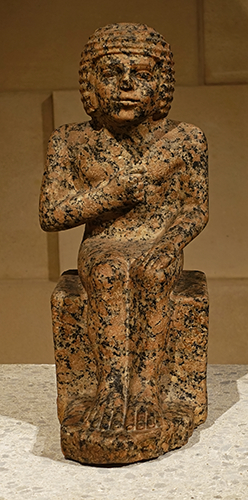
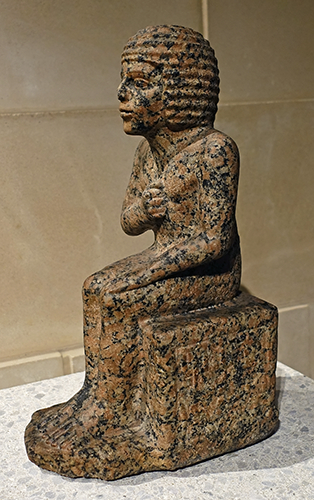
Fourth Dynasty: 2 613 BC - 2 494 BC
Statue of Methen / Metjen
This portrait of Metjen, 470 mm high, in pink granite, was found by Karl Richard Lepsius in his tomb in Saqqara and brought to Berlin in 1845. It had been placed in a small, inaccessible room, the so-called Serdab, next to the cult chamber and connected to it only by a slit in the masonry. Thus, according to ancient Egyptian ideas, Metjen was involved in the sacrifices. The Serdab of Metjen was to the north of the cult chamber or chapel.
The figure was created around the turn of the 3rd to 4th dynasties. At that time, Metjen under King Snofru was a senior administrator (domain administrator). Metjen sits on a cubic seat. He wears a short wig and a kilt. Further iconographic details are missing. On the sides of the seat stands its name and its title.
Catalog: Abusir, Metjen ÄM 1106
Photo: Don Hitchcock 2018
Source: Original, Staatliche Museen zu Berlin, Neues Museum, Germany
Text: © Card at the Staatliche Museen zu Berlin, http://www.smb-digital.de/, (CC BY-NC-SA 3.0 DE)
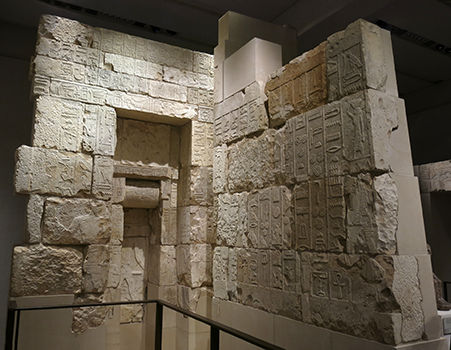
Fourth Dynasty: 2 613 BC - 2 494 BC
Cult Chamber from the tomb of Metjen
The limestone burial chamber of Metjen, built around 2 600 BC, contains in its hieroglyphic inscriptions the oldest biography of Egypt. In the reliefs the animal world of the Nile Valley is presented as in a zoological manual.
Metjens' titles are varied and are listed on the walls, for example, he calls himself the administrator of several provinces, and of high priests. As the king's chief huntsman, he supervises hunting in the desert.
The walls include depictions of a garden with figs and grape vines. Important sacrifices with differently dressed servants and sacrificer offer the deceased many goods and sacrifices, which address the comforts needed in the underworld, including household articles, vestments, the equipment of the grave and animals for hunting.
Length x width x height, passage: 215 x 67 x 252 cm
Length x width x height, chamber: 75 x 265 x 325 cm
Catalog: Abusir, Metjen (tomb) ÄM 1105
Photo: Don Hitchcock 2015
Source: Original, Staatliche Museen zu Berlin, Neues Museum, Germany
Text: © Card at the Staatliche Museen zu Berlin, http://www.smb-digital.de/ (CC BY-NC-SA 3.0 DE)
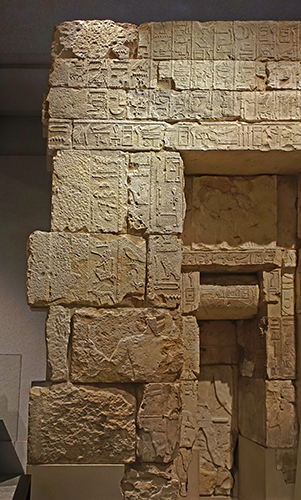
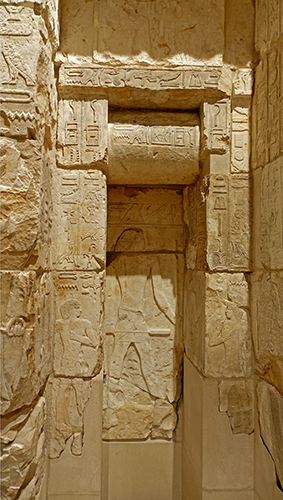
Fourth Dynasty: 2 613 BC - 2 494 BC
Cult Chamber from the tomb of Metjen
These are closeups of the main false door in the tomb. A false door is the passageway between the world of the living and that of the dead.
Catalog: Abusir, Metjen (tomb) ÄM 1105
Photo: Don Hitchcock 2018
Source: Original, Staatliche Museen zu Berlin, Neues Museum, Germany
Text: © Card at the Staatliche Museen zu Berlin, (CC BY-NC-SA 3.0 DE)
Fourth Dynasty: 2 613 BC - 2 494 BC
Cult Chamber from the tomb of Metjen
This is a series of three photos showing the decorated small niche or alcove to the right of the main false door.
There was originally a corresponding niche on the left, of which just the section of wall beside the false door is shown here. The rest is preserved in another section, below.
The statue of Metjen shown further up this page was in a small sealed room, the Serdab, on the other side of the slit in the northern wall masonry shown here.
Catalog: Abusir, Metjen (tomb) ÄM 1105
Photo: Don Hitchcock 2018
Source: Original, Staatliche Museen zu Berlin, Neues Museum, Germany
Text: © Card at the Staatliche Museen zu Berlin, (CC BY-NC-SA 3.0 DE)
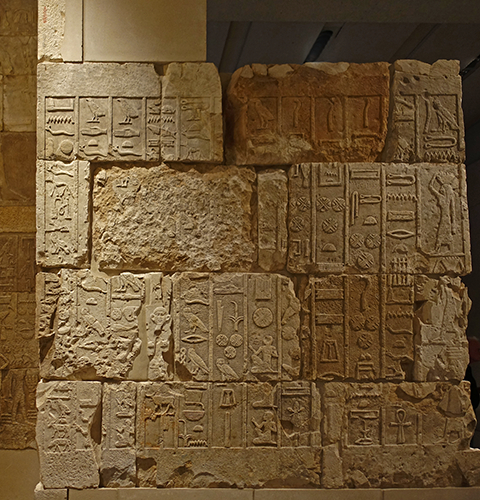
Fourth Dynasty: 2 613 BC - 2 494 BC
Cult Chamber from the tomb of Metjen
This is the northern, right hand wall of the corridor leading to the false door. False doors were placed on the west wall of the main room in the chapel, known as an offering chamber. False doors were usually highly decorated and marked with the names and titles of the grave's owner.
Catalog: Abusir, Metjen (tomb) ÄM 1105
Photo: Don Hitchcock 2018
Source: Original, Staatliche Museen zu Berlin, Neues Museum, Germany
Text: © Card at the Staatliche Museen zu Berlin, (CC BY-NC-SA 3.0 DE)
Fourth Dynasty: 2 613 BC - 2 494 BC
Cult Chamber from the tomb of Metjen
This computer image shows the original approach to the false door, which consisted of a narrow passage leading to the door with a niche on either side.
The whole chamber was recreated digitally in order to provide support blocks for the original stones. It was a massive undertaking.
Photo: https://www.arctron.de/references/2009-en/sacrifice-chambers-berlin/
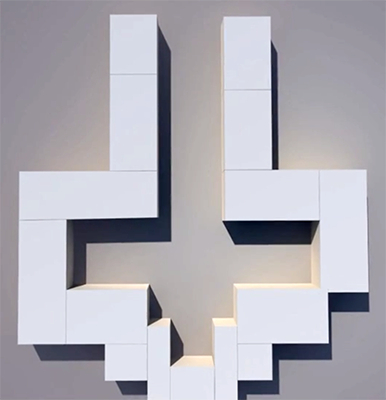
Fourth Dynasty: 2 613 BC - 2 494 BC
Cult Chamber from the tomb of Metjen
This computer image shows the original plan of the Cult Chamber from the tomb of Metjen.
Photo: https://www.arctron.de/references/2009-en/sacrifice-chambers-berlin/
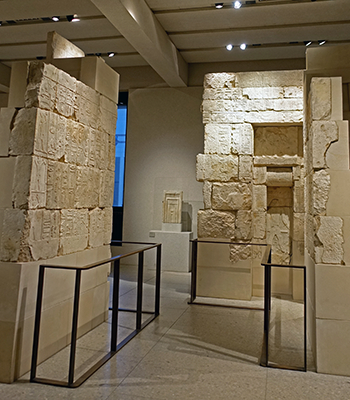
Fourth Dynasty: 2 613 BC - 2 494 BC
Cult Chamber from the tomb of Metjen
This general view shows the way that the cult chamber shown above has been 'exploded' so that visitors can view all parts of the cult chamber in comfort and safety.
The northern wall is on the right hand side of this image, the southern wall is on the left.
Photo: Don Hitchcock 2018
Source: Original, Staatliche Museen zu Berlin, Neues Museum, Germany
Text: © Card at the Staatliche Museen zu Berlin, (CC BY-NC-SA 3.0 DE)
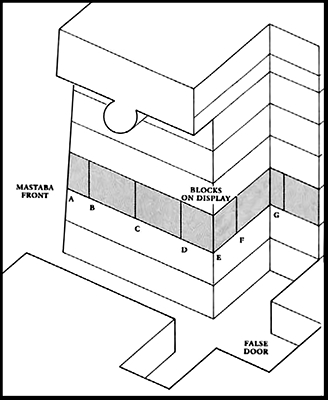
The following blocks are from the left hand, southern wall of the main display of the Cult Chamber, as shown in this diagram. The Cult Chamber was 'exploded' in format so that it would be easier for visitors to see the entire chamber with good lighting and the minimum of crowding.
The Cult Chamber is also known as the Mortuary Chapel of Metjen, Saqqara.
Since this drawing was completed in 1999, showing only the few blocks from the left hand entrance corridor sturdy and stable enough to be put on display at that time, the entire section has been recreated with great effort, completed in 2009, so that we can now see the complete left hand side of the corridor leading to the main false door, of which the positions of blocks A to D are shown in this drawing. Blocks E, F, and G form the left hand side of the negative 'cross' of the Cult Chamber.
Drawing: Isometric drawing by Dieter Arnold
Source: Staff of the Metropolitan Museum of Art (1999)

These are the blocks A, B, C, and D shown above.
Catalog: Abusir, Metjen (tomb) ÄM 1105
Photo: Don Hitchcock 2018
Source: Original, Staatliche Museen zu Berlin, Neues Museum, Germany
Text: © Card at the Staatliche Museen zu Berlin, (CC BY-NC-SA 3.0 DE)
Reading from right to left, as defined by Staff of the Metropolitan Museum of Art (1999), and is translated by them, with the part on the blocks A, B, C, D in italics:
Column 1. (Document of record) the land administrator, nome ruler, Overseer of Commissions in the Kynopolite nome, Overseer of Messengers.
Column 2. (Re:) the Mendesian nome, town of Ram's Area: a field of 4 aruras (2.7 acres), the people, and everything in the funerary-estate decree of the scribe of stores (Metjen's father). They have been given to one son (Metjen), and he (Metjen) has been made to get the funerary-estate decrees from him (his Father). For he has a document
Column 3. that has been assigned to him at his disposal. To the Overseer of Commissions of thethe Western Saite nome:
Column 4. There have been founded for him (Metjen) 12 Metjen-foundations of the Saite, Xoite, and Letopolite names,whose yield he shall have on festivals.
Column 5. There have been bought for him from many landholders a field of 200 aruras (136 acres)
Column 6. so that offering-hall bread might come forth every day in the ka chapel of the King's Mother Ni-maat-hapi,
Column 7. and an estate 200 cubits long by 200 cubits wide (344·5 x 344·5 feet), with a wall equipped and set with good wood, a very big pool made in it, and planted with figs and grapes.
Column 8. A record of it is in the royal archive, and their names (of the landholders from whom Metjen purchased the land) are in the royal archive.
Column 9. Very many trees and vines have been planted, from which much wine might come.
Column 10. A vineyard of a hundredth of an arura (297 square feet) has been made for him inside the wall, planted with vines.
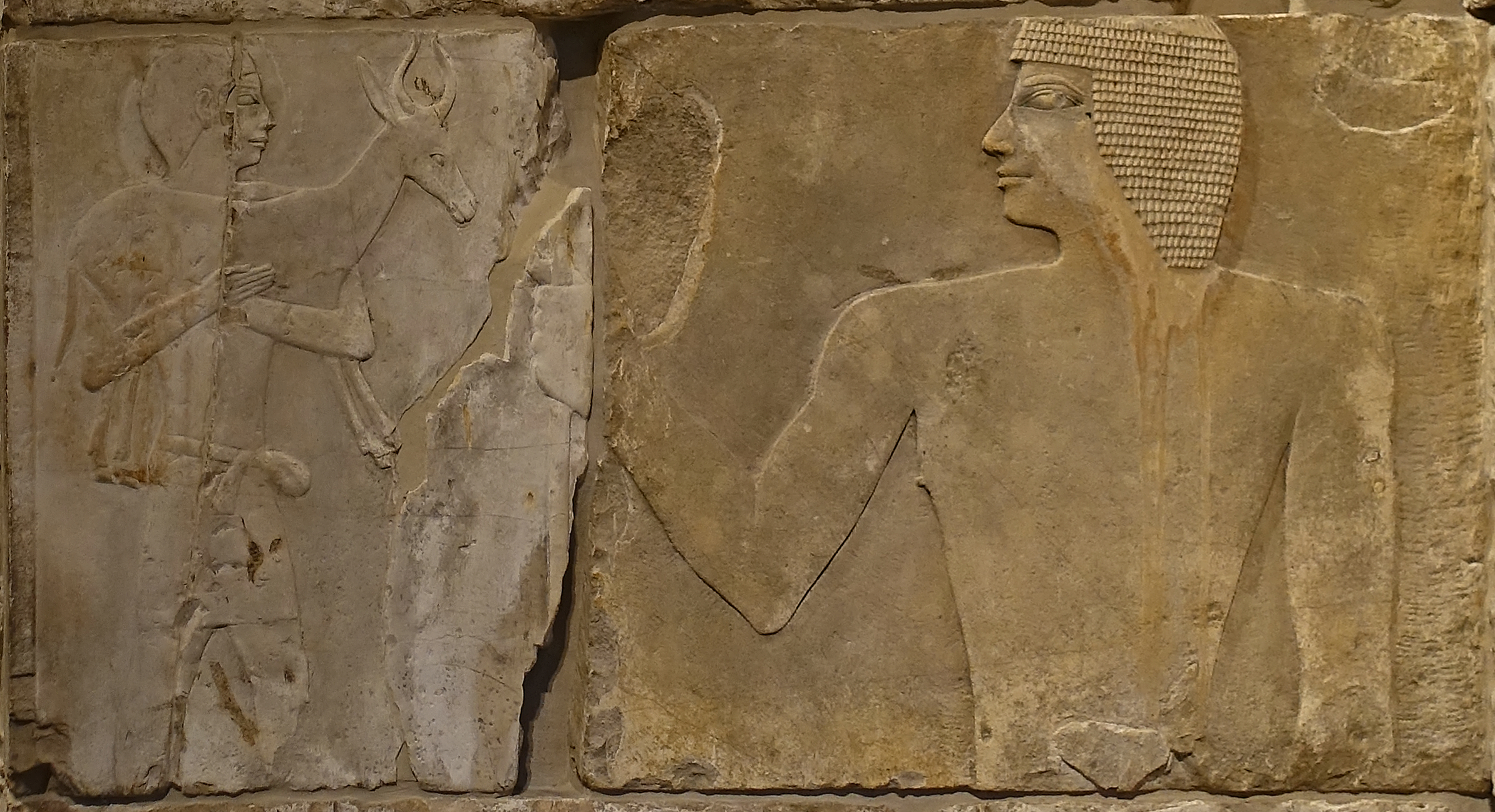
These are the blocks E and F shown in the diagram above.
Catalog: Abusir, Metjen (tomb) ÄM 1105
Photo: Don Hitchcock 2018
Source: Original, Staatliche Museen zu Berlin, Neues Museum, Germany
Text: © Card at the Staatliche Museen zu Berlin, (CC BY-NC-SA 3.0 DE)
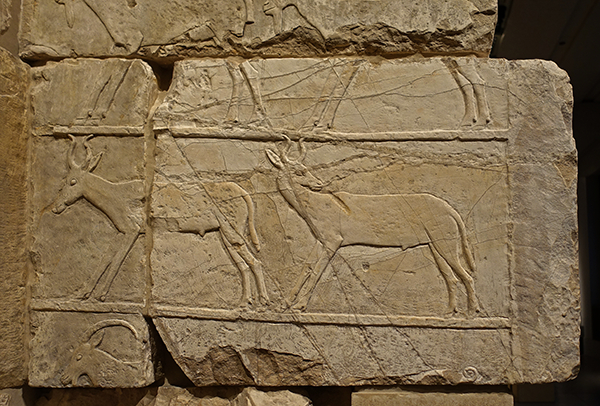
This is block G shown in the diagram above.
Catalog: Abusir, Metjen (tomb) ÄM 1105
Photo: Don Hitchcock 2018
Source: Original, Staatliche Museen zu Berlin, Neues Museum, Germany
Text: © Card at the Staatliche Museen zu Berlin, (CC BY-NC-SA 3.0 DE)
Blocks A to G were the only blocks from this section which could be displayed at first. The rest were kept in storage, being too fragile to exhibit, until the computerised technology existed to create backings or supports for them, which was done in 2009, when the entire section was set up for public display.
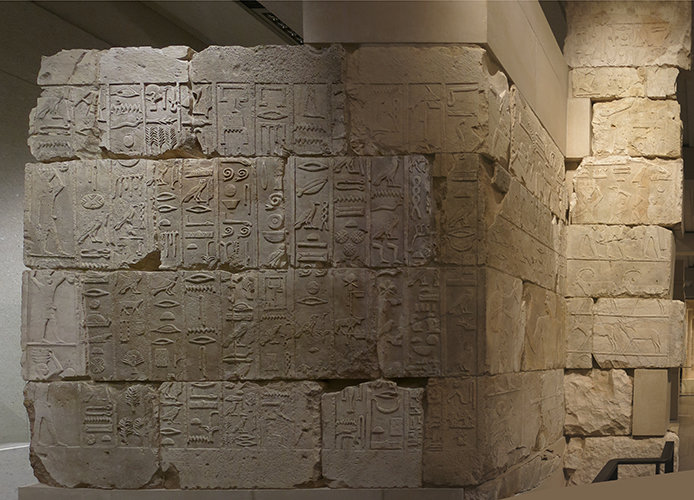
Fourth Dynasty: 2 613 BC - 2 494 BC
Cult Chamber from the tomb of Metjen
This wall is part of Metjen's tomb, called the Cult Chamber, the Mortuary Chapel, or the Offering Chapel.
It is the left hand side of the narrow corridor leading to the false door.
It includes blocks A, B, C, and D as shown above.
The other walls on the right hand side of this image are part of the left 'arm' of the negative 'cross' shown in the drawing above. Staff of the Metropolitan Museum of Art (1999) show a diagram (see above) in which this may be seen.
On the right hand side of this image, including block G, in an alcove we can see some of the animals of the hunt - the Nubian ibex, Capra nubiana, the Dorcas gazelle, Gazella dorcas, and the Desert hare, Lepus capensis.
Catalog: Abusir, Metjen (tomb) ÄM 1105
Photo: Don Hitchcock 2015
Source: Original, Staatliche Museen zu Berlin, Neues Museum, Germany
Text: © Card at the Staatliche Museen zu Berlin, (CC BY-NC-SA 3.0 DE)
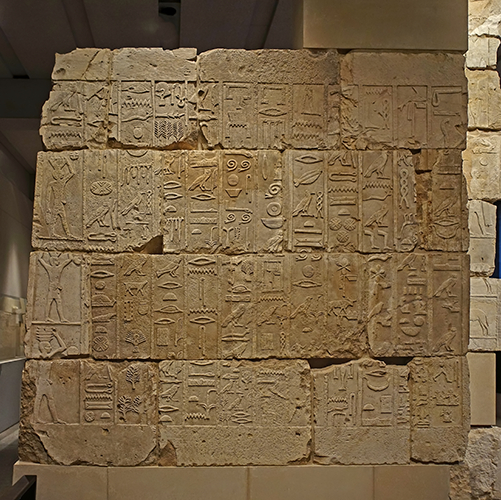
Fourth Dynasty: 2 613 BC - 2 494 BC
Cult Chamber or Offering Chapel of Metjen
This is a higher definition version of the image above.
Catalog: Abusir, Metjen (tomb) ÄM 1105
Photo: Don Hitchcock 2018
Source: Original, Staatliche Museen zu Berlin, Neues Museum, Germany
Text: © Card at the Staatliche Museen zu Berlin, (CC BY-NC-SA 3.0 DE)
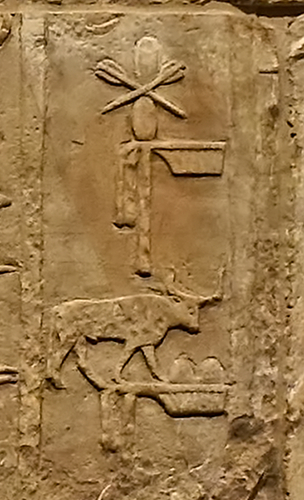
Fourth Dynasty: 2 613 BC - 2 494 BC
Cult Chamber or Offering Chapel of Metjen
Reminding the reader that this is property guaranteed by royal decree, it enumerates the twelve endowments of Metjen located in different nomes (provinces) of Lower Egypt. In the fourth column the nome of the goddess Neith, recognisable by her emblem, two hunting bows tied in a vertical package, overlain by two crossed arrows, is shown immediately above the image representing the nome of the wild or mountain bull.
Catalog: Abusir, Metjen (tomb) ÄM 1105
Photo: Don Hitchcock 2018
Source: Original, Staatliche Museen zu Berlin, Neues Museum, Germany
Text: © Card at the Staatliche Museen zu Berlin, (CC BY-NC-SA 3.0 DE)
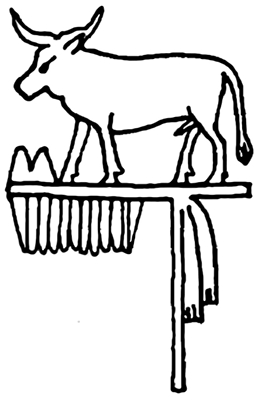
Fourth Dynasty: 2 613 BC - 2 494 BC
Cult Chamber or Offering Chapel of Metjen
( The nomes came to be represented on a standard, just as the images of gods originally were, as shown here with this image of the wild or mountain bull nome.
The 'standard' appears to be derived from a platform or rod bearing the image, mounted on a pole, and with decorations hanging below the platform - Don )
Photo: Nephiliskos
Permission: licensed under the Creative Commons Attribution-Share Alike 3.0 Germany license
Proximal source: Wikipedia
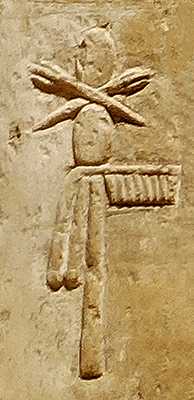
Fourth Dynasty: 2 613 BC - 2 494 BC
Cult Chamber or Offering Chapel of Metjen
( This hieroglyph representing the nome of Neith consists of two hunting bows tied together vertically, and crossed by two arrows, mounted on a standard. This image comes from the left post of the false door of Metjen's tomb - Don )
Catalog: Abusir, Metjen (tomb) ÄM 1105
Photo: Don Hitchcock 2018
Source: Original, Staatliche Museen zu Berlin, Neues Museum, Germany
Text: © Card at the Staatliche Museen zu Berlin, (CC BY-NC-SA 3.0 DE)
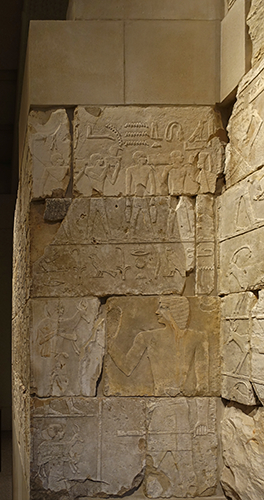
Fourth Dynasty: 2 613 BC - 2 494 BC
Cult Chamber or Offering Chapel of Metjen
On this first return of the alcove including blocks E and F we can see gazelles, apparently captured alive and unhurt, being presented to Metjen.
Included also is an image of the desert hare, and one of the servants is carrying a bronze beaked ewer and basin, which were used as a set in hand washing.
Catalog: Abusir, Metjen (tomb) ÄM 1105
Photo: Don Hitchcock 2018
Source: Original, Staatliche Museen zu Berlin, Neues Museum, Germany
Text: © Card at the Staatliche Museen zu Berlin, (CC BY-NC-SA 3.0 DE)
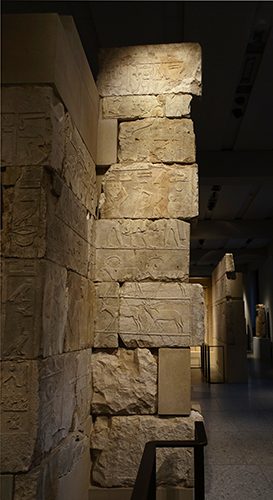
Fourth Dynasty: 2 613 BC - 2 494 BC
Cult Chamber or Offering Chapel of Metjen
On this second return of the alcove including block G, we can see a more detailed view of the Nubian ibex, Capra nubiana, the Dorcas gazelle, Gazella dorcas, and the Desert hare, Lepus capensis.
In the right background of this image we can see the door of the sacrificial chamber and the wall in the tomb of Manufer, circa 2 335 BC.
Catalog: Abusir, Metjen (tomb) ÄM 1105
Photo: Don Hitchcock 2018
Source: Original, Staatliche Museen zu Berlin, Neues Museum, Germany
Text: © Card at the Staatliche Museen zu Berlin, (CC BY-NC-SA 3.0 DE)
Fourth Dynasty: 2 613 BC - 2 494 BC
Metjen's name and titles
Above we can see Metjen's name, as well as his title of confidant of the king.
Metjen's tomb inscriptions are of the highest interest to Egyptologists and historians alike. They are in fact the very first Ancient Egyptian private texts that reveal more than only titles and offering formulae. Metjen is the first high official who reports his own professional and curatorial career by listing his official and honorary titles in chronological order and describing the support of his career by his parents.
According to Metjen's autobiography, he inherited many of his titles after the death of his father, other high ranked titles were assigned to him by his father himself. The inheritance included also several decrees which allowed Metjen to found his own estates and even small towns. Metjen started as a royal scribe, then became overseer of the royal scribes and confidant of the king, then he became administrator of several palatinates and royal storages. Finally, he became "great one of the 'Ten of Upper Egypt' and privy council. Additionally, the royal house gave several estates to Metjen, whereupon he founded the town Sheret-Metjen (Egyptian: Šr.t-Mṯn) at his favorite estate. As a sign of gratitude, Metjen in turn donated hundreds of precious trees to royal domains. At the peak of his career, Metjen was also mayor of several cities, curator of the endowment estate of king Huni and supervisor of the mortuary cult for Queen Nimaathapi.
Catalog: Abusir, Metjen (tomb) ÄM 1105
Photo: Don Hitchcock 2018
Drawn hieroglyphic: Wikipedia
Source: Original, Staatliche Museen zu Berlin, Neues Museum, Germany, Wikipedia
Text: Wikipedia
Decrees Setting Up the Estates of Metjen from His Tomb at Saqqara
Decree I
(To) the ruler of the nome, leader of the land, overseer of commissions of the eastern part of the sixth nome of Upper Egypt (regarding) the judge in charge of offering, controller of the great estate of the third and fourth/fifth nomes of Lower Egypt, overseer of the troops of the western border: He has bought 200 arouras of land from many royal colonists. He has given 50 arouras of land to (his) mother Nebesneit when she set up her will for the children, and their share was set down in a royal document for every office.
The sixth nome of Upper Egypt, Mountain bull land: The temple complex of Dendera (Denderah) is one of the best preserved complexes in Egypt. It lies around 2.5km south-east of Dendera (known to the ancient Egyptians as Iunet or Tantere), the sixth Nome of Upper Egypt. The whole complex extends to around 40 000 square metres and is surrounded by a large mudbrick enclosure wall.
Text above from https://ancientegyptonline.co.uk/denderatemplecomplex/
Decree II
(To) the controller of the mansion of Huni in the second nome of Lower Egypt: He was given together with his son 12 arouras of land with dependents and herds of cattle.
(The second nome of Lower Egypt was Travellers land)
Decree III
(To) the leader of the land, ruler of the nome, overseer of commissions in the seventeenth nome of Upper Egypt, overseer of messengers: (regarding) the sixteenth nome of Lower Egypt, 4 arouras of land in Baseh (with) dependents and all things which are contained in a decree of the scribe of the office of provisioning; while he is (still) on earth, it was given to (his) only son and it was seen to that the decree was brought into his presence.
Decree IV
(To) the overseer of commissions of the fourth/fifth and third nomes of Lower Egypt: 12 'foundations of Metjen' have been founded for him in the fourth/fifth, sixth and second nomes of Lower Egypt (along with) their products for him in the dining room. These have been bought for 20 arouras of land from many royal colonists, (along with) 100 portions of funerary offerings which come daily from the soul chapel of the royal mother Nymaathap (and with) a walled estate 200 cubits long and 200 broad, set out with fine trees, and a large pool made in it; it was planted with fig trees and vines. It is written down in a royal document, and their names are (recorded likewise) on (this) royal document. The trees and the vines were planted in great numbers, and the wine therefrom was produced in great quantity (or 'of great quality').
(The third nome of Lower Egypt was Cattle Land, the fourth nome was Southern Shield Land, the fifth nome was Northern Shield Land. )
A garden was made for him on land of 1 kha and 2 ta within the enclosure, which was planted with trees. (It was named) Iymeres, a 'foundation of Metjen,' and Iatsobek, a 'foundation of Metjen.' The property of his father the judge and scribe Inpuemankh was given to him, without wheat and barley and the property of the estate, but with dependents and herds of donkeys and pigs (?).
He was promoted to first of the scribes of the office of provisioning and overseer of the office of provisioning; He was promoted to be the 'strong of voice' among those involved in agricultural production when the boundary official of the sixth nome of Lower Egypt was in charge of the judge and supervisors of reversionary offerings in the sixth nome of Lower Egypt, who should take the job of judge and 'strong of voice,' and he was promoted to be overseer of all linen products of the king; and he was promoted to be ruler of the Per-Desu and the towns which are under the same control (?); and he was promoted to be the boundary official of the people of Buto and controller of the estate of Per-Sedjaut and Per-Sepa and boundary official of the fourth/fifth nome of Lower Egypt and controller of the estate of Senet and the nomes under the same control, controller of Per-Sheptjet, and controller of the towns of the Great Mansion of the southern lake (the Fayum). The 'foundations of Metjen' have been founded out of what his father Inpuemankh gave him.
Above text from: Strudwick (2005)
Fourth Dynasty: 2 613 BC - 2 494 BC
The Paste Reliefs of Nefermaat
Paste relief of cattle, a cattleherder, and boatbuilders, from the tomb of Nefermaat, Old Empire, 4th dynasty, around 2 550 BC.
Nefermaat, son of King Snofru / Sneferu, and, as vizier, the highest official in the land, had had an enormous mastaba tomb erected in Meidum, right next to the pyramid of his father. In the cult chambers built for him and his wife Atet, the relief decorations were executed in a new technique: the images, carved in sunken relief, were filled with inlays made of gypsum and clay mixed with pigments of various colours. Nefermaat boasts in an inscription of having invented this technique himself, which was supposed to give the representations greater durability. Unfortunately, the expected outcome was not realised: most of the inlays have fallen out; only the silhouettes of the scenes remain.
The Munich blocks, with their depictions of grazing cattle accompanied by a cowherd and the construction of a papyrus boat, came from the entrance wall of the chapel of Atet.
Old Kingdom, Fourth Dynasty, circa 2 550 BC.
Meidum, Maydum or Maidum is an archaeological site in Lower Egypt. It contains a large pyramid and several mud-brick mastabas. The pyramid was Egypt's first straight-sided one, but it partially collapsed in ancient times. The area is located around 100 km south of modern Cairo.
Catalog: Limestone, Meidum, Tomb of Nefermaat, Gl. 103 a-f
Photo: Don Hitchcock 2018
Source: Original, Ägyptischen Museum München
Text: © Ägyptischen Museum München
Additional text: Wikipedia.
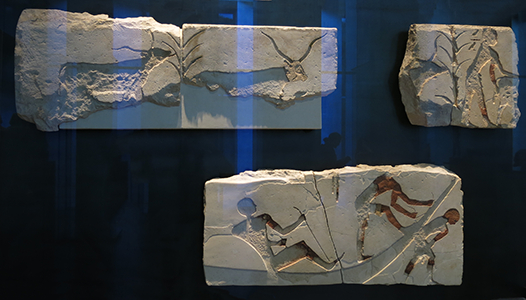
Another view of the three decorations.
Catalog: Limestone, Meidum, Tomb of Nefermaat, Gl. 103 a-f
Photo: Don Hitchcock 2015
Source: Original, Ägyptischen Museum München
Text: © Ägyptischen Museum München
Additional text: Wikipedia.
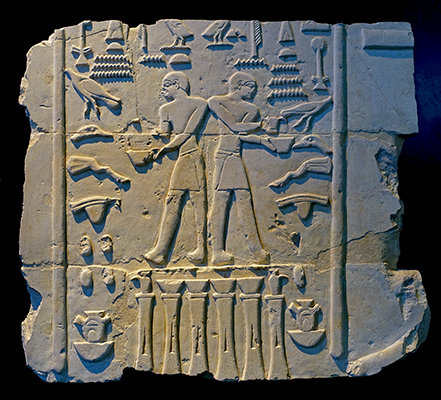
Fourth Dynasty: 2 613 BC - 2 494 BC
Akhtihotep
Fragment of a relief with offering scene from the tomb of Akhtihotep, Reign of Sneferu.
Limestone
Catalog: Sakkara, Mastabe of Akhtihotep, ÄS 4854
Photo: Don Hitchcock 2018
Source: Original, Ägyptischen Museum München
Text: © Ägyptischen Museum München
Additional text: http://www.metmuseum.org/art/collection/search/543912
Fourth Dynasty: 2 613 BC - 2 494 BC
Rahotep
Fragments of a false-door stela from the tomb of Rahotep.
Prince Rahotep was probably a son of Pharaoh Sneferu and his first wife.
Limestone, circa 2 600 BC
Catalog: Meidum, mastaba of Rahotep, GL 102 a-d
Photo: Don Hitchcock 2015, 2018
Source: Original, Ägyptischen Museum München
Text: © Ägyptischen Museum München
Additional text: Wikipedia
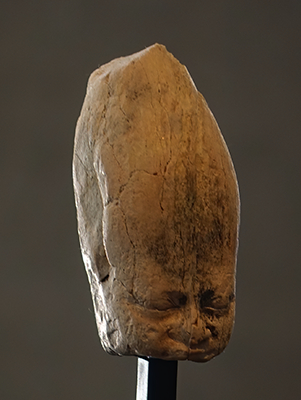
Fourth Dynasty: 2 613 BC - 2 494 BC
Pharaoh Khufu (Cheops)
Head of a statue of the Pharaoh Khufu, known as Cheops to the Greeks, 6 cm.
Circa 2 600 BC
Photo: Don Hitchcock 2015
Catalog: Limestone, ÄS 7086
Source: Original, Ägyptischen Museum München
Text: © Ägyptischen Museum München
Additional text: http://www.leben-in-luxor.de/luxor_lexikon_museen_smaek2.html
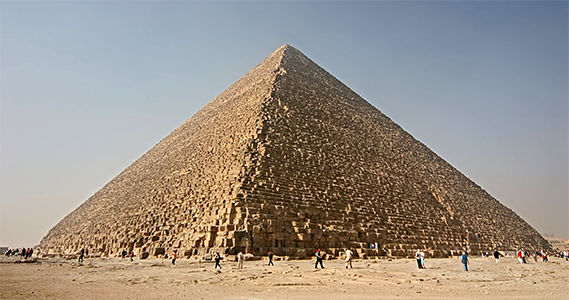
Fourth Dynasty: 2 613 BC - 2 494 BC
Pyramid of Giza / Khufu / Cheops
The pyramid of Khufu or the Pyramid of Cheops is the oldest and largest of the three pyramids in the Giza pyramid complex bordering what is now El Giza, Egypt. It is the oldest of the Seven Wonders of the Ancient World, and the only one to remain largely intact.
Based on a mark in an interior chamber naming the work gang and a reference to fourth dynasty Egyptian Pharaoh Khufu, Egyptologists believe that the pyramid was built as a tomb over a 10 to 20-year period concluding around 2560 BC. Initially at 146.5 metres (481 feet), the Great Pyramid was the tallest man-made structure in the world for more than 3,800 years. Originally, the Great Pyramid was covered by casing stones that formed a smooth outer surface; what is seen today is the underlying core structure. Some of the casing stones that once covered the structure can still be seen around the base.
There have been varying scientific and alternative theories about the Great Pyramid's construction techniques. Most accepted construction hypotheses are based on the idea that it was built by moving huge stones from a quarry and dragging and lifting them into place.
There are three known chambers inside the Great Pyramid. The lowest chamber is cut into the bedrock upon which the pyramid was built and was unfinished. The so-called Queen's Chamber and King's Chamber are higher up within the pyramid structure. The main part of the Giza complex is a setting of buildings that included two mortuary temples in honour of Khufu (one close to the pyramid and one near the Nile), three smaller pyramids for Khufu's wives, an even smaller 'satellite' pyramid, a raised causeway connecting the two temples, and small mastaba tombs surrounding the pyramid for nobles.
Photo: Nina-no, Nina Aldin Thune
Permission: GNU Free Documentation License
Text: Wikipedia
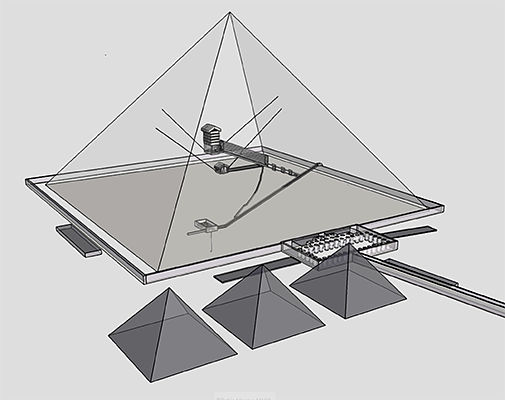
Fourth Dynasty: 2 613 BC - 2 494 BC
Pyramid of Giza / Khufu / Cheops
Transparent view of Khufu's pyramid from the South East.
Photo: R.F.Morgan
Permission: Creative Commons Attribution-Share Alike 3.0 Unported license.
Text: Wikipedia
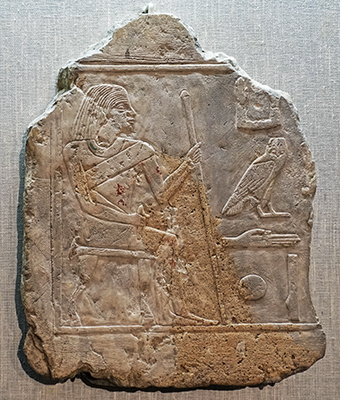
Fourth Dynasty: 2 613 BC - 2 494 BC
Relief of Kaemqed
Kaemqed was a 4th dynasty Ancient Egyptian prince. He was a son of Princess Nefertnesu and a grandson of Pharaoh Sneferu, who built the Bent Pyramid, the Red Pyramid and the Meidum pyramid.
Kaemqed is known from a false door. He was buried in Dashur in the 5th dynasty.
Circa 2 600 BC.
Catalog: Limestone with traces of painting, Saqqara (?), Inv. Nr. 2326
Photo: Don Hitchcock 2018
Source and text: Original, Museum August Kestner, Hannover
Additional text: Wikipedia
Fourth Dynasty: 2 613 BC - 2 494 BC
Pharaoh Djedefre
Quartzite head of Pharaoh Djedefre from Abu Rawash.
Height 265 mm, width 335 mm.
Djedefre continued the move north in the location of pyramids by building his (now ruined) pyramid at Abu Rawash, some 8 kilometres (5.0 mi) to the north of Giza. It is the northernmost part of the Memphite necropolis.
While Egyptologists previously assumed that his pyramid at this heavily denuded site was unfinished upon his death, more recent excavations from 1995 to 2005 have established that it was indeed completed. The most recent evidence indicates that its current state is the result of extensive plundering in later periods while the king's statues [were] smashed as late as the 2nd century AD.
Photo: Rama
Permission: Creative Commons Attribution-ShareAlike 3.0 France license
Catalog: Painted quartzite, E 12626
Source: Original, Louvre Museum
Text: Wikipedia
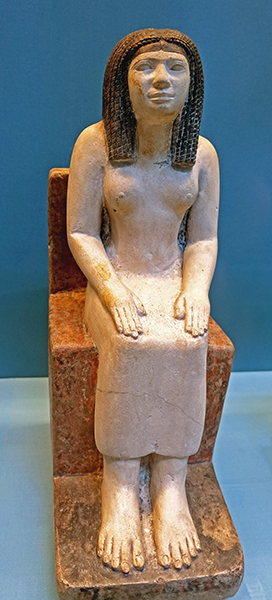
Fourth Dynasty: 2 613 BC - 2 494 BC
Ninefertmin
Painted limestone seated figure of Ninefertmin; Hieroglyphic text on the sides of the block-seat.
The straight hairstyle and simple unpleated dress are typical of women dating from the Old Kingdom.
The seat has been painted to resemble red granite.
Height 455 mm.
Catalog: Painted limestone EA65430
Photo: Don Hitchcock 2018
Source: Original, British Museum
Text: Card at museum display, https://www.britishmuseum.org/, © Trustees of the British Museum, CC BY-NC-SA 4.0
Fourth Dynasty: 2 613 BC - 2 494 BC
Standing - striding figure of the Court Musician Ipi.
Limestone, circa 2 600 BC.
Catalog: Dashur, ÄS 1600
Photo: Don Hitchcock 2018, 2015
Source: Original, Ägyptischen Museum München
Text: © Ägyptischen Museum München
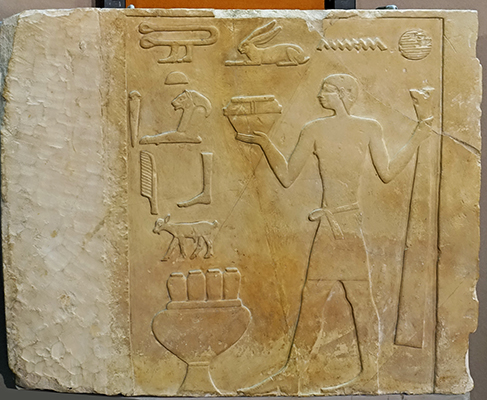
Fourth Dynasty: 2 613 BC - 2 494 BC
Gift-bringer
Circa 2 550 BC
Catalog: Limestone, Saqqara (?), Inv. no. 1957.75
Photo: Don Hitchcock 2018
Source and text: Original, Museum August Kestner, Hannover
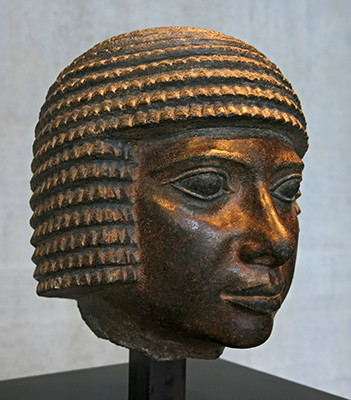
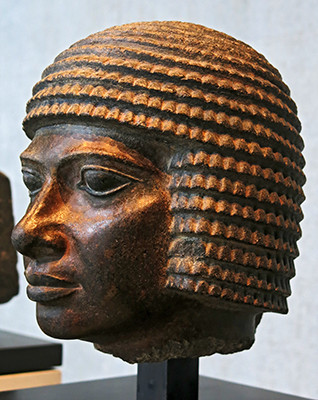
Fourth Dynasty: 2 613 BC - 2 494 BC
Portrait head of a man, circa 2 550 BC
Catalog: Granodiorite, Assuan, ÄS 6932
Photo: Don Hitchcock 2015
Source: Original, Ägyptischen Museum München
Text: © Ägyptischen Museum München, Wikipedia
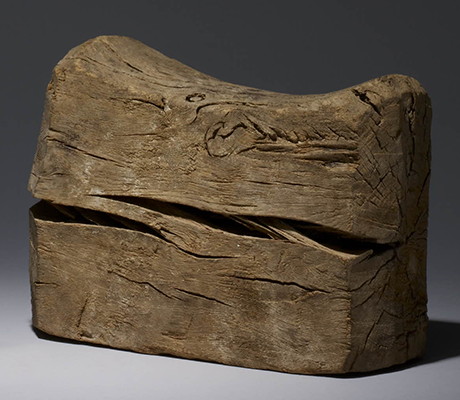
Fourth Dynasty: 2 613 BC - 2 494 BC
Headrest
This is a very simple unpolished wooden head-rest from the 4th Dynasty, in the form of a block with concave top. The head-rest has not received any painted or incised decoration.
Length 204 mm, width 89 mm, height 153 mm.
Such simple forms of headrest are found throughout pharaonic and Ptolemaic Egypt.
Catalog: Dishasha, EA29565
Photo: © Trustees of the British Museum, CC BY-NC-SA 4.0
Source: Original, British Museum
Text: Card at museum display, http://www.britishmuseum.org/, © Trustees of the British Museum, CC BY-NC-SA 4.0
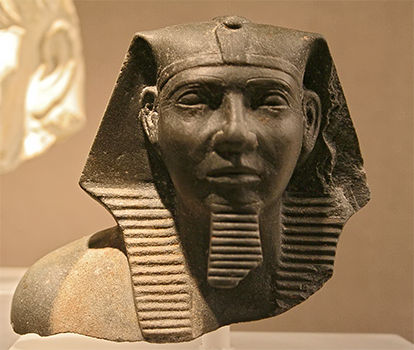
Fourth Dynasty: 2 613 BC - 2 494 BC
Statue of Khafra / Khafre
Photo: Einsamer Schütze
Permission: GNU Free Documentation License
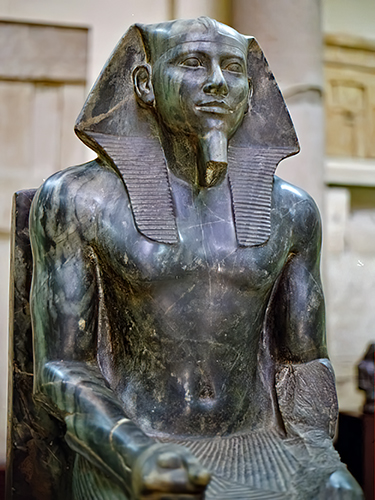
Fourth Dynasty: 2 613 BC - 2 494 BC
Khafra / Khafre
Statue of Khafre in diorite, Valley Temple of Khafra, Giza.
Height 168 cm, width 57 cm, depth 96 cm.
Catalog: Diorite, Valley Temple of Khafra, Giza, JE 10062 - CG 14
Photo: Jon Bodsworth
Permission: Free to use for any purpose
Source: Egyptian Museum, Cairo
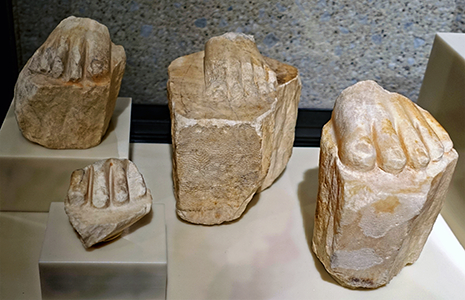
Fourth Dynasty: 2 613 BC - 2 494 BC
Khafra
Four fragments of feet from statues of King Khafra / Khephren (?)
Circa 2 558 BC - 2 532 BC
Catalog: Calcite - alabaster, Giza, ÄM 15052, ÄM 15060-2
Photo: Don Hitchcock 2018
Source: Original, Staatliche Museen zu Berlin, Neues Museum, Germany
Text: © Card at the Staatliche Museen zu Berlin, (CC BY-NC-SA 3.0 DE)
Fourth Dynasty: 2 613 BC - 2 494 BC
Khafra
Two right fists from statues of King Khafra / Khephren.
Circa 2 558 BC - 2 532 BC
Catalog: Anorthositic Gneiss, Giza, ÄM 15038, ÄM 15039
Photo: Don Hitchcock 2018
Source: Original, Staatliche Museen zu Berlin, Neues Museum, Germany
Text: © Card at the Staatliche Museen zu Berlin, (CC BY-NC-SA 3.0 DE)
Fourth Dynasty: 2 613 BC - 2 494 BC
Pyramid of Khafre
The Pyramid of Khafre is the second-tallest and second-largest of the 3 Ancient Egyptian Pyramids of Giza and the tomb of the Fourth-Dynasty pharaoh Khafre.
The pyramid has a base length of 215.5 metres and rises to a height of 136.4 metres. It is made of limestone blocks weighing more than 2 tons each. The slope of the pyramid rises at a 53° 13' angle, steeper than its neighbor, the Pyramid of Khufu, which has an angle of 51°50'24". Khafre's pyramid sits on bedrock 10 m (33 ft) higher than Khufu's pyramid, which makes it appear to be taller.
Photo: Francisco Anzola
Permission: CC BY 2.0
Fourth Dynasty: 2 613 BC - 2 494 BC
Sphinx of Giza
The Great Sphinx of Giza, commonly referred to as the Sphinx of Giza, Great Sphinx or just the Sphinx, is a limestone statue of a reclining sphinx, a mythical creature with the head of a human, and the body of a lion. Facing directly from west to east, it stands on the Giza Plateau on the west bank of the Nile in Giza, Egypt. The face of the Sphinx appears to represent the pharaoh Khafre.
Cut from the bedrock, the original shape of the Sphinx has been restored with layers of limestone blocks. It measures 73 metres long from paw to tail, 20 metres high from the base to the top of the head and 19 metres wide at its rear haunches. Its nose was broken off for unknown reasons between the 3rd and 10th centuries AD.
The Sphinx is the oldest known monumental sculpture in Egypt and one of the most recognisable statues in the world. The archaeological evidence suggests that it was created by ancient Egyptians of the Old Kingdom during the reign of Khafre.
Photo:superblinkymac
Permission: CC BY-NC-ND 2.0
Text: Wikipedia
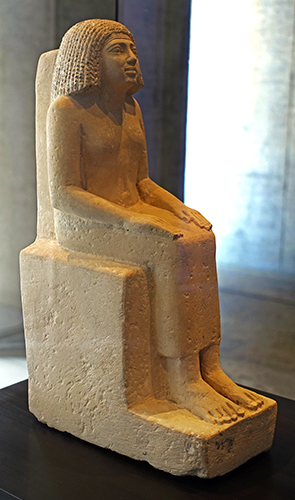
Fourth Dynasty: 2 613 BC - 2 494 BC
Nefertiabet
Seated statue of the daughter of King Khafra, Nefertiabet, 'Beautiful One of the East', circa 2 580 BC.
Her tomb at Giza is known (G 1225), western cemetery. The mastaba is 24.25 x 11.05 metres in size. The tomb originally contained one shaft, which contained the burial of Nefertiabet. The shaft comprises a passage and a chamber. Fragments of a white limestone coffin with a flat lid were found. A canopic pit had been dug in one of the corners of the chamber. The chamber contained several bowls and jars. An annex with one additional burial shaft was added later, but was found emptied.
Catalog: Limestone, Gizeh, ÄM 15038, ÄS 7155
Photo: Don Hitchcock 2018
Source: Original, Staatliche Museen zu Berlin, Neues Museum, Germany
Text: © Card at the Staatliche Museen zu Berlin, (CC BY-NC-SA 3.0 DE)
Additional text: Reisner (1942), Dodson et al. (2004)
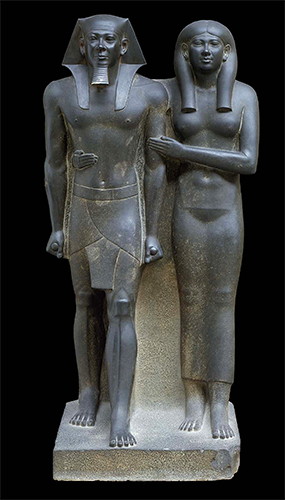
Fourth Dynasty: 2 613 BC - 2 494 BC
King Menkaure (Mycerinus, Mykerinos) and Queen Khamerernebty
2 532 BC - 2 503 BC.
Greywacke, overall: 1422 x 571 x 552 mm, 676.8 kg
Photo: Gardner et al. (2003)
Source: Museum of Fine Arts, Boston
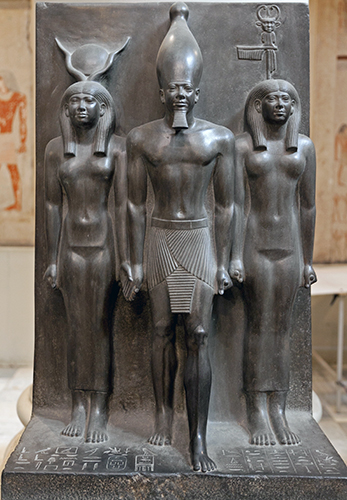
Fourth Dynasty: 2 613 BC - 2 494 BC
Pharaoh Menkaure
Triad statue of pharaoh Menkaure, accompanied by the goddess Hathor (on his right) and the personification of the nome of Diospolis Parva (on his left)
Height 93 cm, width 47 cm.
Photo: Chipdawes, Dead.rabbit
Permission: Public Domain
Plan of the Giza Plateau.
Photo: Lehner (1992)
Fourth Dynasty: 2 613 BC - 2 494 BC
Pyramid of Menkaure
A few mastabas are visible next to the pyramid.
The Pyramid of Menkaure is the smallest of the three main Pyramids of Giza, located on the Giza Plateau in the southwestern outskirts of Cairo, Egypt. It is thought to have been built to serve as the tomb of the Fourth Dynasty Egyptian Pharaoh Menkaure.
Menkaure's pyramid had an original height of 65.5 metres, and was the smallest of the three major pyramids at the Giza Necropolis. It now stands at 61 metres tall with a base of 108.5 metres. Its angle of incline is approximately 51°20′25″. It was constructed of limestone and Aswan granite. The first sixteen courses of the exterior were made of the red granite. The upper portion was cased in the normal manner with Tura limestone. Part of the granite was left in the rough. Incomplete projects such as this pyramid help archaeologists understand the methods used to build pyramids and temples.
Photo: Przemyslaw "Blueshade" Idzkiewicz, 2004
Permission: Creative Commons Attribution-Share Alike 2.5 Generic license
Fourth Dynasty: 2 613 BC - 2 494 BC
Pyramid of Menkaure
In AD 1196, Al-Aziz Uthman, Saladin's son and the Sultan of Egypt, attempted to demolish the pyramids, starting with that of Menkaure. Workmen recruited to demolish the pyramid stayed at their job for eight months, but found it almost as expensive to destroy as to build. They could only remove one or two stones each day. Some used wedges and levers to move the stones, while others used ropes to pull them down. When a stone fell, it would bury itself in the sand, requiring extraordinary efforts to free it. Wedges were used to split the stones into several pieces, and a cart was used to carry it to the foot of the escarpment, where it was left. Despite their efforts, workmen were only able to damage the pyramid to the extent of leaving a large vertical gash at its northern face.
Photo: Daniel Mayer
Permission: GNU Free Documentation License, Version 1.2
Text: Wikipedia
Hamilton (2020)
Fourth Dynasty: 2 613 BC - 2 494 BC
Pyramid of Menkaure
Section through the centre of the Third Pyramid.
The above section from Vyse’s publication shows the layout of the substructure and various tunnels hewn through the superstructure.
The longest tunnel was created by Vyse, with the help of gunpowder; this started from the breach in the north face and terminated at the base of the pyramid.
It’s not altogether clear why he choose this action, instead of following on where Belzoni had excavated (he would also cut a tunnel through the whole width of GIII-b); Vyse would give up on this tunnel and attack the north face, and soon discover the entrance. Notwithstanding the dangers of gunpowder, the removal of large fallen granite blocks had its own risks, as one of Vyse’s assistants, a Mr Raven would painfully attest, when courtesy of a blow from a crowbar, he found himself five teeth short.
Photo: Howard-Vyse (1840)
Text: Hamilton (2020)
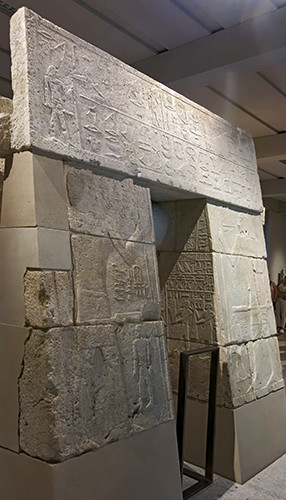
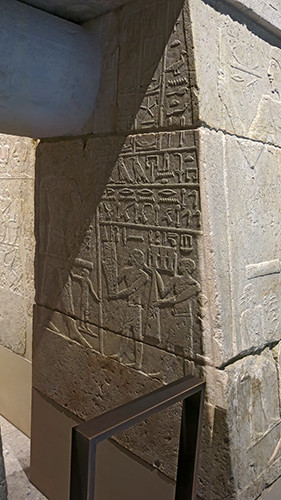
Fourth Dynasty: 2 613 BC - 2 494 BC
Entrance to the Burial Chamber of Merib, circa 2 500 BC.
The Egyptian Museum in Berlin reopened the New Museum in 2009 with the offering chambers of Metjen (Abusir, Dynasties 3 to 4) and of Merib (Giza, Dynasty 4) displayed in a new and unique fashion. Rather than rebuilding the small chambers on their original floor plan, their walls are displayed at a distance, in an 'exploded' fashion. The blocks appear to rest on each other, while missing sections on their back sides were filled with cast modern blocks, into which the ancient fragments were set to supply structural support.
Catalog: Giza, Ostfriedhof, Grab Nr 70 limestone, ÄM 1107
Photo: Don Hitchcock 2015
Source: Original, Staatliche Museen zu Berlin, Neues Museum, Germany
Text: Hartwig (2006)
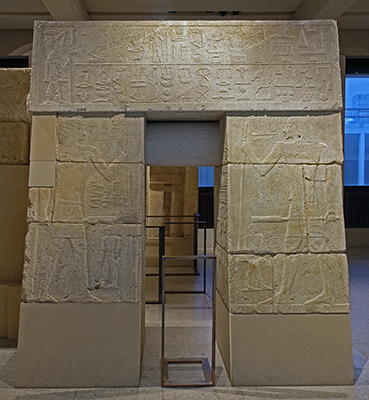
Fourth Dynasty: 2 613 BC - 2 494 BC
Entrance to the Burial Chamber of Merib, circa 2 500 BC.
Extensive three-dimensional modelling was used in the process of developing the current display. Exhibited in a large gallery, the walls stand freely and visitors are able to view the blocks in the round and walk behind the original walls. This display offers a rare insight into the materiality of Egyptian architecture in a manner that was never anticipated in the ancient context, where only flat interior surfaces would have been visible.
Catalog: Giza, Ostfriedhof, Grab Nr 70 limestone, ÄM 1107
Photo: Don Hitchcock 2018
Source: Original, Staatliche Museen zu Berlin, Neues Museum, Germany
Text: Hartwig (2006)
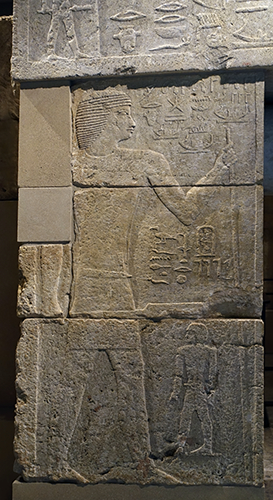
Fourth Dynasty: 2 613 BC - 2 494 BC
Entrance to the Burial Chamber of Merib, circa 2 500 BC.
This is the left hand side of the entrance.
Catalog: Giza, Ostfriedhof, Grab Nr 70 limestone, ÄM 1107
Photo: Don Hitchcock 2018
Source: Original, Staatliche Museen zu Berlin, Neues Museum, Germany
Text: © Card at the Staatliche Museen zu Berlin, (CC BY-NC-SA 3.0 DE)
Fourth Dynasty: 2 613 BC - 2 494 BC
Entrance to the Burial Chamber of Merib, circa 2 500 BC.
This is the lintel of the entrance.
Catalog: Giza, Ostfriedhof, Grab Nr 70 limestone, ÄM 1107
Photo: Don Hitchcock 2018
Source: Original, Staatliche Museen zu Berlin, Neues Museum, Germany
Text: © Card at the Staatliche Museen zu Berlin, (CC BY-NC-SA 3.0 DE)
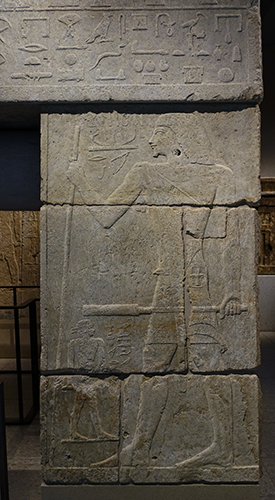
Fourth Dynasty: 2 613 BC - 2 494 BC
Entrance to the Burial Chamber of Merib, circa 2 500 BC.
This is the right hand side of the entrance.
Catalog: Giza, Ostfriedhof, Grab Nr 70 limestone, ÄM 1107
Photo: Don Hitchcock 2018
Source: Original, Staatliche Museen zu Berlin, Neues Museum, Germany
Text: © Card at the Staatliche Museen zu Berlin, (CC BY-NC-SA 3.0 DE)
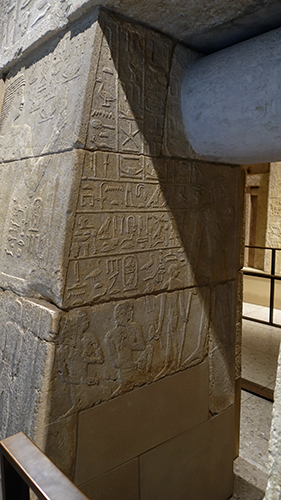
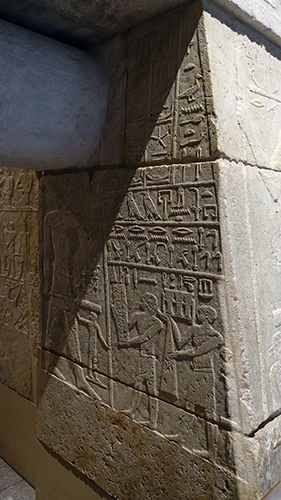
Fourth Dynasty: 2 613 BC - 2 494 BC
Entrance to the Burial Chamber of Merib, circa 2 500 BC.
These are the inside edges of the entrance.
Catalog: Giza, Ostfriedhof, Grab Nr 70 limestone, ÄM 1107
Photo: Don Hitchcock 2018
Source: Original, Staatliche Museen zu Berlin, Neues Museum, Germany
Text: © Card at the Staatliche Museen zu Berlin, (CC BY-NC-SA 3.0 DE)
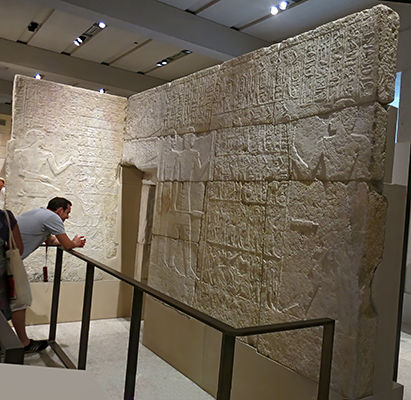
Fourth Dynasty: 2 613 BC - 2 494 BC
Burial Chamber of Merib, circa 2 500 BC.
This is the other side of the wall to the images above, with the other side of the entrance shown above on the left of this photograph.
Catalog: Giza, Ostfriedhof, Grab Nr 70 limestone, ÄM 1107
Photo: Don Hitchcock 2015
Source: Original, Staatliche Museen zu Berlin, Neues Museum, Germany
Text: © Card at the Staatliche Museen zu Berlin, (CC BY-NC-SA 3.0 DE)
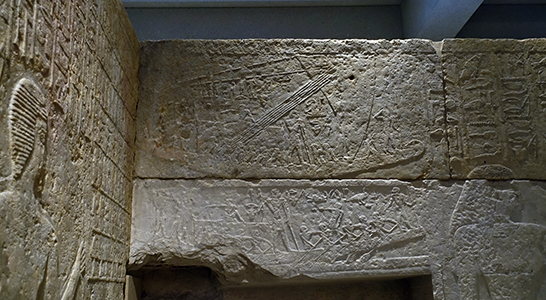
Fourth Dynasty: 2 613 BC - 2 494 BC
Burial Chamber of Merib, circa 2 500 BC.
This is the inside of the lintel, and shows two almost identical Nile river boats powered by paddles. In each case the forward pilot is looking to the stern, the midships pilot is looking forward, and in both cases there are one or two men pointing to the area astern of the boat, as though there is something of interest or alarm there.
Catalog: Giza, Ostfriedhof, Grab Nr 70 limestone, ÄM 1107
Photo: Don Hitchcock 2018
Source: Original, Staatliche Museen zu Berlin, Neues Museum, Germany
Text: © Card at the Staatliche Museen zu Berlin, (CC BY-NC-SA 3.0 DE)
Fourth Dynasty: 2 613 BC - 2 494 BC
Burial Chamber of Merib, circa 2 500 BC.
This is the entire interior panel to the right of the entry to the burial chamber.
Catalog: Giza, Ostfriedhof, Grab Nr 70 limestone, ÄM 1107
Photo: Don Hitchcock 2018
Source: Original, Staatliche Museen zu Berlin, Neues Museum, Germany
Text: © Card at the Staatliche Museen zu Berlin, (CC BY-NC-SA 3.0 DE)
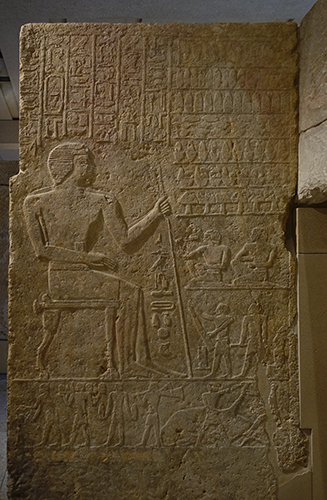
Fourth Dynasty: 2 613 BC - 2 494 BC
Burial Chamber of Merib, circa 2 500 BC.
This is the interior panel to the left of the entry to the burial chamber.
Catalog: Giza, Ostfriedhof, Grab Nr 70 limestone, ÄM 1107
Photo: Don Hitchcock 2018
Source: Original, Staatliche Museen zu Berlin, Neues Museum, Germany
Text: © Card at the Staatliche Museen zu Berlin, (CC BY-NC-SA 3.0 DE)
Fourth Dynasty: 2 613 BC - 2 494 BC
Burial Chamber of Merib, circa 2 500 BC.
This is the interior panel to the right of the entry to the burial chamber.
Catalog: Giza, Ostfriedhof, Grab Nr 70 limestone, ÄM 1107
Photo: Don Hitchcock 2018
Source: Original, Staatliche Museen zu Berlin, Neues Museum, Germany
Text: © Card at the Staatliche Museen zu Berlin, (CC BY-NC-SA 3.0 DE)
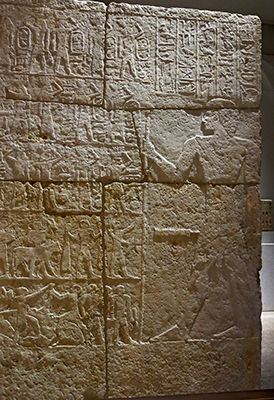
Fourth Dynasty: 2 613 BC - 2 494 BC
Burial Chamber of Merib, circa 2 500 BC.
Closeups of each of the panels on the other side of the main door.
Catalog: Giza, Ostfriedhof, Grab Nr 70 limestone, ÄM 1107
Photo: Don Hitchcock 2015
Source: Original, Staatliche Museen zu Berlin, Neues Museum, Germany
Text: © Card at the Staatliche Museen zu Berlin, (CC BY-NC-SA 3.0 DE)
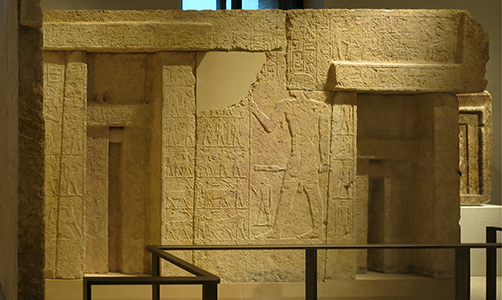
Fourth Dynasty: 2 613 BC - 2 494 BC
Burial Chamber of Merib, circa 2 500 BC.
This part of the complex was off by itself. It is probably the rear wall of the chamber, and has two false doors.
The 'exploded' arrangement means that there is less pressure on the exhibits in terms of touching and damage, and there is more room for visitors to move around, and view the display from a comfortable distance, and more can view the exhibits at any given time.
( note that there are two false doors in this wall - Don )
Catalog: Giza, Ostfriedhof, Grab Nr 70 limestone, ÄM 1107
Photo: Don Hitchcock 2015
Source: Original, Staatliche Museen zu Berlin, Neues Museum, Germany
Text: © Card at the Staatliche Museen zu Berlin, (CC BY-NC-SA 3.0 DE)
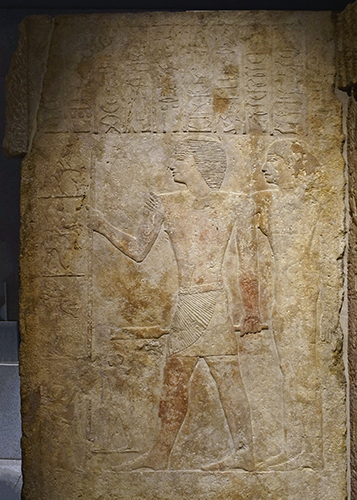
Fourth Dynasty: 2 613 BC - 2 494 BC
Burial Chamber of Merib, circa 2 500 BC.
This panel is on the left side at right angles to the rear wall of the chamber shown above.
Catalog: Giza, Ostfriedhof, Grab Nr 70 limestone, ÄM 1107
Photo: Don Hitchcock 2018
Source: Original, Staatliche Museen zu Berlin, Neues Museum, Germany
Text: © Card at the Staatliche Museen zu Berlin, (CC BY-NC-SA 3.0 DE)
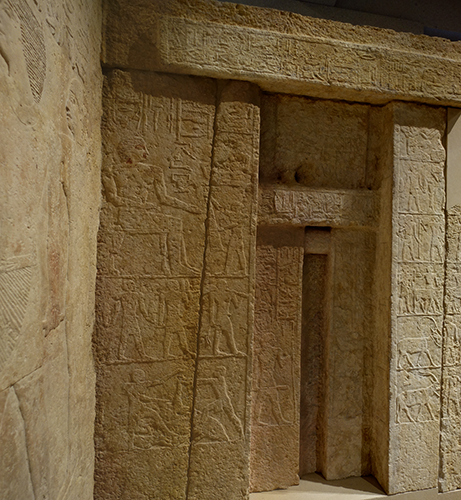
Fourth Dynasty: 2 613 BC - 2 494 BC
Burial Chamber of Merib, circa 2 500 BC.
This shows how the side panel abuts the rear wall of the burial chamber.
This shows the left side false door.
Catalog: Giza, Ostfriedhof, Grab Nr 70 limestone, ÄM 1107
Photo: Don Hitchcock 2018
Source: Original, Staatliche Museen zu Berlin, Neues Museum, Germany
Text: © Card at the Staatliche Museen zu Berlin, (CC BY-NC-SA 3.0 DE)
Fourth Dynasty: 2 613 BC - 2 494 BC
Burial Chamber of Merib, circa 2 500 BC.
The rest of the back wall in closeup.
The right hand false door is shown in the right hand image.
Catalog: Giza, Ostfriedhof, Grab Nr 70 limestone, ÄM 1107
Photo: Don Hitchcock 2018
Source: Original, Staatliche Museen zu Berlin, Neues Museum, Germany
Text: © Card at the Staatliche Museen zu Berlin, (CC BY-NC-SA 3.0 DE)
Fourth Dynasty: 2 613 BC - 2 494 BC
Cylinder seals
Cylinder seals with names of the kings Khephren / Khafra, Menkaure and Shepseskaf.
Catalog: Saqqara, Basalt, Chrysoprase, ÄM 8064, ÄM 16955, ÄM 14962
Photo: Don Hitchcock 2018
Source: Original, Staatliche Museen zu Berlin, Neues Museum, Germany
Text: © Card at the Staatliche Museen zu Berlin, (CC BY-NC-SA 3.0 DE)
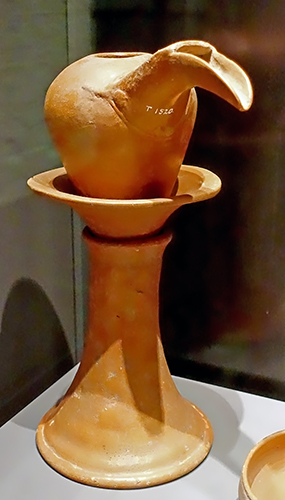
Fourth Dynasty: 2 613 BC - 2 494 BC
Washing Set
Washing set: stand, basin, and ewer, circa 2 600 BC.
Catalog: Ceramic, El-Mahasna, ÄS 4745, ÄS 2751, ÄS 2752
Photo: Don Hitchcock 2018
Source: Original, Ägyptischen Museum München
Text: Museum card, © Ägyptischen Museum München
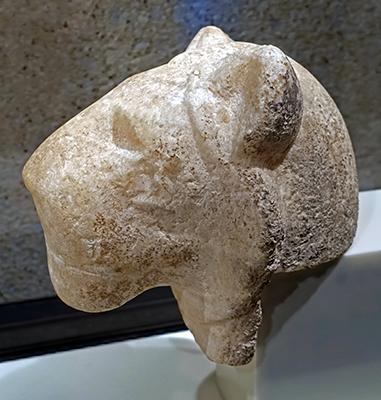
Fourth - Fifth Dynasty: 2 613 BC - 2 345 BC
Lion Head
Head of a lion from an embalming table (?)
Dimensions 195 mm x 150 mm x 205 mm.
This masterfully formed lion's head is unfinished and probably for this very reason illustrates the considered design and stylisation that has remained valid for centuries. The head has an infill at the back with a dowel hole in the horizontal cut surface. This suggests the use of the head as a decoration of an apparently monumental piece of furniture related to the cult and made of other material, such as a throne or a bed, a sacrificial slab or a table, as used by the mummifiers. Such furniture was often designed so that the sides of the frame and the feet represented a lion.
Catalog: Calcite/Alabaster (travertine), ÄM 21762
Photo: Don Hitchcock 2018
Source: Original, Staatliche Museen zu Berlin, Neues Museum, Germany
Text: © Card at the Staatliche Museen zu Berlin, http://www.smb-digital.de/ (CC BY-NC-SA 3.0 DE)
The Fifth Dynasty: 2 494 BC - 2 345 BC.
The Fifth Dynasty of ancient Egypt (notated Dynasty V) is combined with Dynasties III, IV and VI under the group title the Old Kingdom.
The names in the table are taken from Dodson and Hilton (2004).
| Fifth Dynasty | ||||||
|---|---|---|---|---|---|---|
| Name | Personal Name | Consort | Pyramid | Years | Dates | Comment |
| Userkaf | Irimaat | Khenkaus I, Neferhetepes | Pyramid in Saqqara | 7 | 2 494 BC - 2 487 BC | Userkaf's reign heralded the ascendancy of the cult of Ra, who effectively became Egypt's state god during the Fifth Dynasty. Userkaf may have been a high-priest of Ra before ascending the throne, and built a sun temple, known as the Nekhenre, between Abusir and Abu Gurab. In doing so, he instituted a tradition followed by his successors over a period of 80 years. Userkaf built a pyramid in Saqqara close to that of Djoser, a location that forced architects to put the associated mortuary temple in an unusual position, to the south of the pyramid. |
| Sahure | Nebkhau | Neferetnebty | Pyramid in Abusir | 12 | 2 487 BC - 2 475 BC | Sahure's reign marks the political and cultural high point of the Fifth Dynasty. During Sahure's rule, Egypt had important trade relations with the Levantine coast. Sahure launched several naval expeditions to modern-day Lebanon to procure cedar trees, slaves and exotic items. His reign may have witnessed the flourishing of the Egyptian navy, which included a high-seas fleet as well as specialised racing boats. |
| Neferirkare Kakai | Neferirkare | Khentaus II | Pyramid in Abusir | 20 | 2 475 BC - 2 455 BC | Neferirkare was acknowledged by his contemporaries as a kind and benevolent ruler. His rule witnessed a growth in the number of administration and priesthood officials, who used their expanded wealth to build architecturally more sophisticated mastabas, where they recorded their biographies for the first time. |
| Neferefre | Neferkau | Khentakawess III | Unfinished Pyramid of Neferefre in Abusir | 3 | 2 455 BC - 2 452 BC | Neferefre started a pyramid for himself in the royal necropolis of Abusir. The pyramid was never finished, with a mason's inscription showing that works on the stone structure were abandoned during or shortly after the king's second year of reign. Neferefre was nonetheless buried in his pyramid, hastily completed in the form of a mastaba by his second successor and presumably younger brother, pharaoh Nyuserre Ini. Fragments of his mummy were uncovered there, showing that he died in his early twenties. |
| Shepseskare | Shepseskare | Possibly in Abusir, a cemetery for Memphis | 8 | 2 452 BC - 2 444 BC | Egypt was unified at the time of Shepseskare's reign, with its capital located at Memphis. Only two cylinder seals of Shepseskare are known: one, made of bronze, bears Shepseskare's Horus name and was uncovered in the ruins of Memphis in the early 20th century. The second seal, of unknown provenance, is made of black serpentine and reads 'Shepseskare beloved of the gods, Shepseskare beloved of Hathor'. | |
| Nyuserre Ini | Nyuserre | Reptynub | Pyramid in Abusir | 24 | 2 445 BC - 2 421 BC | Nyuserre was the most prolific builder of his dynasty, having built three pyramids for himself and his queens and completed a further three for his father, mother and brother, all in the necropolis of Abusir. There is little evidence for military action during Nyuserre's reign, the Egyptian state continued to maintain trade relations with Byblos on the Levantine coast and to send mining and quarrying expeditions to Sinai and Lower Nubia. Nyuserre's reign saw the growth of the administration, and the effective birth of the nomarchs, provincial governors who, for the first time, were sent to live in the provinces they administered rather than at the pharaoh's court. |
| Menkauhor Kaiu | Menkauhor | Meresankh IV | 'Headless Pyramid' in Saqqara | 7 | 2 421 BC - 2 414 BC | Few artefacts from the reign of Menkauhor have survived, apart from a statue in the Cairo Museum. Beyond the construction of monuments, the only known activity dated to Menkauhor's reign is an expedition to the copper and turquoise mines in Sinai. Menkauhor was buried in a small pyramid in Saqqara. Known today as the Headless Pyramid, the ruin had been lost under shifting sands until its rediscovery in 2008. |
| Djedkare Isesi | Djedkare | Pyramid in Saqqara | 39 | 2 414 BC - 2 375 BC | Djedkare commissioned expeditions to Sinai to procure copper and turquoise, to Nubia for its gold and diorite and to the fabled Land of Punt for its incense. The word 'Nub', meaning gold, to designate Nubia is first recorded during Djedkare's reign. Under his rule, Egypt also entertained continuing trade relations with the Levantine coast and made punitive raids in Canaan. In particular, one of the earliest depictions of a battle or siege scene was found in the tomb of one of Djedkare's subjects. | |
| Unas | Wadjtawy | Nebet, Khenut | Pyramid in Saqqara | 30 | 2 375 BC - 2 345 BC | The reign of Unas was a time of economic decline. Egypt did maintain trade relations with the Levantine coast and Nubia however, and military action may have taken place in southern Canaan. The growth and decentralisation of the administration in conjunction with the lessening of the king's power continued under Unas, ultimately contributing to the collapse of the Old Kingdom some 200 years later. |
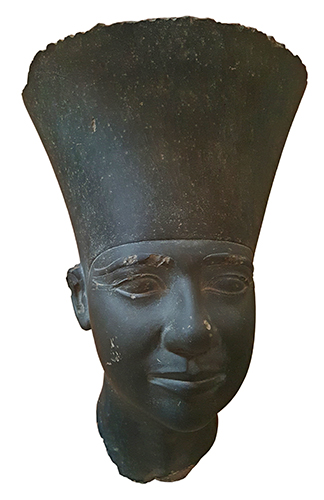
Fifth Dynasty: 2 494 BC - 2 345 BC.
Userkaf
Head of Userkaf, recovered from his sun temple.
Photo: Ovedc
Permission: Creative Commons Attribution-Share Alike 4.0 International license
Source: Egyptian Museum, Cairo
Material: Schist
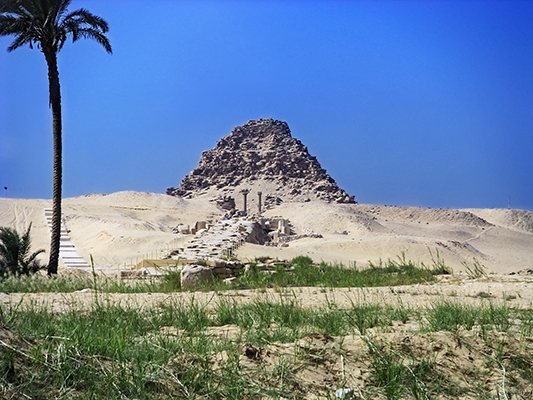
Fifth Dynasty: 2 494 BC - 2 345 BC.
The Pyramid of Sahure
The Pyramid of Sahure is a pyramid complex built for the Egyptian pharaoh Sahure of the Fifth Dynasty, who reigned during the period 2 487 BC - 2 475 BC.
Sahure built the inaugural pyramid in Abusir after his direct predecessor, Userkaf, built his sun temple in the same area. Sahure's successors, Neferirkare Kakai, Neferefre, and Nyuserre Ini all built their monuments in the general vicinity.
The monument consists of a main pyramid, a mortuary temple adjacent to the east face, with a cult pyramid to its south, a valley temple on Abusir Lake, and a causeway linking the complex. The layout was developed by Sahure and adopted by succeeding kings of the Fifth and Sixth Dynasty, thus representing a milestone in pyramid complex construction. The monumentality of these constructions was drastically diminished, but, in tandem, the decorative program proliferated and temples were augmented by greater storeroom complexes.
The monument is estimated to have had 10 000 m2 of finely carved relief adorning its walls, of which a mere 150 m2 has been preserved. Certain of these preserved reliefs are considered unrivalled in execution, such as a massive 8 m by 3 m hunting scene from the mortuary temple. The temple itself is remarkable for the array of valuable materials – such as granite, alabaster and basalt – that were used in its construction.
The main pyramid had a stepped core built from roughly hewn limestone blocks secured with mud mortar, that were encased with fine white Tura limestone. Adjacent to its eastern face, the mortuary temple was built consisting of five basic elements: an entrance hall, an open courtyard, a five niche statue chapel, an offering room and storerooms. These had been used in mortuary temples since the reign of Khafre, but here again, Sahure's layout was adopted as standard in all subsequent such temples in the Old Kingdom.
At the south-east corner of the main pyramid lay the enclosure of the cult pyramid, accessible either via a secondary entrance or a transverse corridor. The transverse corridor acted as an intersection separating the public and intimate temples, and connecting the various elements of the temple together. Beyond the temple's entrance hall, a 235 m long causeway led to the valley temple sited on the Abusir lake. In its rectangular plan, the valley temple had two entrances: its main entrance on its east side, and an unexpected secondary entrance on its south. It remains unclear why a second entry point was built, though it may have been connected to a pyramid town to its south.
Sahure's temple became the object of a cult of Sekhmet around the Eighteenth Dynasty. The growing interest in Abusir heralded the first wave of destruction visited upon the site's monuments. Sahure may have escaped this battering, a protection afforded it by the cult. Later, in the Twenty-Fifth and Twenty-Sixth Dynasties, the monuments once again stirred interest, as evidenced by the copying of the monument's relief decorations.
Taharqa had various of Sahure's, Nyuserre's and Pepi II's reliefs copied for the restoration of the temple of Kawa (Sudan) in Nubia. In the Twenty-Seventh Dynasty, the Abusir monuments endured a second wave of destruction. Yet, Sahure's cult of Sekhmet may have saved it once more. The cult lasted until the Ptolemaic Kingdom, but by this time its influence had waned significantly.
With the onset of the Roman period, the Abusir monuments, this time including Sahure's, were subjected to the third wave of destruction. Later, at the beginning of the Christian era, Sahure's temple became the site of a Coptic shrine, as evidenced by the recovery of pottery and graffiti dating to between the fourth and seventh century AD. From then on, until the late nineteenth century, the monuments were periodically farmed for limestone.
Photo: Sebi
Permission: Public Domain
Source: Wikimedia Commons
Text: Wikipedia
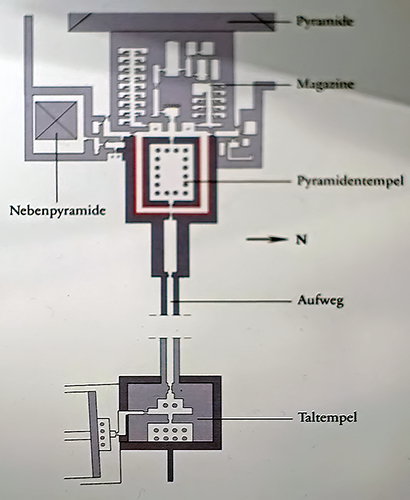
Fifth Dynasty: 2 494 BC - 2 345 BC.
Mortuary Temple of Sahure
Pyramide - Pyramid
Nebenpyramide - Secondary pyramid
Magazine - Storerooms
Pyramidentempel - Pyramid temple
Aufweg - Causeway
Taltempel - Valley temple
Rephotography: Don Hitchcock 2018
Source: Unknown artist, Poster, Staatliche Museen zu Berlin, Neues Museum, Germany
© (CC BY-NC-SA 3.0 DE)
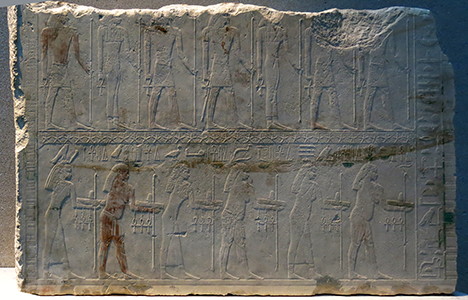
Fifth Dynasty: 2 494 BC - 2 345 BC.
Pharaoh Sahure
Procession of deities from the funerary temple of Pharaoh Sahure.
( note that there are alternate slim female, and heavier, perhaps older, male figures in the lower row of this relief - Don )
Catalog: Painted limestone, Abusir, Funerary temple of Pharaoh Sahure, ÄM 21784
Photo: Don Hitchcock 2015
Source: Original, Staatliche Museen zu Berlin, Neues Museum, Germany
Text: © Card at the Staatliche Museen zu Berlin, http://www.smb-digital.de/, (CC BY-NC-SA 3.0 DE)
Additional reference: https://www.deutsche-digitale-bibliothek.de/item/JS4W4DQB4NR6VUN2REWDIVLWTYK5AD6E
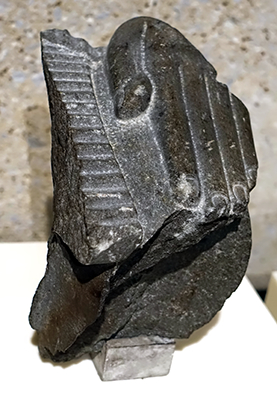
Fifth Dynasty: 2 494 BC - 2 345 BC.
Pharaoh Sahure
Fragment of the left hand of a seated statue of King Sahure.
Catalog: Painted Anorthositic Gneiss, Abusir, Funerary temple of Pharaoh Sahure, ÄM 19912
Photo: Don Hitchcock 2018
Source: Original, Staatliche Museen zu Berlin, Neues Museum, Germany
Text: © Card at the Staatliche Museen zu Berlin, (CC BY-NC-SA 3.0 DE)
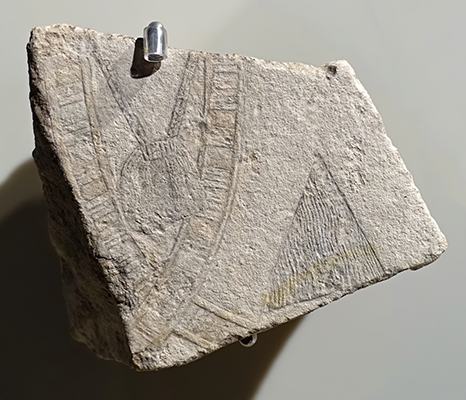
Fifth Dynasty: 2 494 BC - 2 345 BC.
Female dancer
Relief fragment showing a female dancer from the funerary temple of Pharaoh Sahure.
Catalog: Painted limestone, Abusir, Funerary temple of Pharaoh Sahure, ÄM 28602
Photo: Don Hitchcock 2015
Source: Original, Staatliche Museen zu Berlin, Neues Museum, Germany
Text: © Card at the Staatliche Museen zu Berlin, (CC BY-NC-SA 3.0 DE)
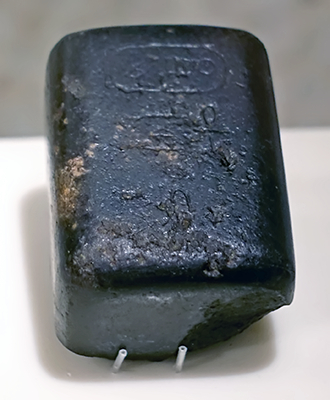
Fifth Dynasty: 2 494 BC - 2 345 BC.
Standard Weight
Stone weight with the name of King Sahure and weight specification of 10 deben.
Circa 2 487 BC - 2 475 BC.
( at this time, in the old kingdom, a deben was about 13.6 grams, so this weight should be of the order of 136 grams - Don )
Dimensions: 31 mm x 36 mm x 48 mm.
The polished stone weight is labelled with the name of King Sahure and the weight 10 deben. The Deben has been a weight measurement since the Old Kingdom. Its value changed over time from around 13.6 grams in the Old Kingdom to around 91 grams in the New Kingdom. With its actual weight of 134 grams, this weight corresponds almost exactly to the value of 10 deben.
Catalog: Greywacke (Basalt is given as the material on http://www.smb-digital.de/), ÄM 22635
Photo: Don Hitchcock 2018
Source: Original, Staatliche Museen zu Berlin, Neues Museum, Germany
Text: © Card at the Staatliche Museen zu Berlin, http://www.smb-digital.de/, (CC BY-NC-SA 3.0 DE)
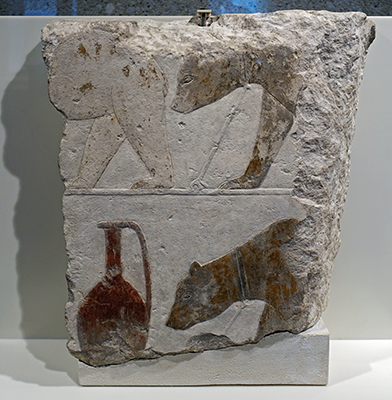
Fifth Dynasty: 2 494 BC - 2 345 BC.
Relief fragment, circa 2 487 BC - 2 475 BC.
Relief fragment showing Syrian bears and a vessel, from the Mortuary Temple of Sahure, at the north side of the courtyard.
Dimensions: 390 x 350 x 85 mm.
The painted relief shows two Syrian brown bears (Ursus arctos syriacus) and a handled mug. The bears each wear a collar and are tied to a bracket in the ground with a rope. Even if the bears are not completely preserved, the careful and masterful rendering of the animals impresses and shows how closely the Egyptian artists observed their motifs.
Bears were not native to Egypt. The kings liked to keep such exotic animals in enclosures, but they also hunted them. This was intended to demonstrate political and military power over foreign countries.
Only a small fraction of the reliefs from the pyramid temple of Sahure has been preserved. These include illustrations of tributes and exotic trade or barter goods from the Levant, such as the brown bears or handled vessels for precious oils and wines. In addition, we have preserved representations of court people decorated with official seals or awards. One example is the small fragment with the emblem of the goddess Bat, depicted as a human face with cow ears and horns. By the time of the Middle Kingdom, her identity and attributes were subsumed within the goddess Hathor.
Catalog: Abusir, Mortuary Temple of Sahure, at the north side of the courtyard, painted limestone, ÄM 21828
Photo: Don Hitchcock 2018
Source: Original, Staatliche Museen zu Berlin, Neues Museum, Germany
Text: © Card at the Staatliche Museen zu Berlin, http://www.smb-digital.de/, (CC BY-NC-SA 3.0 DE)
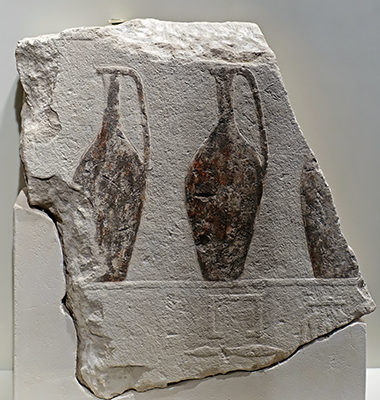
Fifth Dynasty: 2 494 BC - 2 345 BC.
Relief fragment, circa 2 487 BC - 2 475 BC.
Relief fragment showing handled vessels, from the Mortuary Temple of Sahure, at the north side of the courtyard.
Dimensions: 360 x 332 x 70 mm.
Two handled vessels are shown. Of a third, just under half of the vascular abdomen can still be seen.
Such vessels have been imported into Egypt from Canaan, today's Syrian-Palestinian region, since the early dynastic period. This is evidenced by finds in some royal tombs of the first two dynasties in Abydos.
The jars could have contained precious oils, resins and other ingredients as imported goods or else they were filled on site after their arrival in Egypt.
Catalog: Abusir, Mortuary Temple of Sahure, at the north side of the courtyard of the temple, painted limestone, ÄM 21831
Photo: Don Hitchcock 2018
Source: Original, Staatliche Museen zu Berlin, Neues Museum, Germany
Text: © Card at the Staatliche Museen zu Berlin, http://www.smb-digital.de/, (CC BY-NC-SA 3.0 DE)
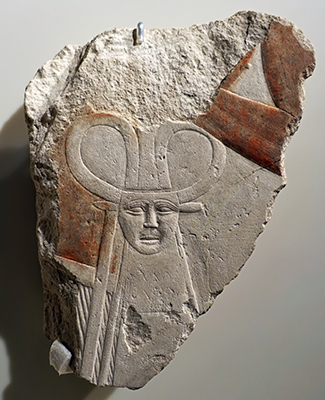
Fifth Dynasty: 2 494 BC - 2 345 BC.
Relief fragment, circa 2 487 BC - 2 475 BC.
Relief fragment showing the cow-headed goddess Bat, later to be merged with the goddess Hathor.
She was originally a deification of the Milky Way (which was compared to a pool of cows milk). Her name is the feminine form of the word 'ba', the name of one of the major elements of the soul. She was associated with the ankh (the symbol of life or breath) and with the sistrum, which was also associated with Hathor. Her cult centre was in Sheshesh (the seventh nome of Upper Egypt) known as the 'Mansion of the Sistrum'.
Dimensions: 190 x 150 x 45 mm.
The central focus of the relief fragment is a human face with cow ears. Although this type of representation has been used for the goddess Hathor since the Old Kingdom, in this case it is an image of the goddess Bat. Bat, the goddess of the 7th Upper Egyptian Nome, has been documented since early times. On the King Narmer Palette, Bat flanks the top of both sides.
In addition to the human face and the cow's ears, as with Hathor, a cow's horn is another characteristic feature of this deity, with the horns, curling inward, being rendered stylised as a spiral over time.
The imagery of Bat as a divine cow was remarkably similar to that of Hathor, a parallel goddess from Lower Egypt. In two dimensional images, both goddesses often are depicted straight on, facing the onlooker and not in profile in accordance with the usual Egyptian convention. The significant difference in their depictions is that Bat's horns curve inward and Hathor's curve outward slightly. It is possible that this could be based in the different breeds of cattle herded at different times.
Hathor's cult center was in the 6th Nome of Upper Egypt, adjacent to the 7th where Bat was the cow goddess, which may indicate that they were once the same goddess in Predynastic Egypt. By the Middle Kingdom, the cult of Hathor had again absorbed that of Bat in a manner similar to other mergers in the Egyptian pantheon.
From the 4th Dynasty until the late period, high dignitaries wore the Bat emblem either as an amulet or as a separate piece of jewellery on their clothing. It could be either attached to, or hung from a belt.
Catalog: Painted limestone, Abusir, Mortuary Temple of Sahure, ÄM 28595
Photo: Don Hitchcock 2018
Source: Original, Staatliche Museen zu Berlin, Neues Museum, Germany
Text: © Card at the Staatliche Museen zu Berlin, http://www.smb-digital.de/, (CC BY-NC-SA 3.0 DE)
Additional text: Wikipedia, https://ancientegyptonline.co.uk/bat/
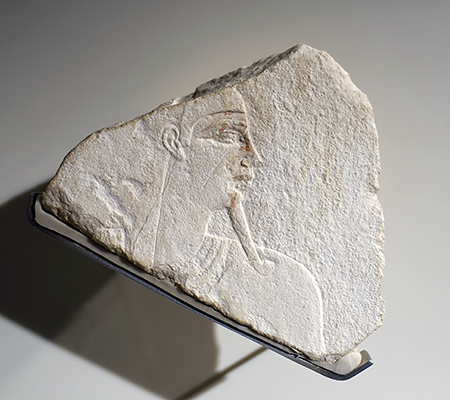
Fifth Dynasty: 2 494 BC - 2 345 BC.
Relief fragment, circa 2 487 BC - 2 475 BC.
Relief fragment from the Mortuary Temple of the Sahure: head of a male deity.
Brown paint residues on the face indicate a male. The small face is depicted in profile according to the ancient Egyptian principles of representation, while the right eye is shown frontally. On the chin is a narrow ceremonial beard that is bent outwards at the lower end. As headgear, the sitter wears a long wig that reaches back. A collar adorns the neck.
The beads in the necklace are marked by small circles. The style of the figure with its beard and wig shape can be found in various representations of gods in the Sahure temple. Thus, this is an image of a deity.
Dimensions: 137 x 175 x 90 mm.
Catalog: Painted limestone, Abusir, Mortuary Temple of Sahure, ÄM 28658
Photo: Don Hitchcock 2018
Source: Original, Staatliche Museen zu Berlin, Neues Museum, Germany
Text: © Card at the Staatliche Museen zu Berlin, http://www.smb-digital.de/, (CC BY-NC-SA 3.0 DE)
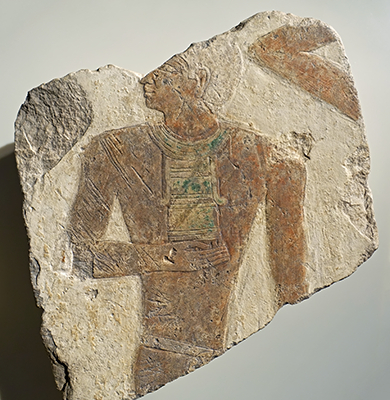
Fifth Dynasty: 2 494 BC - 2 345 BC.
Relief fragment, circa 2 487 BC - 2 475 BC.
Relief fragment from the Mortuary Temple of Sahure.
Dimensions: 280 x 243 x 60 mm.
The depicted figure shows the brown skin colour characteristic of men. Although he looks to his right, as can be seen from the lower part of the buttocks preserved at the bottom of the relief, he is shown walking to his left. The man wears a short hair wig typical of this time as headgear. The hand is horizontal, and supports a solid pectoral, which is attached to a wide necklace.
The visible yellow and green traces of colour make it clear that the pectoral was partly made of gold and decorated with faience and semi-precious stone beads. The man is clothed only with a scarf that was placed around the waist and tied at the belly, the two ends of the scarf hanging down and covering the loins, as can be seen on the relief, while the buttocks are bare. The pectorals of ancient Egypt were a form of jewellery. They were mostly worn by richer people and the pharaoh.
Catalog: Painted limestone, Abusir, Mortuary Temple of Sahure, northern transverse space, ÄM 28593
Photo: Don Hitchcock 2018
Source: Original, Staatliche Museen zu Berlin, Neues Museum, Germany
Text: © Card at the Staatliche Museen zu Berlin, http://www.smb-digital.de/, (CC BY-NC-SA 3.0 DE)
Additional text: Wikipedia
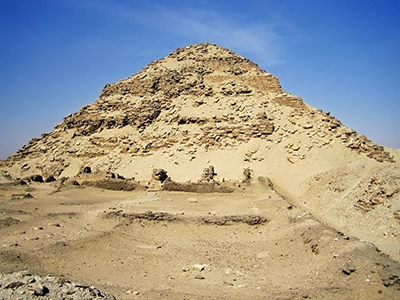
Fifth Dynasty: 2 494 BC - 2 345 BC.
Pyramid of Neferirkare Kakai
The pyramid of Neferirkare Kakai is located in the royal necropolis of Abusir. It is the largest one built during the Fifth Dynasty, equalling roughly the size of the Pyramid of Menkaure.
The pyramid of Neferirkare is surrounded by smaller pyramids and tombs which seem to form an architectural unit, the cemetery of his close family. This ensemble was meant to be reached from the Nile via a causeway and a valley temple near the river. At the death of Neferirkare, only the foundations of both had been laid and Nyuserre later diverted the unfinished causeway to his own pyramid.
Photo: Aoswch (Axel Seedorff)
Permission: Creative Commons Attribution-Share Alike 2.0
Additional text: Wikipedia
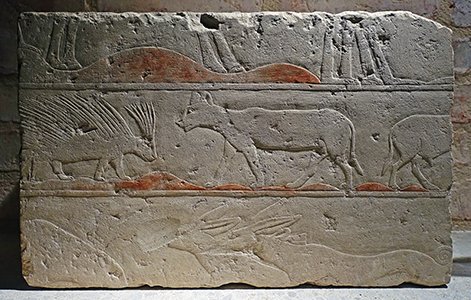
Fifth Dynasty: 2 494 BC - 2 345 BC.
Fragment of a relief
The relief shows animals of the desert, including a porcupine and a feline.
The ostensible subject of this detail of a relief found in the tomb of Pehen-wi-ka at Saqqara is a hunt in the desert. However, its three registers show only one act of violence: at the right side of the bottom register, a canine (identified as a domesticated dog by the collar around its neck) has sunk its fangs into the neck of a wild jackal.
Most prominent among the rest of the animals, which seem to pursue their lives peacefully in the hilly savanna, is a porcupine that confronts a rather weary feline in the middle register. The only known representation in Egyptian art of this spiky creature, it is a magnificent characterisation.
Catalog: Saqqara, Grave of Pehenuka, limestone, ÄM 1132
Photo: Don Hitchcock 2018
Source: Original, Staatliche Museen zu Berlin, Neues Museum, Germany
Text: © Card at the Staatliche Museen zu Berlin, (CC BY-NC-SA 3.0 DE)
Additional text: Staff of the Metropolitan Museum of Art (1999)
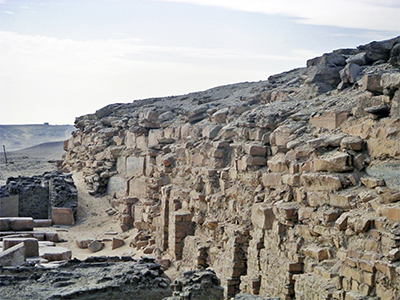
Fifth Dynasty: 2 494 BC - 2 345 BC.
Pyramid of Neferefre
View of the foundations of the pyramid of Neferefre and the ruins of the funerary temple at Abusir.
The pyramid was hastily converted into a square mastaba or primeval mound after Neferefre's early death.
Photo: Sebi
Permission: Public Domain
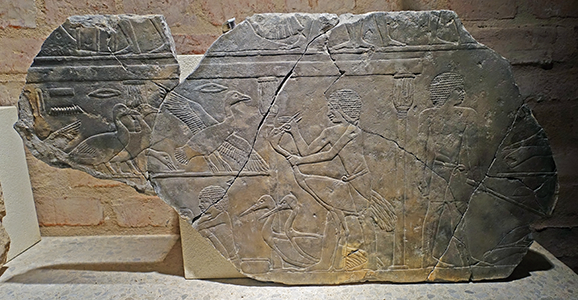
Fifth Dynasty: 2 494 BC - 2 345 BC.
Tomb relief: force feeding of cranes.
Sheep, goats, cattle, pigs and geese were raised from earliest times and supplied milk, wool, meat, eggs, leather, skins, horn and fat. Even the dung had its uses. There is little evidence that mutton was consumed, while domesticated pigs were eaten at least since the beginning of the 4th millennium BC, but pork had no place in religious ceremonies.
Goat meat on the other hand was acceptable even to upper class Egyptians. Goat skins served as water containers and floating devices.
The Egyptian farmers, in their early experimental phase, also tried to domesticate other animals such as hyenas, gazelles and cranes, but abandoned these attempts after the Old Kingdom. Here they are shown force feeding cranes, as part of the failed attempt at domestication.
Catalog: Saqqara, Mastaba of Sopduhotep, limestone, ÄM 14642
Photo: Don Hitchcock 2018
Source: Original, Staatliche Museen zu Berlin, Neues Museum, Germany
Text: © Card at the Staatliche Museen zu Berlin, (CC BY-NC-SA 3.0 DE)
Additional text: http://www.reshafim.org.il/ad/egypt/timelines/topics/domesticated_animals.htm
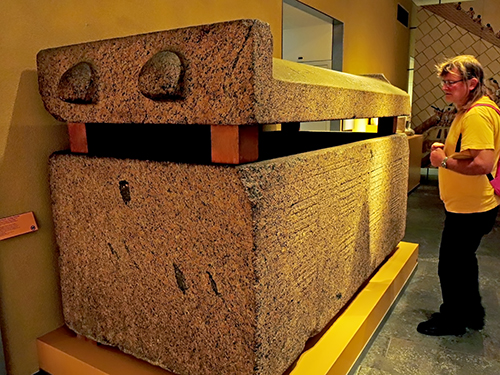
Fifth Dynasty: 2 494 BC - 2 345 BC.
Sarcophagus
Sarcophagus of Minnofer. Granite, location Saqqara circa 2416 BC - 2356 BC, Nioesserre-Djedkare, (Niuserre-Djedkare/Isesi), 5th Dynasty.
Minnofer was vizier (viceroy) in Egypt's capital Memphis. The walls of his sarcophagus show a palace facade with many windows and doors. The domed lid symbolises heaven.
The sarcophagus was in Minnofer's huge mastaba or tomb-house, but was removed around 1825. Then the tomb became covered again under shifting sands. Because the place where the finds were made was not recorded at the time, Minnofer's grave was found again only in 1987.
A mastaba (meaning 'house for eternity' or 'eternal house'), is a type of ancient Egyptian tomb in the form of a flat-roofed, rectangular structure with outward sloping sides, constructed out of mud-bricks (from the Nile River) or stone. Mastabas marked the burial sites of many eminent Egyptians during Egypt's Early Dynastic Period and Old Kingdom. During the Old Kingdom, kings began to be buried in pyramids instead of mastabas, although non-royal use of mastabas continued for more than a thousand years.
Photo: Don Hitchcock 2014
Source: Original, Rijksmuseum van Oudheden, National Museum of Antiquities, Leiden.
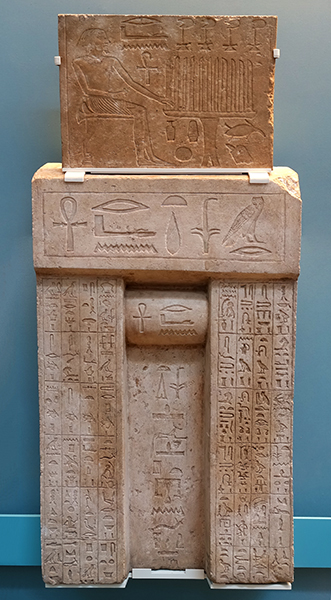
Fifth Dynasty: 2 494 BC - 2 345 BC.
Niankhre
Limestone false door stela of Niankhere, mid 5th Dynasty, about 2 450 BC.
This small false door comes from the mastaba-tomb of the Superintendent of the Hairdressers of the Palace, Niankhre / Nyankhra. On the rectangular panel at the top, the dead man sits before a table of offerings. The central door-niche is inscribed with the standard formula requesting offerings from a god, in this case Anubis. The two sides of the false door niche are inscribed with lists of funerary offerings, including foodstuffs, oils and incense.
In the central panel Nyankhra is shown in sunk relief seated before an offering table. The caption for the offering table is presented as if part of the pictorial scene, and reads in vertical lines. The hieroglyphs for the items are piled up under the offering table, and the word for 'fowl' is written with an usually full representation of the hieroglyph; usually only the head of a bird is portrayed, rather than the body.
 ( the hieroglyph for fowl used in this instance is Gardiner's number G54, a trussed goose or duck, on the right just below the offering table, Other hieroglyphs below the offering table include W22, a jug of beer, X2 a loaf of bread, X6 a round loaf of bread bearing the mark of the baker's fingers, and F1 the head of a cow - Don )
( the hieroglyph for fowl used in this instance is Gardiner's number G54, a trussed goose or duck, on the right just below the offering table, Other hieroglyphs below the offering table include W22, a jug of beer, X2 a loaf of bread, X6 a round loaf of bread bearing the mark of the baker's fingers, and F1 the head of a cow - Don )
Beside Nyankhra his name is written in a vertical line in the same direction as his figure, which is the determinative to his name. The lintel and drum carry Niankhre's name and principal title; the central panel of the doorway has a short ḥtp-di-nsw formula and both jambs carry offering-lists. Each jamb has 24 entries arranged in six rows. The signs are carved in good sunk relief. No colour remains. Inscription translation: A thousand of fowl, a thousand of flesh, a thousand of bread, a thousand of beer.
This type of scene represents the practice of the funerary cult, where food offerings were invoked for the dead before the false door of the tomb chapel.
Catalog: Limestone, Saqqara, EA1429
Photo: Don Hitchcock 2018
Source: Original, British Museum
Text: Card with the display at the British Museum, http://www.britishmuseum.org/, © Trustees of the British Museum, CC BY-NC-SA 4.0
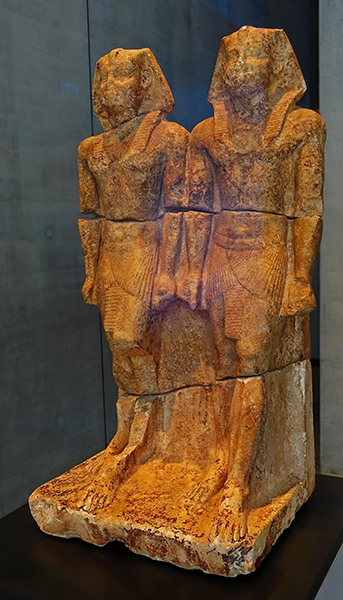
Fifth Dynasty: 2 494 BC - 2 345 BC.
Pharaoh Nyuserre
Double statue of Pharaoh Niuserre.
This piece shows Nyuserre as both a young and an old man.
Circa 2 390 BC
Catalog: Calcite, ÄS 6794
Photo: Don Hitchcock 2018
Source: Original, Ägyptischen Museum München
Text: © Ägyptischen Museum München
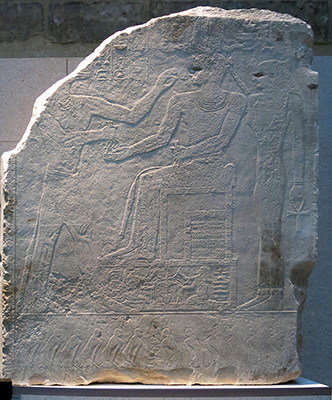
Fifth Dynasty: 2 494 BC - 2 345 BC.
Nyuserre
Pharaoh Niusere, protected by Wadjet, receives life from Anubis.
Niuserre (Ni-user-Re , also Niuserre Ini) was the sixth pharaoh of the ancient Egyptian 5th Dynasty in the Old Kingdom . He reigned during the period from 2455 to 2421 BC. The exact length of his reign is unclear, but the majority of the research has determined it to be 30 years or more. The royal necropolis of Abusir is strongly influenced by his extensive construction projects. These include the construction of his pyramid complex and a sun temple, but also the completion of the graves of his father, brother and mother.
Catalog: Limestone, Abusir, mortuary temple of Niuserê, ÄM 16100
Photo: Don Hitchcock 2015
Source: Original, Staatliche Museen zu Berlin, Neues Museum, Germany
Text: © Card at the Staatliche Museen zu Berlin, (CC BY-NC-SA 3.0 DE)
Additional text: Wikipedia
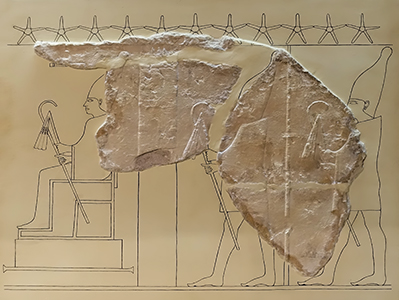
Fifth Dynasty: 2 494 BC - 2 345 BC.
Nyuserre Ini / Ne-user-Re
Relief of Pharaoh Nyuserre Ini, circa 2 360 BC
Catalog: Limestone, Abu Gorab, Nyuserre Sun Temple, Inv. Nr. 1935.200.443
Photo: Don Hitchcock 2018
Source and text: Original, Museum August Kestner, Hannover
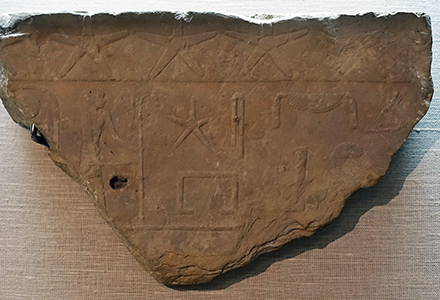
Fifth Dynasty: 2 494 BC - 2 345 BC.
Nyuserre Ini / Ne-user-Re
Relief of Pharaoh Nyuserre Ini, circa 2 360 BC
Catalog: Limestone, Abu Gorab, Nyuserre Sun Temple, Inv. Nr. 1935.200.443
Photo: Don Hitchcock 2018
Source and text: Original, Museum August Kestner, Hannover
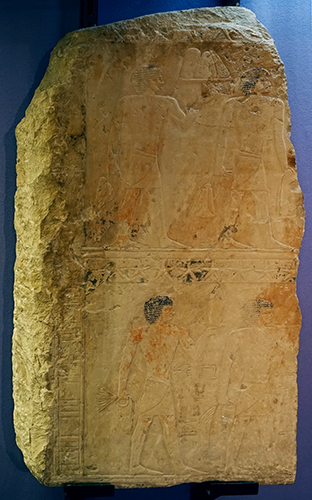
Fifth Dynasty: 2 494 BC - 2 345 BC.
Trench Diggers
Relief with four trench diggers, from the mortuary temple of Nyuserre, circa 2 360 BC.
Catalog: Limestone, Abusir, mortuary temple of Nyuserre, Inv. Nr. 1903.41
Photo: Don Hitchcock 2018
Source and text: Original, Museum August Kestner, Hannover
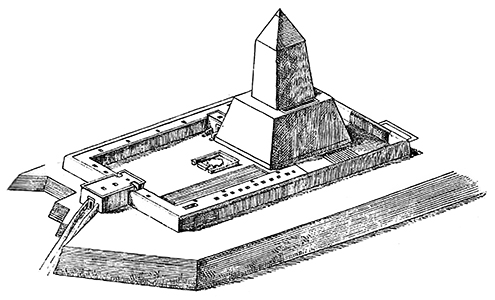
Fifth Dynasty: 2 494 BC - 2 345 BC.
Nyuserre Sun Temple
Temple of Pharaoh Nyuserre.
The Sun Temple of Nyuserre was excavated by Egyptologists Ludwig Borchardt and Friedrich Willhelm von Bissing sometime between 1898 and 1901, on behalf of the Berlin Museum. The sun temple is situated near Memphis, and is closely linked with the Abusir necropolis, both geographically and functionally.
The temple was constructed on the orders of Pharaoh Nyuserre Ini. Nyuserre also built a pyramid complex in what was then the royal necropolis, 1 km to the south of Abu Gorab in Abusir. The temple was probably constructed late during Nyuserre's reign. It was built in honour of the Egyptian Sun god Ra.
The temple consists of a rectangular walled enclosure, 100 by 76 metres with an entrance situated on the eastern face. The complex is primarily built out of mudbrick covered with limestone, and is situated on the shores of the ancient Abusir lake bed.
Drawing: Borchardt (1907)
Permission: Public Domain
Text: Adapted from Wikipedia
Fifth Dynasty: 2 494 BC - 2 345 BC.
Sed Festival
Temple relief with scenes from the Sed Festival.
Sun Temple of Pharaoh Nyuserre / Niuserre.
Circa 2 390 BC.
Catalog: Calcite, Abu Gurob, ÄGl. 181 a-b
Photo: Don Hitchcock 2018
Source: Original, Ägyptischen Museum München
Text: © Ägyptischen Museum München
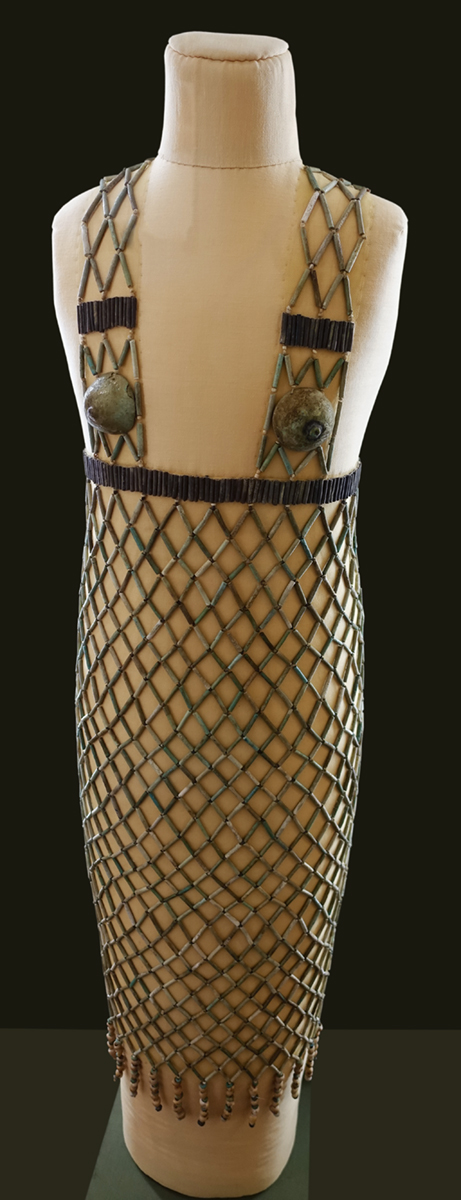
Fifth Dynasty: 2 494 BC - 2 345 BC.
Bead Dress
Part of a network dress of blue and black faience beads, mostly cylinders, and two blue and black faience breast 'caps', as well as a quantity of loose beads, and two strings of Mitra beads, probably part of the original dress. The back of the dress has not been reconstructed.
From Qau burial 978. The dress was found in a box in a niche at the foot of the grave. Because of its size, it is estimated to be suitable for a girl of 12 years old.
Reconstructed height 95 cm, width 24 cm, Accession Number LDUCE-UC17743.
The Egyptian bead net dress was for the most part a ceremonial dress. It was worn by a dancing girl for entertaining at banquets. Tomb carvings show banquet scenes showed unclothed servant girls carrying trays laden with delicacies. Without music and dance, no banquet was possible. From what we see on tomb paintings, music and dance played a big part in the lives of the ancient Egyptians, both in secular and religious activities. Male and female dancers and musicians would excite the festivities with harps, lyres and lutes which were all string instruments. They would also incorporate a type of oboe, which was most often played by women, and drums to keep up the beat of the music and the hearts of the guests. At the banquet, guests would be treated to dancing girls wearing jewels and lithe acrobats who twisted, jumped and turned. The musicians encouraged the guests to join in by chanting, clapping or playing tambourines or cymbals. The dress was also used by females in ceremonies where they would take a box of offerings to the Gods. As a funerary garment, the dress would have covered only the front body, however, a relatively large number of beaded shrouds have been used to wrap mummies from the twenty-first dynasty.
The Westcar papyrus relates a tale set during the reign of Sneferu, the first king of the Fourth Dynasty, 2 613 BC - 2 589 BC. The king was bored and his chief lector Djadjaemankh advises him to gather twenty young women and use them to sail him around the palace lake. Sneferu orders twenty beautiful oars made, and gives the women nets to drape around them as they sail.
However, one of the girls loses an amulet - a fish pendant made of turquoise so dear to her that she will not even accept a substitute from the royal treasury, and until it is returned to her neither she nor any of the other women will row. The king laments this, and the chief lector folds aside the water to allow the retrieval of the amulet, then folds the water back.
Photo: Don Hitchcock 2018
Source: Original, Petrie Museum, London, England
Text: Card / online catalogue, the Petrie Museum, © 2015 UCL. CC BY-NC-SA license.
Additional text: Hazel Sanchez, hazelsanchez.wordpress.com
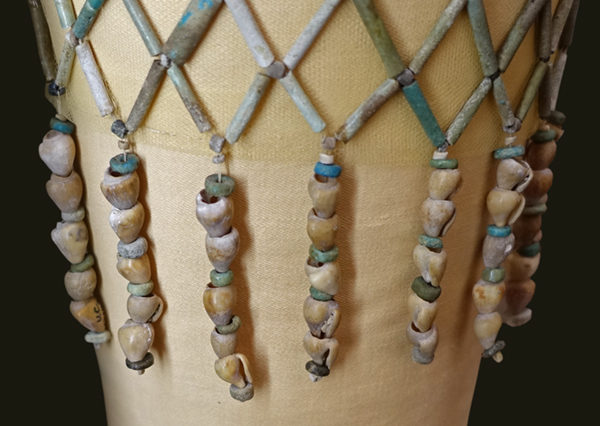
Fifth Dynasty: 2 494 BC - 2 345 BC.
Bead Dress
The dress was probably meant for dancers. Each of the 127 shells around the fringe contains a small stone, with the result that a rattling sound would be produced when the wearer danced.
Accession Number LDUCE-UC17743.
Photo: Don Hitchcock 2018
Source: Original, Petrie Museum, London, England
Text: Card / online catalogue, the Petrie Museum, © 2015 UCL. CC BY-NC-SA license.
Readers may be interested in this sculpture of a goddess who is also wearing a bead net dress, but created for a mature female figure.
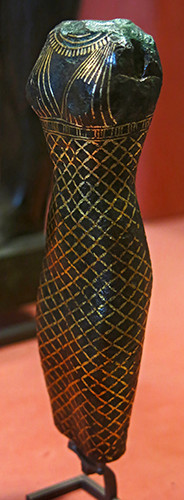
Date uncertain: 2 033 BC - 1069 BC
Body of a goddess
The Egyptians used an alloy of copper and tin (bronze) which is easier to melt and harder than pure copper ore. Egyptian bronzes also contain lead, which lowers the melting temperature. Some bronzes have a black patina that highlights the gold inlays.
Gold is not uncommon in the desert, east of the Nile, in Egypt and Nubia. Electrum, a natural alloy of gold and silver also occurs.
The 'black bronzes' are special alloys (copper, silver, gold) whose patina highlights the incrustations of metals in contrasting colours.
This inlay of yellow gold threads and red gold 'rivets', only visible in the full size images ( click on any image to zoom in ), imitates bead netting.
Height 12 cm.
Catalog: Sully, salle 7, E 27430
Photo: Don Hitchcock 2015
Source: Original, Musée du Louvre
Text: © Musée du Louvre
Fifth Dynasty: 2 494 BC - 2 345 BC.
Fragments of reliefs: fishing, agricultural scenes, fowling with dragnet, circa 2430 BC.
Abû Ghûrab. Sun Temple of Nyuserre / Neuserre. Room of the Seasons. This block shows two men in a boat netting mullet.
Catalog: Abu Gurob (or Abû Ghûrab), Sanctuary of Nyuserre / Neuserre /Niuserrê / Neuserre, ÄM 20039/1
Photo: Don Hitchcock 2018
Source: Original, Staatliche Museen zu Berlin, Neues Museum, Germany
Text: © Card at the Staatliche Museen zu Berlin, (CC BY-NC-SA 3.0 DE)
Additional text: http://www.griffith.ox.ac.uk/gri/3berlin.pdf
Fifth Dynasty: 2 494 BC - 2 345 BC.
Fragments of reliefs: fishing, agricultural scenes, fowling with dragnet, circa 2430 BC.
( the relief on the left appears to be the continuation of the netting of mullet scene above - Don )
Catalog: Abu Gurob, Sanctuary of Nyuserre / Niuserrê, ÄM 20039/2, ÄM 20038
Photo: Don Hitchcock 2018
Source: Original, Staatliche Museen zu Berlin, Neues Museum, Germany
Text: © Card at the Staatliche Museen zu Berlin, (CC BY-NC-SA 3.0 DE)
Fifth Dynasty: 2 494 BC - 2 345 BC.
Fragments of reliefs, circa 2430 BC.
Fragments of reliefs: Cheker Frieze, marsh with papyrus, vulture (Goddess Mut)
A Cheker ( frieze element (hieroglyph Aa30), determinative in hkr, 'adorn' - Don ) frieze is an ancient Egyptian top finish of ornamented wall panels, consisting of a succession of upright, bundled and knotted carpet fringes or reed bunches. These probably formed an early tapestry.
The paintings were typical of the mats hanging on the walls of ordinary houses. Even today, such reeds are used for the decoration of modern Egyptian wall tops. The friezes were originally used only in the royal tombs but were later adopted by private people as well.
Catalog: Abu Gurob, Sanctuary of Nyuserre / Niuserrê, painted limestone, ÄM 20039/3-4, ÄM 16102
Photo: Don Hitchcock 2018
Source: Original, Staatliche Museen zu Berlin, Neues Museum, Germany
Text: © Card at the Staatliche Museen zu Berlin, (CC BY-NC-SA 3.0 DE)
Additional text: German Wikipedia,
https://jguaa2.journals.ekb.eg/article_4767_cba6ea63ae976f77154bac3d9acfa352.pdf,
Allen (2014)
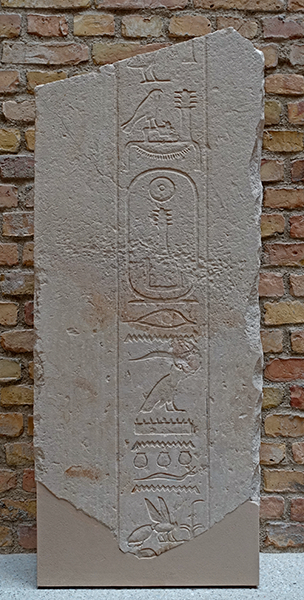
Fifth Dynasty: 2 494 BC - 2 345 BC.
Fragments of reliefs, circa 2430 BC.
Fragments of reliefs: details of various scenes with divinities (above), door reveal with king's name (left).
( http://www.griffith.ox.ac.uk/gri/3berlin.pdf states that the door reveal at left is ÄM 17933, a jamb with restoration - text of Isesi, re-used as threshold, from Abusir, Pyramid of Nyuserre / Neuserre, Mortuary Temple. Hall of Columns. Wikipedia states that it is a relief of Pharaoh Djedkare Isesi, the eighth ruler of the Fifth Dynasty. This seems unlikely, given the respective dates, unless the jamb was taken from the later pyramid to be used in restoration of this previous one - Don )
Catalog: Abu Gurob, Sanctuary of Nyuserre / Niuserrê, painted limestone, ÄM 16101, ÄM 16104, ÄM 17933
Photo: Don Hitchcock 2018
Source: Original, Staatliche Museen zu Berlin, Neues Museum, Germany
Text: © Card at the Staatliche Museen zu Berlin, (CC BY-NC-SA 3.0 DE)
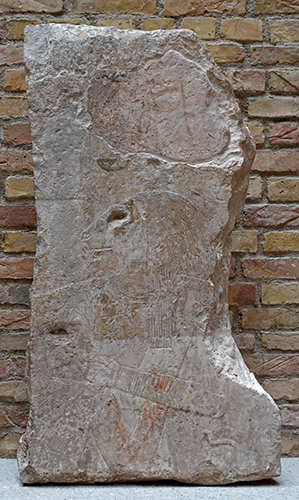
Fifth Dynasty: 2 494 BC - 2 345 BC.
Fragments of reliefs, circa 2430 BC.
Gods, celebratory procession of the 'Heb-Sed' festival of Nyuserre, goddess Sachmet.
Sekhmet, or Sakhmet, is a warrior goddess as well as goddess of healing. She is depicted as a lioness, the fiercest hunter known to the Egyptians. It was said that her breath formed the desert. She was seen as the protector of the pharaohs and led them in warfare. Upon death, Sekhmet continued to protect them, bearing them to the afterlife.
Catalog: Abu Gurob, Sanctuary of Nyuserre / Niuserrê, painted limestone, ÄM 16103, ÄM 20078, ÄM 17911
Photo: Don Hitchcock 2018
Source: Original, Staatliche Museen zu Berlin, Neues Museum, Germany
Text: © Card at the Staatliche Museen zu Berlin
Additional text: Wikipedia
Fifth Dynasty: 2 494 BC - 2 345 BC.
Fragments of reliefs, circa 2430 BC.
Agricultural scenes, animal husbandry, desert animals.
Catalog: Abu Gurob, Sanctuary of Nyuserre / Niuserrê, painted limestone, ÄM 20035/1-4, ÄM 20036/1-3
Photo: Don Hitchcock 2018
Source: Original, Staatliche Museen zu Berlin, Neues Museum, Germany
Text: © Card at the Staatliche Museen zu Berlin
Fifth Dynasty: 2 494 BC - 2 345 BC.
Fragments of reliefs, circa 2430 BC.
Agricultural scenes, animal husbandry, desert animals.
Catalog: Abu Gurob, Sanctuary of Nyuserre / Niuserrê, painted limestone, ÄM 20035/1-4, ÄM 20036/1-3
Photo: Don Hitchcock 2018
Source: Original, Staatliche Museen zu Berlin, Neues Museum, Germany
Text: © Card at the Staatliche Museen zu Berlin
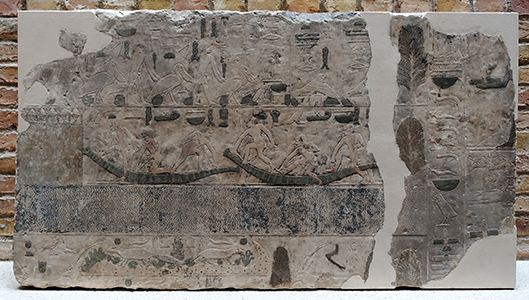
Fifth Dynasty: 2 494 BC - 2 345 BC.
Fragments of a relief, circa 2430 BC.
Breeding of pelicans and other birds, as well as the fabrication of papyrus boats.
Catalog: Abu Gurob, Sanctuary of Nyuserre / Niuserrê, painted limestone, ÄM 20037
Photo: Don Hitchcock 2018
Source: Original, Staatliche Museen zu Berlin, Neues Museum, Germany
Text: © Card at the Staatliche Museen zu Berlin
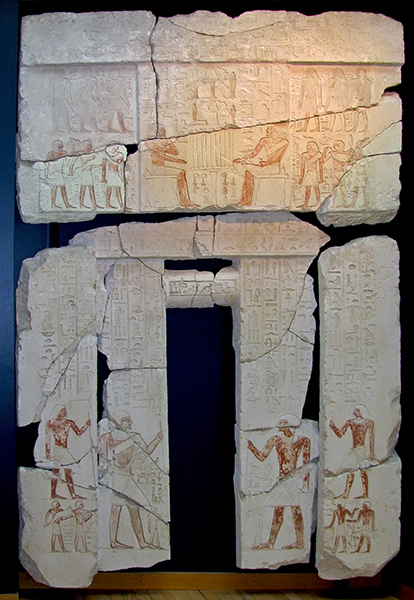
Fifth Dynasty: 2 494 BC - 2 345 BC.
Ptah-wash
False door from the tomb of Vizier Ptah-wash Isi in Sakkara.
Circa 2 430 BC - 2 410 BC.
Height 279 cm, width 184 cm.
False doors are found in a large number of graves from the Old Kingdom. The false door was a central part of the Egyptian mortuary cult. It marked the border between the world of the living and the world of the dead, a place where the living placed food offerings for their ancestors. On this door the titles of the deceased official Ptah-wash flank the central niche. Just above the niche, the deceased is depicted seated at his offering table, with food offerings laid out above the table.
Photo: Don Hitchcock 2014
Source and text: Original, Københavns (Copenhagen) Museum, National Museum of Denmark
Additional text: artsandculture.google.com
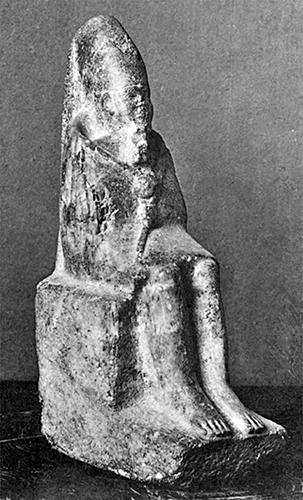
Fifth Dynasty: 2 494 BC - 2 345 BC.
Menkauhor
Statue of Menkauhor, probably from Memphis, now in the Egyptian Museum, Cairo.
Catalog: CG 40
Photo: Ludwig Borchardt (1863-1938)
Permission: Public Domain
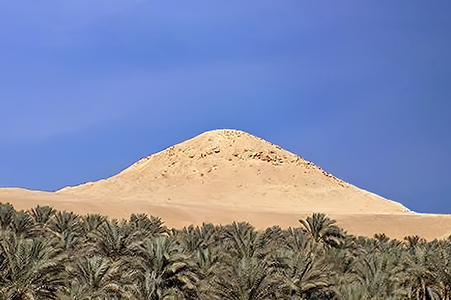
Fifth Dynasty: 2 494 BC - 2 345 BC.
Pyramid of Djedkare Isesi.
The pyramid of Djedkare Isesi is a late 25th to mid 24th century BC pyramid complex built for the Fifth Dynasty pharaoh Djedkare Isesi. It was the first pyramid to be built in South Saqqara.
Djedkare Isesi's monument complex encompasses: a main pyramid; a mortuary temple situated on the east face of the main pyramid; a valley temple buried under modern Saqqara; a causeway that has been only partially dug out; and a cult pyramid.
The main pyramid had a six-stepped core built from roughly cut limestone bound together by clay mortar which was then encased in fine white Tura limestone reaching a peak height of 52.5 metres. The casing has been plundered, and the top three steps of the core have been lost, leaving the pyramid just 24 m tall.
Photo: Wannabe Egyptologist
Permission: Creative Commons Attribution-Share Alike 3.0 Unported license.
Text: Adapted from Wikipedia
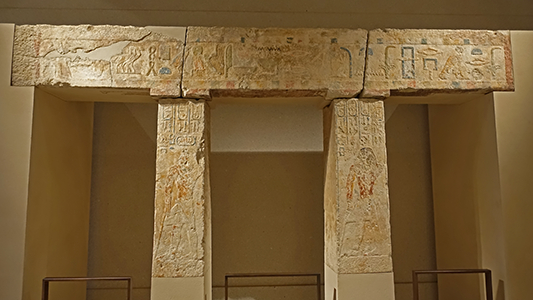
Fifth Dynasty: 2 494 BC - 2 345 BC.
Nefer-bau-Ptah
Piers with architrave from the entrance of the sacrificial chamber of the Nefer-bau-Ptah.
Circa 2504-2037 BC.
Nefer-bau-Ptah (also Nefer-baw-Ptah) is called in his inscriptions:
The kinsman of the king, prince of the estates of the palace, priest of the king... The honourable.
The pillars of the tomb of Nefer-bau-Ptah are built in the likeness of the loggia on the facade of a noble house. The tomb is the dwelling of the deceased and the murals represent an ideal world incorporating aspects of the reality of the here and now.
Catalog: Painted limestone, Giza, ÄM 1114
Photo: Don Hitchcock 2018
Source: Original, Staatliche Museen zu Berlin, Neues Museum, Germany
Text: © Card at the Staatliche Museen zu Berlin, (CC BY-NC-SA 3.0 DE)
Additional text: http://www.aegyptisches-museum-berlin-verein.de/c41.php
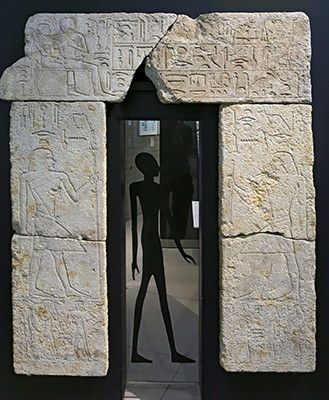
Fifth Dynasty: 2 494 BC - 2 345 BC.
Reliefs on a doorway from the tomb of an Egyptian court official.
The entrance reliefs with the tomb owner and his wife. The entrance side of the tomb was facing east, against the rising sun.
The death chamber itself pointed west, where according to the faith of the Egyptians the realm of the dead lay. The tomb owner appears sitting on the top of the lintel with his wife and, in each case, symmetrically, standing above offering bearers, on the lateral pillars of the entrance. The inscriptions contain funeral prayers with sacrifices.
Photo: Don Hitchcock 2015
Source and text: Original, Badisches Landesmuseum Karlsruhe Germany
Fifth Dynasty: 2 494 BC - 2 345 BC.
li-nefret
These relief plates belong to the burial site ('Mastaba') of a man named li-nefret, who died around 2 400 BC, and had taken the position of a 'chief of the pyramid of Mykerinos'. As such, he was in charge of all the work within the necropolis.
These reliefs were found near the Mykerinos pyramid, which (like the neighbouring pyramids of Cheops and Chephren) formed the centre of a vast necropolis in Giza. There stood the tombs of the royal family, the nobles, and the noble court officials who wanted to be close to their pharaoh even after death.
A priest brings offerings to the owner of the tomb, who is represented at a table with his wife seated behind him.
The tomb of li-nefret can be reconstructed after numerous comparative examples: At the bottom of a deep-reaching shaft was the burial chamber with the sarcophagus and grave goods.
On top of that, a massive stone building with exterior walls was erected, in which the only accessible room was the cult room.
The walls of the cult chamber were decorated with painted reliefs. Here the ritual acts were performed before the false door, which were necessary for the nutrition of the deceased in the hereafter. According to the Egyptian idea, the magical power of the images and inscriptions should also ensure that the grave-owner had everything portrayed and recorded after death at his disposal.
Photo: Don Hitchcock 2015
Source and text: Original, Badisches Landesmuseum Karlsruhe Germany
Additional text: http://www.moin-monja.de/egypt/Museen/karlsruhe_museum/karlsruhe_museum-b/karlsruhe_museum-2.htm
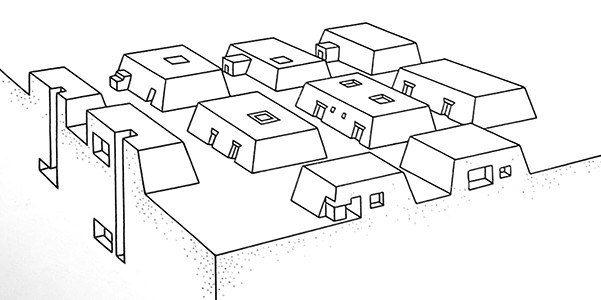
Fifth Dynasty: 2 494 BC - 2 345 BC.
li-nefret
Schematic representation of a Mastaba cemetery from the time of li-nefret.
Characteristic of the superstructures are the the beveled outer walls.
From the top, a vertical shaft leads to the lower burial chamber. The relief-adorned cult chamber, on the other hand, is raised at ground level.
Photo: Unknown artist
Rephotography: Don Hitchcock 2015
Source and text: Badisches Landesmuseum Karlsruhe Germany
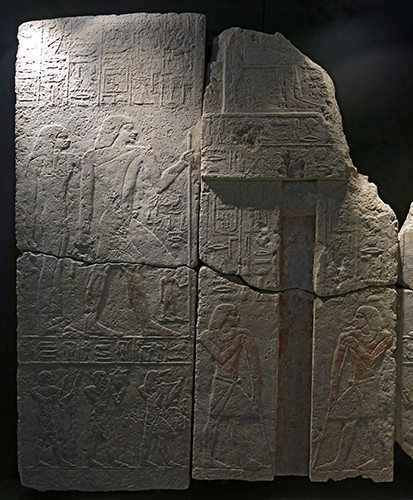
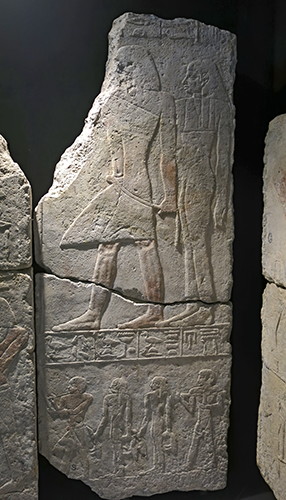
Fifth Dynasty: 2 494 BC - 2 345 BC.
li-nefret
The Tomb Owner's Family at the False Door
At the so-called false door specified in the relief, which led to the actual burial chamber, the sacrifices were offered. li-nefret appears with a wig, artificial chin-beard, protruding apron and panther skin, presumably as a sign of high worth and dignity. His wife has a tight dress. According to the principle of the meaning of size prevalent in Egyptian art, li-nefret and his wife are shown much bigger than the figures of the servants.
Photo (above): Unknown artist, display at Badisches Landesmuseum Karlsruhe Germany
Photo (left) : Don Hitchcock 2015
Source and text: Original, Badisches Landesmuseum Karlsruhe Germany
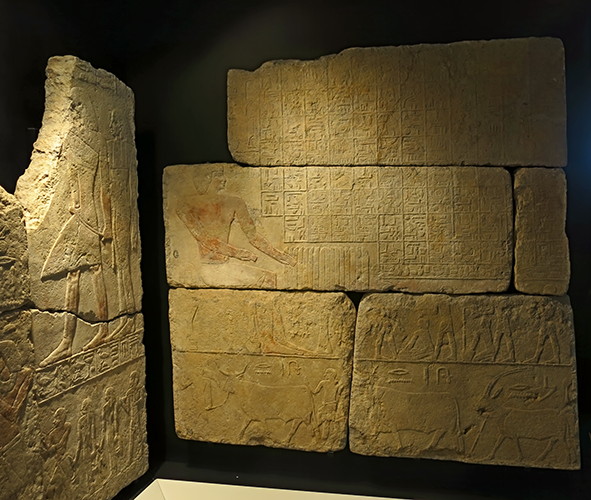
Fifth Dynasty: 2 494 BC - 2 345 BC.
li-nefret
The Tomb Owner
The Tomb Owner at the dining-table, above him the 'Great List of Victims.' The Tomb Owner sits at the dining-table, priests and deities wait on him.The preparations of the lordly meal shown and described here include the sweeping of the floor, ablutions, smoking, anointing with scented oils, dressing and presentation of the food. An anointing oil is called: "Festduh", and there is cedar oil and oil from Libya.
Photo (above): Unknown artist, display at Badisches Landesmuseum Karlsruhe Germany
Photo (left) : Don Hitchcock 2015
Source and text: Original, Badisches Landesmuseum Karlsruhe Germany
Fifth Dynasty: 2 494 BC - 2 345 BC.
li-nefret
Tomb reliefs.
Photo : Don Hitchcock 2018
Source: Original, Badisches Landesmuseum Karlsruhe Germany
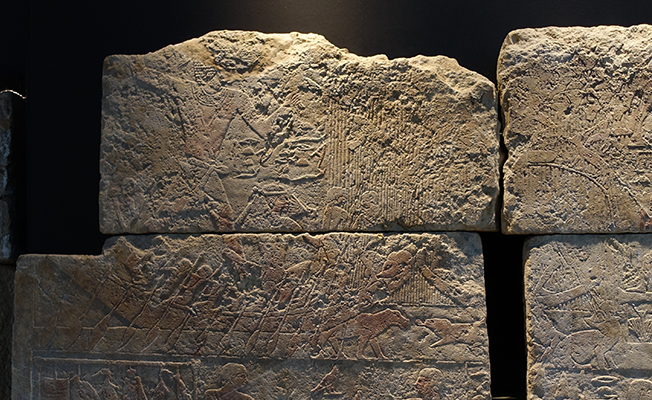
Fifth Dynasty: 2 494 BC - 2 345 BC.
li-nefret
Tomb reliefs.
Photo : Don Hitchcock 2018
Source: Original, Badisches Landesmuseum Karlsruhe Germany
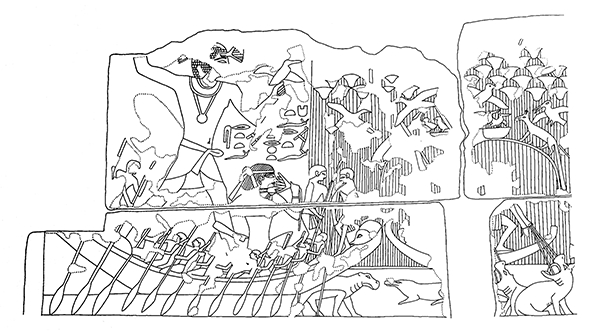
Bird and hippopotamus hunting (drawing of the tomb relief pictured above).
li-nefret goes on a boat on the Nile. With him sits his wife, who embraces his leg. The hunting weapon is a throwing stick and spears.
In the background, genets (small African carnivores) creep up on bird nests in the thicket of papyrus.
Artist: Unknown
Rephotography : Don Hitchcock 2015
Source and text: Badisches Landesmuseum Karlsruhe Germany
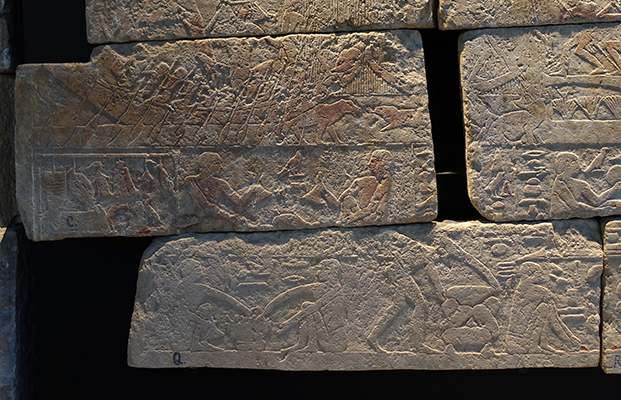
Fifth Dynasty: 2 494 BC - 2 345 BC.
li-nefret
li-nefret's servants depicted here on a relief would magically come to life after the earthly life of li-nefret was over, and he was placed in his tomb, and the servants would then look after the needs of him and his wife.
Photo : Don Hitchcock 2018
Source: Original, Badisches Landesmuseum Karlsruhe Germany
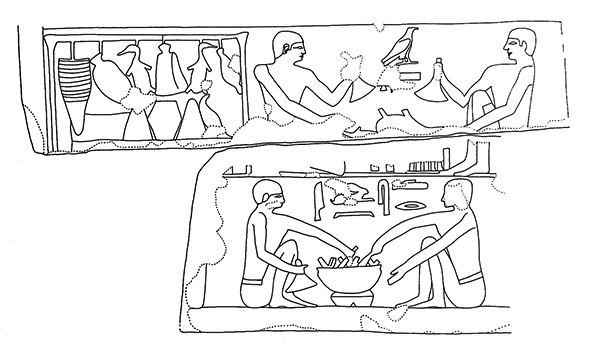
Drying, frying and cooking meat (drawing of the tomb relief pictured above).
On the top left side,
s of meat and slaughtered geese are drying in the air in a hut. Next to it, two squatting servants fan air into the embers under the meat grill.
In the register below one of the servants tells the other to take a casserole from the fire.
Artist: Unknown
Rephotography : Don Hitchcock 2015
Source and text: Badisches Landesmuseum Karlsruhe Germany
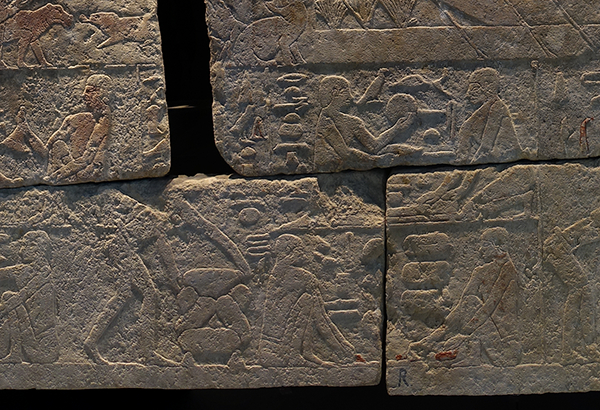
Fifth Dynasty: 2 494 BC - 2 345 BC.
li-nefret
The forming and baking of dough to make bread.
Photo : Don Hitchcock 2018
Source: Original, Badisches Landesmuseum Karlsruhe Germany
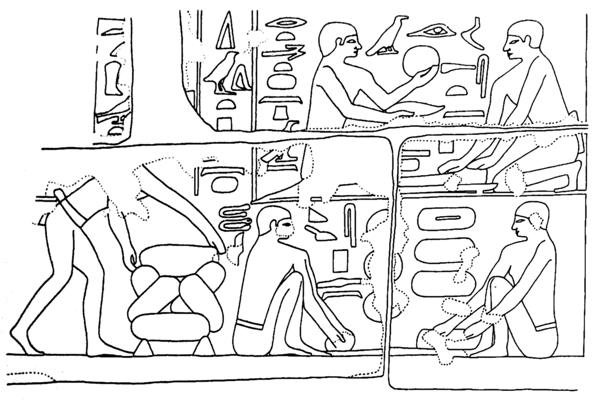
Squatting men form various breads in their hands: flat breads, round and oval loaves, which are placed on boards with low feet (drawing of the tomb relief pictured above).
In addition, a worker puts baking dishes over the embers. Two small fire buckets under the bottom baking pan indicate the fireplace.
Artist: Unknown
Rephotography : Don Hitchcock 2018
Source and text: Badisches Landesmuseum Karlsruhe Germany
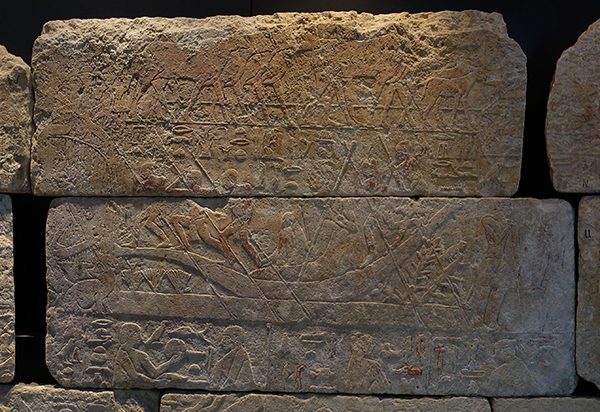
Fifth Dynasty: 2 494 BC - 2 345 BC.
li-nefret
Embarking on the Nile, li-nefret sails past his estates and visits his herds.
Photo : Don Hitchcock 2018
Source: Original, Badisches Landesmuseum Karlsruhe Germany
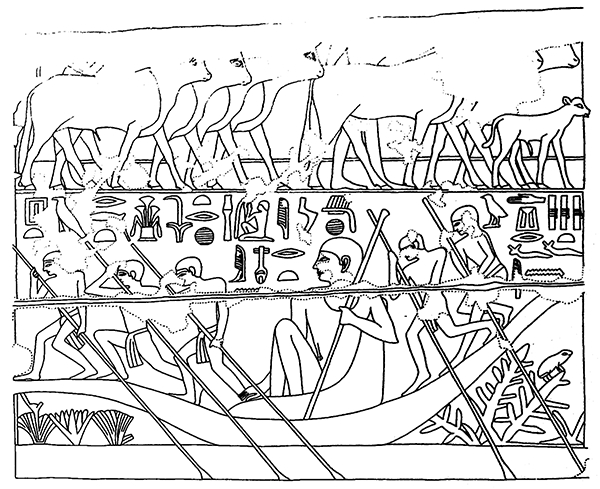
He has made himself comfortable without a wig and beard in a low seat with high backrest and carries only a staff and wears necklaces as a sign of his status (drawing of the tomb relief pictured above).
Five servants with characteristic workers' aprons pole the boat.
Artist: Unknown
Rephotography : Don Hitchcock 2018
Source and text: Badisches Landesmuseum Karlsruhe Germany
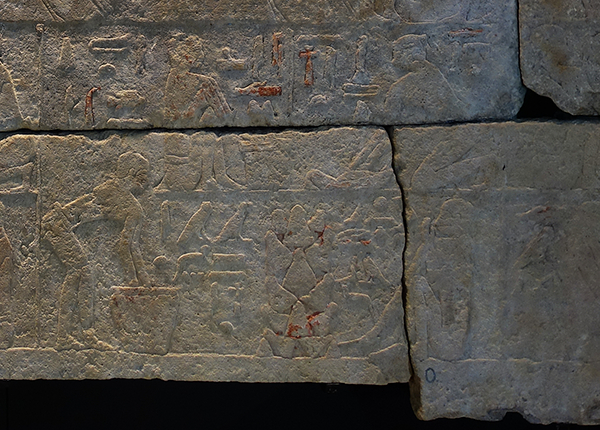
Fifth Dynasty: 2 494 BC - 2 345 BC.
li-nefret
The preparation of bread dough and heating of baking pans.
Photo : Don Hitchcock 2018
Source: Original, Badisches Landesmuseum Karlsruhe Germany
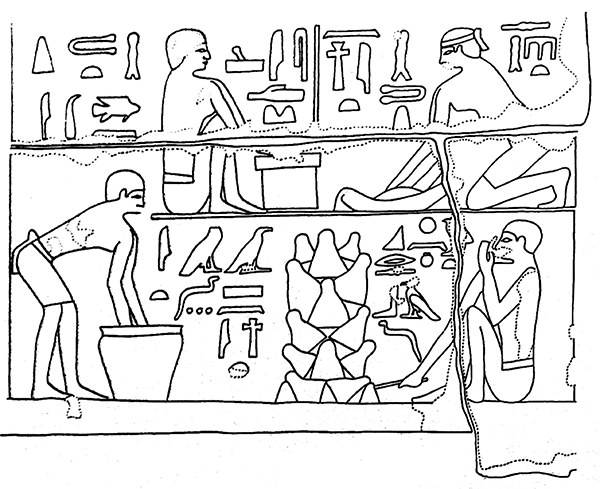
On the upper right, a kneeling miller is grinding the grain on a rubbing stone (drawing of the tomb relief pictured above).
In front of them sits a worker, who sifts the grain. Downstairs, a miller mixes the dough in a trough with water and salt.
On the right, a worker squats by the open fire, shielding themself from the heat with their hand. The fire heats up 13 conical clay shapes to bake bread with the stored heat.
Artist: Unknown
Rephotography : Don Hitchcock 2018
Source and text: Badisches Landesmuseum Karlsruhe Germany
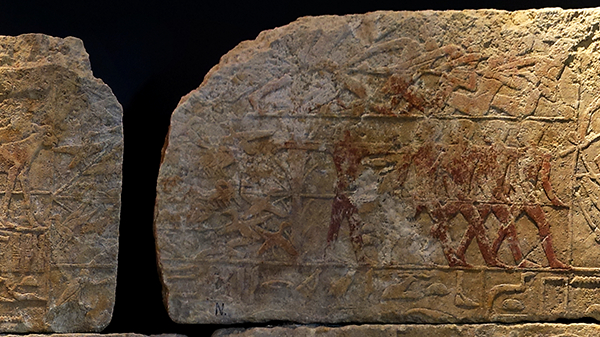
Fifth Dynasty: 2 494 BC - 2 345 BC.
li-nefret
Bird trap with clap-nets.
Photo : Don Hitchcock 2018
Source: Original, Badisches Landesmuseum Karlsruhe Germany
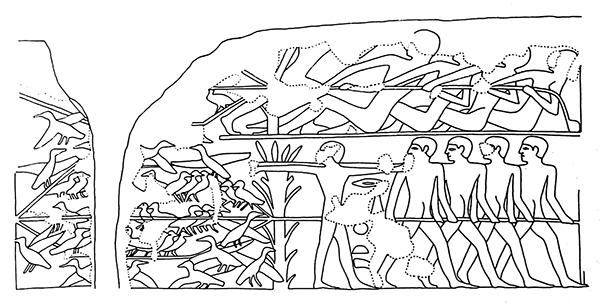
Scattered food lures the birds onto the laid out 'clap-nets', with which the hunters then trap their prey by pulling on a cord to close the net (drawing of the tomb relief pictured above).
Artist: Unknown
Rephotography : Don Hitchcock 2018
Source and text: Badisches Landesmuseum Karlsruhe Germany
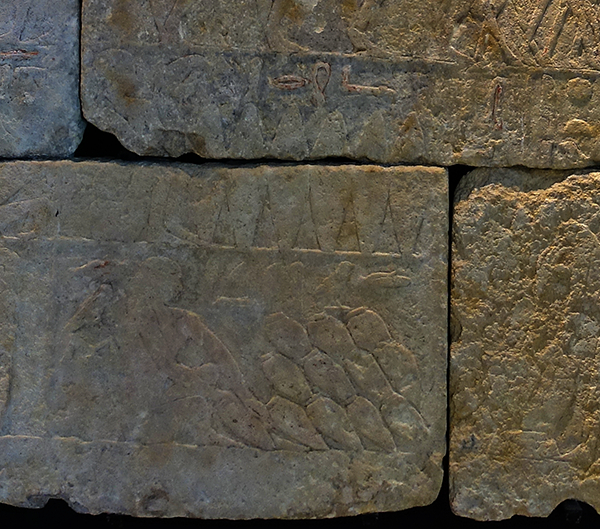
Fifth Dynasty: 2 494 BC - 2 345 BC.
li-nefret
Preparing and sealing the beer pitchers.
Photo : Don Hitchcock 2018
Source: Original, Badisches Landesmuseum Karlsruhe Germany
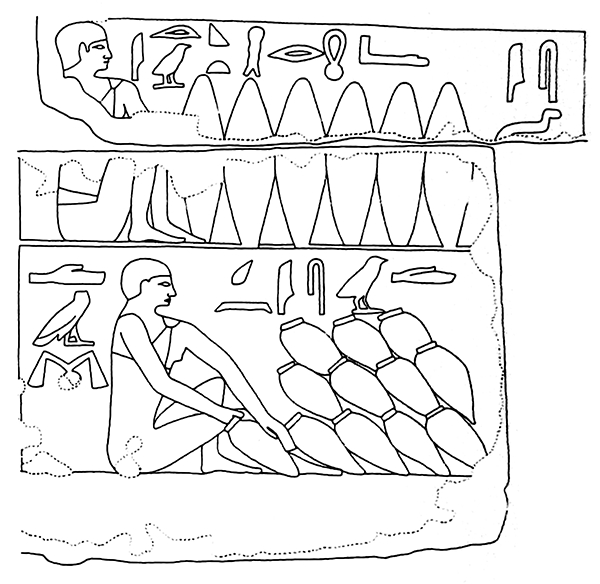
The fermented drink was bottled in pitchers. A sitting worker dresses these pitchers with clay to seal them, which also clarifies the drink (drawing of the tomb relief pictured above).
Artist: Unknown
Rephotography : Don Hitchcock 2018
Source and text: Badisches Landesmuseum Karlsruhe Germany
Fifth Dynasty: 2 494 BC - 2 345 BC.
li-nefret
Plowing the field and sowing.
Photo : Don Hitchcock 2018
Source: Original, Badisches Landesmuseum Karlsruhe Germany
The scene takes place in front of the tomb owner on the right. In front of him appears the head of his lands with two writing reeds (drawing of the tomb relief pictured above).
( the writing reeds referred to appear to be poked into his hair - Don )
To the left of him an overseer drives the ox team pulling the hooked plow by shouting ( and apparently using a cane on their rumps! - Don ). Behind the plowman guiding the plow, the sower scatters seed, and the shepherds control a herd of sheep that trample the seed into the ground.
On the left, two supervisors complete the scene. The shepherds sing the 'Song of the Shepherds', which is reproduced in the inscriptions on the relief.
Artist: Unknown
Rephotography : Don Hitchcock 2018
Source and text: Badisches Landesmuseum Karlsruhe Germany
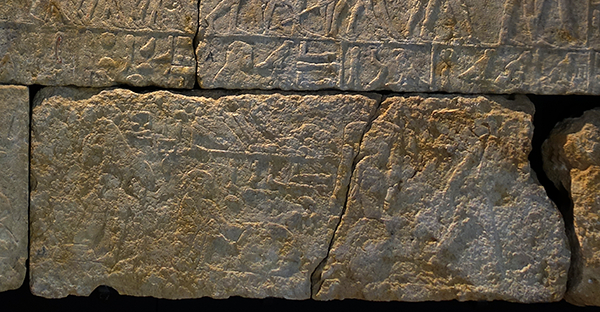
Fifth Dynasty: 2 494 BC - 2 345 BC.
li-nefret
Brewing beer
Photo : Don Hitchcock 2018
Source: Original, Badisches Landesmuseum Karlsruhe Germany
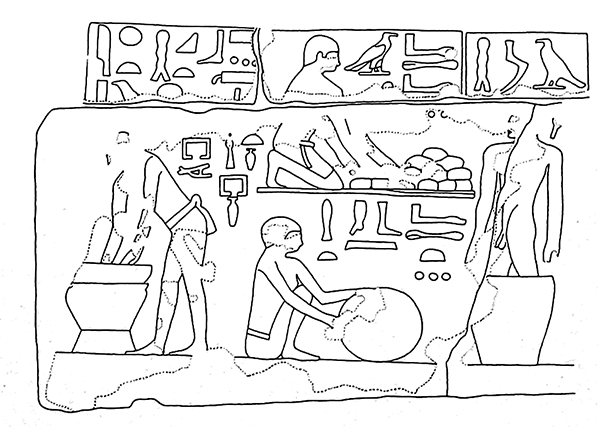
Beer served the Egyptians as an everyday drink that they always brewed fresh each day because of its low shelf life. To do this, they made 'brewing loaves' from germinated barley and wheat, which were lightly baked to promote yeast fermentation (drawing of the tomb relief pictured above).
The worker stands in a tub crushing dates by treading them. The worker on the left mixes crushed brewing loaves with fermented date juice through a sieve with the addition of water into the large vessel for the final fermentation.
Artist: Unknown
Rephotography : Don Hitchcock 2018
Source and text: Badisches Landesmuseum Karlsruhe Germany
Fifth Dynasty: 2 494 BC - 2 345 BC.
li-nefret
Fishing with a trawl net.
Photo : Don Hitchcock 2018
Source: Original, Badisches Landesmuseum Karlsruhe Germany
With straps over their shoulders, the fishermen pull the net full of fish to shore (drawing of the tomb relief pictured above).
The net hangs between floats on the water surface and weights on the bottom.
Artist: Unknown
Rephotography : Don Hitchcock 2018
Source and text: Badisches Landesmuseum Karlsruhe Germany
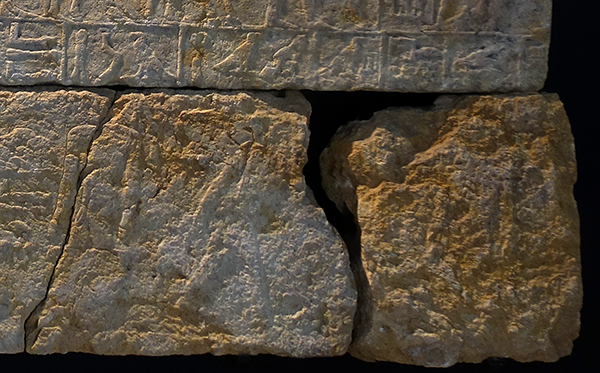
Fifth Dynasty: 2 494 BC - 2 345 BC.
li-nefret
Pounding grain.
Photo : Don Hitchcock 2018
Source: Original, Badisches Landesmuseum Karlsruhe Germany
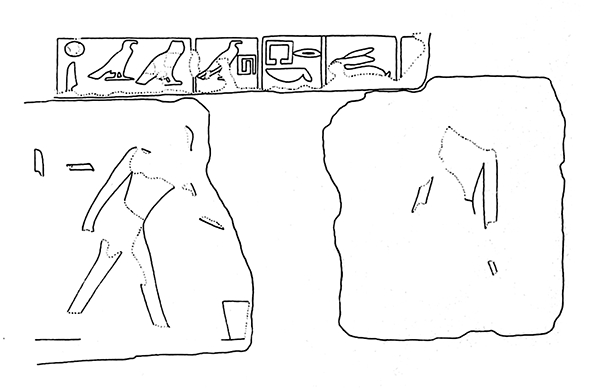
This scene with the man-high pestle used by workers at the mortar can be seen only on old photos because of damage during the Second World War (drawing of the tomb relief pictured above).
( note that the lower block has been moved to the left since this drawing was made - Don )
Artist: Unknown
Rephotography : Don Hitchcock 2018
Source and text: Badisches Landesmuseum Karlsruhe Germany
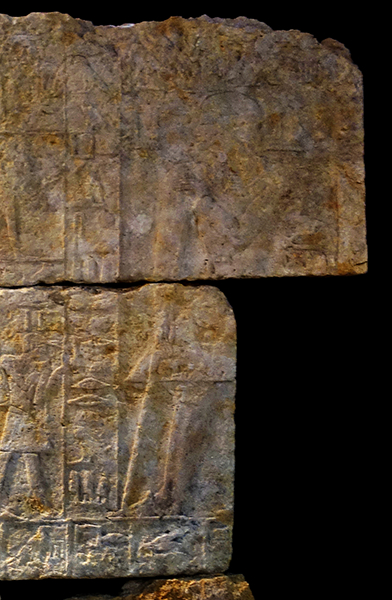
Fifth Dynasty: 2 494 BC - 2 345 BC.
li-nefret
The tomb master
Photo : Don Hitchcock 2018
Source: Original, Badisches Landesmuseum Karlsruhe Germany
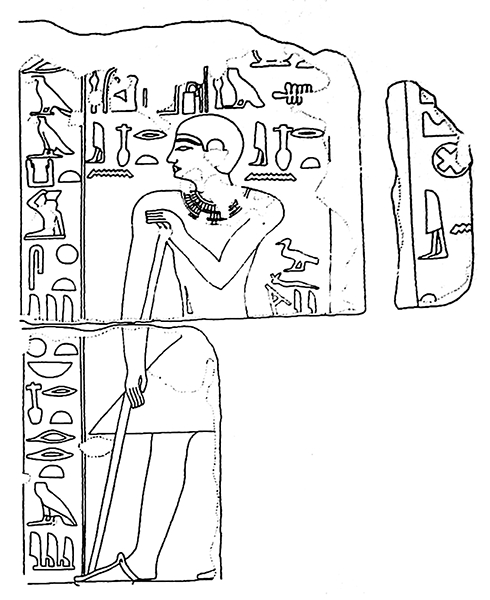
This representation also follows the rules of significance: the tomb owner is the largest drawing, while the small figures describe the orders of the tomb master aimed at fishing and field activities (drawing of the tomb relief pictured above).
Artist: Unknown
Rephotography : Don Hitchcock 2018
Source and text: Badisches Landesmuseum Karlsruhe Germany
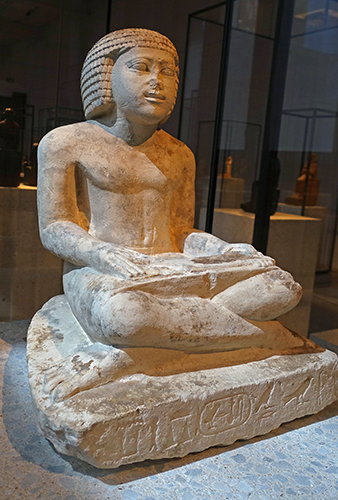
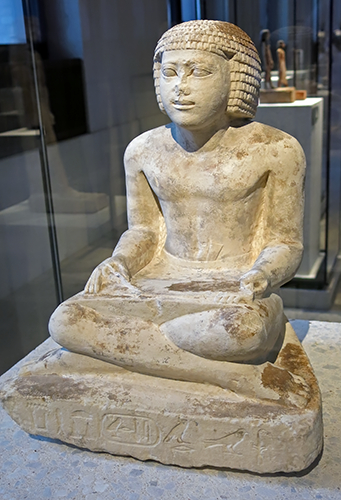
Fifth Dynasty: 2 494 BC - 2 345 BC.
Henka
Scribe statue of Henka, chief of the two pyramids of Snofru in limestone, circa 2 450 BC.
Henka, a high official and head of the pyramids of King Snofru, who had died more than a hundred years before, sits with his legs crossed, and has on his knees the unrolled part of a papyrus. The left hand holds the blank part of the roll, the right hand holds the papyrus between the thumb and the index finger.
It is in some respects a portrait rather than a portrayal of a scribe at work, since Henka looks straight ahead, as we would now for a photograph.
Height x Width x Depth: 400 x 320 x 290 mm.
Catalog: Memphis, Meidum, ÄM 7334
Photo: Don Hitchcock 2015, 2018
Source: Original, Staatliche Museen zu Berlin, Neues Museum, Germany
Text: © Card at the Staatliche Museen zu Berlin, http://www.smb-digital.de/ (CC BY-NC-SA 3.0 DE)
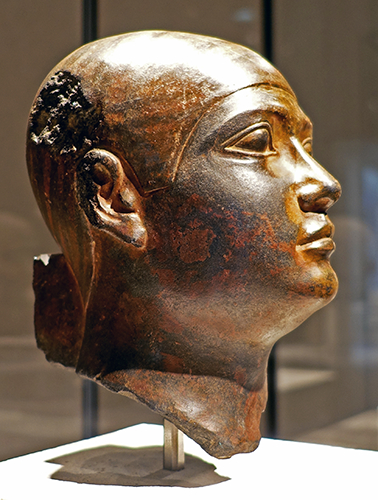
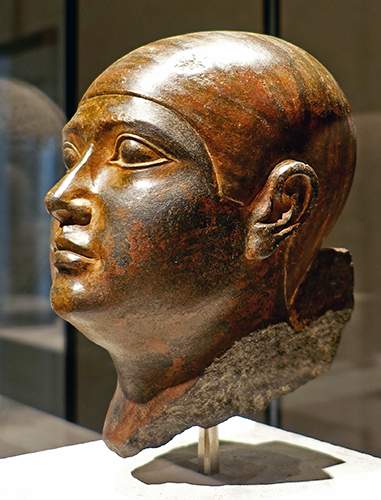
Fifth Dynasty: 2 494 BC - 2 345 BC.
Head of a statue of a man.
Circa 2 500 BC
Catalog: Basalt, ÄM not listed
Photo: Don Hitchcock 2015
Source: Original, Staatliche Museen zu Berlin, Neues Museum, Germany
Text: © Card at the Staatliche Museen zu Berlin, (CC BY-NC-SA 3.0 DE)
Fifth Dynasty: 2 494 BC - 2 345 BC.
Kahotep
Portrait head (so-called reserve head) of Kahotep.
5th Dynasty, circa 2450 BC
300 x 180 x 320 mm
The so-called 'replacement heads', which mainly come from the Western Cemetery in Giza, belong to the 'in the round' works of the Old Kingdom. The heads were discovered in discarded positions in the shafts leading to the underground burial chambers. They were found in both male and female graves. They all have a smooth surface. Thus, it is certain that they are not statues or separate parts of figures, but are independent objects. Probably the heads were seen as a sufficient equivalent for the grave, which was generally placed as a substitute body in the tomb.
This replacement head of Kahotep was found in Abusir. It has some damage on the face. The portrayed facial expression is self-confident and proud, and the head rests on a strong neck. It is striking that the head hair of all replacement heads is modelled as a smooth cap and that the ears often seem to be missing or never shown from the start. It is interesting to note that the Berlin head has a limestone core, over which a plaster layer was modelled.
Catalog: Abusir, plaster over limestone, ÄM 16455
Photo: Don Hitchcock 2015, 2018
Source: Original, Staatliche Museen zu Berlin, Neues Museum, Germany
Text: © Card at the Staatliche Museen zu Berlin, http://www.smb-digital.de/ , (CC BY-NC-SA 3.0 DE)
Fifth Dynasty: 2 494 BC - 2 345 BC.
King or Prince
Head of a statue of a king or prince.
Circa 2450 BC
Head of a royal statue wearing a round wig with circlet and uraeus. Bought at Gîza in 1899.
Catalog: Breccia, Giza (?), ÄM 14396
Photo: Don Hitchcock 2018
Source: Original, Staatliche Museen zu Berlin, Neues Museum, Germany
Text: © Card at the Staatliche Museen zu Berlin, (CC BY-NC-SA 3.0 DE)
Additional text: http://www.griffith.ox.ac.uk/gri/3pm8sta1.pdf
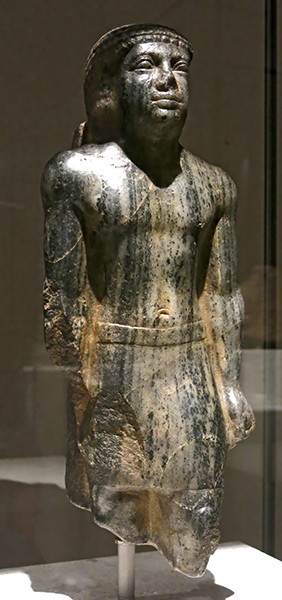
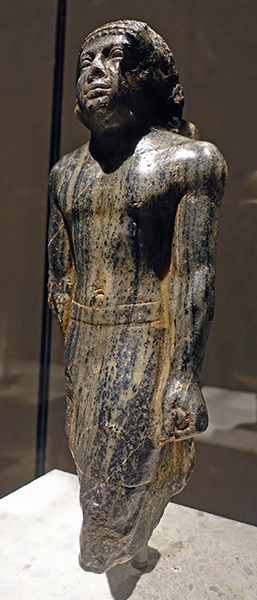
Fifth Dynasty: 2 494 BC - 2 345 BC.
Standing-striding figure of a high official
From the reign of Neferirkare.
Dimensions 385 x 155 x 140 mm
At the latest since the beginning of the historical period (about 3 000 BC), statues have been an integral part of the grave, for a future existence in the hereafter required the preservation of the body or its image according to the ideas of the Egyptians. The statue was one of the classical forms of the grave. Through the upright posture, the stride of the left leg, and the clenched fists this statue embodies an active man. The axial structure supported by the backpost emphasises the frontal alignment of the figure. The face, encircled by an ear-covering wig, has been created as an ideal image, as well as the physique, without any individual features. However, the outstanding modeling of the human body is impressive, which without an excessive emphasis on body parts, demonstrates a sovereign knowledge of the human anatomy.
The figure depicted is clothed with a short skirt. The use of gneiss for non-royal statues is unusual.
Catalog: Gneiss, Memphis, ÄM 1122
Photo: Don Hitchcock 2015, 2018
Source: Original, Staatliche Museen zu Berlin, Neues Museum, Germany
Text: © Card at the Staatliche Museen zu Berlin, K. Finneiser at http://www.smb-digital.de/, (CC BY-NC-SA 3.0 DE)
Fifth Dynasty: 2 494 BC - 2 345 BC.
Sabu and Family
Family group of Sabu, his wife Meritites, and their son Iseb. Meritites has her arm around the chest of her husband. Only the lower legs of their son remain.
Limestone, circa 2 400 BC.
Catalog: ÄS 7146
Photo: Don Hitchcock 2015, 2018
Source: Original, Ägyptischen Museum München
Text: © Ägyptischen Museum München
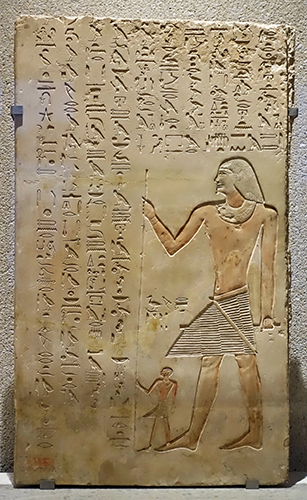
Fifth Dynasty: 2 494 BC - 2 345 BC.
Metjetji and his son
Fragment from the right side of the facade of the tomb of Metjetji.
Painted limestone sculpted in sunk relief of Metjetji and his son Ihy, circa 2 400 BC.
Dimensions: 1080 mm x 680 mm.
The block is decorated with a scene that is almost the mirror image of the one on the left side of the facade. A few differences can be noted in the details. The sceptre passes behind Metjetji's body, following a convention of Egyptian relief that privileges orientation to the left. The small figure holding tightly to the base of the staff is not nude, but wears a kilt with triangular apron. The text above him explains that this is not the son of Metjetji shown on the previous block, but is 'his son whom he loves, Ihy'.
As on the left side of the facade, the scene is surmounted by a line of hieroglyphs giving an abridged titulary of the tomb's owner: 'Royal noble, Director of the Office of Tenants of the Palace, Metjetji'.
Much of the block is occupied by an inscription of a traditional type called Appeal to the Living, which invites passersby to celebrate the memory of the deceased.
Catalog: Saqqara, Grave of Metjetji, ÄS 32190
Photo: Don Hitchcock 2018
Source: Original, Staatliche Museen zu Berlin, Neues Museum, Germany
Text: © Card at the Staatliche Museen zu Berlin (CC BY-NC-SA 3.0 DE)
Additional text: Staff of the Metropolitan Museum of Art (1999)
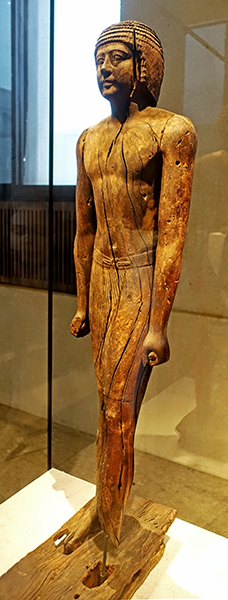

Fifth Dynasty: 2 494 BC - 2 345 BC.
Perhernefret
Standing - striding figure of Perhernefret.
Wood, circa 2 400 BC.
Son of Renpetnefret. Mentioned on his mother's offering basin, identified as a carpenter.
Size: 1130 x 205 x 560 mm.
Catalog: (Tarkhan) Kafr Ammar, ÄM 10858
Photo: Don Hitchcock 2018
Source: Original, Staatliche Museen zu Berlin, Neues Museum, Germany
Text: © Card at the Staatliche Museen zu Berlin, http://www.smb-digital.de/ (CC BY-NC-SA 3.0 DE)
Additional text: http://www.gizapyramids.org/
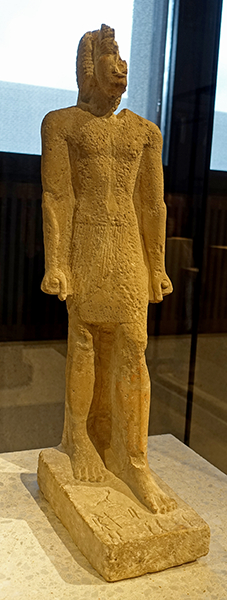
Fifth Dynasty: 2 494 BC - 2 345 BC.
Hesy
Standing - striding figure of Hesy.
Overseer of officials, face partly restored.
Limestone, circa 2 400 BC.
Catalog: ÄM 7766
Photo: Don Hitchcock 2018
Source: Original, Staatliche Museen zu Berlin, Neues Museum, Germany
Text: © Card at the Staatliche Museen zu Berlin (CC BY-NC-SA 3.0 DE)
Additional text: http://www.griffith.ox.ac.uk/gri/3berlin.pdf
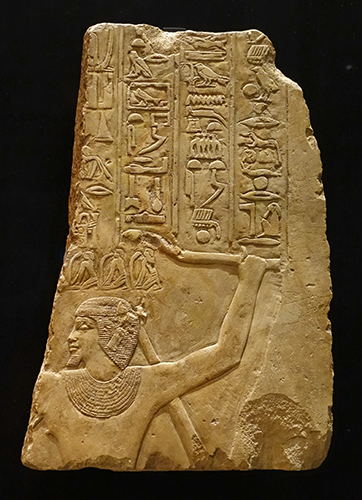
Fifth Dynasty: 2 494 BC - 2 345 BC.
Relief
Fowling with a throwstick, circa 2 400 BC.
Catalog: Limestone, Sakkara, Gl. 105
Photo: Don Hitchcock 2018
Source: Original, Ägyptischen Museum München
Text: Museum card, © Ägyptischen Museum München
Fifth Dynasty: 2 494 BC - 2 345 BC.
Family Group
Painted limestone, circa 2 400 BC.
610 x 270 x 355 mm
The common burial of husband and wife, as well as of mother and son, is extremely frequently documented. In the reliefs of the cult chambers of the tombs of the Old Kingdom there are numerous representations confirming this. Usually the parents, surrounded by the children, or only the man, on whose side his wife, sons and daughters can be found, are depicted.
But group sculpture as a long lasting image of the family has also been very popular since the Old Kingdom.
The partial family group shown here is dominated by the figure of the man. He is clothed only with a knee length kilt and a short wig, and sits erect on a stool. Beside his legs there is a crouching female figure on his right side. She wears an ankle-length garment and with her left arm she clasps the man's lower leg. Probably it is his wife, but it could also be his daughter. On the left is a son, who, as is the case with children and young people, is depicted naked and with the so-called 'Jugendlocke', the braided hairstyle for young people who were descendants of the king, and the hairstyle also marked connection to the young Horus. He also clasps the calf of his father.
The facial features of man and woman are typical for the 5th dynasty and without any attempt at any more detailed physiognomic formation and differentiation.
The man's eyelids are of copper, the eyes of black and white stone. The painting on the statue is partly preserved.
Due to the lack of an inscription, the identity and the rank of the depicted persons can not be determined. Comparable pieces were found in mastaba graves at the official cemeteries in Giza and Saqqara.
(K. Finneiser)
Catalog: Saqqara, ÄM 10123
Photo: Don Hitchcock 2015, 2018
Source: Original, Staatliche Museen zu Berlin, Neues Museum, Germany
Text: © Card at the Staatliche Museen zu Berlin, http://www.smb-digital.de/ (CC BY-NC-SA 3.0 DE)
Additional text: Wikipedia
Scribe statues
The scribe sits cross-legged on the floor with his papyrus scroll open on his lap. He is one of the elite members of ancient Egyptian society. Historic figures who have made a name for themselves through their cultural achievements as poets, architects and artists are still venerated centuries on in the form of scribe statues which are publicly displayed on temple gates. This is also borne out by the portrayal of the signs of age in the corpulence of the upper body - a clear contrast to the otherwise prevailing ideal of eternal youth.Text above: http://www.egyptian-museum-berlin.com/c51.php
Fifth Dynasty: 2 494 BC - 2 345 BC.
Dersenedj and his wife Nefretka
(left) Dersenedj and his wife Nefretka.
(right) Dersenedj in his role as scribe.
Pink granite, circa 2 400 BC.
Dersenedj was a scribe of the granaries and an administrator. Such people had high status, and were learned people.
Writers' statues have been documented since the fourth dynasty. In them, the person presented is portrayed as a civil servant and at the same time a literary man. Dersenedj sits with his legs crossed, holding with his left hand the papyrus leaf, which is spread on the scarf, on which he has placed his right hand, with the finger holding the writing pen (not shown) over the sheet. The upper body is muscular, the head sits directly on the wide shoulders and is surrounded by a shoulder-length wig. The oval, large-area face is left without any attempt at characterisation or individualisation. The titles and names of the 'granaries recorder and domain administrator' have been placed on the papyrus sheet in such a way that the person in front can read them.
The scribe of the granaries Dersenedj is seated, cross-legged, on the floor with an unrolled papyrus on his lap. His right hand is holding an imaginary reed pen. This statue type - the scribe - is known since circa 2 600 BC and represents an official of the Egyptian state with the ability to read and write.
Characteristic for the Old Kingdom is the muscular compressed body, the roundish face without wrinkles and the striated wig. This statue which was created for the grave of Dersenedj is not a portrait but instead presents an ideal 'type' which will continue to live in the netherworld.
Height x Width x Depth: 682 x 510 x 460 mm.
Catalog: ÄM 23720, ÄM 15701
Photo: Don Hitchcock 2018
Source: Original, Staatliche Museen zu Berlin, Neues Museum, Germany
Text: © Card at the Staatliche Museen zu Berlin, http://www.smb-digital.de/(CC BY-NC-SA 3.0 DE)
Additional text: http://www.egyptian-museum-berlin.com/c51.php
Fifth Dynasty: 2 494 BC - 2 345 BC.
Seated Scribe
Scribe, limestone, seated cross-legged, loincloth with rounded edge, short curly wig, holding papyrus scroll.
Height 580 mm, width 350 mm, depth 330 mm.
Catalog: Painted limestone statue, various inventory numbers including A 42, N 43, CC 93, Scribe-A 42
Photo: Don Hitchcock 2015, 2018
Source and text: Original, Louvre Museum, Paris, France, https://collections.louvre.fr/
Fifth Dynasty: 2 494 BC - 2 345 BC.
Tomb relief
Tomb relief depicting gardening and offering-bearers.
Circa 2 400 BC
Catalog: Painted limestone, Saqqâra, ÄM 31198
Photo: Don Hitchcock 2015
Source: Original, Staatliche Museen zu Berlin, Neues Museum, Germany
Text: © Card at the Staatliche Museen zu Berlin, (CC BY-NC-SA 3.0 DE)
Additional text: http://www.griffith.ox.ac.uk/gri/3berlin.pdf
Fifth Dynasty: 2 494 BC - 2 345 BC.
Tomb relief
Tomb relief showing offering-bearers in a papyrus boat.
Circa 2 400 BC
Catalog: Painted limestone, Saqqâra, ÄM 31294
Photo: Don Hitchcock 2015
Source: Original, Staatliche Museen zu Berlin, Neues Museum, Germany
Text: © Card at the Staatliche Museen zu Berlin, (CC BY-NC-SA 3.0 DE)
Additional text: http://www.griffith.ox.ac.uk/gri/3berlin.pdf
Fifth Dynasty: 2 494 BC - 2 345 BC.
Tomb relief
Tomb relief depicting offering-bearers in front of the tomb owner (large feet, right).
Circa 2 400 BC
Catalog: Painted limestone, Saqqâra, ÄM 31012, ÄM 31011
Photo: Don Hitchcock 2015
Source: Original, Staatliche Museen zu Berlin, Neues Museum, Germany
Text: © Card at the Staatliche Museen zu Berlin, (CC BY-NC-SA 3.0 DE)
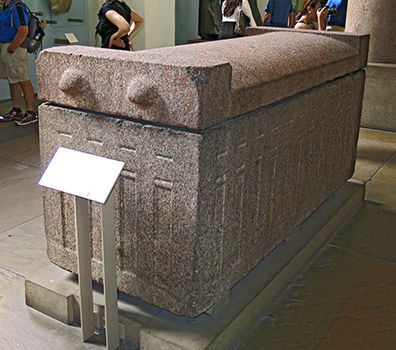
Fifth Dynasty: 2 494 BC - 2 345 BC.
Sarcophagus
Sarcophagi (stone coffins) were reserved for royalty and the elite. The panel design depicts a palace facade. The side that faced east includes two false doors.
Red granite sarcophagus, circa 2 400 BC, decorated with palace-facade panelling. Slightly vaulted lid retains handling-bosses at either end.
Length 225 cm, height 105 cm, width 88 cm.
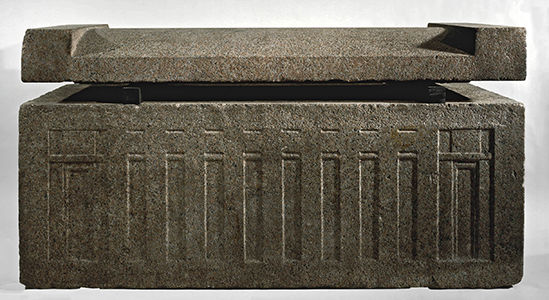
Most Egyptian tombs lie on the edge of the western desert, so the dead were buried facing east, towards the living — who brought them offerings.
An inscription on the same side, near the top, named the owner but was erased, perhaps to curse him. The bosses on the lid served to manoeuvre It into place.
Catalog: From Giza, tomb LG 98, Granite, EA71620
Photo (upper): Don Hitchcock 2015
Photo (lower): © Trustees of the British Museum, CC BY-NC-SA 4.0
Source: Original, British Museum
Text: Card at the British Museum, http://www.britishmuseum.org/, © Trustees of the British Museum, CC BY-NC-SA 4.0
Fifth Dynasty: 2 494 BC - 2 345 BC.
Relief
Relief depicting offerings, circa 2 400 BC.
Catalog: Limestone, Gl. 104
Photo: Don Hitchcock 2018
Source: Original, Ägyptischen Museum München
Text: Museum card, © Ägyptischen Museum München
Fifth Dynasty: 2 494 BC - 2 345 BC.
Offering
Model offering in the shape of a plucked goose, circa 2 400 BC.
Catalog: Limestone, ÄS 7213
Photo: Don Hitchcock 2018
Source: Original, Ägyptischen Museum München
Text: Museum card, © Ägyptischen Museum München
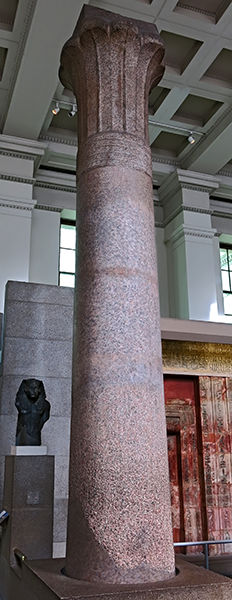
Fifth Dynasty: Reign of Unas (about 2 375 - 2 345 BC)
Column of King Unas
This red granite column, 564 cm high, graced a colonnaded court in the mortuary temple at the foot of Unas' pyramid at Saqqara. The top is carved in the shape of palm leaves.
Many elements of Egyptian temples evoked the natural world and symbolised divine creation. Floors and painted ceilings replicated the earth and sky, while the columns and wall decoration represented vegetation. Some stone elements might mimic lighter building materials such as wood and matting.
Photo: Don Hitchcock 2015
Source: Original, British Museum
Text: Card at the British Museum, http://www.britishmuseum.org/, © Trustees of the British Museum, CC BY-NC-SA 4.0
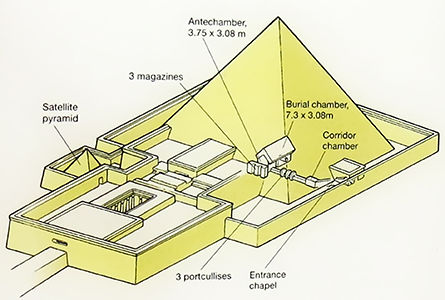
Fifth Dynasty: Reign of Unas (about 2 375 - 2 345 BC)
Pyramid of King Unas
Each column in the Unas pyramid complex was carved from a single piece of granite, which was quarried at Aswan, near Egypt's southern border. In a rough hewn state, the columns were transported 800 kilometres down the Nile on special boats, only to be finished once they had been erected.
Photo: Poster, © Trustees of the British Museum, CC BY-NC-SA 4.0
Text: Poster at the British Museum, http://www.britishmuseum.org/, © Trustees of the British Museum, CC BY-NC-SA 4.0
Fifth Dynasty: Reign of Unas (about 2 375 - 2 345 BC)
Pyramid of King Unas
This wall scene from the causeway leading up to his mortuary temple shows the shipping of the granite columns for the pyramid complex.
Photo: Poster, © Trustees of the British Museum, CC BY-NC-SA 4.0
Text: Poster at the British Museum, http://www.britishmuseum.org/, © Trustees of the British Museum, CC BY-NC-SA 4.0
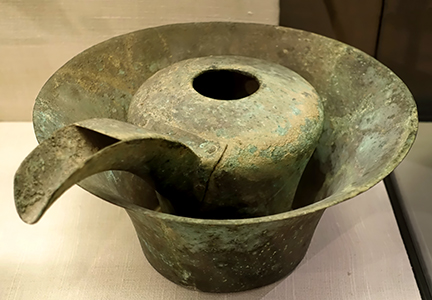
Fifth / Sixth Dynasty: 2 494 BC - 2 181 BC.
Washing utensils
This copper basin with a goblet-like curved wall and the jug without a handle but with a wide, riveted spout form a type of tableware that is still used in principle in our time, where water is not drawn from the tap but has to be drawn from a well.
Vessels of this form are often depicted in the so-called 'friezes of objects' on sarcophagi. They belonged to the indispensable furnishings of the dining room and the bedroom and could therefore not be missing from a grave outfitted in keeping with one's status. It can be assumed with certainty that this specimen actually comes from a tomb.
Height of basin 125 mm, diameter 265 mm
Height of jug 168 mm, diameter (with spout) 260 mm.
Catalog: Copper, origin unknown, Inv. no. 1929.618 a/b
Photo: Don Hitchcock 2018
Source and text: Original, Museum August Kestner, Hannover
Additional text: Paper Catalogue, Museum August Kestner, Hannover.
Fifth / Sixth Dynasty: 2 494 BC - 2 181 BC.
Relief
Relief, cattle butchering scene. Circa 2 300 BC.
Catalog: Painted limestone, Sakkara, Grave of Nianchnesut, ÄS 5970
Photo: Don Hitchcock 2018
Source: Original, Ägyptischen Museum München
Text: Museum card, © Ägyptischen Museum München
The Sixth Dynasty
2 345 BC - 2 181 BC.
The Sixth Dynasty of ancient Egypt (notated Dynasty VI) is combined with Dynasties III, IV and V under the group title the Old Kingdom.
The pharaohs of this dynasty ruled for approximately 164 years. These kings ruled from Memphis, since their pyramids were built at Saqqara, close by, which served as the necropolis for Memphis.
The names in the table are taken from Dodson and Hilton (2004).
| Sixth Dynasty | ||||||
|---|---|---|---|---|---|---|
| Name | Personal Name | Consort | Pyramid | Years | Dates | Comment |
| Teti | Seheteptawy | Iput, Khent(kaus III), Khuit, Nearit | Pyramid of Teti in Saqqara | 12 | 2 345 BC - 2 333 BC | During Teti's reign, high officials were beginning to build funerary monuments that rivaled that of the pharaoh. His vizier, Mereruka, built a mastaba tomb at Saqqara which consisted of 33 richly carved rooms, the biggest known tomb for an Egyptian nobleman. This is considered to be a sign that Egypt's wealth was being transferred from the central court to the officials, a slow process that culminated in the end to the Old Kingdom. The Egyptian priest and chronicler Manetho states that Teti was murdered by his palace bodyguards in a harem plot, and he appears to have been briefly succeeded by a shortlived usurper, Userkare. |
| Userkare | 2 | 2 333 BC - 2 331 BC | Few artefacts dating to Userkare's lifetime have survived to this day, the only secure attestions contemporaneous with his reign being two cylinder seals inscribed with his name and titles and a copper mallet from the Michaelides collection. | |||
| Pepi I, Pepi I Meryre | Nefersahor/Merenre | Ankhesenpepi I, Ankhesenpepi II, Nubwenet, Meritites IV, Inenek-Inti, Mehaa, Nedjeftet |
Pyramid of Pepi in South Saqqara | 44 | 2 331 BC - 2 287 BC | Confronted with the protracted decline of pharaonic power and the emergence of dynasties of local officials, Pepi reacted with a vast architectural program involving the construction of temples dedicated to local gods and numerous chapels for his own cult throughout Egypt, reinforcing his presence in the provinces. Egypt's prosperity allowed Pepi to become the most prolific builder of the Old Kingdom. At the same time, Pepi favored the rise of small provincial centres and recruited officials of non-noble extraction to curtail the influence of powerful local families. |
| Merenre I | Merenre | Ankhesenpepi II | Pyramid of Merenre in South Saqqara | 9 | 2 287 BC - 2 278 BC | |
| Pepi II | Neferkare | Neith, Iput II, Ankhesenpepi III, Ankhesenpepi IV, Udjebten |
Pyramid of Merenre in South Saqqara | 94 (aged 6 to 100) |
2 278 BC - 2 184 BC | |
| Merenre II | Merenre | 1 | 2 184 BC | |||
| Netjerkare Siptah | 3 | 2 184 BC- 2 181 BC | ||||
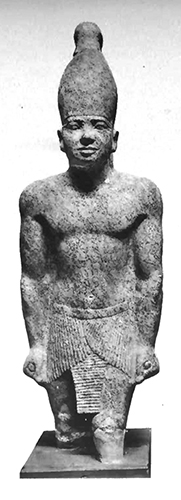
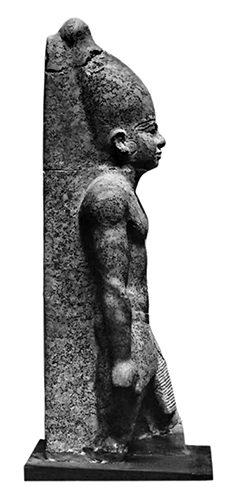
Sixth Dynasty: 2 345 BC - 2 181 BC
Teti Quibell Saqqara, circa 2 335 BC
Statue of King Teti found near his pyramid at Saqqara.
Catalog: JE 39103
Photo: James Edward Quibell: Excavations at Saqqara (1906-1907), Pl. XXXI
Permission: Public Domain
Source: Egyptian Museum, Cairo
Sixth Dynasty: 2 345 BC - 2 181 BC
Pyramid of Teti, circa 2 335 BC
The orientation of the pyramid is not aligned with the four cardinal points. However, the proportions and plan of the pyramid follow exactly the same pattern as that of the Pyramid of Djedkare-Isesi. The internal dimensions and slope are the same and it is otherwise very similar.
Access to the burial chambers are located inside the adjoining chapel against the north face of the pyramid. The entrance hallway leads to a long descent of eighteen hundred and twenty-three metres. The entrance was once blocked by a plug of granite now lost. The descending passage was probably clogged along its length by large blocks of limestone that thieves have broken up. The debris still littered the passage at the time of discovery. In the descending corridor is a successive horizontal hallway, a vestibule, another hallway, a bedroom with harrows, a final corridor, and a final granite passage which opens into the funerary apartments of the King.
The room with harrows spans more than six metres and is designed with alternating limestone and granite. The three granite harrows, originally lowered, are now broken into several pieces leaving the way open to visitors.
Photo: Neithsabes
Permission: Public Domain
Text: Wikipedia
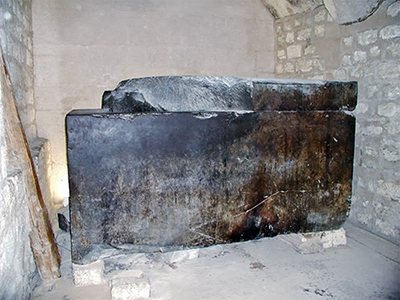
Sixth Dynasty: 2 345 BC - 2 181 BC
Sarcophagus of Teti, circa 2 335 BC
Photo: Jon Bodsworth
Permission: Copyrighted free use
Text: Wikipedia
Life after death
The ancient Egyptians did not believe that life ended at death. The souls, the Ka and the Ba, went on living, but would die if the body disappeared. So around 2700 BC the Egyptians began embalming their dead. The technique was continuously improved, reaching its peak around 800 BC.Text above adapted from a display at the Københavns (Copenhagen) Museum, National Museum of Denmark
The internal organs were removed through an incision in the left flank, but the heart had to remain in position. Sometimes the brain was also extracted. Then the body was covered with natron, a naturally occurring mixture of sodium carbonate and bicarbonate, which dried it out. One month later the bone-dry body was covered in resin, and resin was poured into the body. The interior organs were dried and put back into the body, or separated into four Canopic jars, the lids of which were decorated with specific heads of gods.
The wrapping up of the mummy in linen lasted another month. Worn textiles were reused. Amulets were occasionally placed inside the linen bandages. The most important of these was the dung beetle, the so-called heart-scarab, which was supposed to protect the dead at the tribunal of Osiris. Finally the mummy was placed in one or more coffins, placed one inside the other, according to the means of the family.
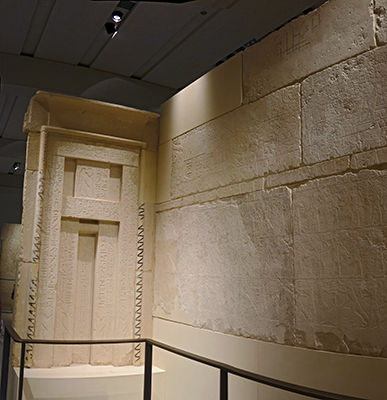
Sixth Dynasty: 2 345 BC - 2 181 BC
The door of the sacrificial chamber and the wall in the tomb of Manufer, circa 2 335 BC
Facing the entrance gate, a false door, approximately two metres high, stands at the top of a flight of three steps; it is part of the sacrificial chamber of Manufer, chief wig-maker to the king.
The two sacrificial chambers of Metjen and Manufer shown on this page were removed from the Neues Museum during WWII and were carried off to the Soviet Union at the beginning of summer 1945. In 1956 they were returned to the German Democratic Republic.
Catalog: Abusir, Manufer (tomb) ÄM 1108
Photo: Don Hitchcock 2015
Source: Original, Staatliche Museen zu Berlin, Neues Museum, Germany
Text: © Card at the Staatliche Museen zu Berlin, http://www.smb-digital.de/, (CC BY-NC-SA 3.0 DE)
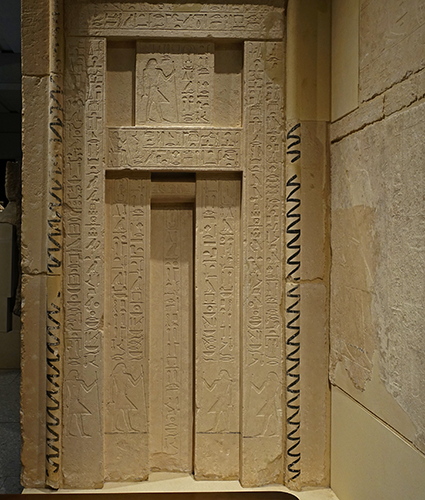
Sixth Dynasty: 2 345 BC - 2 181 BC
The door of the sacrificial chamber in the tomb of Manufer, circa 2 335 BC
Note in particular the finely detailed but small and grotesque faces carved in this door.
Catalog: Abusir, Manufer (tomb) ÄM 1108
Photo: Don Hitchcock 2018
Source: Original, Staatliche Museen zu Berlin, Neues Museum, Germany
Text: © Card at the Staatliche Museen zu Berlin, http://www.smb-digital.de/ (CC BY-NC-SA 3.0 DE)
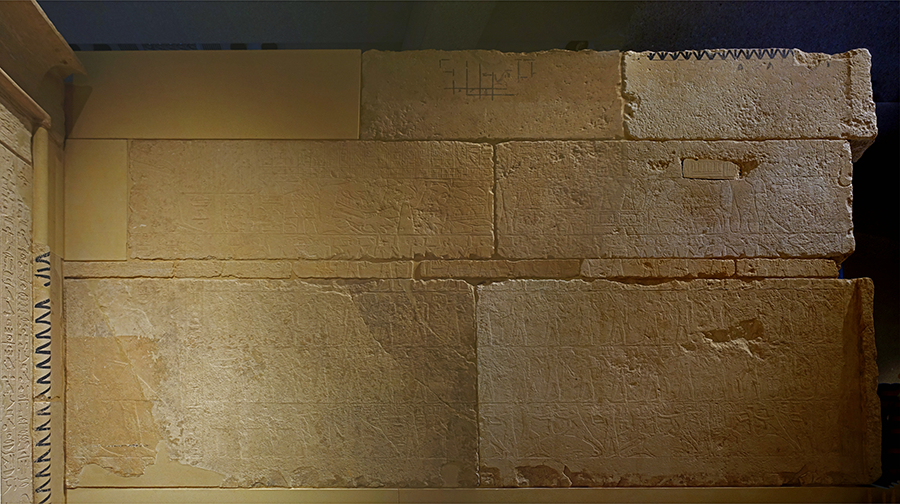
Sixth Dynasty: 2 345 BC - 2 181 BC
Wall beside the door of the sacrificial chamber in the tomb of Manufer, circa 2 335 BC
The chamber was never completed, so it gives a good idea of the process of creating such a tomb.
During restoration, dirt was removed with a laser device. Much meaning was revealed during the restoration when the tomb was cleaned and closely examined.
Catalog: Abusir, Manufer (tomb) ÄM 1108
Photo: Don Hitchcock 2015
Source: Original, Staatliche Museen zu Berlin, Neues Museum, Germany
Text: © Card at the Staatliche Museen zu Berlin, http://www.smb-digital.de/ (CC BY-NC-SA 3.0 DE)
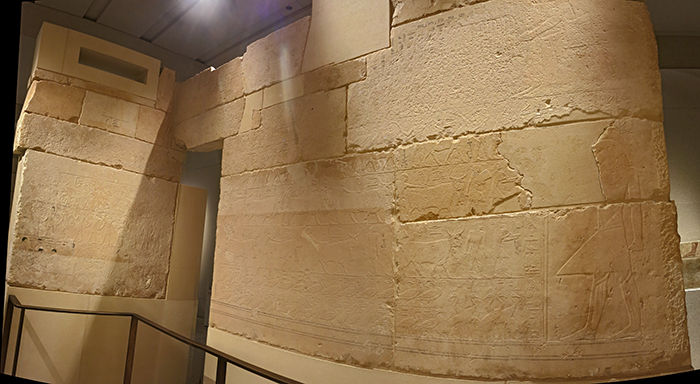
Sixth Dynasty: 2 345 BC - 2 181 BC
The tomb of Manufer, circa 2 335 BC
The tomb is an authentic look at the lifestyle of ordinary ancient Egyptians 4 500 years ago. Animal slaughtering as an offering for the afterlife is depicted. It is a hand book of the old stone carving techniques.
The relief on the walls of the burial chambers of Manufer and Merib are so graphic that they need no detailed description. They serve to offer the prospect of an ideal world in the hereafter for the deceased and their families.
The images do not aim to make direct biographical references to the deceased- with the exception of the titles and names in the hieroglyphic writings. Some of the murals in Manuferts tomb remained unfinished and show the various stages involved in creating a relief.
The most important motif in the tomb reliefs is the sacrificial offering to the deceased, including the scenes of husbandry and slaughter They are substitutes of the actual sacrificial offering performed by the descendants. This theme also runs through the reliefs and stelae from the necropolises of Memphis, Abydos and Thebes covering the epochs from the old kingdom to the New Kingdom.
Catalog: Abusir, Manufer (tomb) ÄM 1108
Photo: Don Hitchcock 2015
Source: Original, Staatliche Museen zu Berlin, Neues Museum, Germany
Text: https://www.youtube.com/watch?v=pSCKS2du2Sw
Additional text: © Card at the Staatliche Museen zu Berlin, http://www.smb-digital.de/ (CC BY-NC-SA 3.0 DE)
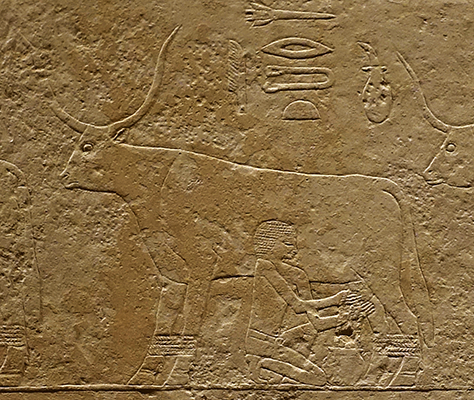
Sixth Dynasty: 2 345 BC - 2 181 BC
Burial Chamber of Manufer, circa 2 335 BC
In this image from the walls of the tomb, we can see the technique for milking a cow. The front and back legs were bound together first, then the cow was milked.
You would expect this method to have been used for a cow milked in the fields, rather than in a central milking shed, which this appears to be, whereas now pens (cow bails, where the head of the cow is restrained by a moveable piece of wood on a rod axle, while it has access to grain or hay) and perhaps a single leg rope are all that is required for hand milking.
Catalog: Abusir, Manufer (tomb) ÄM 1108
Photo: https://www.youtube.com/watch?v=pSCKS2du2Sw
Source: Original, Staatliche Museen zu Berlin, Neues Museum, Germany
Text: © Card at the Staatliche Museen zu Berlin, (CC BY-NC-SA 3.0 DE)
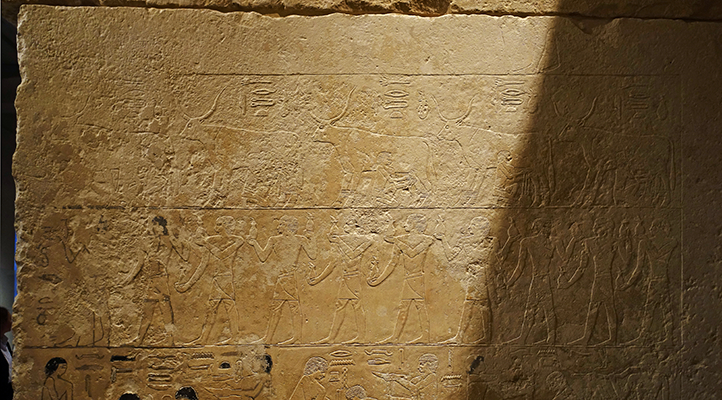
Sixth Dynasty: 2 345 BC - 2 181 BC
Burial Chamber of Manufer, circa 2 335 BC
This is the complete section of this panel.
Catalog: Abusir, Manufer (tomb) ÄM 1108
Photo: https://www.youtube.com/watch?v=pSCKS2du2Sw
Source: Original, Staatliche Museen zu Berlin, Neues Museum, Germany
Text: © Card at the Staatliche Museen zu Berlin, (CC BY-NC-SA 3.0 DE)
Sixth Dynasty: 2 345 BC - 2 181 BC
The tomb of Manufer, circa 2 335 BC
In this closeup of part of the tomb wall above, we can see both the methods used for the initial mapping out of the images, never actually completed in this case, but with the dark lines used to show the basics of the final carving still visible on the left, as well as the finished carving on the right, showing a cow being cut up ready for sacrifice to the gods.
Above the man on the right holding up what may be a sacrificial knife, we see first a hand, a common icon, but above that is a rod with a curve or hook on each end.
This is the hieroglyph for a bow consisting of oryx horns joined by a wooden centre piece.
Coincidentally no doubt, this is identical to a tool called a gambrel used in rural Australia when a lamb is prepared for the table. The legs of the beast are slit between the two lower bones, the tool is inserted, attached to a rope, and the animal is then suspended from a convenient tree branch or the rafters of a shed, to make 'dressing' (the removal of the internal organs) and skinning very much easier. These workers, however, seem to be completing the whole task on the abattoir floor.
Catalog: Abusir, Manufer (tomb) ÄM 1108
Photo: Don Hitchcock 2018
Source: Original, Staatliche Museen zu Berlin, Neues Museum, Germany
Text: © Card at the Staatliche Museen zu Berlin, (CC BY-NC-SA 3.0 DE)
Sixth Dynasty: 2 345 BC - 2 181 BC
The tomb of Manufer, circa 2 335 BC
This is the complete section of this part of the wall, shown in part above.
Catalog: Abusir, Manufer (tomb) ÄM 1108
Photo: Don Hitchcock 2018
Source: Original, Staatliche Museen zu Berlin, Neues Museum, Germany
Text: © Card at the Staatliche Museen zu Berlin, (CC BY-NC-SA 3.0 DE)
Sixth Dynasty: 2 345 BC - 2 181 BC
Servant
Figure of a servant grinding flour, circa 2 250 BC.
Catalog: Limestone, ÄS 4862
Photo: Don Hitchcock 2018
Source: Original, Ägyptischen Museum München
Text: Museum card, © Ägyptischen Museum München
Sixth Dynasty: 2 345 BC - 2 181 BC
Calcite figures
(left) EA2312: Painted calcite male figure on a limestone plinth painted red with steps at front.
Height 172 cm.
Found at the Tomb of Idy (Abydos).
(right) EA2313: Painted calcite seated male figure upon red painted limestone plinth with steps and representation of an altar at front.
Height 183 mm.
Found at Abydos.
Catalog: Painted calcite, EA2312, EA2313
Photo: Don Hitchcock 2018
Source: Original, British Museum
Text: Card with the display at the British Museum, https://www.britishmuseum.org/, © Trustees of the British Museum, CC BY-NC-SA 4.0
Sixth Dynasty: 2 345 BC - 2 181 BC
Metal Table and Vessels
Copper model altar with four legs; incised white Hieroglyphic text along front; also twenty-six copper model vessels. Found at the tomb of Idy (Abydos)
Bronze model offering table and ritual vessels of the lector-priest Idy, circa 2 300 BC, from Abydos.
This set of miniature vessels, placed in the tomb, enabled the deceased Idy to enjoy the benefits of the offering ritual throughout eternity. The different bowls, vases and spouted vessels were used for specific elements of the ritual, such as washing, the pouring of libations, the storage of sacred oils, and the offering of beer, wine and food.
Catalog: Alloy, copper, bronze, metal, tin alloy: EA5315 and four trays: EA6086-9
Photo: Don Hitchcock 2018
Source: Original, British Museum
Text: Card with the display at the British Museum, https://www.britishmuseum.org/, © Trustees of the British Museum, CC BY-NC-SA 4.0
Sixth Dynasty: 2 345 BC - 2 181 BC
Calcite table and vessels
Calcite table and vessels of the lector-priest Idy, circa 2 300 BC, from Abydos.
These vessels formed part of the equipment for the offering ritual, provided for the burial of Idy.
Catalog: Calcite, EA4684, EA4686 - EA4695
Photo: Don Hitchcock 2018
Source: Original, British Museum
Text: Card with the display at the British Museum, https://www.britishmuseum.org/, © Trustees of the British Museum, CC BY-NC-SA 4.0
Sixth Dynasty: 2 345 BC - 2 181 BC
Calcite vessels
Calcite vessels of the lector-priest Idy, circa 2 300 BC, from Abydos.
Of particular interest is the calcite vase imitating the form of a brewer's vat, with a small cylindrical spout, EA4685. This vase, of specialised form, was part of Idy's extensive set of ritual vessels and implements.
Catalog: Calcite, Abydos, EA4685
Photo: Don Hitchcock 2018
Source: Original, British Museum
Text: Card with the display at the British Museum, https://www.britishmuseum.org/, © Trustees of the British Museum, CC BY-NC-SA 4.0
Sixth Dynasty: 2 345 BC - 2 181 BC
Opening-of-Mouth ceremony
Model of equipment for Opening-of-Mouth ceremony: three rock crystal vessels and one obsidian vessel; one pink limestone implement and one schist implement; set into recesses in rectangular limestone tablet.
Length 177 mm (tablet), thickness: 25 mm (tablet), width 121 cm (tablet).
Catalog: Tomb of Idy, Abydos, EA5526
Photo: Don Hitchcock 2018
Source: Original, British Museum
Text: Card with the display at the British Museum, https://www.britishmuseum.org/, © Trustees of the British Museum, CC BY-NC-SA 4.0
Sixth Dynasty: 2 345 BC - 2 181 BC
Opening-of-Mouth ceremony
Calcite tablet to hold the seven sacred oils prescribed for use in the 'Opening of the Mouth'.
The tablet comes from the tomb of Idy.
Length 133 mm, width: 57 mm.
Rectangular limestone tablet; eight columns of incised Hieroglyphic text; seven oil-wells: equipment for Opening-of-Mouth ceremony.
Catalog: Tomb of Idy, Abydos, EA6123
Photo: Don Hitchcock 2018
Source: Original, British Museum
Text: Card with the display at the British Museum, https://www.britishmuseum.org/, © Trustees of the British Museum, CC BY-NC-SA 4.0
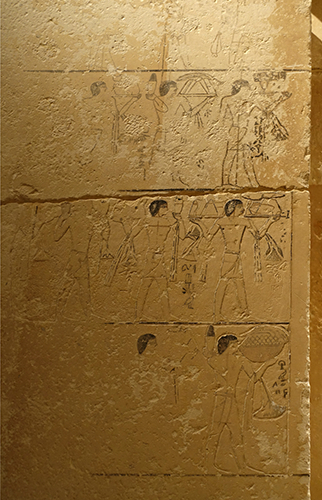
Sixth Dynasty: 2 345 BC - 2 181 BC
The tomb of Manufer, circa 2 335 BC
These 'cartoons' are an invaluable aid in determining the process by which relief drawings were completed.
Catalog: Abusir, Manufer (tomb) ÄM 1108
Photo: Don Hitchcock 2018
Source: Original, Staatliche Museen zu Berlin, Neues Museum, Germany
Text: © Card at the Staatliche Museen zu Berlin, (CC BY-NC-SA 3.0 DE)
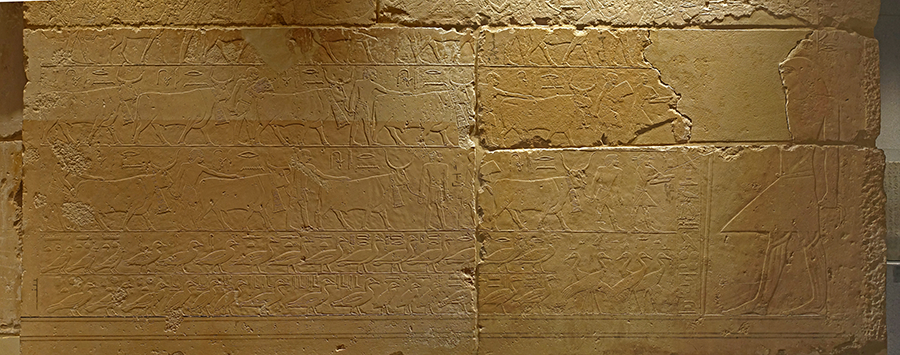
Sixth Dynasty: 2 345 BC - 2 181 BC
The tomb of Manufer, circa 2 335 BC
Panorama of part of the wall of the Manufer tomb.
Waterfowl and cattle feature prominently in this section, and were both obviously of great importance to the people.
The cattle in this particular frieze are bulls, and each wears a tasselled neckcloth, perhaps identifying the particular beast, and also incidentally showing that it belonged to Manufer.
Catalog: Abusir, Manufer (tomb) ÄM 1108
Photo: Don Hitchcock 2018
Source: Original, Staatliche Museen zu Berlin, Neues Museum, Germany
Text: © Card at the Staatliche Museen zu Berlin, (CC BY-NC-SA 3.0 DE)
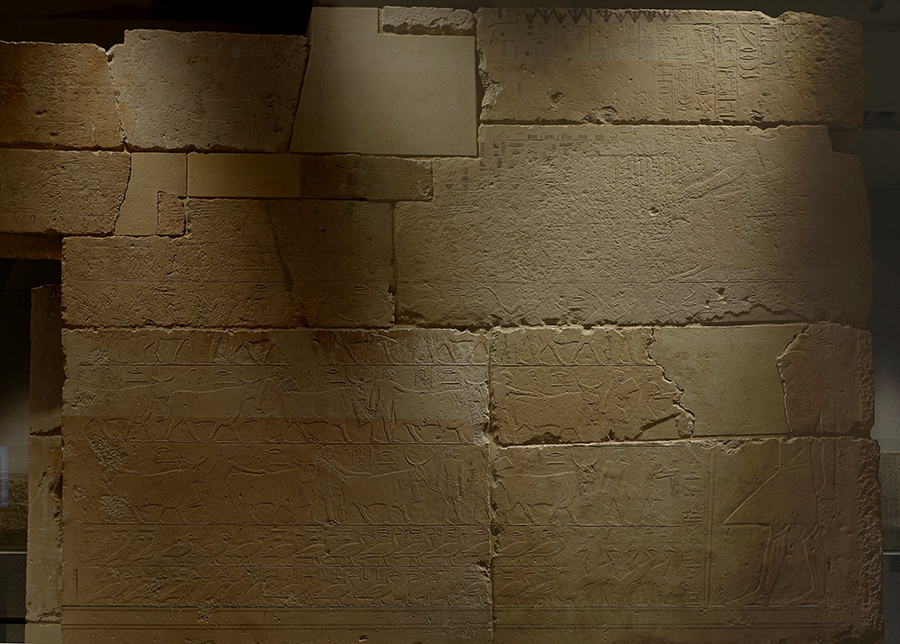
Sixth Dynasty: 2 345 BC - 2 181 BC
The tomb of Manufer, circa 2 335 BC
Panorama of the rest of this wall of the Manufer tomb, featuring waterfowl, cattle, antelope, and ibex.
Catalog: Abusir, Manufer (tomb) ÄM 1108
Photo: Don Hitchcock 2018
Source: Original, Staatliche Museen zu Berlin, Neues Museum, Germany
Text: © Card at the Staatliche Museen zu Berlin, (CC BY-NC-SA 3.0 DE)
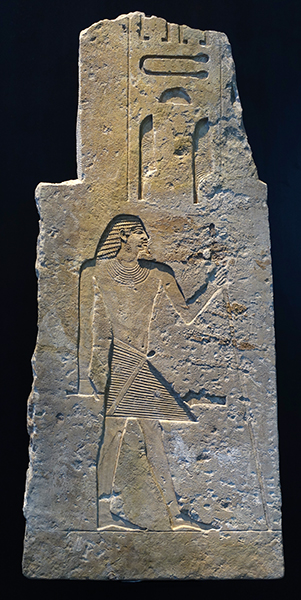
Sixth Dynasty: 2 345 BC - 2 181 BC
Tjeti
Fragment of a tomb wall.
Tjeti, the tomb owner, with insignia of rank.
Limestone, circa 2 321 BC - 2 184 BC
Catalog: Sakkara, Mastaba of Tjeti, GL 13
Photo: Don Hitchcock 2018
Source: Original, Ägyptischen Museum München
Text: © Ägyptischen Museum München
Sixth Dynasty: 2 345 BC - 2 181 BC
Harvesting
Fragment of a tomb wall.
Men harvesting in the presence of Hetepet (left)
Catalog: Limestone, Memphis/Giza, Grave of Hetepet, ÄM 15421/2/3
Photo: Don Hitchcock 2015
Source: Original, Staatliche Museen zu Berlin, Neues Museum, Germany
Text: © Card at the Staatliche Museen zu Berlin (CC BY-NC-SA 3.0 DE)
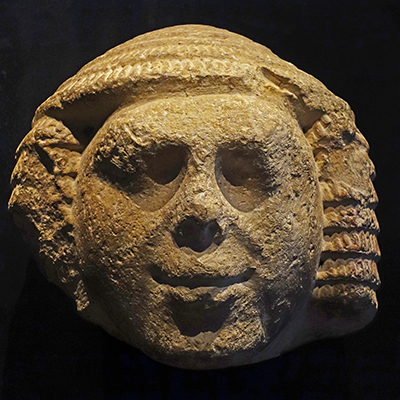
Sixth Dynasty: 2 345 BC - 2 181 BC
Nubian
Head of a Nubian from a temple wall, symbolising the subjugation of enemies.
Catalog: Limestone, ÄS 7193
Photo: Don Hitchcock 2018
Source: Original, Ägyptischen Museum München
Text: Museum card, © Ägyptischen Museum München
Sixth Dynasty: 2 345 BC - 2 181 BC
Lady Hetepet
Lady Hetepet taking a cruise across the lotus lake.
Circa 2 300 BC.
Catalog: Limestone, Memphis/Giza, Grave of Hetepet, ÄM 15420/1
Photo: Don Hitchcock 2018
Source: Original, Staatliche Museen zu Berlin, Neues Museum, Germany
Text: © Card at the Staatliche Museen zu Berlin (CC BY-NC-SA 3.0 DE)
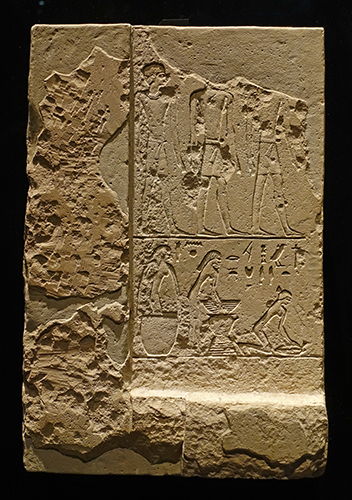
Sixth Dynasty: 2 345 BC - 2 181 BC
Relief
Striding men and brewery scene, circa 2 200 BC.
Catalog: Limestone, Gl. 120
Photo: Don Hitchcock 2018
Source: Original, Ägyptischen Museum München
Text: Museum card, © Ägyptischen Museum München
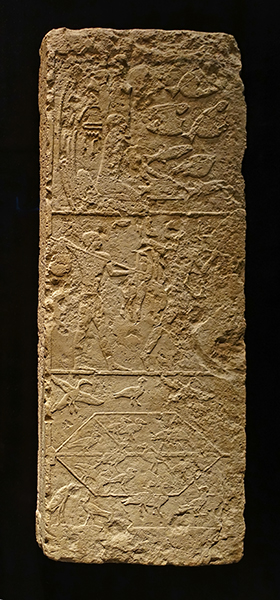
Sixth Dynasty: 2 345 BC - 2 181 BC
Relief
Scenes of fishing and fowling, circa 2 300 BC.
Catalog: Limestone, Gizeh (?), Gl. 115
Photo: Don Hitchcock 2018
Source: Original, Ägyptischen Museum München
Text: Museum card, © Ägyptischen Museum München
Sixth Dynasty: 2 345 BC - 2 181 BC
Dahshur-Decree of King Pepi I
Architectural block with the so-called Dahshur decree.
Circa 2 331 BC - 2 287 BC.
Dimensions: 650 x 1185 x 100 mm.
The decree of Pepi I (6th Dyn.) for the pyramid city of his late predecessor Snofru from the 4th Dynasty, is one of the most important and early legal texts of the Old Kingdom. At the command of Pepi I, the entire Snofru facility and the people working there are placed under special protection. For example, the priests involved in Snofru's death cult are to be exempted from labor and tax payments.
Text: RK (R. Kuhn?)
Catalog: Limestone, Dahshur, Pyramid of King Snofru (tomb), ÄM 17500
Photo: Don Hitchcock 2018
Source: Original, Staatliche Museen zu Berlin, Neues Museum, Germany
Text: © Card at the Staatliche Museen zu Berlin, http://www.smb-digital.de/, (CC BY-NC-SA 3.0 DE)
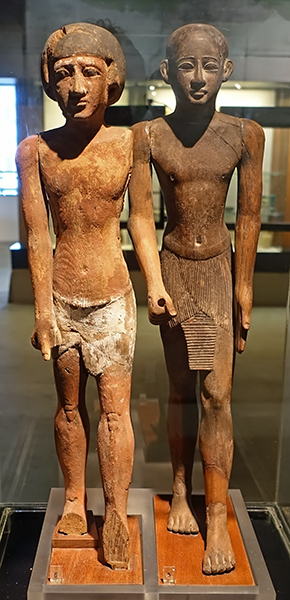
Sixth Dynasty: 2 345 BC - 2 181 BC (left)
25th Dynasty / Nubian Dynasty / Kushite Empire: 760 BC - 656 BC (right)
Statuettes of two men
(left) Circa 2190 BC
(right) Circa 700 BC
Wood was the most common material for funerary statuettes throughout Egyptian history. However, it was not worth less than stone, because good wood is rare in the Nile Valley and had to be imported at great expense.
Circa 1500 years after the carving of the statuette on the left, the one on the right was created, but with great similarity, perhaps as a result of archaism at that time. The face and the back are recent additions from old wood of the 4th century BC.
Catalog: Wood, unknown origin, (left) Inv. Nr. 1925.223 (right) Inv. Nr. 1925.236
Photo: Don Hitchcock 2018
Source and text: Original, Museum August Kestner, Hannover
Sixth Dynasty: 2 345 BC - 2 181 BC
Ovoid jar
Ovoid jar with the names of Pepi I and his pyramid complex.
Circa 2 331 BC - 2 287 BC.
Dimensions: 535 x 400 x 400 mm.
This beautifully crafted, ovoid calcite-alabaster vessel contains inscriptions about King Pepi I's first Sed festival and the name of his pyramid complex near the town of Memphis, which served as the capital in the Old Kingdom. The Sed festival was one of the most important ceremonies for the king, which is believed to have taken place after the first 30 years of his reign. During this ceremony, the king had to perform numerous rites that renewed his power and vitality. However, sed festivals were probably celebrated more frequently than only every 30 years.
Text: R. Kuhn
Catalog: Calcite-alabaster (travertine), Memphis / Saqqara, Pyramid of King Snofru (tomb), ÄM 7715
Photo: Don Hitchcock 2018
Source: Original, Staatliche Museen zu Berlin, Neues Museum, Germany
Text: © Card at the Staatliche Museen zu Berlin, http://www.smb-digital.de/, (CC BY-NC-SA 3.0 DE)
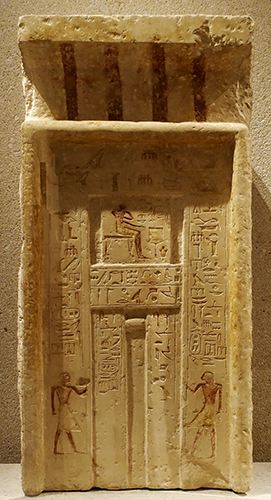
Sixth Dynasty: 2 345 BC - 2 181 BC
Pepi-mer-hebsed
False door of Pepi-mer-hebsed, chief of the tenant-farmers under king Pepi I.
Catalog: Limestone, ÄM 1109
Photo: Don Hitchcock 2018
Source: Original, Staatliche Museen zu Berlin, Neues Museum, Germany
Text: © Card at the Staatliche Museen zu Berlin (CC BY-NC-SA 3.0 DE)
The statue was indispensable to funerary equipment. The image of the tomb owner in the round was considered a replacement for the body; it received its individuality through the likeness of its facial features and an inscription with the name and titles of the person represented. Tomb sculpture mostly concentrated on two types: the seated and the standing-striding figureText above: Poster, © Ägyptischen Museum München
Group statues depicted the tomb owner amidst his family circle. The repertoire could be completed by scribal figures and block statues.
The images were often set up in a small chamber, the serdab (from the Arabic 'basement'), linked to the cult chamber by a narrow slit. This allowed the deceased to keep participating in earthly life by means of his statue.
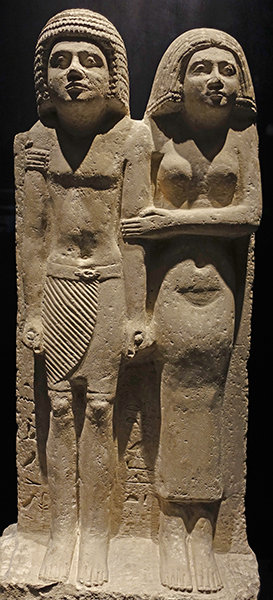
Sixth Dynasty: 2 345 BC - 2 181 BC
Group Statue
Group Statue of the couple Imsu and Wati, circa 2 250 BC.
( For verisimilitude the museum curator had placed this group statue (as described in the text above) in a small chamber with just a very narrow slit to view it.
All very well, but it is possibly the most difficult to photograph exhibit I have ever come across! - Don )
Catalog: Limestone, Gizeh, Gl. 25
Photo: Don Hitchcock 2018
Source: Original, Ägyptischen Museum München
Text: Museum card, © Ägyptischen Museum München
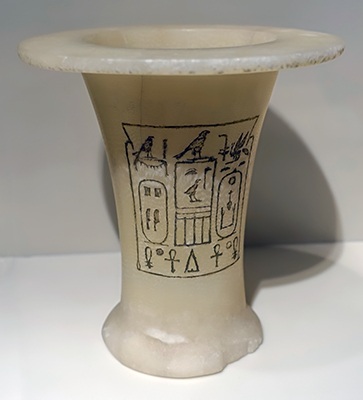
Sixth Dynasty: 2 345 BC - 2 181 BC
Ointment jar
Cup-shaped ointment jar with the inscription of King Pepi II.
Circa 2 278 BC - 2 184 BC.
Dimensions: 155 x 145 mm. Footprint 85 mm.
The shape of the jar indicates its use as an ointment jar for precious cosmetic oils. The hieroglyphic inscription, in which remnants of blue paint have survived, shows the king's proper name 'Pepi' and his throne name Nefer-ka-Re ('With perfect Ka des Re') in cartouches. The Horus name, which in Pepi II corresponds to the Nebti or Two Mistresses name, is in the middle of the text field and is written in Serech. The Goldhorus name Bjk-nebu-sechem ('Mighty Gold Hawk') is above the proper name.
Text: J. Jancziak
Catalog: Calcite-alabaster (travertine), painted, unknown provenance, ÄM 14280
Photo: Don Hitchcock 2018
Source: Original, Staatliche Museen zu Berlin, Neues Museum, Germany
Text: © Card at the Staatliche Museen zu Berlin, http://www.smb-digital.de/, (CC BY-NC-SA 3.0 DE)
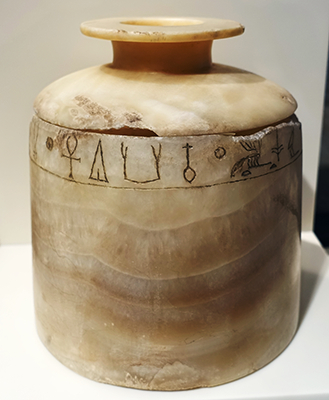
Sixth Dynasty: 2 345 BC - 2 181 BC
Lidded jar
Lidded jar with the inscription of King Pepi II.
Circa 2 278 BC - 2 184 BC.
Catalog: Calcite-alabaster (travertine), painted, unknown provenance, ÄM 14281
Photo: Don Hitchcock 2018
Source: Original, Staatliche Museen zu Berlin, Neues Museum, Germany
Text: © Card at the Staatliche Museen zu Berlin, (CC BY-NC-SA 3.0 DE)
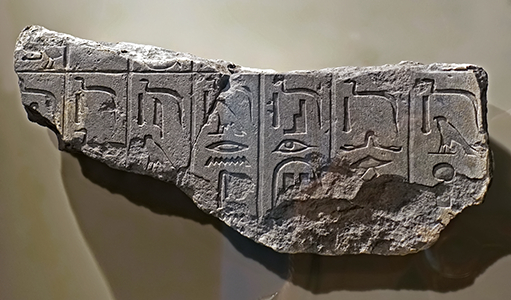
Sixth Dynasty: 2 345 BC - 2 181 BC
Spells
Relief fragment with the spells 354 and 255 from the pyramid texts, reign of King Pepi II.
Circa 2 278 BC - 2 184 BC.
Catalog: Painted limestone, Saqqara, Pyramid of Pepi II, ÄM 14667
Photo: Don Hitchcock 2018
Source: Original, Staatliche Museen zu Berlin, Neues Museum, Germany
Text: © Card at the Staatliche Museen zu Berlin, (CC BY-NC-SA 3.0 DE)
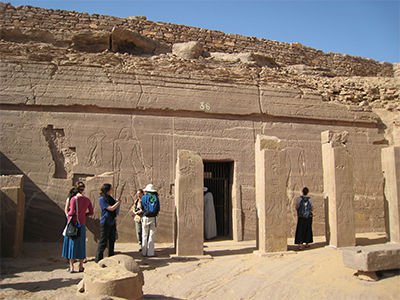
Qubbet el-Hawa is a site of a group of Rock-cut tombs known as the Princes' Tomb on the west side of the Nile, opposite Aswan. The Princes' Tombs date mainly from the Old Kingdom which provide important details of the lives of officials at this time - including the tomb of Harkhuf, a governor of Upper Egypt under the pharaoh Merenre I, third king of the 6th Dynasty. There are a few later tombs, from the Middle Kingdom and New Kingdom.
Between 1959 and 1984, Investigation and excavations at Qubbet el-Hawa were conducted by the Egyptological Seminar of the University of Bonn under the direction of Professor Elmar Edel (1914-1997) in more than 20 campaigns. The finds were given the abbreviation QH for Qubbet el-Hawa and numbered consecutively. The finds of more than 1000 artefacts from a total of 25 graves were shipped to Bonn. Today, the Ägyptische Museum der Universität Bonn has the world's biggest collection of objects from this necropolis outside Egypt.
Photo: Karen Green
Permission: Creative Commons Attribution-Share Alike 2.0 Generic license
Text: Ägyptische Museum der Universität Bonn, Wikipedia
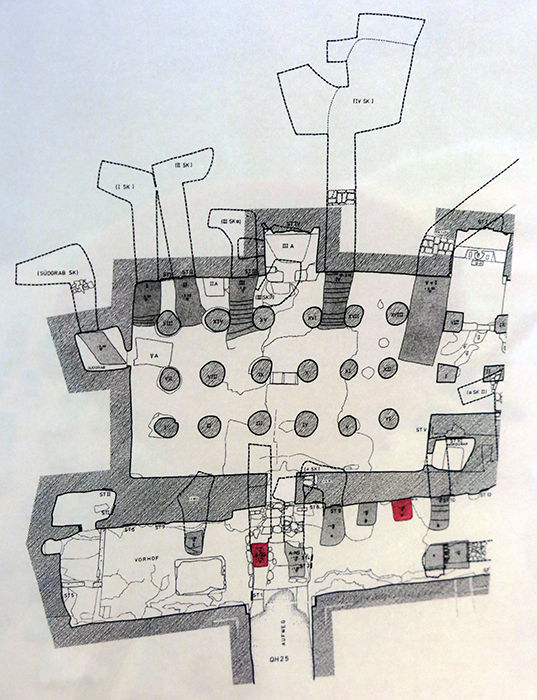
Plan of the Qubbet el-Hawa site.
Photo: Don Hitchcock 2014
Source: Ägyptische Museum der Universität Bonn
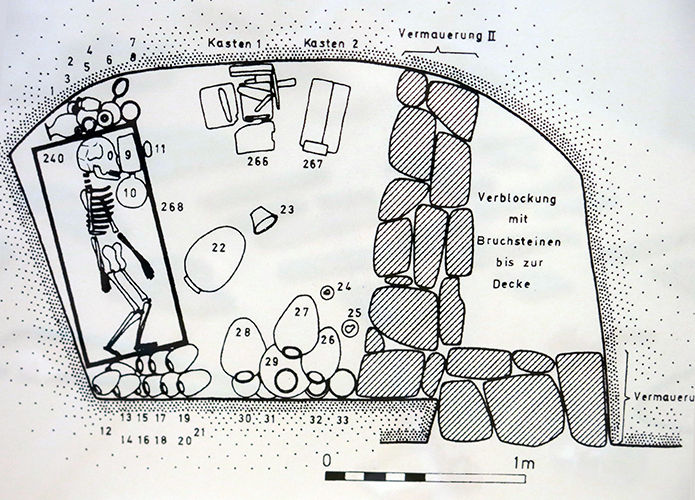
Plan of a gravesite at Qubbet el-Hawa.
Photo: Don Hitchcock 2014
Source: Ägyptische Museum der Universität Bonn
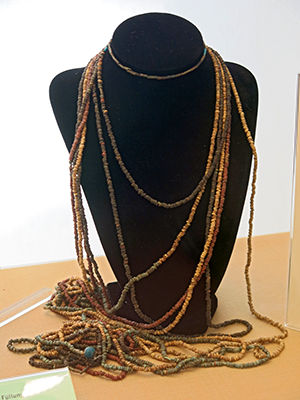
Sixth Dynasty: 2 345 BC - 2 181 BC.
Beads
Qubbet el-Hawa, QH 25, Shaft III, Coffin Chamber ß: Burial of a 7-year-old boy.
Painted clay, Faience.
Old Kingdom, Sixth Dynasty, circa 2 300 BC
Catalog: 'Various numbers', (not detailed on the display)
Photo: Don Hitchcock 2014
Source: Original, Ägyptische Museum der Universität Bonn
Sixth Dynasty: 2 345 BC - 2 181 BC.
Statuette of a man
Statuette of a man in Jujubier wood, Ziziphus jujuba
The man is standing with (as is common) the left foot forward, dressed in a triangular kilt with a flat apron, wearing a short curly wig. The triangular apron is quite impractical, but serves to show that the wearer was a member of the nobility, and did not need to do things for himself.
( If he were a member of the lower class, he would have worn the very comfortable and practical kilt called the 'shendyt' which only extended to above the knees. When nobility did wear this, when hunting for sport in the marshes of the Nile perhaps, it was made in expensive fabrics.
In the 21st century, some women keep their fingernails long and painted, and wear very high heels, both quite impractical for everyday tasks, but for similar unspoken underlying reasons, but often explained away as 'fashion'.
Men wear expensive neck ties, spotless shirts, polished shoes, and tailored suits in exotic fabrics for similar reasons of showing their status. It is no accident that we often refer to the managerial class who do no physical work as 'suits', often in a derogatory fashion - Don )
Height 273 mm, width 75 mm, depth 70 mm.
Catalog: Painted red-black Jujubier wood, Aile Sully, Room 334, level 0, vitrine 3, E 10484, AF 504
Photo: Don Hitchcock 2015
Source and text: Original, Louvre Museum, Paris, France, https://collections.louvre.fr/
Sixth Dynasty: 2 345 BC - 2 181 BC.
Tcheti
Tcheti was a nobleman, shown standing with left foot forward, a triangular kilt, left arm forward, and depicted with a shaved head.
His titles are given as prince, chancellor of the king of Lower Egypt, sole friend.
Height 880 mm, width 238 mm, depth 513 mm.
( the statue originally had inlaid eyes fixed with adhesive, but these are now lost. The rough scars where the eyes were formerly attached may be seen on the statue. The wooden base on which the statue now stands may well be the original - Don )
Photo: Don Hitchcock 2015, 2018
Catalog: Acacia wood, Akhmîm = Panopolis, Aile Sully, Room 334, level 0, vitrine 3, E 11566
Source and text: Original, Louvre Museum, Paris, France, https://collections.louvre.fr/
Sixth Dynasty: 2 345 BC - 2 181 BC.
Standing Man
Standing man, left foot forward, short wig, kilt with smooth front, braces.
Height 527 mm, width 130 mm, depth 290 mm.
Photo: Don Hitchcock 2015, 2018
Catalog: Painted Ficus wood, stuccoed, Aile Sully, Room 334, level 0, vitrine 3, E 10357
Source and text: Original, Louvre Museum, Paris, France, https://collections.louvre.fr/
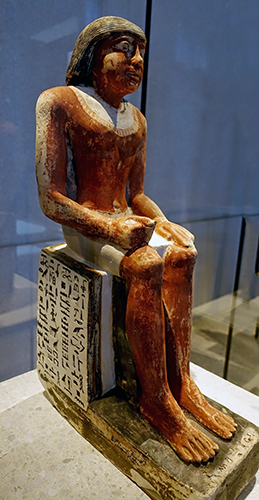
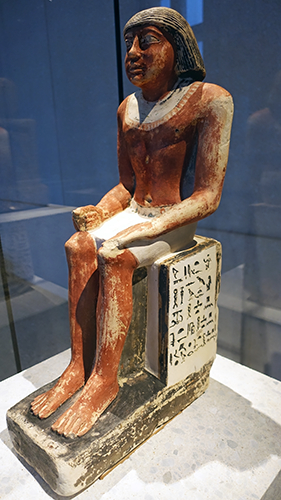
Sixth Dynasty: 2 345 BC - 2 181 BC.
Hetepni
Seated statue of the chamberlain of the king, Hetepni.
His other titles included Overseer of the royal scribes of the counting of cattleherdsmen in the two houses.
Painted limestone, circa 2 200 BC.
Catalog: ÄM 34428
Photo: Don Hitchcock 2018
Source: Original, Staatliche Museen zu Berlin, Neues Museum, Germany
Text: © Card at the Staatliche Museen zu Berlin (CC BY-NC-SA 3.0 DE)
Additional text: http://www.griffith.ox.ac.uk/gri/3berlin.pdf
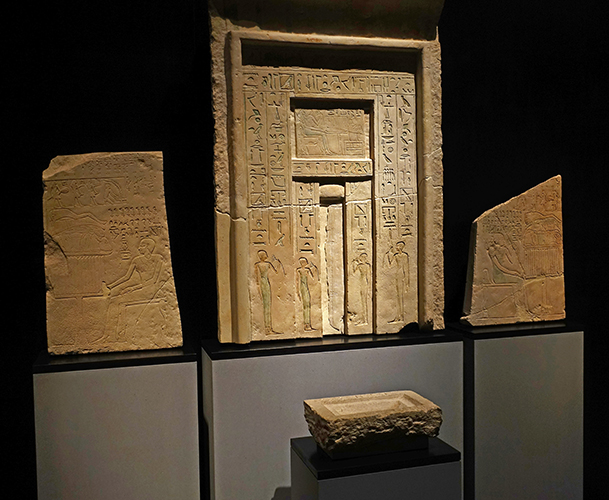
Sixth Dynasty: 2 345 BC - 2 181 BC
False Door
Tomb niche with false door stela and side walls, circa 2 200 BC.
Also included here is a limestone offering basin of Nednef and his wife, circa 2 300 BC.
Catalog: Limestone, Sakkara, Grave of Chnumit, ÄS 6288, ÄS 1301
Photo: Don Hitchcock 2018
Source: Original, Ägyptischen Museum München
Text: © Ägyptischen Museum München
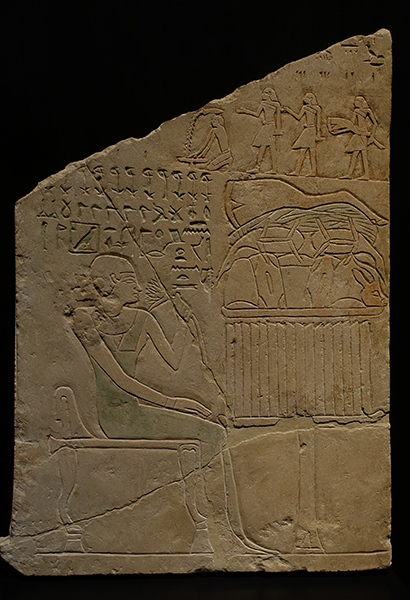
Sixth Dynasty: 2 345 BC - 2 181 BC
False Door and side walls
The false door stela was the interface between this world and the next. This is where the soul of the deceased could enter and leave the tomb. Offering basins of food and liquid offerings were therefore set up directly in front of the false door stela. Above the door, the tomb owner is often shown sitting before an offering table, in the place where, in earthly architecture, a window would usually appear.
Catalog: Limestone, Sakkara, Grave of Chnumit, ÄS 6288
Photo: Don Hitchcock 2018
Source: Original, Ägyptischen Museum München
Text: © Ägyptischen Museum München
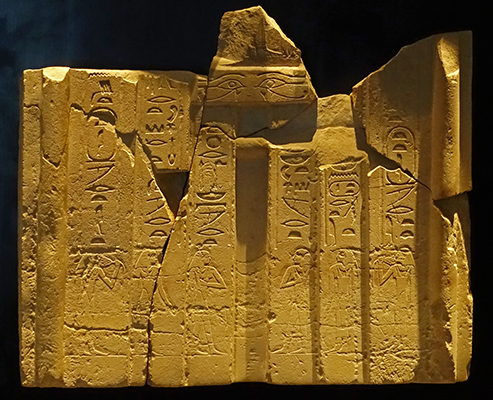
Sixth Dynasty: 2 345 BC - 2 181 BC
False Door
False door stela of Merit-itet-Teti, circa 2 340 BC
Catalog: Limestone, Sakkara Gl. 108
Photo: Don Hitchcock 2018
Source: Original, Ägyptischen Museum München
Text: © Ägyptischen Museum München
Sixth Dynasty: 2 345 BC - 2 181 BC
False Door
False Door fragments from the stela of Meni, circa 2 200 BC
Catalog: Limestone, Gizeh, Gl. 24a-b
Photo: Don Hitchcock 2018
Source: Original, Ägyptischen Museum München
Text: © Ägyptischen Museum München
Sixth Dynasty: 2 345 BC - 2 181 BC
Offering Basin
Limestone offering basin of Nednef and his wife, circa 2 300 BC.
Catalog: Limestone, Sakkara, Grave of Chnumit, ÄS 1301
Photo: Don Hitchcock 2018
Source: Original, Ägyptischen Museum München
Text: © Ägyptischen Museum München
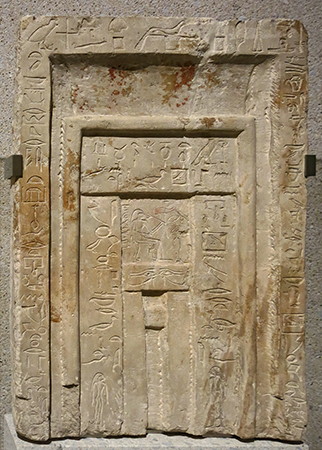
Sixth Dynasty: 2 345 BC - 2 181 BC.
Satintef
False door of the tomb of the mistress Satintef.
Circa 2200 BC.
Catalog: Limestone, ÄM 7718
Photo: Don Hitchcock 2015
Source: Original, Staatliche Museen zu Berlin, Neues Museum, Germany
Text: © Card at the Staatliche Museen zu Berlin (CC BY-NC-SA 3.0 DE)
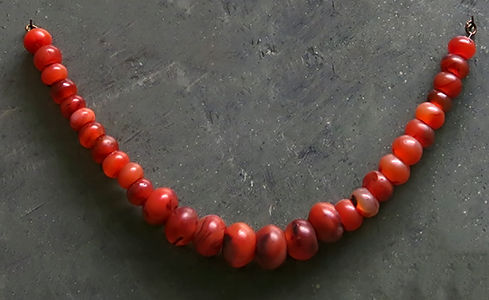
Sixth Dynasty: 2 345 BC - 2 181 BC.
Bead Necklace
Necklace of beads of carnelian, circa 2 200 BC
Catalog: Excavations at Dara, E 25216
Photo: Don Hitchcock 2015
Source: Original, Musée du Louvre
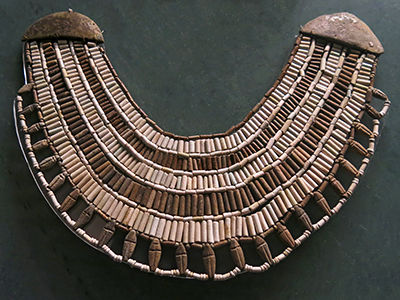
Sixth Dynasty: 2 345 BC - 2 181 BC.
Bead Necklace
Necklace of faience, circa 2 200 BC
Catalog: Excavations at Dara, E 17284 - E 17290
Photo: Don Hitchcock 2015
Source: Original, Musée du Louvre
False-Door Stelae of the Old Kingdom
Towards the end of the Old Kingdom, the decoration of the tombs, more and more often made of mudbrick, was slowly reduced to a very few stone elements. Both of these reliefs (1) were originally inserted into narrow door niches in the eastern exterior wall of the tomb building of Eldest of the House Meni; the round beam just over the 'door' has survived. In a cramped space, small-scale scenes show Meni enjoying a boat trip with his family, with offering-bearers and the grinding of grain. The inscription on the left-hand relief incorporates a formula to repel tomb desecrators.
Sixth Dynasty: 2 345 BC - 2 181 BC.
Stela of Meni
Fragments from the false-door stela of Meni.
Circa 2 200 BC.
Catalog: limestone, Gizeh, GL 24a - 24b
Photo: Don Hitchcock 2015
Source: Original, Ägyptischen Museum München
Text: © Ägyptischen Museum München
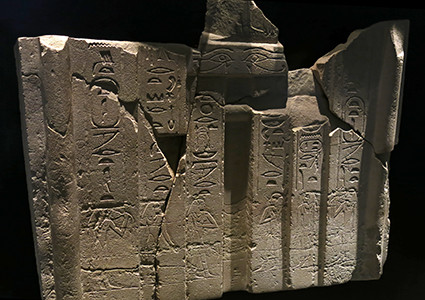
Sixth Dynasty: 2 345 BC - 2 181 BC.
False-door stela of Merit-itet-Teti
Equally characteristic for the late Old Kingdom is an extremely narrow door with multiple nested embrasures shown here, circa 2 340 BC.
Catalog: limestone, Sakkara, GL 108
Photo: Don Hitchcock 2015
Source: Original, Ägyptischen Museum München
Text: © Ägyptischen Museum München
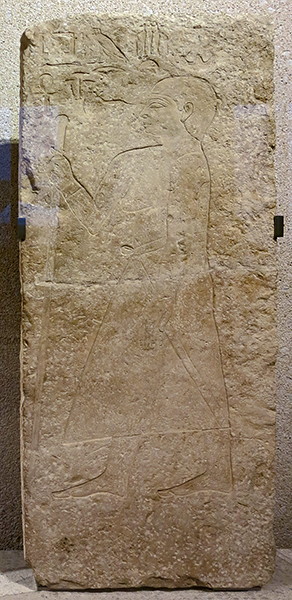
Sixth Dynasty: 2 345 BC - 2 181 BC.
Ankh-haef
Relief of the tomb of Ankh-haef. 6th Dynasty, circa 2300 BC
( note that these dates are consistent, but there is another figure called Ankhhaf who lived in the fourth dynasty, and was a son of pharaoh Sneferu and an unknown wife - Don )
Catalog: Limestone, ÄM 15321
Photo: Don Hitchcock 2015
Source: Original, Staatliche Museen zu Berlin, Neues Museum, Germany
Text: © Card at the Staatliche Museen zu Berlin, (CC BY-NC-SA 3.0 DE)
Sixth Dynasty: 2 345 BC - 2 181 BC.
Hoeing and Beer Making
(left) Painted wooden model of a servant brewing beer.
(right) Painted wooden statuette of a peasant using a hoe.
Catalog: From Asyut, tomb 45, EA45196, EA45195
Photo: Don Hitchcock 2018
Source: Original, British Museum
Text: Card at museum display © Trustees of the British Museum, CC BY-NC-SA 4.0
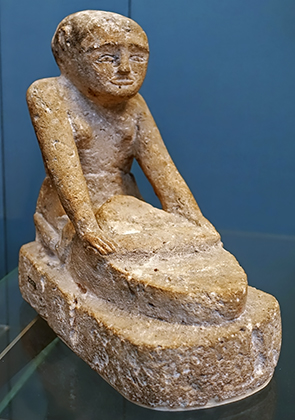
Sixth Dynasty: 2 345 BC - 2 181 BC.
Grinding grain
Limestone statuette of a servant grinding grain.
Small servant figures were placed in tombs as early as the First Dynasty. During the Fourth to Sixth Dynasties, limestone figures represented baking, brewing, butchery and other activities.
Catalog: Provenance unknown, EA2378
Photo: Don Hitchcock 2018
Source: Original, British Museum
Text: Card at museum display © Trustees of the British Museum, CC BY-NC-SA 4.0
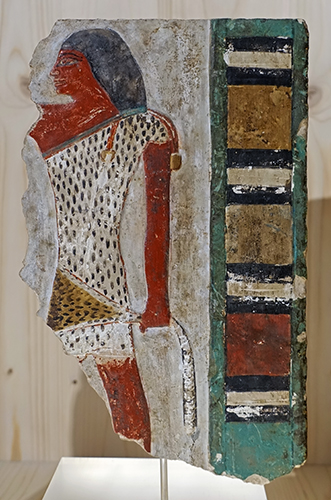
Sixth Dynasty: 2 345 BC - 2 181 BC.
Speaking priest
Relief with a speaking priest, circa 2 300 BC
The priest can be recognised by his panther skin cloak, whose tail is gripped by his left hand.
His right arm is stretched out to the front and the hand is - as several parallels show - shown in the gesture of speech. The priest is reciting ritual sayings.
Catalog: Limestone, painted
Photo: Don Hitchcock 2018
Source and text: Original, Museum August Kestner, Hannover
Sixth Dynasty: 2 345 BC - 2 181 BC.
Gift-bringers
Early 6th Dynasty, circa 2 300 BC.
Catalog: Limestone, painted, Abusir (?), Inv. no. 1954.40
Photo: Don Hitchcock 2018
Source and text: Original, Museum August Kestner, Hannover
Sixth Dynasty: 2 345 BC - 2 181 BC.
Bird Catchers
Early 6th Dynasty, circa 2 300 BC.
( Note that the artist has demonstrated stop motion 'photography' with the birdcatcher on the left hand panel. The bird struggling to free itself in his left hand has been sculpted with four separate positions of the right wing, and two positions of the head and neck, like four frames from a movie - Don )
Catalog: Limestone, Saqqara, Inv. Nr. 1957.78
Photo: Don Hitchcock 2018
Source and text: Original, Museum August Kestner, Hannover
Sixth Dynasty: 2 345 BC - 2 181 BC.
Sacrifice Ritual
List of offerings, with sacrifice ritual.
End of 5th Dynasty, beginning of 6th Dynasty, circa 2 300 BC.
Catalog: Limestone, painted, Saqqara, Inv. no. 1972.19
Photo: Don Hitchcock 2018
Source and text: Original, Museum August Kestner, Hannover
Sixth Dynasty: 2 345 BC - 2 181 BC.
Model of a boat
This polychrome wooden boat is 1073 mm long, 210 mm wide and 252 mm high.
Photo: Don Hitchcock 2018
Catalog: N 2457, from the Salt collection.
Source and text: Louvre Museum, Paris, France
Additional text: http://cartelfr.louvre.fr/
Sixth Dynasty: 2 345 BC - 2 181 BC.
Animals in the Nile, Tomb of Djau
During the 6th Dynasty, the powerful nomarchs of the 12th nome of Upper Egypt were buried in rock-cut tombs near Deir El Gabrawi. Some of these nomarchs held the title Great Overloard of the Abydene Nome, and so controlled a large area extending from the 8th nome (Abydos) to the 13th nome of Upper Egypt.
Catalog: Painting on limestone, Tomb of Djau, Deir el-Gebrawi, Inv. no. 1974.4 a-g
Photo: Don Hitchcock 2018
Source and text: Original, Museum August Kestner, Hannover
Additional text: Wikipedia, García (2012)
Sixth Dynasty: 2 345 BC - 2 181 BC.
Animals in the Nile, Tomb of Djau
Deir el-Gabrawi is the most important Old Kingdom necropolis of the Upper Egyptian 12th nome, is formed of two cliffs, the northern one near the village of Arab el-Atiyat and the southern one near the village of Deir el-Gabrawi. Its tombs date back to the late Old Kingdom, although an earlier chronology has been suggested. However, no trace of a contemporary town has yet been found. A rather peculiar characteristic of Deir el-Gabrawi is that some local governors simultaneously controlled the 12 th as well as the 8th Upper Egyptian nomes during the 6 th Dynasty.
Catalog: Painting on limestone, Tomb of Djau, Deir el-Gebrawi, Inv. no. 1974.4 a-g
Photo: Don Hitchcock 2018
Source and text: Original, Museum August Kestner, Hannover
Additional text: Wikipedia, García (2012)
Sixth Dynasty: 2 345 BC - 2 181 BC.
Animals in the Nile, Tomb of Djau
Djau was a vizier of Upper Egypt during the Sixth Dynasty. He was a member of an influential family from Abydos; his mother was the vizier Nebet, his father was called Khui. His two sisters Ankhesenpepi I and Ankhesenpepi II married Pharaoh Pepi I. Djau was already in office when his nephew Pepi II became pharaoh. He is mentioned in two royal decrees, one from Abydos, the other from Coptos; one of them is dated to Year 11. It is unknown when he died, but when the tomb of Pepi II was decorated, he was no longer vizier.
Catalog: Painting on limestone, Tomb of Djau, Deir el-Gebrawi, Inv. no. 1974.4 a-g
Photo: Don Hitchcock 2018
Source and text: Original, Museum August Kestner, Hannover
Additional text: Wikipedia
Fish displayed on the walls of the tomb of Djau
| Fish displayed on the walls of the tomb of Djau | ||
|---|---|---|
| Common Name | Scientific Name | Comment |
| Moon-fish | Genus Alestes | Type species Salmo niloticus |
| Moon-fish | Citharinus geoffroyi | Also called lutefish |
| Moon-fish | Labeo sp. | Genus of carp |
| Barbel | Labeobarbus bynni | Niger barb |
| Catfish | Eutropius niloticus | African butter catfish |
| Catfish | Synodontis schall | Wahrindi, upside-down catfish, thrives now in Lake Nasser on the Nile |
| Catfish | Synodontis membranaceus | Moustache catfish, upside-down catfish |
| Grey mullet | Mugil sp. | |
| Nile perch | Lates niloticus | Substantial economic and food security importance in East Africa |
| Boulti | Oreochromis niloticus | a species of tilapia, a cichlid fish native to the northern half of Africa and the Levante area |
| Boulti | Tilapia galilaea | A fish from the cichlid family that is native to fresh and brackish waters in Africa and the Levant |
| Ball-fish | Tetraodon fahaka | Fahaka pufferfish, Nile puffer, wide ranging in Africa, toxic |
Sixth Dynasty: 2 345 BC - 2 181 BC.
Funeral Barge of Djau, Tomb of Djau
Copy of an image on the walls of the Tomb of Djau, Deir el-Gebrawi.
Artist: Percy Buckman, 1893
Source and text: Davies (1902)
Sixth Dynasty: 2 345 BC - 2 181 BC.
Pepy-Ankh-Nes, wife of Djau, Tomb of Djau
Copy of an image on the walls of the Tomb of Djau, Deir el-Gebrawi.
Artist: Percy Buckman, 1893
Source and text: Davies (1902)
Catalog: Carnelian, faience, snail shells, Inv. No. 1921.2.20/22
Photo: Don Hitchcock 2018
Source and text: Original, Museum August Kestner, Hannover
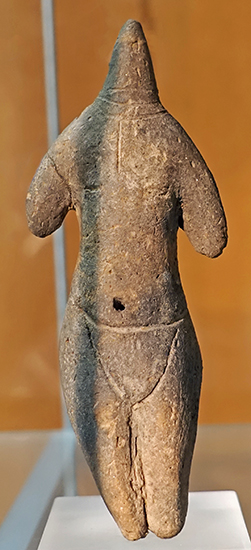
2 300 - 1 500 BC
Female Figure
Dating and localisation of the figure are problematic.
Similarly structured female sculptures were found as grave goods of the so-called C-group population (circa 2 300 - 1 500 BC) in Nubia.
Perhaps from Lower Nubia, the northernmost part of Nubia, possibly as far north as Aswan.
Height 104 mm.
As can be deduced with a high degree of certainty from similar objects from historical times, the figure served the deceased as a 'bedmate' or for procreation and renewal of his own life.
From this point of view, the individual, distinctive personality was less important to him than the feminine 'of itself'. Therefore, everything individual is avoided, even the limbs are merely indicated, while the abdomen and the pubic triangle are emphasised. It is girdled by a belt - together with an indication of neck jewellery, the only 'clothing'. A small ball or disc may have sat as a head on the tapering neck.
Catalog: Ceramic, Inv. no. 1950.16
Photo: Don Hitchcock 2018
Source and text: Original, Museum August Kestner, Hannover
Additional text: Paper catalogue, Museum August Kestner, Hannover
The Seventh and Eighth Dynasties
2 181 BC - 2 160 BC
The Seventh and Eighth Dynasties of ancient Egypt (notated Dynasties VII and VIII) are often combined together and regroup a line of poorly known short-lived pharaohs reigning in the early 22nd century BC, a troubled time referred to as the very end of the Old Kingdom or the beginning of the First Intermediate Period, depending on the scholar.
An important resource for dating the Dynasties of Egypt is what is known as the 'Turin Canon'. The Turin Canon is a list of kings written in hieratic script on a papyrus which dates to the reign of Ramesses II (1 290 - 1 224 BC. It is now housed in the Egyptian Museum in Turin, Italy. It contains some information which is also found in Manetho, giving the name of Menes as the first king of Egypt, and listing the gods and demigods as the rulers of the Predynastic Period. It supplies the complete years of each king's reign and any additional months and days, but since only fragments of the papyrus have survived, only 80 - 90 of the total of royal names are preserved.Text above: David (2002)
| Seventh and Eighth Dynasties | |||||
|---|---|---|---|---|---|
| Name | Other names or Identities |
Attested by | Burial | Years | Dates |
| Menkare | Possibly attested by a relief from the tomb of Queen Neit |
||||
| Neferkare II | |||||
| Neferkare Neby | Planned or started a pyramid 'Neferkare Neby is Enduring of Life', possibly at Saqqara |
||||
| Djedkare Shemai | |||||
| Neferkare Khendu | |||||
| Merenhor | |||||
| Neferkamin | |||||
| Nikare | Attested by the Abydos King List and possibly by a cylinder seal |
||||
| Neferkare Tereru | |||||
| Neferkahor | Attested by a cylinder seal | ||||
| Neferkare Pepiseneb | ≥1 (Turin Canon) | ||||
| Neferkamin Anu | - 2 170 BC | ||||
| Qakare Ibi | Pyramid at Saqqara | Two years, one month, one day |
2 169 BC - 2 168 BC | ||
| Neferkaure | Date attested by a decree concerning the temple of Min |
four years, two months |
2 167 BC - 2 164 BC | ||
| Khwiwihepu Neferkauhor | Date attested by 8 decrees re the temple of Min, and an inscription in the tomb of the vizier Shemay |
two years, one month, one day |
2 163 BC - 2 162 BC | ||
| Neferirkare | Date attested by a decree re temple of Min, if he is identical to either or both Horus Demedjibtawy or Wadjkare |
one and a half years |
2 161 BC - 2 160 BC | ||
Seventh and Eighth Dynasties
2 181 BC - 2 160 BC
Twelve Gold Cowrie Shaped Beads
Twelve gold cowries, on modern string with many small electrum beads, also disc beads of blue faience, recorded as coming from the ankles area, though cowries were usually strung on girdles in the Middle Kingdom and Third Intermediate Period. From tomb 7923 at Qau. Beads also recorded in 1938-1939 by Xia Nai (Shiah) during his PhD research, on his bead-card no. 777.
Length 600 mm, Accession Number LDUCE-UC18092
Photo: Don Hitchcock 2018
Source: Original, Petrie Museum, London, England
Text: Card / online catalogue, the Petrie Museum, © 2015 UCL. CC BY-NC-SA license.
Seventh and Eighth Dynasties
2 181 BC - 2 160 BC
String of Beads
1 Amazonite stone barrel, 4 carnelian (2 barrel, 1 short barrel, 1 short cylinder) and about 30 tiny blue faience, from Qau, Tomb 7923, Shiah No. 780, length 73 mm, Accession Number
LDUCE-UC18093
Amazonite, also known as Amazonstone, is a green tectosilicate mineral, a variety of the potassium feldspar called microcline. Its chemical formula is KAlSi3O8, which is polymorphic to orthoclase.
Its name is taken from that of the Amazon River, from which green stones were formerly obtained, though it is unknown whether those stones were Amazonite. Although it has been used for jewellery for well over three thousand years, as attested by archaeological finds in Middle and New Kingdom Egypt and Mesopotamia, no ancient or medieval authority mentions it. It was first described as a distinct mineral only in the 18th century.
Photo: Don Hitchcock 2018
Source: Original, Petrie Museum, London, England
Text: Card / online catalogue, the Petrie Museum, © 2015 UCL. CC BY-NC-SA license.
Additional text: Wikipedia
Seventh and Eighth Dynasties
2 181 BC - 2 160 BC
Amulets and Beads
Gold crown amulet (63D6), five steatite cylinder beads (75A18, B6, B10, B16); one carnelian cylinder bead (75J10), two carnelian spheriod ring beads (82H6, H10), one carnelian ring bead (86L2), few blue faience ring beads (86N16), few shell ring beads (86M6, M12), one black faience drop pendant bead (89T6), one grey/white crumb bead (94H6) Carnelain amulet (17D6) missing.
Qau, Tomb 5262, Accession Number LDUCE-UC20666
Photo: Don Hitchcock 2018
Source: Original, Petrie Museum, London, England
Text: Card / online catalogue, the Petrie Museum, © 2015 UCL. CC BY-NC-SA license.
Seventh and Eighth Dynasties
2 181 BC - 2 160 BC
Long String of Beads
Long string of marine shell ring beads (86, M6, M12, M10), black faience ring beads (86N10) and blue faience ring beads (86N16)
Qau, Tomb 5262, Accession Number LDUCE-UC20663
Photo: Don Hitchcock 2018
Source: Original, Petrie Museum, London, England
Text: Card / online catalogue, the Petrie Museum, © 2015 UCL. CC BY-NC-SA license.
Seventh and Eighth Dynasties
2 181 BC - 2 160 BC
Amulets, Beads
Carnelian lion amulet (15B21), two carnelian spheroid ring beads (86C16, L4) a few shell ring beads (86M10, N6). Long string of black faience ring beads (86N6, N8, P18) and blue faience drop pendant bead (89L8)
From Qau, Tomb 5286, Accession Number LDUCE-UC20671
Photo: Don Hitchcock 2018
Source: Original, Petrie Museum, London, England
Text: Card / online catalogue, the Petrie Museum, © 2015 UCL. CC BY-NC-SA license.
Ninth Dynasty
2 160 BC - 2 130 BC
The Ninth Dynasty of ancient Egypt (sometimes notated Dynasty IX) is often combined with 7th, 8th, 10th and early 11th Dynasties under the group title First Intermediate Period. The dynasty that seems to have supplanted the 8th Dynasty is extremely obscure. The takeover by the rulers of Herakleopolis was violent and is reflected in Manetho's description of Achthoes, the founder of the dynasty, as 'more terrible than his predecessors', who 'wrought evil things for those in all Egypt'.
The 9th Dynasty was founded at Herakleopolis Magna, and the 10th Dynasty continued there. At this time Egypt was not unified, and there is some overlap between these and other local dynasties. The Turin Canon lists eighteen kings for this royal line, but their names are damaged, unidentifiable, or lost.
Above text: Wikipedia
Note that in the table below, a nomarch is the governor of an Ancient Egyptian nome, or a subnational administrative division of ancient Egypt. This is the Greek term, the Ancient Egyptian term was sepat.
Manetho was an historian of Egypt. Manetho is believed to have authored the Aegyptiaca of Manetho, or Manetho's Egyptian History, at the request of Ptolemy II Philadelphus. The work is of great interest to Egyptologists for evidence of the chronology of the reigns of the ancient pharaohs.
| Ninth Dynasty | |
|---|---|
| Name | Comments |
| Meryibre Khety | Horus name Meryibtawy, and Manetho's Achthoes, a nomarch who proclaimed himself pharaoh |
| Name lost | |
| Neferkare VII | Might be the Kaneferre mentioned in the tomb of the nomarch Ankhtifi |
| Setut | |
| Name lost | |
| Mery(...) | |
| Shed(...) | |
| H(...) | |
| (three names lost) | |
| User(...) | |
Ninth Dynasty: 2 160 BC - 2 130 BC
Copper Container
Copper container with Meryibre Khety's royal titulary. Paris, Louvre. Some sources identify this as a brazier.
Height 5 cm, length 16 cm, depth 13 cm.
Catalog: E 10501
Photo (left): Guillaume Blanchard
Permission: Creative Commons Attribution-Share Alike 3.0 Unported license.
Photo (right): © Musée du Louvre
Source: Original, Musée du Louvre
Text: © Musée du Louvre, Wikipedia
Ninth - Tenth Dynasties: 2 160 BC - 2 040 BC
Ring beads
String of white marine shell ring beads (86P10), Qau, Tomb 3421, Accession Number LDUCE-UC20807.
Photo: Don Hitchcock 2018
Source: Original, Petrie Museum, London, England
Text: Card / online catalogue, the Petrie Museum, © 2015 UCL. CC BY-NC-SA license.
Ninth - Tenth Dynasties: 2 160 BC - 2 040 BC
Beads
One carnelian barrel bead (78F2), two carnelian ring beads (82C9, 86L2), one carnelian pendant bead (89M10) and string of black faience and shell ring beads (86M11, P10)
Qau, Tomb 3421, Accession Number LDUCE-UC20809
Photo: Don Hitchcock 2018
Source: Original, Petrie Museum, London, England
Text: Card / online catalogue, the Petrie Museum, © 2015 UCL. CC BY-NC-SA license.
Ninth - Tenth Dynasties: 2 160 BC - 2 040 BC
Bead Collar
Green glazed faience bead collar in original order of stringing.
7 rows of cylinders juxtaposed in the following arrangement:
Row 1: short vertical cylinders; Row 2: 2 horizontal alternate with two vertical; Row 3: 2 vertical alternate with two horizontal; Row 4 as row 3; Row 5: vertical larger cylinders; Row 6: 21 horizontal cylinders with 20 pendants, having loops at each end, in between; Row 7: horizontally placed long and short cylinders.
Large semicircular spacers at each end.
( I have fixed typos in the text - Don )
From Sedment, Tomb 1512, burial of a woman, Accession Number LDUCE-UC31717.
Photo: Don Hitchcock 2018
Source: Original, Petrie Museum, London, England
Text: Card / online catalogue, the Petrie Museum, © 2015 UCL. CC BY-NC-SA license.
Ninth - Tenth Dynasties: 2 160 BC - 2 040 BC
Bead Collar
Green glazed faience bead collar in original order of stringing.
7 rows of cylinders juxtaposed in the following arrangement:
Collar of dark blue and green glazed faience beads (5 are black banded) in the original order of stringing - plain and fancy cylinders and barrels placed in a square arrangement (total 35); 9 lines drop from squares 14-21 of vertically placed short, medium and long plain and fancy cylinders; each terminating in a fancy spheroid.
From Sedment, tomb number not recorded, Accession Number LDUCE-UC31718.
Photo: Don Hitchcock 2018
Source: Original, Petrie Museum, London, England
Text: Card / online catalogue, the Petrie Museum, © 2015 UCL. CC BY-NC-SA license.
Ninth - Tenth Dynasties: 2 160 BC - 2 040 BC
Bead Collar
Dark blue and green glazed faience bead collar in original order of stringing - plain and fancy cylinders arranged vertically in the first three rows; 4th row - 25 vertical barrels; 5th row and sides - 30 plain and fancy horizontal and vertical (at sides) cylinders; 8 fancy spheroids - 3 at each end of first 3 rows and 1 at each far end of top row.
From Sedment, tomb number not recorded, Accession Number LDUCE-UC31716.
Photo: Don Hitchcock 2018
Source: Original, Petrie Museum, London, England
Text: Card / online catalogue, the Petrie Museum, © 2015 UCL. CC BY-NC-SA license.
The First Intermediate Period, often described as a 'dark age' in ancient Egyptian history, spanned approximately one hundred and twenty-five years, from circa 2 181 – 2 055 BC, after the end of the Old Kingdom. It comprises the seventh (although it is mostly considered spurious by Egyptologists), eighth, ninth, tenth, and part of the eleventh dynasties. Very little monumental evidence survives from this period, especially towards the beginning of the era. The First Intermediate Period was a dynamic time in history where rule of Egypt was roughly divided between two competing power bases. One of those bases resided at Heracleopolis in Lower Egypt, a city just south of the Faiyum region. The other resided at Thebes in Upper Egypt. It is believed that during this time, the temples were pillaged and violated, their existing artwork was vandalised, and the statues of kings were broken or destroyed as a result of this alleged political chaos. These two kingdoms would eventually come into conflict, with the Theban kings conquering the north, resulting in reunification of Egypt under a single ruler, Mentuhotep II, during the second part of the eleventh dynasty. This event marked the beginning of the Middle Kingdom of Egypt. (Wikipedia)Text above: Adapted from Wikipedia and https://www.ancient.eu/First_Intermediate_Period_of_Egypt/
However, Egyptologist Barbara Watterson commented:
The loss of central authority during the First Intermediate Period should have led to a breakdown in social order, but Egyptian society remained hierarchical, with local governors taking over as leaders of society. In the period following the end of the Old Kingdom, people of quite low status in society owned tombs, hitherto restricted to the privileged, often employing local craftsmen of limited talent to build them. Most of these tombs, being made of mud-brick, have disappeared: but many of the stone funerary stele associated with them have survived. The stelae are engraved with short biographies of the occupants, men proud of their own localities and intensely loyal to the local rulers, who, during the First Intermediate Period, provided for their welfare while maintaining social order.
First intermediate period, 2 181 BC ;- 2 025 BC.
Tomb stela of Rehu and his wife, around 2150 BC.
Height 285 mm.
Catalog: Limestone, Gebelein (?). Gebelein was a town in Egypt. It is located on the Nile, about 40 km south of Thebes. On loan from a private owner.
Photo: Don Hitchcock 2018
Source: Original, Ägyptischen Museum München
Text: © Ägyptischen Museum München
Additional text: http://www.leben-in-luxor.de/luxor_lexikon_museen_smaek2.html
First intermediate period, 2 181 BC - 2 025 BC.
Boats and a shield
G: Model of a wooden but papyrus shaped boat. The sailors are setting sail going south, against the current of the nile, while the chair stands ready for the soul of the deceased.
First intermediate period, 2 181 BC - 2 025 BC.
H. Model of a papyrus boat. Papyrus was the material used for boats meant for short fishing or hunting trips.
Middle Kingdom, 2 025 BC - 1 700 BC.
I. Model of an ox-hide shield. Middle Kingdom, 2 025 BC - 1 700 BC.
Photo: Don Hitchcock 2014
Source: Original, Københavns (Copenhagen) Museum, National Museum of Denmark
First intermediate period, 2 181 BC - 2 025 BC.
Boats
The wooden figures of the tomb models had magical life, therefore they were able to work for the dead person. This tomb group is from Heracleopolis.
The ship with oars and cabin is sailing downstream, while the sailing boat without oars (the sail is missing) is sailing upstream with the prevailing wind which comes from the north.
Photo: Don Hitchcock 2014
Source: Original, Københavns (Copenhagen) Museum, National Museum of Denmark
First intermediate period, 2 181 BC - 2 025 BC.
Beer, bread and a granary
This tomb group is also from Heracleopolis.
The servants are making bread and beer on the left, with an ox being slaughtered in the background, and working in a granary on the right.
Photo: Don Hitchcock 2014
Source: Original, Københavns (Copenhagen) Museum, National Museum of Denmark
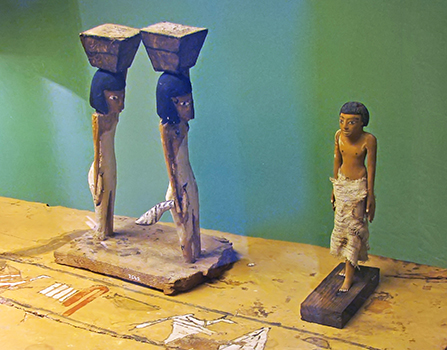
First intermediate period, 2 181 BC - 2 025 BC.
Nakht-kau
Girls bringing food for Nacht-kau. His statuette is of much finer workmanship than those of the workers. This tomb group is also from Heracleopolis.
Photo: Don Hitchcock 2014
Source: Original, Københavns (Copenhagen) Museum, National Museum of Denmark
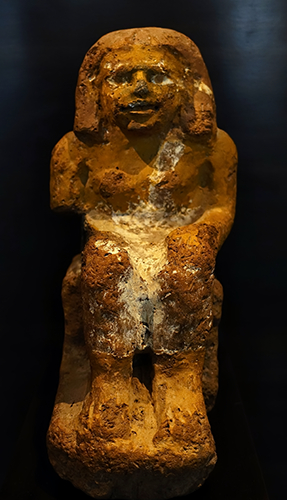
First intermediate period, 2 181 BC ;- 2 025 BC.
Khety
Seated figure of Khety, circa 2150 BC, from Assiut.
Assiut is on the Nile, about 375 km south of Cairo, 470 km west of the Red Sea, and 305 km north of Luxor.
Catalog: Clay, Assiut, ÄS 7092
Photo: Don Hitchcock 2018
Source: Original, Ägyptischen Museum München
Text: © Ägyptischen Museum München
Additional text: http://www.leben-in-luxor.de/luxor_lexikon_museen_smaek2.html
First intermediate period, 2 181 BC - 2 025 BC.
Seated figure
Seated figure of a man, circa 2 150 BC
Catalog: Limestone, ÄS 6797
Photo: Don Hitchcock 2015, 2018
Source: Original, Ägyptischen Museum München
Text: © Ägyptischen Museum München
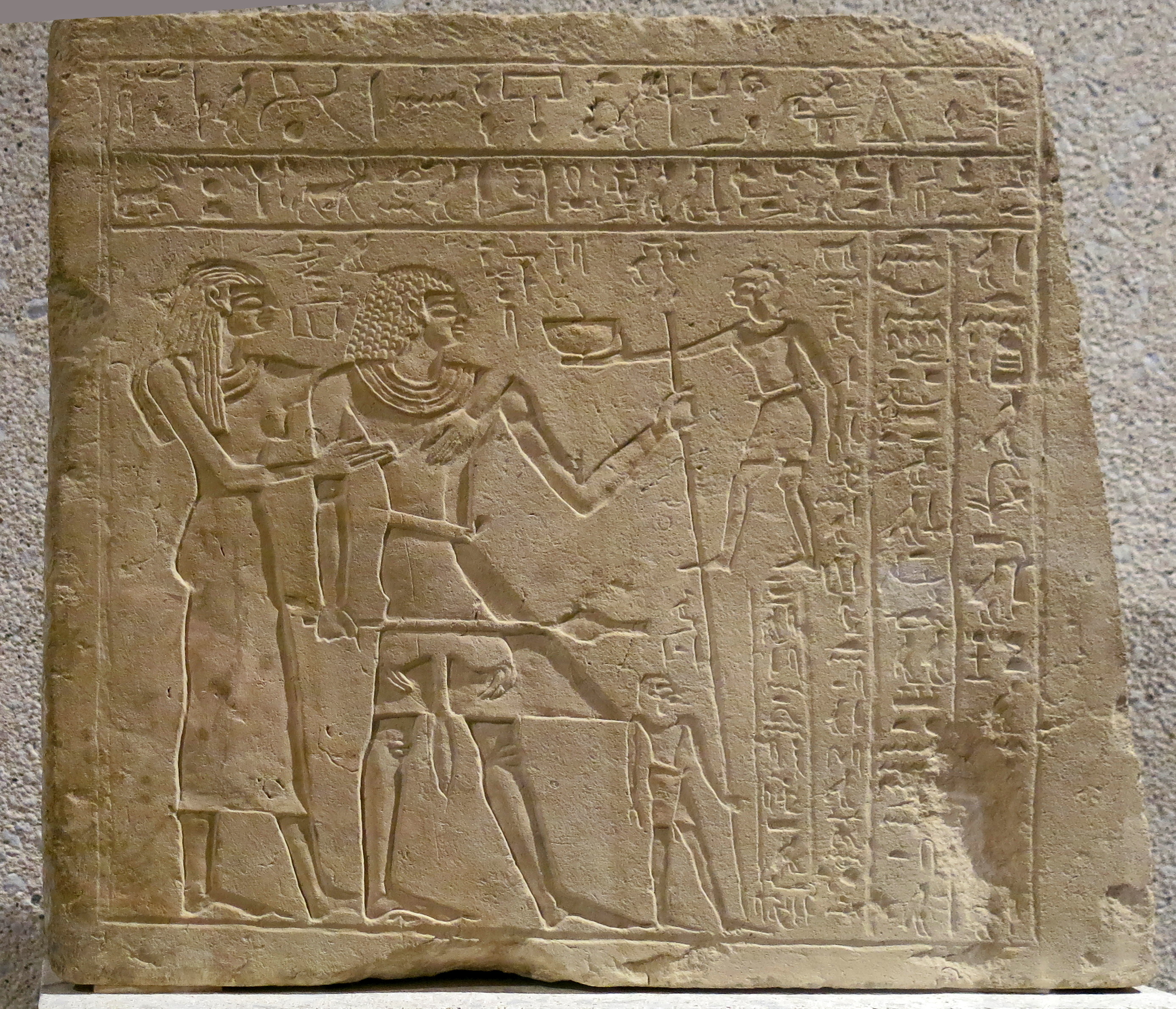
First Intermediate Period: 2 170 BC - 2 025 BC
Tomb Relief of Kedes and his mother Jbeb.
460 x 495 x 100 mm
Kedes is shown, together with his wife and his son, receiving sacrifices. He was active in military service in Gebelein, south of Luxor. He self-confidently reports on his achievements and abilities by saying, amongst other things, that he was a faster runner than the Nubian and Egyptian soldiers in his squad.
Catalog: Gebelein; Limestone, ÄM 24032
Photo: Don Hitchcock 2015
Source: Original, Staatliche Museen zu Berlin, Neues Museum, Germany
Text: © Card at the Staatliche Museen zu Berlin, http://www.smb-digital.de/ (CC BY-NC-SA 3.0 DE)
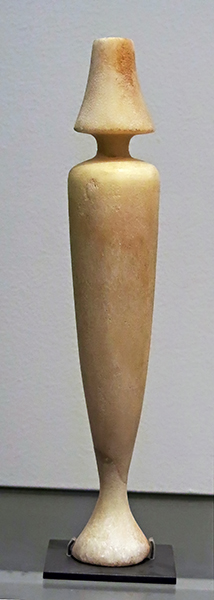
First Intermediate Period: 2 170 BC - 2 025 BC
Hes Vase
( This is a simulacrum in the exterior form of a hes vase, solid throughout, made specifically as grave goods, since grave goods only needed to appear to be the real thing, and would magically transform into the correct form for the use of the deceased - Don )
Height 200 mm, diameter 36 mm.
Catalog: Alabaster, from Dara, on the western shore of the Nile in Middle Egypt, E 25194
Location: Aile Sully, Salle 322, La momie, Vitrine 1
Photo: Don Hitchcock 2015
Source and text: Original, Louvre Museum, https://collections.louvre.fr/
First Intermediate Period: 2 170 BC - 2 025 BC
Beads, Amulets
Circa 2 100 BC, Qua/Bedari Tomb 5313.
String of carnelian beads (2), leg amulets and 20 small Conus shells. From the intact tomb of a pregnant woman, Badari 5313, found at ankles. Modern stringing.
Circa 2 100 BC, Qua/Bedari Tomb 5313.
Items displayed here are taken from the intact tomb (western chamber) of a pregnant female found with black wavy hair. The artefacts represent 'magical beliefs'. Discovered in 1925 by the British School of Archaeology in Egypt, headed by Guy Brunton.
Length: 145 mm, Accession Number LDUCE-UC18070
Photo: Don Hitchcock 2018
Source: Original, Petrie Museum, London, England
Text: Card / online catalogue, the Petrie Museum, © 2015 UCL. CC BY-NC-SA license.
The Tenth Dynasty
2 130 BC - 2 040 BC
The 9th Dynasty was founded at Herakleopolis Magna, and the 10th Dynasty continued there. At this time Egypt was not unified, and there is some overlap between these and other local dynasties. The Turin Canon lists eighteen kings for this royal line, but their names are damaged, unidentifiable, or lost.
| Tenth Dynasty | |
|---|---|
| Name | Comments |
| Meryhathor | Existence doubtful, known from a damaged graffito at Hatnub |
| Neferkare VIII | Might be the Kaneferre mentioned in the tomb of the nomarch Ankhtifi |
| Wahkare Khety III | May be the author of the famous Teaching for King Merikare. The cartouches of Wahkare Khety were found on the outer coffin of the steward Nefri, (Cairo CG 28088) |
| Merykare | Main opponent of the Theban pharaoh Mentuhotep II |
| (name lost) | Successor of Merykare, lasted only a few months |
The burial of Hetepnebi
Tomb 56 at Asyut
Hetepnebi was a local official, whose titles included those of Sole Companion, and Inspector of the priests of the ka-chapel of one of the two kings of the 6th Dynasty named Pepy. Ka-chapels, established at important towns, contained statues which acted as the focus for the mortuary cults of rulers. The forms of the pottery vessels from his tomb suggest that Hetepnebi was buried around 2090 BC, approximately a century after the death of Pepy II.
The rock-cut tomb of Hetepnebi was excavated in 1907. It was one of a group of tombs dating to the end of the Old Kingdom and First Intermediate Period, situated at the eastern end of the Asyut cemetery. It comprised a vertical shaft leading to a small burial chamber closed with wooden planks. The coffin, aligned north-south, contained the mummy lying on its left side. Pottery jars, statues and models lay on the floor next to the coffin. Although the tomb had not been entered since the burial, the body had been partially stripped in the search for valuables, perhaps by those responsible for closing the tomb.
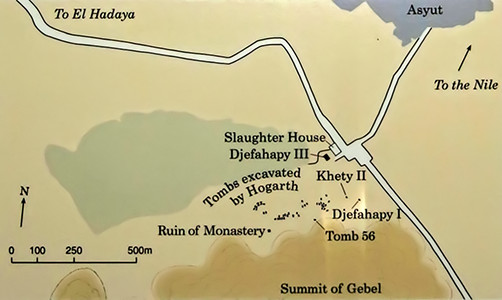
Tenth Dynasty: 2 130 BC - 2 040 BC
Hetepnebi
Plan of the cemetery showing the approximate location of tomb 56, and the tombs of the governors at Asyut.
Photo: Poster, British Museum, © Trustees of the British Museum, CC BY-NC-SA 4.0
Rephotography: Don Hitchcock 2015
Text: Poster at the British Museum, http://www.britishmuseum.org/, © Trustees of the British Museum, CC BY-NC-SA 4.0
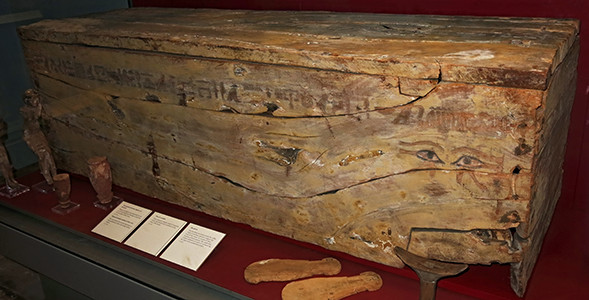
Tenth Dynasty: 2 130 BC - 2 040 BC
Hetepnebi
Hetepnebi was a local official, whose titles included those of Sole Companion, and Inspector of the priests of the ka-chapel of one of the two kings of the 6th Dynasty named Pepy. Ka-chapels established at important towns, contained statues which acted as the focus for the mortuary cults of rulers.
The forms of the pottery vessels from his tomb suggest that Hetepnebi was buried around 2090 BC, during the Tenth Dynasty, approximately a century after the death of Pepy II from the 6th Dynasty, who reigned in the period 2 278 BC - 2 184 BC.
The coffin from Tomb 56 at Asyut is made from small pieces of tamarisk wood, joined together with wooden dowels, and originally secured at the corners by means of leather thongs. The slots to accommodate these can still be seen. Length 1865 mm.
Catalog: EA46629
Photo: Don Hitchcock 2015
Source: Original, British Museum
Text: Card at the British Museum, http://www.britishmuseum.org/, © Trustees of the British Museum, CC BY-NC-SA 4.0
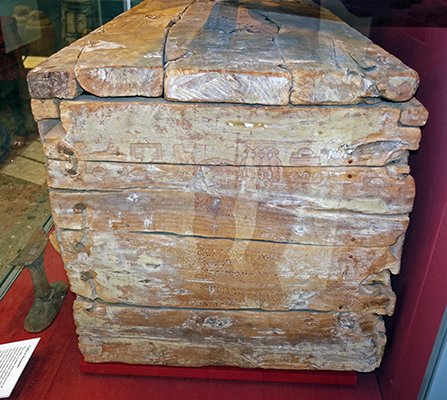
The simple decoration of the coffin consists of a pair of eyes located at the head end on the east facing side, and brief inscriptions requesting offerings from the gods Anubis and Khenyamentiu. The inscriptions are incised. The order of the hieroglyphic signs used to spell the owner's name was altered in antiquity.
Catalog: EA46629
Photo: Don Hitchcock 2018
Source: Original, British Museum
Text: Card at the British Museum, http://www.britishmuseum.org/, © Trustees of the British Museum, CC BY-NC-SA 4.0
Tenth Dynasty: 2 130 BC - 2 040 BC
Hetepnebi Head rest
This headrest was found inside the coffin, where it had been placed to support the head of the corpse. It consists of three sections jointed together. The upper and central elements are made of sycomore fig, the base of an unidentified timber.
Height 170 mm, width 182 mm, depth 65 mm.
Both sides are shown in the photographs above.
Catalog: EA45122
Photo: Don Hitchcock 2015, 2018
Source: Original, British Museum
Text: Card at the British Museum, http://www.britishmuseum.org/, © Trustees of the British Museum, CC BY-NC-SA 4.0
Tenth Dynasty: 2 130 BC - 2 040 BC
Hetepnebi Sandals
These funerary sandals, made of tamarisk wood, were found still in position on the feet of the corpse.
The photographs show the top and bottom views of the sandals.
Catalog: EA47563
Photo: Don Hitchcock 2015, 2018
Source: Original, British Museum
Text: Card at the British Museum, http://www.britishmuseum.org/, © Trustees of the British Museum, CC BY-NC-SA 4.0
Tenth Dynasty: 2 130 BC - 2 040 BC
Hetepnebi Brewer Models
These two painted wooden figures of male brewers are represented in the act of straining mash through a cloth into vats in order to brew beer.
Catalog: EA45164, EA45165
Photo: Don Hitchcock 2015, 2018
Source: Original, British Museum
Text: Card at the British Museum, http://www.britishmuseum.org/, © Trustees of the British Museum, CC BY-NC-SA 4.0
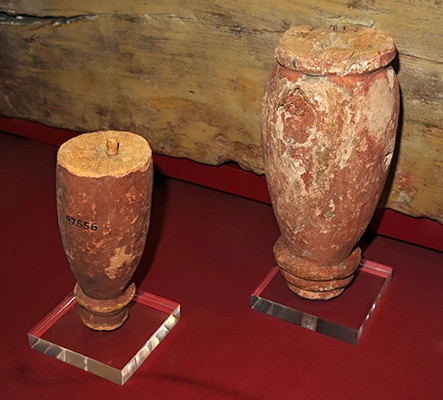
Tenth Dynasty: 2 130 BC - 2 040 BC
Hetepnebi Beer Vats
These painted wooden models of beer vats represent the vats used by the ancient Egyptians in the production of beer, and were produced as large pottery vessels.
They belong with the brewer models above.
The smaller vat has lost its lid, evidenced by the dowel which once held it in place.
Catalog: EA47555, EA47556
Photo: Don Hitchcock 2015
Source: Original, British Museum
Text: Card at the British Museum, http://www.britishmuseum.org/, © Trustees of the British Museum, CC BY-NC-SA 4.0
Tenth Dynasty: 2 130 BC - 2 040 BC
Hetepnebi boat
Model boat with crew of paddlers.
The shape of this model boat with a crew of paddlers in modelled on that of a papyrus boat. The craft was propelled by paddles, and the crew, unlike oarsmen, faced forwards.
A cavity at the stern may have held a figure of the owner, such as the statuette EA45091 shown below, and a pilot originally stood at the prow.
Wooden model of boat with paddlers: the hull is narrow and shallow, modelled clearly on papyrus canoe, with flush deck. There is now no trace of a painted deck-plan; apparently the deck was red-painted all over. The sides are red, with a broad black sheer-line painted over the red and there is a red edge to the deck with blobs of black which may represent leather fittings.
The bow and stern are black over an original red. The is no mast or rigging. The fittings are all lost. The squatting attitude of the crew and the fact that they all face forward show that this boat was supposed to be paddled and not rowed; the crew, unlike rowers, face in the direction of travel. The absence of steering-gear is probably original. Five rectangular holes in the bows are of doubtful purpose; a large rectangular cavity in the stern may once have held a figure of the owner.
The pilot is missing, though a small round peg-socket containing the stump of a peg may mark the place where once he stood; just in front of the forward paddler on the larboard side is another small hole likewise containing the stump of a peg. There are seven paddlers squatting on their haunches on the starboard side and eight on the larboard; most are armless, but number one on the larboard side has his right arm intact and number seven on the starboard side has his left arm also intact; number seven on the larboard side still has the upper half of his right arm and number one on the starboard side has only the shoulder-joint of his right arm.
All figures are painted red with black wigs and white skirts; the features, where they are preserved, are fairly well shown and the eyes are painted on in black and white. In five cases the eyebrows are represented by a black line. The bodies of the men are in one piece. Arms were once pegged to shoulders; the two remaining hands are roughly modelled, with hole for butt of paddle.
Length 845 mm, width 127 mm, depth 8 mm.
Catalog: EA45089
Photo: Don Hitchcock 2018
Source: Original, British Museum
Text: Card at the British Museum, http://www.britishmuseum.org/, © Trustees of the British Museum, CC BY-NC-SA 4.0
(back) Painted wooden figurines of a boat's crew. The hull of the boat to which these figures belonged had disintegrated in the tomb. A replica of the surviving boat from tomb 56 is used to support them here.
All sizes approximately 180 mm x 45 mm.
The figures have catalog numbers EA45134 - EA45148.
Catalog: (back) EA45134 - EA45148
Photo: Don Hitchcock 2018
Source: Original, British Museum
Text: Card at the British Museum, http://www.britishmuseum.org/, © Trustees of the British Museum, CC BY-NC-SA 4.0
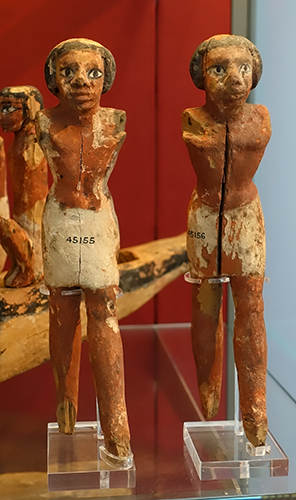
EA45155: Painted and gessoed wooden standing male figure wearing a kilt; both arms lost; remains of a tenon at the feet; from a model boat. Height 268 mm.
EA45156: Painted and gessoed wooden standing male figure wearing a kilt; both arms lost; remains of a tenon at the feet; from a model boat. Height 270 mm.
Catalog: Asyut, EA45155, EA45156
Photo: Don Hitchcock 2018
Source: Original, British Museum
Text: Card at the British Museum, http://www.britishmuseum.org/, © Trustees of the British Museum, CC BY-NC-SA 4.0
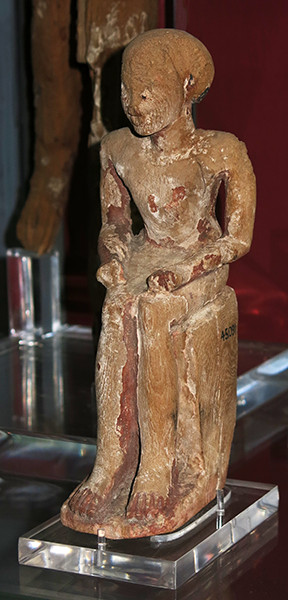
Tenth Dynasty: 2 130 BC - 2 040 BC
Hetepnebi boat owner
This seated wooden figure of a man probably represents the tomb occupant, and may have been attached to one of the model boats in the cavity to be seen in the stern, secured by a wooden dowel.
Height 203 mm, width 72 mm.
Catalog: EA45091
Photo: Don Hitchcock 2015
Source: Original, British Museum
Text: Card at the British Museum, http://www.britishmuseum.org/, © Trustees of the British Museum, CC BY-NC-SA 4.0
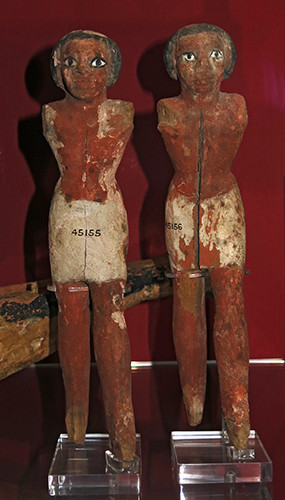
Tenth Dynasty: 2 130 BC - 2 040 BC
Hetepnebi Pilots
These painted wooden figures are perhaps the pilots from each of the two wooden boats found in the tomb, and would have been placed at the front of the boat to call directions to the paddlers.
Catalog: EA45155, EA45156
Photo: Don Hitchcock 2015
Source: Original, British Museum
Text: Card at the British Museum, http://www.britishmuseum.org/, © Trustees of the British Museum, CC BY-NC-SA 4.0
Tenth Dynasty: 2 130 BC - 2 040 BC
Hetepnebi pots
These jars were found arranged in a group at the head end of the coffin. Pottery intended for the tomb was often crudely made and simple in design. These vessels are wheel-made, but in some cases the potter has disguised the fact by smearing clay on their bases. This was probably done to give the impression that the vessels were hand-made, as was considered appropriate for funerary pottery.
Central pot: EA45260. Redware pottery jar with a rounded base and body, a short concave neck and a square rim.
Diameter 132 mm, height 170 mm.
Catalog: EA45234, EA45252, EA45256, EA45258-60, EA45265, EA45269
Photo: Don Hitchcock 2018
Source: Original, British Museum
Text: Card at the British Museum, http://www.britishmuseum.org/, © Trustees of the British Museum, CC BY-NC-SA 4.0
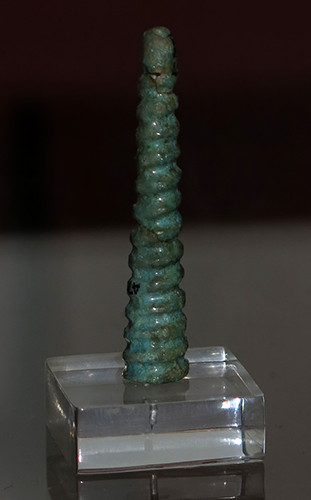
Tenth Dynasty: 2 130 BC - 2 040 BC
Hetepnebi Bead
Blue-glazed faience spiral bead.
This single bead was found inside the coffin and had probably formed part of the trappings of the corpse. Since the body had been rifled, it is possible that other items of jewellery had been stolen in antiquity.
Green glazed composition long, narrow conical bead with moulded spiral decoration.
Length 48 mm, diameter 9 mm (max)
Catalog: EA47463
Photo: Don Hitchcock 2015
Source: Original, British Museum
Text: Card at the British Museum, http://www.britishmuseum.org/, © Trustees of the British Museum, CC BY-NC-SA 4.0
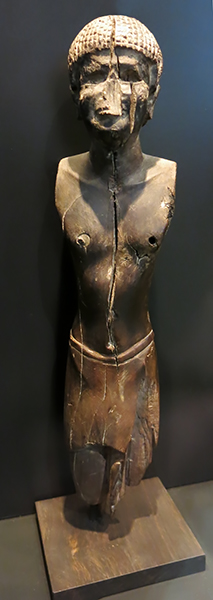
Tenth Dynasty: 2 130 BC - 2 040 BC
Statuette of a man
The man wears a curly wig and a short apron.
Catalog: Wood, Inv. H 984
Photo: Don Hitchcock 2015
Source and text: Badisches Landesmuseum Karlsruhe Germany
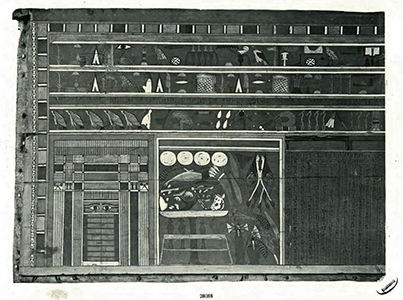
Tenth Dynasty: 2 130 BC - 2 040 BC
Outer coffin of the steward Nefri
Wooden coffin of the ancient Egyptian steward Nefri. For unknown reasons, the cartouches of the earlier pharaoh Wahkare Khety of the 9th-10th Dynasty were painted on it in place of Nefri's name. From Deir el-Bersha, 12th Dynasty, Middle Kingdom, now in Cairo (CG 28088).
Catalog: Cairo CG 28088
Photo: Pierre Lacau
Permission: Public Domain
Source: Original, Musée du Louvre
Text: Wikipedia
Tenth - Thirteenth Dynasty: 2 130 BC - 1 639 BC
Rattle
Catalog: Wood, Thebes, ÄM 12453
Photo: Don Hitchcock 2018
Source: Original, Staatliche Museen zu Berlin, Neues Museum, Germany
Text: © Card at the Staatliche Museen zu Berlin (CC BY-NC-SA 3.0 DE)
Middle Kingdom, 2 025 BC - 1 700 BC
Sail boat model
This sailing boat is well made and of good proportions, and judging by the stance of the models it is apparently being paddled downstream, under a bare mast, with the rudder oar unmanned.
Photo: Don Hitchcock 2014
Source: Original, Københavns (Copenhagen) Museum, National Museum of Denmark
Middle Kingdom, 2 025 BC - 1 700 BC
Faience hippopotamus
Glazed composition hippopotamus, provenance unrecorded.
The destructive character of the hippopotamus led it to be regarded as a hostile force by the Egyptians. This model, decorated with marsh plants, including lotus patterns in black, evokes the pleasures and dangers of the marshland. It was probably placed in a tomb, its legs (now restored) possibly deliberately broken off to render it harmless to the deceased person.
Catalog: EA35004
Photo: Don Hitchcock 2015
Source: Original, British Museum
Text: Card at museum display, © Trustees of the British Museum, CC BY-NC-SA 4.0
References
- Adams B., Porat N. , 1996: Imported Pottery with Potmarks from Abydos, In: J. Spencer (ed.), Aspects of Early Egypt, London: British Museum Press, p. 98-107.
- Allen J., 2014: An introduction to the language and culture of Hieroglyphs, Third Edition, revised and reorganized, with a new analysis of the verbal system, Cambridge University Press.
- Anderson W. , 1989: Badarian Burials: Possible Indicators of Social Inequality in Middle Egypt During the Fifth Millennium B.C., Department of Anthropology McGill University, Montreal April, 1989, a thesis submitted to the Faculty of Graduate Studies and Research in partial fulfilment of the requirements for the degree of Master of Arts
- Borchardt L. , 1907: L'archéologie égyptienne, Gaston Maspero, 1907.
- Breasted J. , 1903: Jewellery from the Tombs of Egypt, The Biblical World, Vol. 22, No. 1 (Jul., 1903), pp. 64-66, published by The University of Chicago Press, http://www.jstor.org/stable/3140533.
- Brunton G., Caton-Thompson C., 1928: The Badarian civilization and predynastic remains near Badari, (British School of Archaeology in Egypt and Egyptian research account : thirtieth year, 1924). 1928
- Brunton G., Morant G., 1937: Mostagedda and the Tasian Culture, British Museum Expedition to Middle Egypt, First and Second Years (1928, 1929), B. Quaritch Limited, 1937 - Egypt - 163 pages
- Caton-Thompson E., Gardner E., 1934: The Desert Fayum, Royal Anthropological Institute of Great Britain and Ireland, London, 1934.
- Cowie S., Johnson T., 2001: The Mummy in Fact, Fiction and Film, McFarland, 3 Dec. 2001 - Performing Arts - 208 pages
- David R., 2002: The Experience of Ancient Egypt, Rutledge, 9 Sep. 2002 - Social Science - 216 pages
- Davies, de Garis Norman, 1902: The Rock Tombs of Deir el Gebrâwi, Teil II: Tombs of Zau and Tombs of the Northern Group (= Archaeological Survey of Egypt. Twelfth Memoir), London 1902
- Dodson A., Hilton D., 2004: The Complete Royal Families of Ancient Egypt, The American University in Cairo Press, London 2004
- Ertman E., 2013: Gesichtseinlage von König Echnaton / Amenophis IV. aus opak-blauem Glas, Auszug und Übersetzung aus Journal of Glass Studies 2013-55, S. 13-19
- García J., 2012: Deir el-Gebrawi, UCLA Encyclopedia of Egyptology, UCLA
- García J., 2013: Ancient Egyptian Administration, BRILL, 7 Jun. 2013 - Reference - 1112 pages
- Gardiner A., 1928: Catalogue of the Egyptian hieroglyphic printing type, from matrices owned and controlled by Dr. Alan, pp 538 - 548, , 1928:
- Gardner H. et al., 2003: Pharaohs and the Afterlife: The Art of Ancient Egypt, Gardner's Art Through the Ages: The Western Perspective. Belmont, CA: Thomson/Wadsworth, 2003. 55.
- Gatto K., 2001-2002: Two Predynastic pottery caches at Bir Sahara (Egyptian Western Desert), Sahara, 13: 51 - 60
- Hamilton M., 2020: The Pyramid of Menkaure, at Giza. A Layman's Guide, https://www.researchgate.net/publication/346564585_The_Pyramid_of_Menkaure_at_Giza_A_Layman's_Guide, DOI: 10.13140/RG.2.2.31761.86888
- Harer W., 1985: Pharmacological and Biological Properties of the Egyptian Lotus, Journal of the American Research Center in Egypt, Vol. 22 (1985), pp. 49-54 Published by: American Research Center in Egypt DOI: 10.2307/40000390
- Hartwig M., 2006: A Companion to Ancient Egyptian Art, John Wiley & Sons, 23 Dec. 2014 - Literary Criticism - 624 pages
- Hodel-Hoenes S., 2006: Life and Death in Ancient Egypt: Scenes from Private Tombs in New Kingdom Thebes, Cornell University Press, 2000 - Art - 329 pages
- Holmes D., 1989: The Predynastic Lithic Industries of Upper Egypt: A Comparative Study of the Lithic Traditions of Badari, Nagada and Hierakonpolis, BAR (15) 469, Volumes I and II.
- Howard-Vyse R., 1840: Operations carried on at the pyramids of Gizeh in 1837: with an account of a voyage into Upper Egypt, and an appendix, London, J. Fraser, Vol. 1
- Jung M., 2012a: F. Seyfried (eds.), In the Light of Amarna. 100 years of the discovery of the Nefertiti, Berlin 2012, p. 206 (cat. No. 7).
- Jung M., 2012b: in: F. Seyfried (Hrsg.), Im Licht von Amarna. 100 Jahre Fund der Nofretete, Berlin 2012, p. 332
- Kákosy L., 1995: 'The Soter Tomb in Thebes', in S.P, Vleeming (ed.), Hundred-Gated Thebes: Acts of a Colloqium on Thebes and the Theban area in the Graeco-Roman Period, Leiden: Brill, 61- 67
- Kitchen K., 1993: Ramesside inscriptions : translated and annotated Notes and comments, 1, Ramesses I, Sethos I and contemporaries’ (Oxford, 1993), 2-3.
- Lehner M., 1992: Reconstructing the Sphinx, Cambridge Archaeological Journal, April 1992, pp. 3-26, DOI: 10.1017/S0959774300000445
- Malkowski E., 2010: Before the Pharaohs: Egypt's Mysterious Prehistory, Inner Traditions / Bear & Co, Apr 12, 2010 - History - 336 pages
- Martin G., 1991: Hidden Tombs of Memphis, Thames and Hudson, London 1991
- Maspero G., 1903: History of Egypt, Chaldea, Syria, Babylonia, and Assyria, London : Grolier Society
- Math N., 2014: Die Badarikultur, Neue Untersuchungen zu einer Kultur des 5. Jahrtausends v. Chr., angestrebter akademischer Grad Master of Arts (MA) Wien, 2014
- McKerrel H., Tylecote R., 1972: The working of copper-arsenic alloys in the Early Bronze Age and the effect on the determination of provenance, Proceedings of the Prehistoric Society, 38, pp. 209–218. doi: 10.1017/S0079497X00012111.
- Mettlen J., 2012: in: F. Seyfried (Hrsg.), Im Licht von Amarna. 100 Jahre Fund der Nofretete, Berlin 2012, p. 344 (cat. No. 126).
- O'Connor D., Cline E., 2001: Amenhotep III: Perspectives on His Reign, University of Michigan Press, 2001 - History - 393 pages
- Patch D., Eaton-Krauss M., Allen S., 2011: Dawn of Egyptian Art, Jan 1, 2011 - Art, Ancient - 275 pages
- Pommerening, T., Marinova, E., Hendrickx, S., 2010: The Early Dynastic origin of the water-lily motif, Chronique d’Egypte, 85 (2010): 14-40
- Raven M., 1980: Papyrus-sheaths and Ptah-Sokar-Osiris Statues, RMO, 1980 - 296 pages
-
- Rawlinson G., 1886: Ancient Egypt,T. Fisher Unwin, Tenth Edition
- Reisner G., 1942: A History of the Giza Necropolis, Vol. 1. Cambridge, Mass.: Harvard University Press, 1942
- Riemer H., Kuper R., 2000: 'Clayton rings': enigmatic ancient pottery in the Eastern Sahara, Sahara, 12: 91-100.
- Shaw I., 2000: The Oxford History of Ancient Egypt, Oxford University Press, USA, 31 Aug. 2000 - History - 528 pages
- Seyfried F., 2012: Im Licht von Amarna. 100 Jahre Fund der Nofretete, Berlin 2012, p. 322.
- Staff of the Metropolitan Museum of Art, 1999: Egyptian Art in the Age of the Pyramids, Galeries nationales du Grand Palais (France), Metropolitan Museum of Art (New York, N.Y.), Metropolitan Museum of Art, 1999 - Art - 536 pages
- Smith H., 2006: The Fortress of Buhen: The Inscriptions, (London, 1976), 118-19, no. 1511, pls. XXV/1, LXXIV/2-3
- Strudwick N., 2005: Texts from the Pyramid Age, Society of Biblical LiteratureAtlanta
- Strudwick N., 2006: Masterpieces of Ancient Egypt, University of Texas Press, 1 Nov. 2006 - Social Science - 352 pages
- Taylor J., 1999: Studies in Egyptian antiquitie, British Museum, Occasional Paper 123 (1999)
- Taylor J., 2010: Journey Through the Afterlife: Ancient Egyptian Book of the Dead, Harvard University Press, 2010 - History - 320 pages
- Verner M., 2014: From The Pyramids, Atlantic Books Ltd, 6 Nov. 2014 - History - 300 pages
- Weber A., 2012: in: F. Seyfried (ed.) Im Licht von Amarna. 100 Jahre Fund der Nofretete, Berlin 2012, S. 226 (Kat.-Nr. 18). Atlantic Books Ltd, 6 Nov. 2014 - History - 300 pages
- Wegner E., 2012: in: F. Seyfried (Hrsg.), Im Licht von Amarna. 100 Jahre Fund der Nofretete, Berlin 2012, p. 348 (cat. No. 129).
- Wilkinson T., 2002: Early Dynastic Egypt, Routledge, 11 Sep. 2002 - Social Science - 440 pages
Back to Don's Maps
 Back to Archaeological Sites
Back to Archaeological Sites
 Back to Egypt Index Page
Back to Egypt Index Page
